Table of contents

10 Best Backpacking & Camping Pillows of 2024

Some of the links on this page are affiliate links
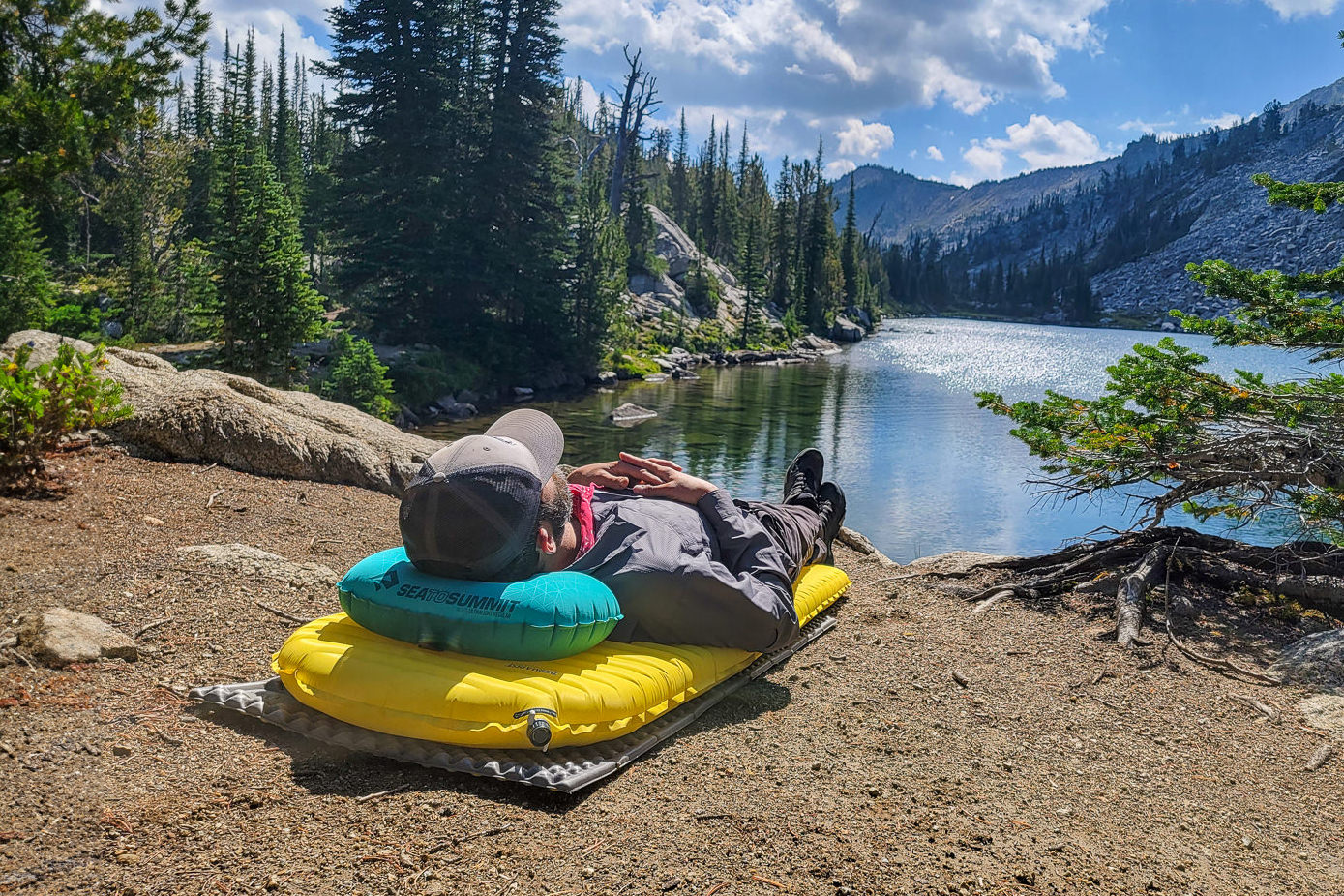
A pillow can make all the difference between sleeping like a baby and tossing and turning through the night. While some hikers consider a pillow a luxury item, we wouldn’t hit the trail without one on overnights in the backcountry and frontcountry.
We’ve spent over 1,000 nights sleeping under the stars trying more than 30 different models in our pursuit of the best pillows for camping and backpacking. In this guide, we cover which ones are the most comfy, supportive, and packable to get you resting your best on your outdoor adventures.
Of course, even the best pillow can’t do it alone. Packing the right backpacking sleeping pad , camping mattress , and sleeping bag for backpacking or camping will have you snoozing like there’s no tomorrow.
Quick Picks for Backpacking And Camping Pillows
Check out this quick list of our favorite backpacking and camping pillows if you’re in a hurry, or continue scrolling to see our full list of favorites with in-depth reviews.
Best camping & backpacking pillow overall: Therm-a-Rest Compressible ($32)
Best budget backpacking pillow: Trekology Aluft Pro ($22)
Best stuff sack pillow for ultralight backpacking: Hyperlite Mountain Gear Stuff Sack Pillow ($59)
Best budget camping pillow: Wise Owl Outfitters Camping Pillow ($25)
Best full-size camping pillow: HEST Pillow ($89)
Most comfortable air pillow: Klymit Luxe ($50)
Comfy & durable air-foam hybrid pillow: NEMO Fillo ($45)
Best ultralight air pillow: Sea to Summit Aeros Premium ($55)
Best air pillow for back-sleepers: NEMO Fillo Elite Luxury ($70)
We’ve been testing several new backpacking and camping pillows on our recent adventures, and there have been some big changes to our list.
- Trekology’s Aluft Pro pillow earns the number two spot and the title of best budget backpacking pillow.
- The Wise Owl Outfitters Camp Pillow lands at number four and takes the title of best budget camping pillow.
- We added the Klymit Luxe for its unrivaled comfort.
- The NEMO Fillo Elite Luxury beats out the standard Fillo Elite for a spot on our list because it’s larger and more comfy for a very small increase in weight and bulk.
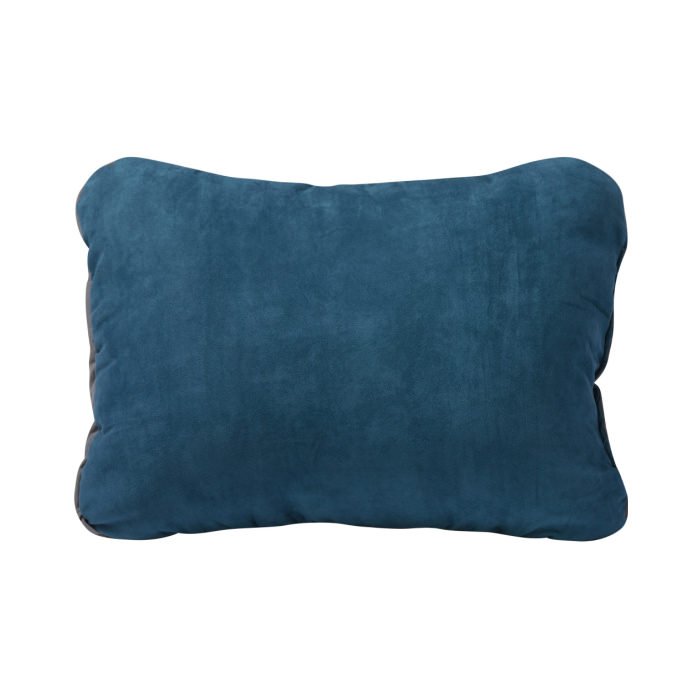
- Therm-a-Rest Compressible
Best camping & backpacking pillow overall
Weight: 7 oz.
Pillow Type: Compressible foam
- Very comfortable
- Less expensive
- Very durable
- Machine washable
- Fun pillowcase patterns
- A bit heavy for backpacking
The Therm-a-Rest Compressible pillow feels almost like camping with the pillow you use at home, but it’s more compact and it doesn’t matter if it gets dropped in the dirt. While it’s bulkier than some of the other pillows on our list, we’d usually rather pack this ultra-comfy pillow than a smaller one that’s less plush.
The Compressible is comprised of a soft polyester cover with upcycled foam chunks inside. It packs into a sleeve on the cover, and the foam can be compressed down to eliminate some of the bulk. When you’re ready to use the pillow, the foam springs back to its original loft shortly after unfolding it. There’s also a drawcord on the cover that can be cinched to tailor the firmness and support to your liking.
The Compressible is CleverHiker Founder Dave Collins’s all-time favorite pillow. He’s used it for some of his most challenging backpacking trips – including multi-day treks through Jasper , Yosemite , and Banff National Parks – because he knows the great night’s sleep he’ll get with it far outweighs the extra ounces and bulk in his backpack.
The Compressible Pillow comes in several sizes for different use cases. We prefer the small size since it cuts out some weight and bulk for challenging backpacking trips, but it’s still large enough to feel luxurious in the frontcountry. Folks who tend to car camp more than backpack might prefer the medium for its larger size and still-reasonable weight, while dedicated glampers will likely find the large to be the best option.
The bottom line is: if you’re looking for a backpacking pillow that will most closely match the feeling of the one you use on your bed at home, this is it.
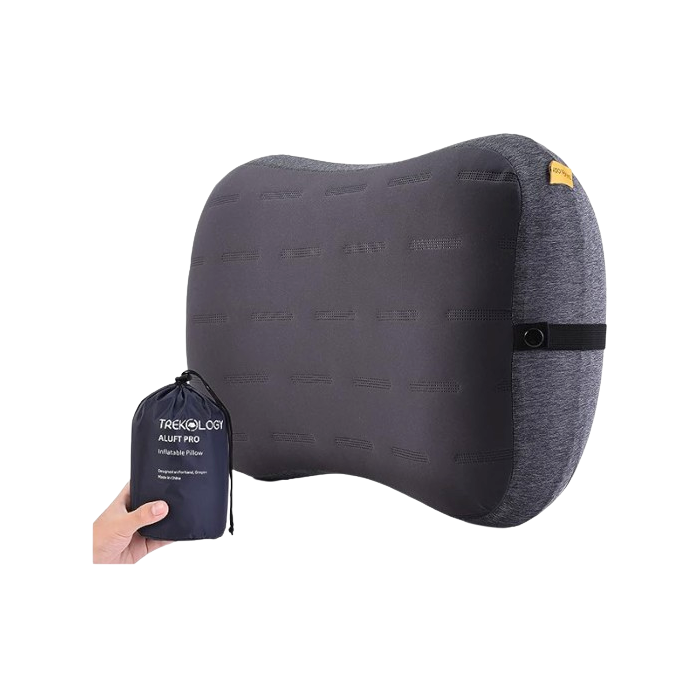
- Trekology Aluft Pro
Best budget backpacking pillow
Weight: 6.3 oz.
Pillow Type: Air
- Removable cover is machine washable
- Height provides excellent support
- Strap keeps pillow in case
- A bit heavier & bulkier than some
- Some users report durability issues
The Trekology Aluft Pro is one of the most affordable backpacking pillows on the market, and it’s also one of the most comfortable we’ve tested. This budget-friendly pillow has a surprising amount of premium features that make it feel like a real luxury in the backcountry.
Our favorite detail on the Aluft Pro is the strap that keeps it in place. Nothing’s worse than fighting through the night to keep your inflatable pillow on your pad, so we find that this feature adds a ton of value for very little weight. That said, the strap is removable if you don’t struggle with this and want to save a few grams.
If you’re like us, you sleep like a baby in the backcountry after a hard day of hiking. And snoozing hard can often lead to… drool. The cover of the Aluft Pro is removable and machine-washable, so sunscreen, sweat, and saliva are no problem. You can start each adventure with a fresh, clean pillow.
We absolutely love this model, and have very few downsides to note. Although there are enough users reporting the Aluft Pro leaking air after a few uses that it definitely bears mentioning. One of our gear testers tested this pillow over the course of about a month on the Arizona Trail without incident, and any gear that makes it through the prickly campsites of the AZT is pretty hardy in our view. Still, it’s always best to pack a patch kit and be prepared to perform field repairs if issues arise.
This pillow may be a little heavier and bulkier than some of the truly ultralight air-filled options on this list, but we think most hikers will be very pleased with the comfort and convenience of the Aluft Pro. However, if saving weight and bulk is a priority for you, take a look at the Aluft 2.0 . This pillow isn’t as thick and soft as the Pro model, but it’s a couple ounces lighter, considerably smaller when packed, and even more affordable.
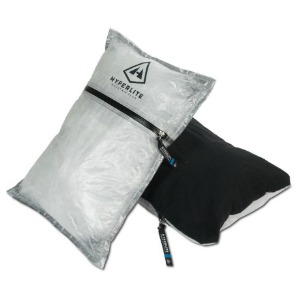
- Hyperlite Mountain Gear Stuff Sack Pillow
Best stuff sack pillow for ultralight backpacking
Weight: 1.7 oz.
Pillow Type: Stuff sack
- Very durable for the weight
- Doubles as waterproof stuff sack
- Requires extra clothing
- Slippery underside
For hikers who prioritize saving weight above all else, the Hyperlite Mountain Gear Stuff Sack Pillow is a very comfortable and functional option that serves a dual purpose.
With the Dyneema sides facing out, this is a waterproof stuff sack for your clothing or whatever else you want to keep protected from the elements. But turn it inside out at night to expose the fleece lining, and you’ve got a soft and comfortable pillow.
We find that this pillow is best used in warmer hiking months. Since you need something to stuff inside to give it loft, it’s better in temperatures where you won’t need to sleep in all of your clothes. A down jacket is an excellent way to fill out the pillow, and then you can add other things – like extra socks or base layers – to dial in the firmness.
Of course, you may run into the unexpected chilly night when you do end up wearing all your extra clothes for sleeping, in which case your pillow won’t be very plush. But we’ve found that we usually have a few small things to stuff inside when this happens (like other stuff sacks, a pack towel , or toilet paper roll) to make a passable pillow for the night.
The HMG Stuff Sack Pillow is very similar to the Zpacks Medium-Plus Dry Bag Pillow . Both cost the same, weigh the same, and are great choices, but there are a couple of key differences. The Zpacks pillow is a little longer and made with slightly thicker Dyneema fabric. However, the HMG pillow wins the spot on this list over the Zpacks stuff pillow because the zipper placement is more convenient. The Zpacks zipper is at the very top, so you would need to pull things out to access clothes that are lower down. The HMG zipper splits the pillow about a quarter of the way down, making it more convenient to put small things up top and larger things in the bottom part with quick, easy access to both.
While the HMG pillow is made with a slightly thinner DCF fabric than the Zpacks pillow (0.8 oz./sq. yd. DCF vs 1 oz./sq. yd. DCF), we’d say the durability is pretty much a tie. CleverHiker Senior Gear Analyst, Casey Handley, finally reached the end of the road with her HMG Stuff Sack Pillow after about six years and 4,000 miles of hiking. Pretty impressive for a fleece-lined stuff sack weighing less than two ounces.
Though the HMG Stuff Sack Pillow is expensive, the durability makes it worth the cost – it’ll likely outlast many air pillows in the same price range. This is as light as it gets if you want to go minimal without sacrificing comfort.
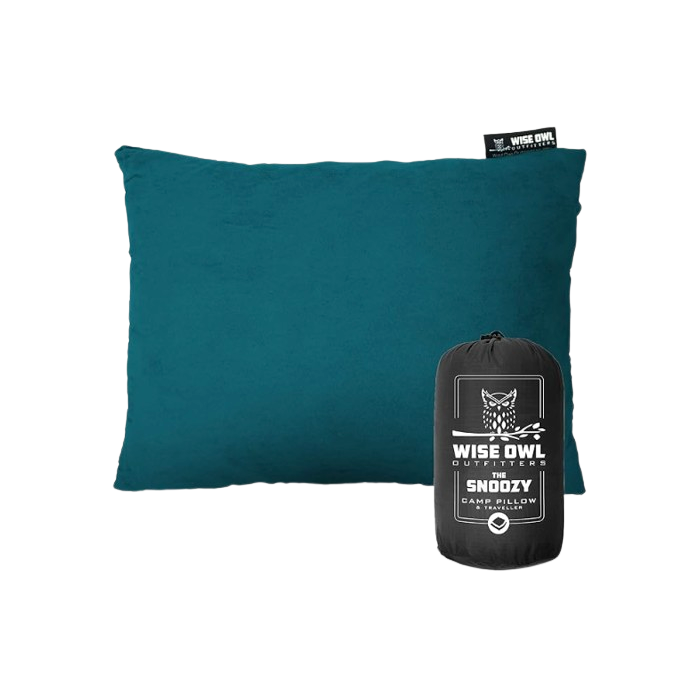
Wise Owl Outfitters Camping Pillow
Best budget camping pillow
Weight: 9 oz.
Pillow Type: Foam
- Foam chips can feel lumpy
The supportive and affordable Camp Pillow from Wise Owl Outfitters offers a lot of comfort.
This pillow is pretty similar to our top pick, the Therm-a-Rest Compressible , but it’s a bit more geared towards frontcountry camping. The Wise Owl is one inch larger in length and width than the Therm-a-Rest Compressible, so naturally it weighs a few ounces more. When packed, this is one of the bulkiest pillows on our list, and it weighs over half a pound. We don’t recommend it for backpacking, but it does a great job of mimicking the pillows we use at home while car camping.
There are many cheap pillows like this one on the market, but the Wise Owl earns its place on this list for its supportive design. During testing, we found that similar budget pillows had a tendency to flatten out quickly, while the Wise Owl held its shape much better. The loft is adequate for side sleeping, and the foam filling can be shifted around inside to tailor the support.
Among the affordable competitors, the Teton Sports Camp Pillow is the most comparable option as far as quality for the price. This pillow has a synthetic feather-like fill that flattens out more than the Wise Owl’s foam fill, so it could be a more enticing option for back-sleepers who don’t want their head to rest so high.
Both the Wise Owl and Teton Sports camping pillows are great options, and if we were choosing between the two – we’d probably just buy whichever one was running a better sale at the time.
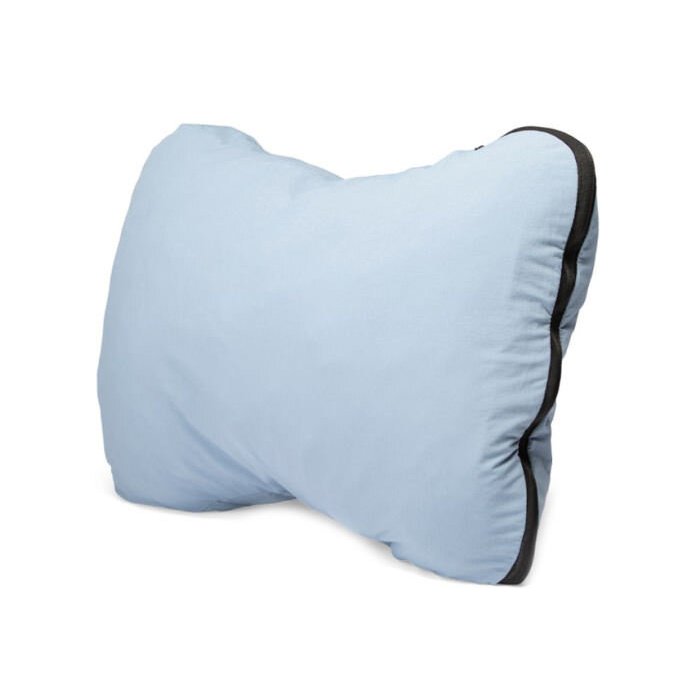
- HEST Pillow
Best full-size camping pillow
Weight: 2 lb. 3.2 oz.
- Too heavy & bulky for backpacking
The HEST Camp Pillow brings the comfort of home to your frontcountry endeavors. It’s nearly as large as a regular bed pillow, and the shredded memory foam fill provides excellent support that doesn’t flatten out.
At 2 lb. 3.2 oz., the HEST Pillow is one of the heaviest and bulkiest pillows we tested, so it’s not for backpacking. But it’s the perfect luxury pillow for car camping and travel when comfort is a priority.
For the ultimate plush setup, we like to pair this pillow with the Exped MegaMat from our list of the Best Camping Mattresses . This dream duo will have you sleeping like a rock and may make you forget all about your bed at home.
The regular size is plenty big for our needs, but an even larger Standard Pillow is also available if you’re after maximum luxury. Just keep in mind that the Standard costs quite a bit more and will take up more space in your gear storage if you’re stuck deciding between the two.
The HEST Camp Pillow is our top recommendation for those who value comfort above all else and for campers who have a hard time catching Z’s when away from their bed at home. Though it’s quite expensive, the high-quality materials and washable cover will keep it adventure-ready for many years of outdoor fun.
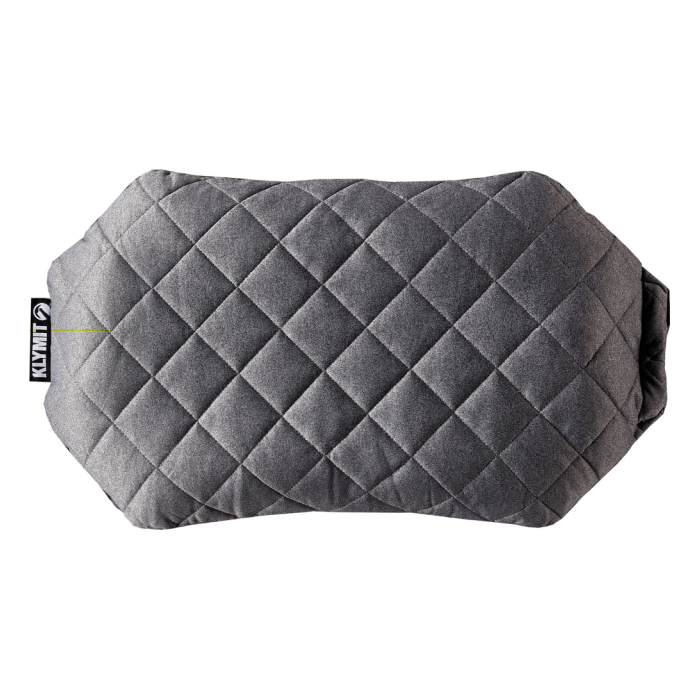
- Klymit Luxe
Most comfortable air pillow
- Wider than most backpacking pillows
- Lightweight for the size
- Machine washable cover
- A bit expensive
The Klymit Luxe pillow is our top recommendation for backpackers who prioritize comfort. This large, supportive pillow is heavier and bulkier than the pillows we usually take for long backpacking trips, but it’s by far the most comfortable air pillow we’ve tested.
At 22 inches long and 12.5 inches wide, the Luxe is the largest backpacking pillow on our list. It’s also one of the thickest with a whole five inches of loft. When you consider the dimensions, the weight and packed size are actually a lot more impressive. We firmly believe that if your backpacking pillow isn’t comfortable, it’s wasted weight and space anyway. So we’re willing to carry the Luxe into the backcountry over an ultralight option for its significant boost in comfort.
Though the Luxe is far from affordable, we think it’s actually a pretty fair price for what you’re getting. You’d pay the same for a smaller, lighter pillow that maybe isn’t as comfortable. And if you’re going to be spending the same amount of money, it’s definitely worthwhile to consider trading in the weight savings for added comfort.
Like many modern camp pillows, the Luxe comes with a removable cover that can safely go through the washing machine. What makes this cover a bit unique, though, is the snap closure on the end that hides away the valve stem. This small detail eliminates any chance of the valve interfering with your sleep, and we’ve really come to appreciate it.
Car campers and backpackers alike will love the Klymit Luxe for its unrivaled balance of comfort, weight, and price. Those who don’t mind carrying a little extra weight and bulk in exchange for more comfort should stop the pillow search here.
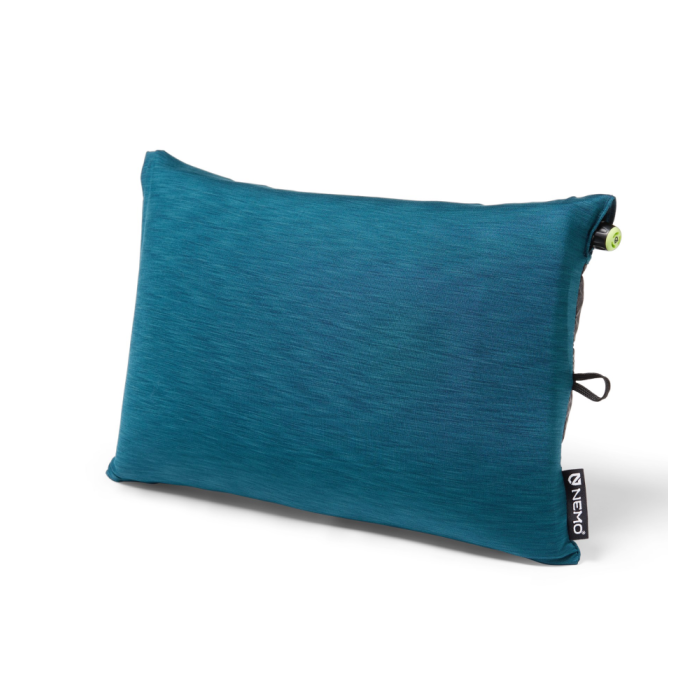
Comfy & durable air-foam hybrid pillow
Pillow Type: Foam/air
- Above-average durability for an air pillow
- Machine washable case
- Integrated stuff sack
- A bit bulky/heavy for backpacking
The NEMO Fillo has been one of the most popular camping pillows on the market for many years because it’s well-made, provides excellent support, and it’s plush enough for the frontcountry while still being reasonably light for the backcountry.
Its soft, removable cover, durable air bladder, and sturdy valve make this pillow a high-quality investment that will really up the comfort on your camping trips. But what really sets the Fillo apart from other air pillows is the thick foam topper. Some air pillows can end up feeling like you’re sleeping on a pool toy, but this layer of foam – combined with the I-beam air chambers and the soft microsuede/jersey cover – make for a much more comfy night’s sleep.
At nine ounces, the Fillo isn’t our first choice for long backpacking trips, but it’s a comfortable option for car camping, travel, and short backcountry adventures. And while it’s also a bit bulkier than many of the pillows we prefer to backpack with, the plush design is worth it for those who prioritize a cozy night’s sleep when hitting the trail for multi-day trips.
For backpacking, we prefer the Fillo Elite Luxury and Fillo Elite listed below for their lower weight and bulk. But you’ll miss out on the cushy foam layer of the standard Fillo and an extra inch of thickness with those alternatives.
Users who will get the most value out of the Fillo are those who are looking for a pillow that feels luxurious for car camping while being light enough for the occasional trek into the backcountry.
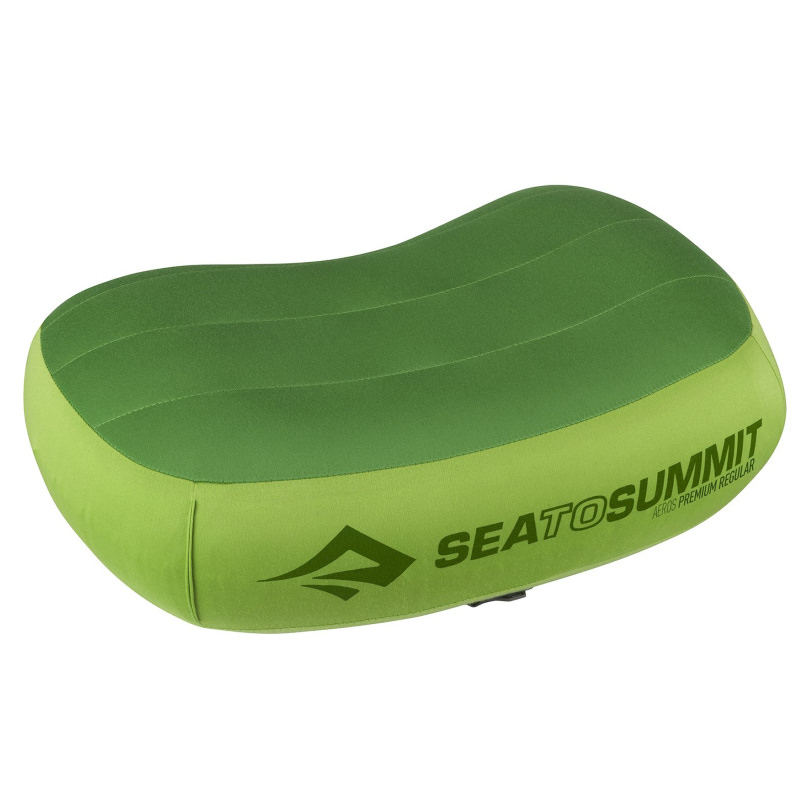
- Sea to Summit Aeros Premium
Best ultralight air pillow
Weight: 2.7 oz.
- Too firm for some
- Minimally insulated
The Sea to Summit Aeros Premium is one of our all-time favorite air pillows for backpacking since it strikes the perfect balance between comfort and low weight.
At just 2.7 ounces, the Aeros Premium is one of the lightest air pillows on the market, and it also packs down incredibly small. Don’t let its tiny size fool you though, this thing packs a ton of comfort. The regular size – our size preference for saving weight on backpacking trips – sits at 4.3 inches high, so it’s got a great amount of loft and support for side sleepers.
That said – when inflated to its full height – the Aeros Premium is pretty firm, and it can start to hurt your ear if you lay on one side for too long. You can easily let out some air to make it a bit squishier, but we still find pillows with foam tops (like the admittedly much heavier NEMO Fillo ) to be more comfortable for side sleeping.
One of our favorite features of the Aeros Premium is the multifunctional valve. The first flap opens up to a one-way valve for quick deflation, and you can also press the center of this valve to make micro-adjustments to the firmness. Opening the second flap reveals the dump valve which makes for quick and easy deflation.
Another unique detail is this pillow’s compatibility with Sea to Summit’s PillowLock system. PillowLock is a set of soft Velcro-like stickers that come with Sea to Summit backpacking sleeping pads . These special tabs latch on to the fabric of the Aeros line of pillows and lock them in place while you sleep. Unfortunately, PillowLock isn’t sold on its own at this time, so you can only take advantage of this feature if you also have a Sea to Summit pad.
Backpackers looking to cut out weight without sacrificing support should keep the Aeros Premium at the top of their list. This tried-and-true favorite sits taller than many other ultralight air pillows, and its superb valve makes it easy to dial in your perfect firmness.
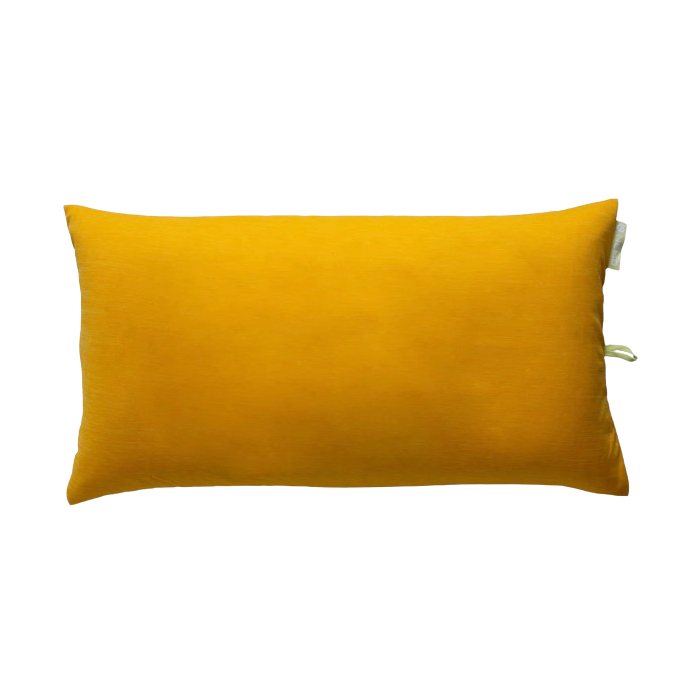
- NEMO Fillo Elite Luxury
Best air pillow for back-sleepers
Weight: 4 oz.
- Lightweight
- Very comfortable for back-sleepers
- A bit heavier/bulkier than UL backpacking options
The NEMO Fillo Elite Luxury has become one of our go-tos due to its generous dimensions, soft surface, and low weight.
At 21 inches wide, the Fillo Elite Luxury stretches across the entire width of a regular-size backpacking sleeping pad , so you have plenty of room to roll around without coming off the pillow. Backpacking pillows have a tendency to slide off of pads, but we find the extra length usually ensures that at least part of the pillow remains in place for a comfy night’s sleep.
The Fillo Elite Luxury sits at three inches high, so it’s not the most supportive option for side-sleepers. But back-sleepers will appreciate that this pillow doesn’t strain your neck by keeping your head too high. CleverHiker Senior Gear Analyst Casey Handley, who is a rotisserie-sleeper that usually ends up on her back or stomach, tested this pillow over 500 miles of the Arizona Trail, and she found that the width gave her plenty of room to change positions and the height was perfect for providing support while sleeping on her back.
Hikers looking to shave off a few grams may find the standard Fillo Elite to be a good middle-ground between weight and comfort. It’s only 15 inches wide (a full six inches less than the Luxury model), but it weighs in at just 2.8 ounces and packs down smaller. While there’s less room to wriggle around on the Fillo Elite, those who tend to stay stationary through the night will likely prefer this lighter and less expensive version.
With a light layer of synthetic insulation on top and a soft jersey case, the Fillo Elite Luxury is more comfortable than most other inflatables. It’s a bit pricey, but it’s well-designed with an integrated stuff sack that’s impossible to lose, a removable case for easy washing, and a top-notch valve.
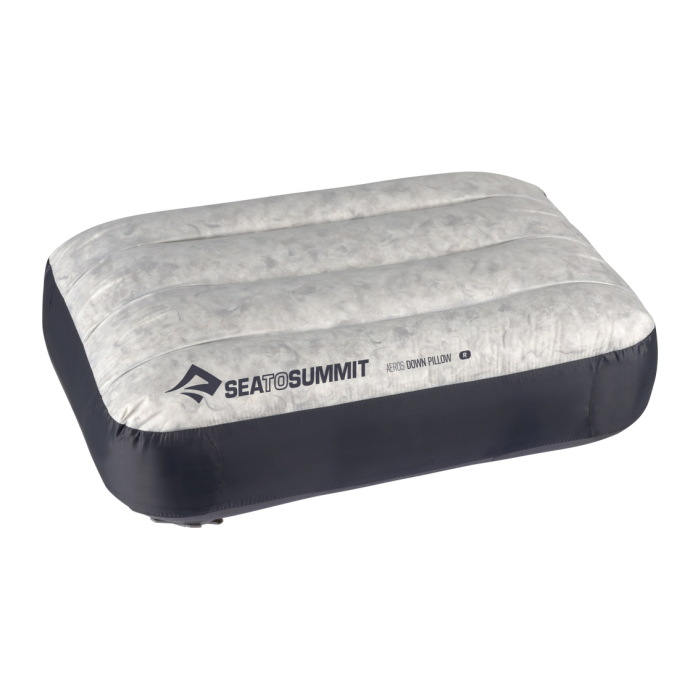
- Sea to Summit Aeros Down
Ultralight air pillow with a warm & comfy down layer
Weight: 2.5 oz.
The Sea to Summit Aeros Down pillow is the lightest air pillow on our list and it’s more padded and comfy than the average ultralight option.
This pillow has a thin layer of down cushioning on top that provides some extra comfort and warmth, but it’s also what makes it a bit spendier than many others. That said, we think the Aeros Down is worth the cost for its quality build. CleverHiker Senior Gear Analyst, Casey Handley, has spent more than 75 nights in the backcountry – including her thru-hikes of the Colorado Trail and Long Trail – with the Down Pillow, and it’s still going strong.
Just like the Aeros Premium above, the Aeros Down also has an excellent valve system. The first flap conceals the one-way inflation valve that also allows for easy micro-adjustments, and the second flap opens up the dump valve for effortless deflation.
Hikers looking to shave every gram possible without sacrificing the comfort and support of an air pillow can’t go wrong with the Aeros Down Pillow.
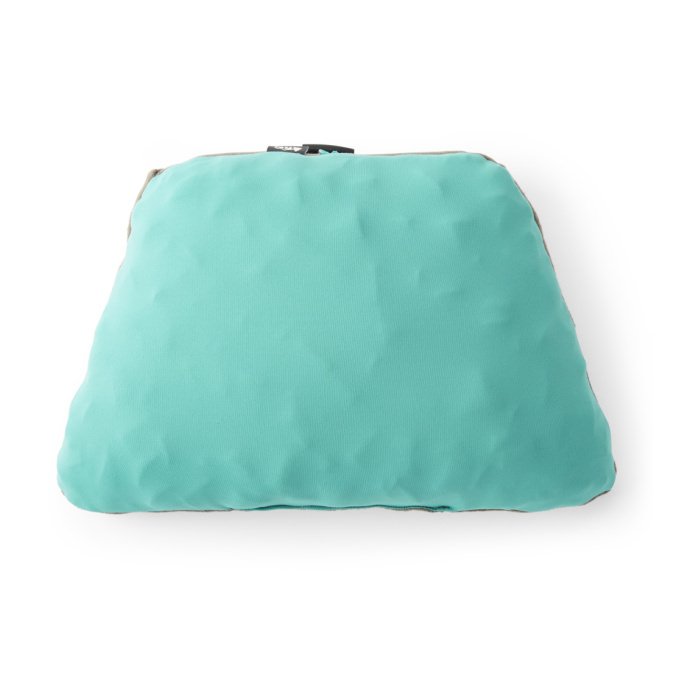
- REI Trailmade Mummy Bag Pillow
Affordable & comfy foam pillow for camping
Weight: 5.25 oz.
- Very comfortable once you get the foam situated
- Heavier/bulkier than some
The REI Trailmade Mummy Bag Pillow is an affordable option that slips inside the hood of a mummy sleeping bag for all-night comfort that stays put. This pillow is plush enough for camping, light enough for backpacking, and packable enough for travel, so it’s an excellent choice if you’re looking for a do-it-all pillow.
We find the foam filling of this pillow to be comfier than many air pillows since it’s not as firm and it conforms to your body shape. However, the Trailmade feels lumpy compared to our favorite foam pillow, the Therm-a-Rest Compressible , listed above. Still, the Trailmade is lighter and more affordable, so it’s a solid option for budget-conscious hikers. And you can always shift the shredded foam fill around to customize the shape a bit.
One of the best features of the Trailmade is the innovative cover. It has a cozy fleece side and a cool polyester side, so you can flip it to optimize comfort depending on the conditions. When you’re ready to pack up in the morning, the foam pillow compresses into the cover to save space in your backpack. And then once you’re back home, pop the whole thing in the washing machine to bring it back to good as new.
We tend to opt for a lighter and smaller pillow on long, challenging backcountry trips. But the Trailmade only weighs 5.25 ounces, so it’s totally backpacking-worthy if comfort is a priority.
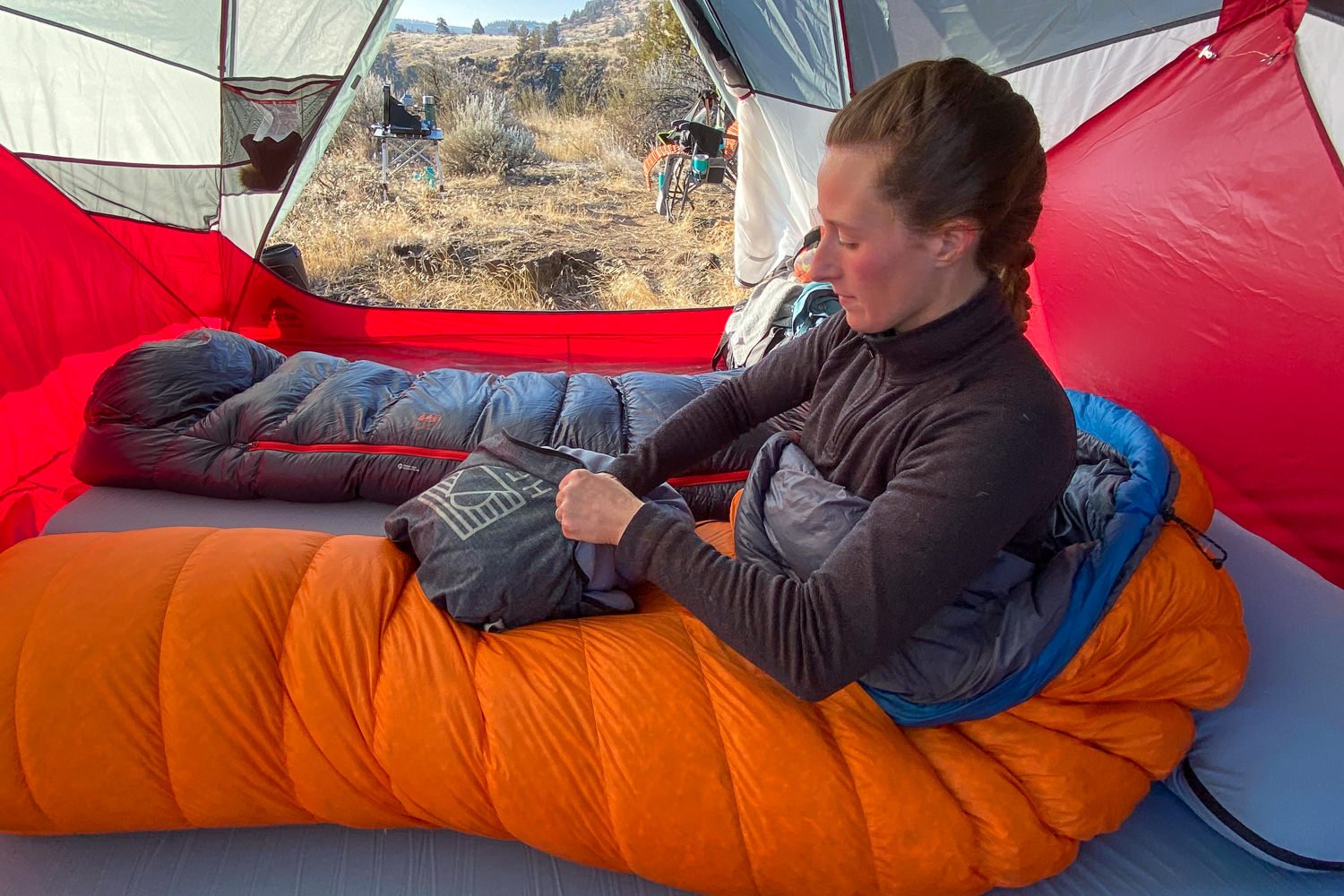
Product Comparison Table
What’s most important to you in a camp pillow.
Quality sleep is priceless, but you don’t have to break the bank to get a great camping pillow. That said, we find that spending more often means an increase in comfort, weight savings, and durability. We prioritized price and comfort over all else when selecting our favorite budget pillows, so going with one of those options will mean a bit more bulk and weight to carry.
Best budget pillows
- Wise Owl Outfitters Camp Pillow
Best mid-range pillows
Best high-end pillows
Comfort is our number one priority when choosing a pillow for backpacking and camping. After all, you could get the lightest, most affordable pillow in the world, but it would still be useless if it’s not comfortable.
When assessing comfort, we look for pillows that are warm yet breathable, maintain loft to provide support, and have a soft cover.
Most comfortable backpacking pillows
Every ounce matters for backpacking, but your sleep system is an area where carrying a few extra grams can be well worth the tradeoff. We find that as long as a pillow is below about eight ounces, we’re willing to carry some additional weight into the backcountry if it means we’ll get a more restful sleep.
Backpacking pillows with the best balance of comfort & weight
PACKED SIZE
When you have to squeeze everything into a backpack or bike panniers, it’s best to go with an air pillow that packs down small. If luxury and comfort are the ultimate goals (say for car camping), go for something a little cushier.
Most packable camp pillows
Best luxury camp pillows
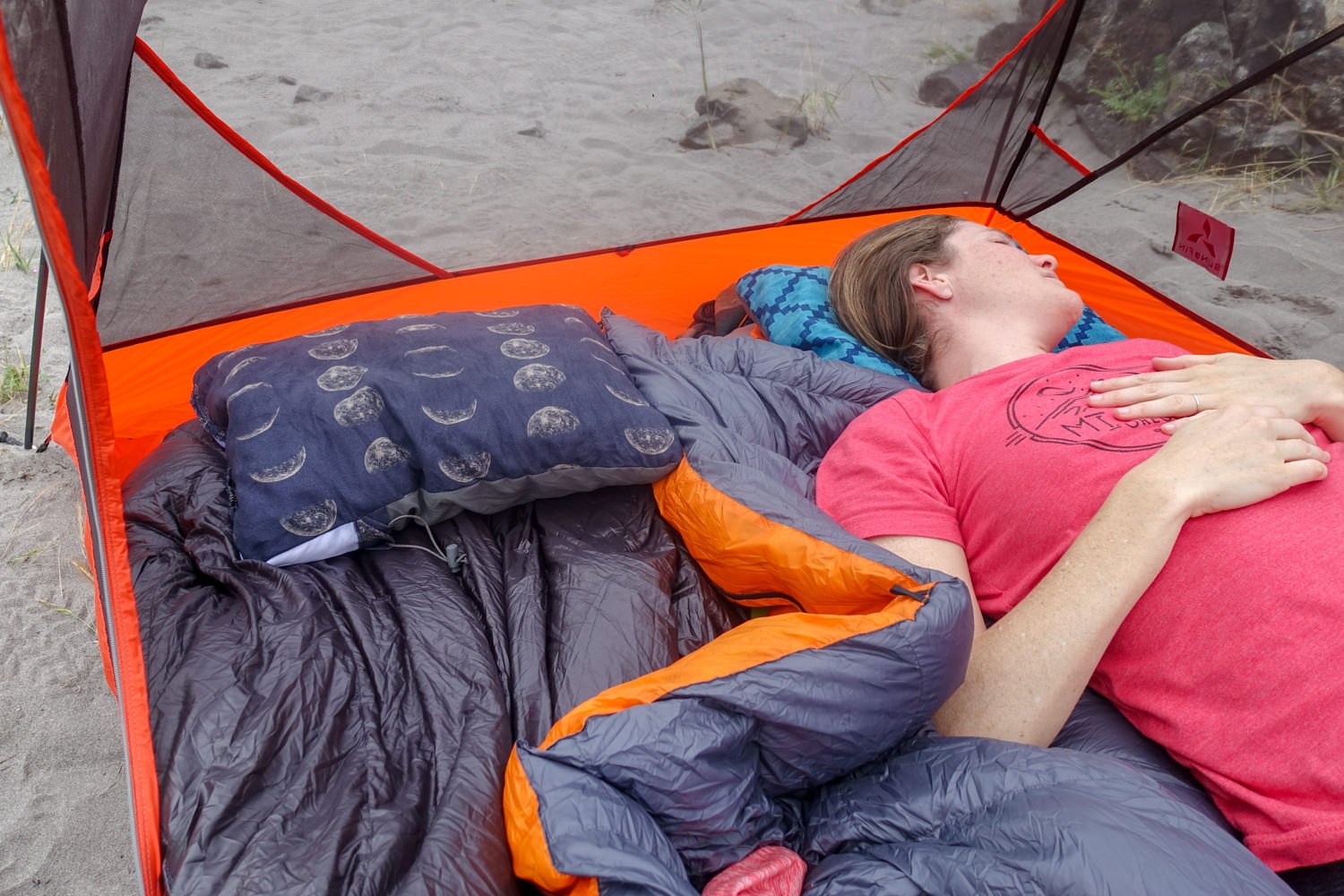
Foam pillows, like the Therm-a-Rest Compressible & REI Trailmade , are generally more comfortable than inflatables
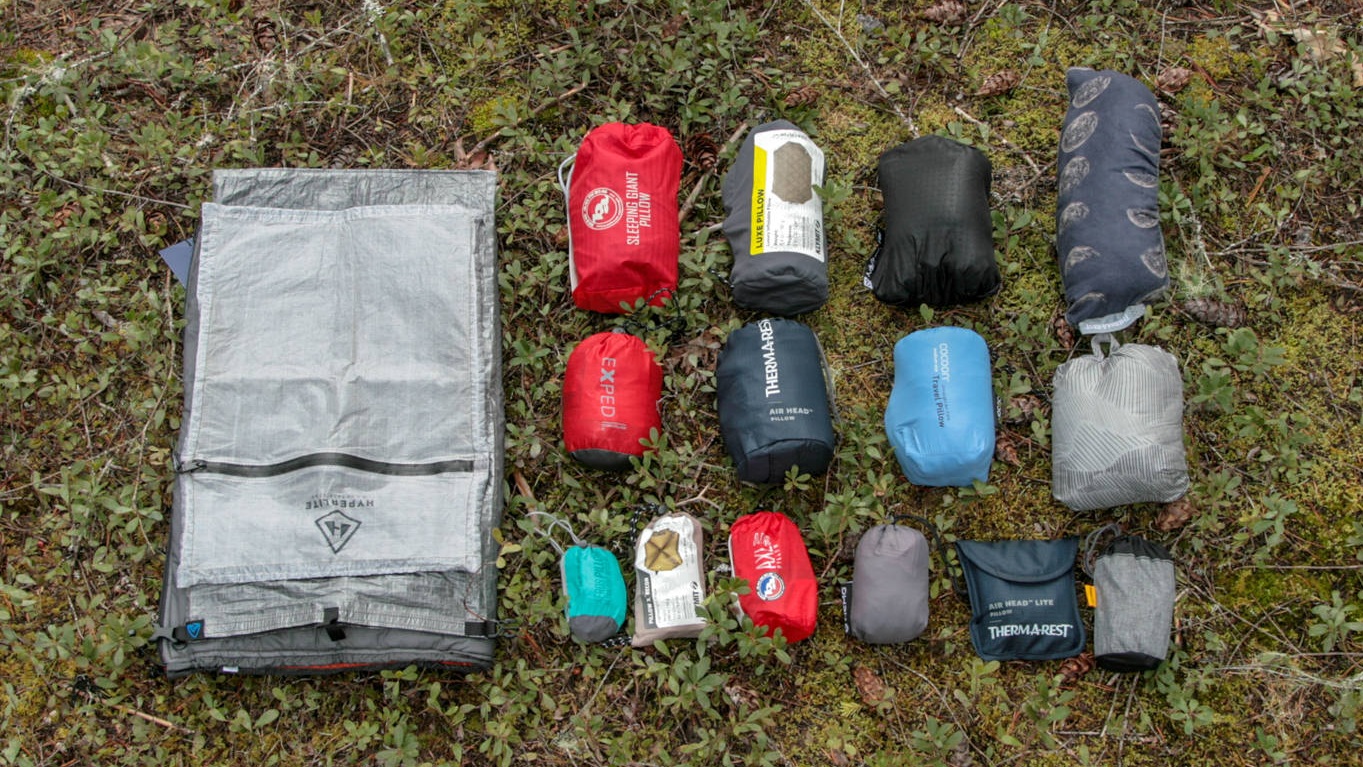
Comparing the packed sizes of the best backpacking & camping pillows
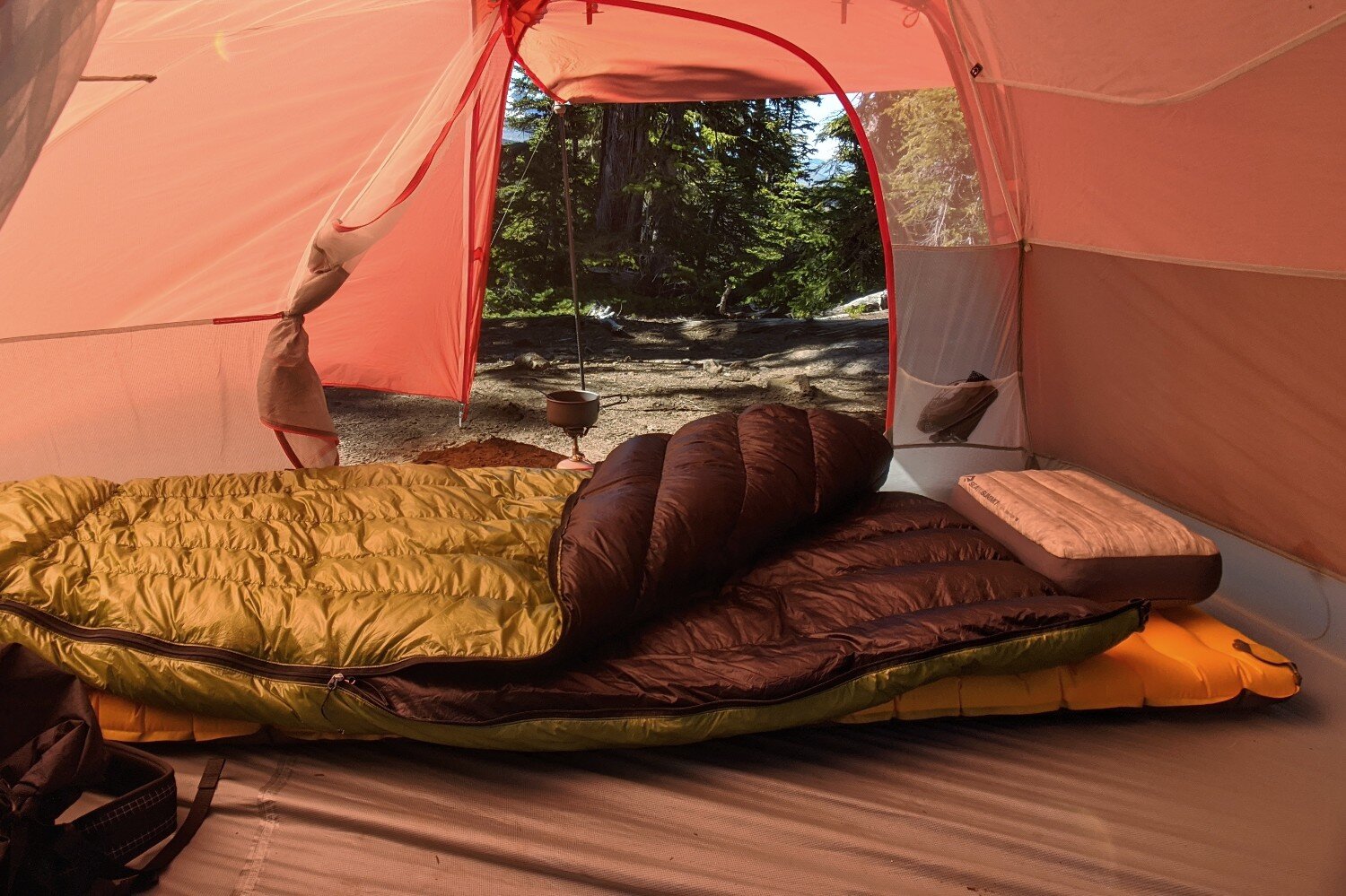
The Sea to Summit Aeros Down is a bit pricey, but it’s ultralight & has a warm layer of down on the top
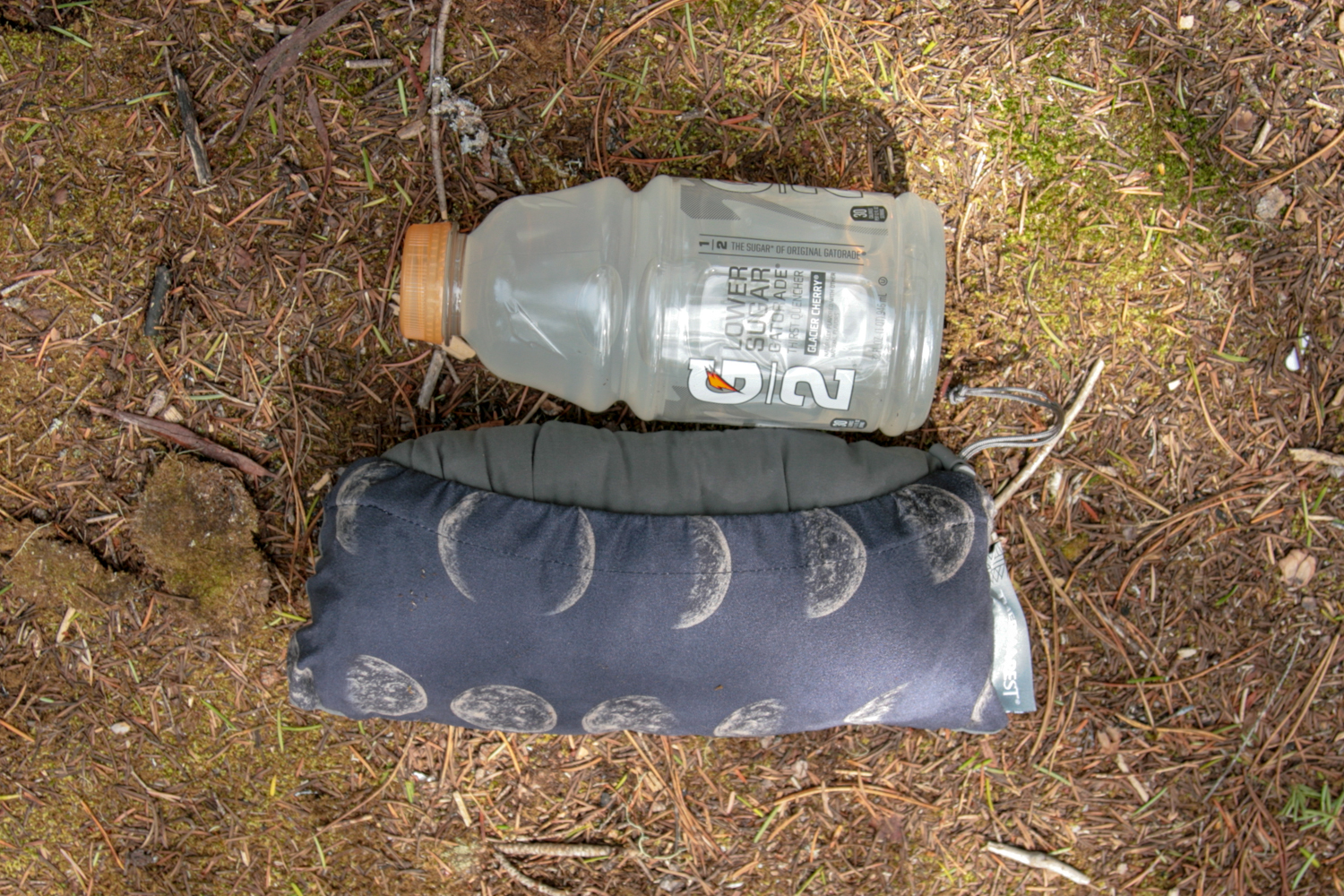
The Therm-a-Rest Compressible Pillow is a on the bulky side, but we take it backpacking when comfort is a priority
Which Pillow Type Is Right For You?
There are pros and cons to every type of camping pillow. Here are the main categories of backcountry pillows and some quick links to our top recommendations.
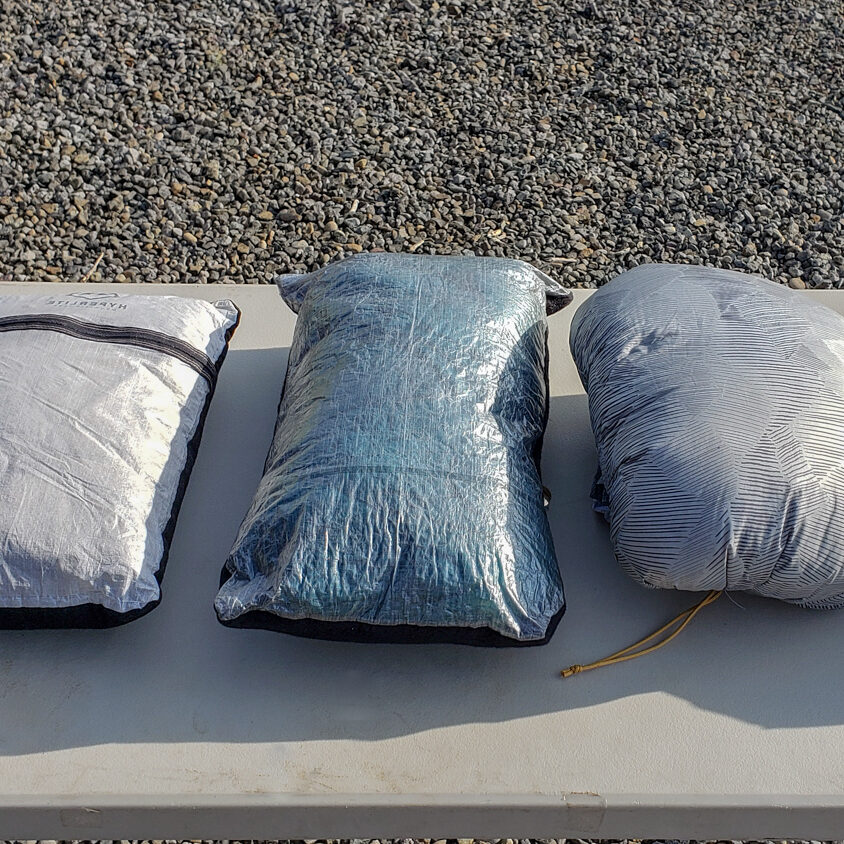
STUFF SACK PILLOWS
Stuff sack pillows are ultralight and excellent for backpacking, but they require a puffy jacket or other soft clothing to give them loft. They can be very comfortable with the right stuffing, but depending on what you fill them with, they can also be hard or compress too much. Our top picks: Zpacks Medium Dry Bag Pillow & HMG Large Stuff Sack Pillow
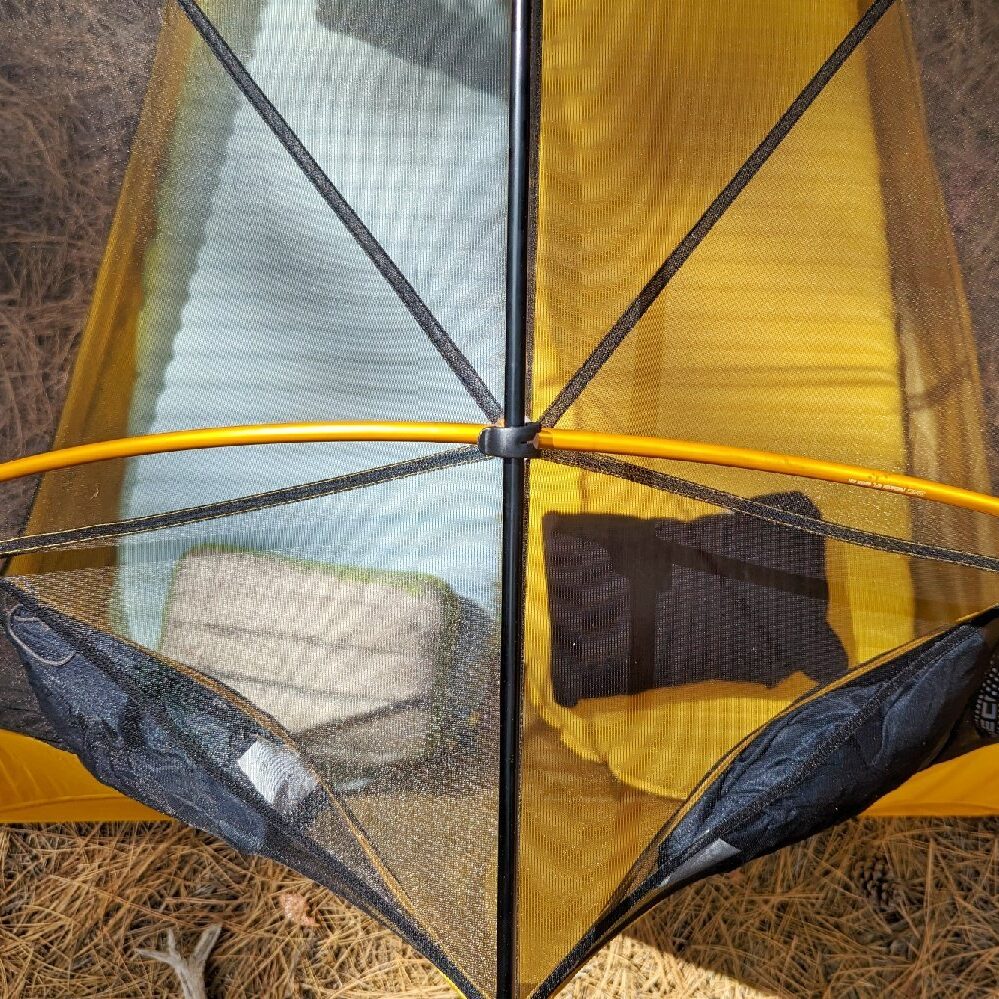
UL INFLATABLE PILLOWS
Ultralight inflatable pillows weigh next to nothing and hold their shape to offer good height and support for side-sleepers. If you choose an air pillow, make sure to figure out the firmness that works best for you. Over-inflated air pillows can be a bit unstable, difficult to keep in place, they can be hard on the ears after a few hours. Our top picks: Sea to Summit Aeros Premium & NEMO Fillo Elite

COMPRESSIBLE PILLOWS
Compressible pillows are made of materials that expand, like shredded pieces of foam. They’re often very comfortable and closely mimic the pillows we use at home, but they also tend to be much bulkier and heavier than stuff sack pillows and ultralight inflatables. We usually choose these types of pillows for car camping, but a small one can also be a real game-changer for backpacking. Our top picks: Therm-a-rest Compressible & HEST Pillow
HYBRID PILLOWS
Hybrid pillows often consist of an air bladder topped with a layer of foam or down insulation. They share the same height and support benefits of ultralight air pillows, but they’re typically much more comfortable. These pillows are heavier and bulkier than ultralight air pillows, but they’re often lighter and more compact than compressible pillows. Our top pick: NEMO Fillo
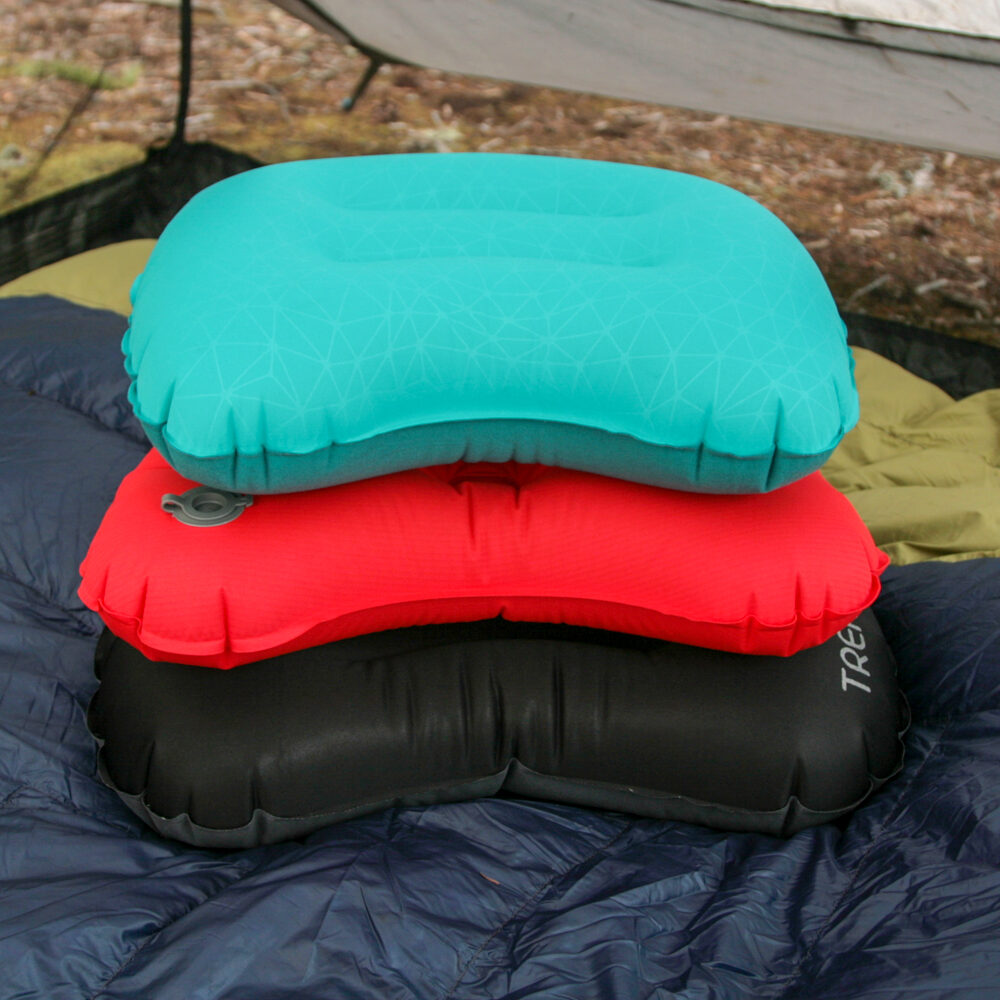
Critical Pillow Considerations
Sleeping styles.
Size, shape, warmth, and surface all come together to determine how comfortable a camping pillow is. Look for one that compliments the position you like to sleep in, accommodates your size, and satisfies your preferences for softness or firmness. Side sleepers commonly prefer pillows with a bit more height to support the neck and shoulder, while back sleepers might prefer softer, lower-profile pillows.
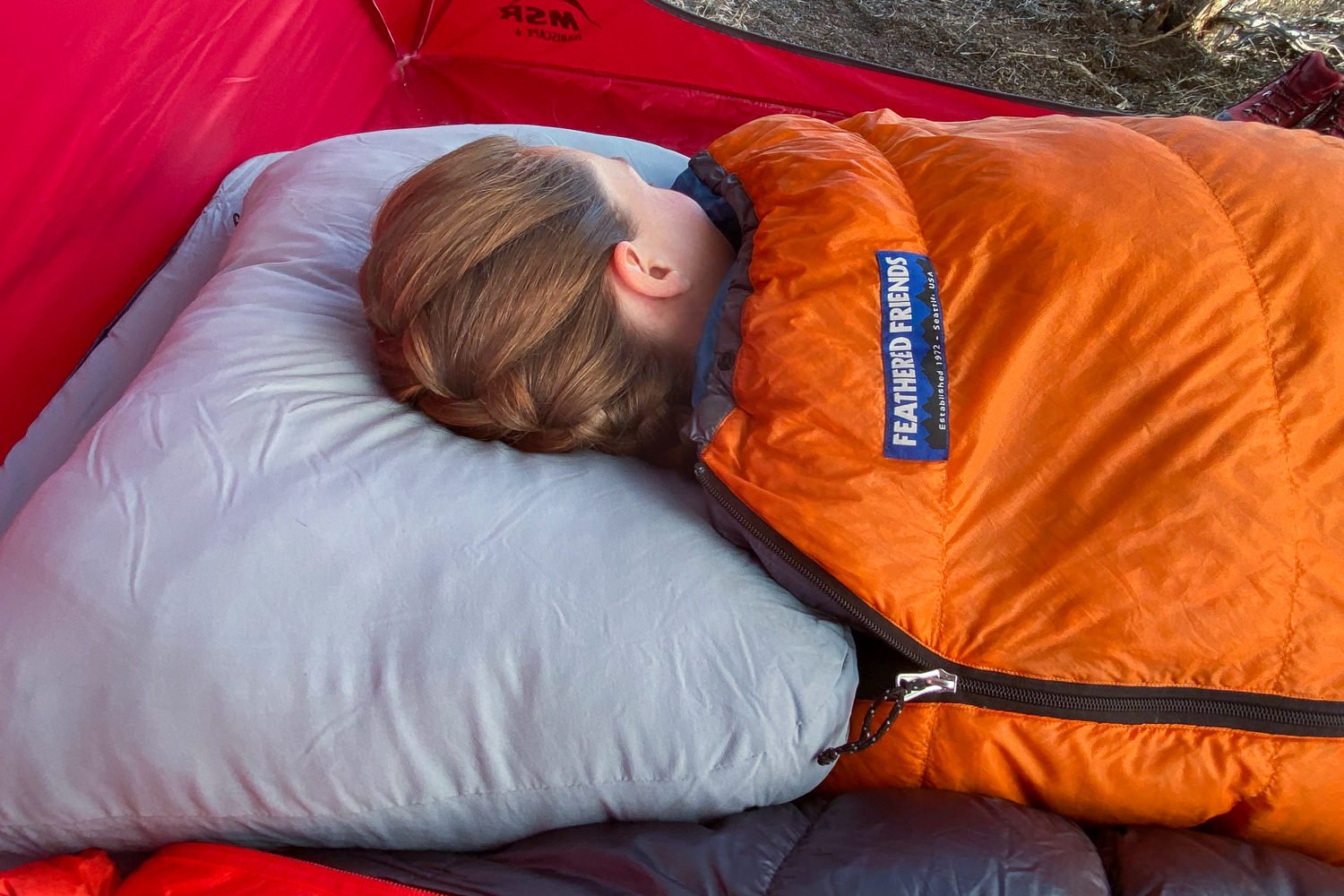
TEMPERATURE
Just like it’s important to have a sleeping pad that insulates you from the cold ground, it’s key to have a pillow that protects your head and face from the cold night air. Especially if you go for an inflatable, consider that the air temperature will penetrate through the baffles of the pillow and transfer to your body. Having a barrier of insulation (like fleece, down, or foam) between your head and the air chamber will keep you a lot warmer and more comfortable. Similarly, you’ll want to choose a pillow that has a comfortable fabric surface that will wick away sweat and keep you cool on warm summer nights.
A pillow that keeps sliding out from under your head can be really annoying and disturb your sleep, and that’s a common annoyance with backpacking/camping pillows. But there’s an easy fix!
Some pillows have tabs on the sides to attach an elastic cord that will secure around your pad, or you can use a few inches of adhesive velcro to create your own pillow-lock system. Simply adhere the soft side (loops) to your pad and the rough side (hooks) to the underside of your pillow – being careful to line them up right. And voilà, your pillow will stay put much better.
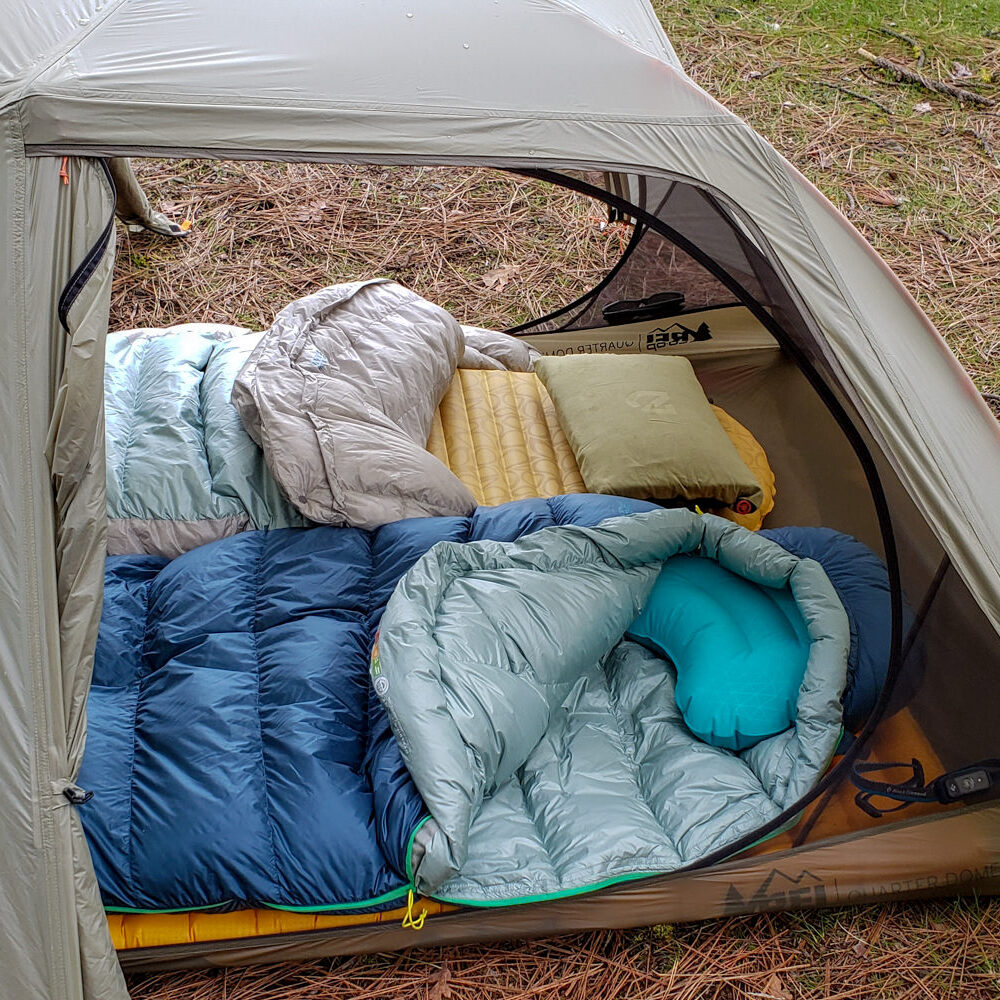
Unfortunately, some of the lightest pillows are also the noisiest due to the crinkly materials they’re made from. While Dyneema and plastics may be ultralight, it can be like trying to sleep with your ear pressed up against a potato chip bag.
Everyone shifts and moves some during the night and it’s likely you’ll hear some rustling no matter which pillow you choose. If you’re a particularly fidgety sleeper, you may want to choose accordingly or bring earplugs for your tentmate.
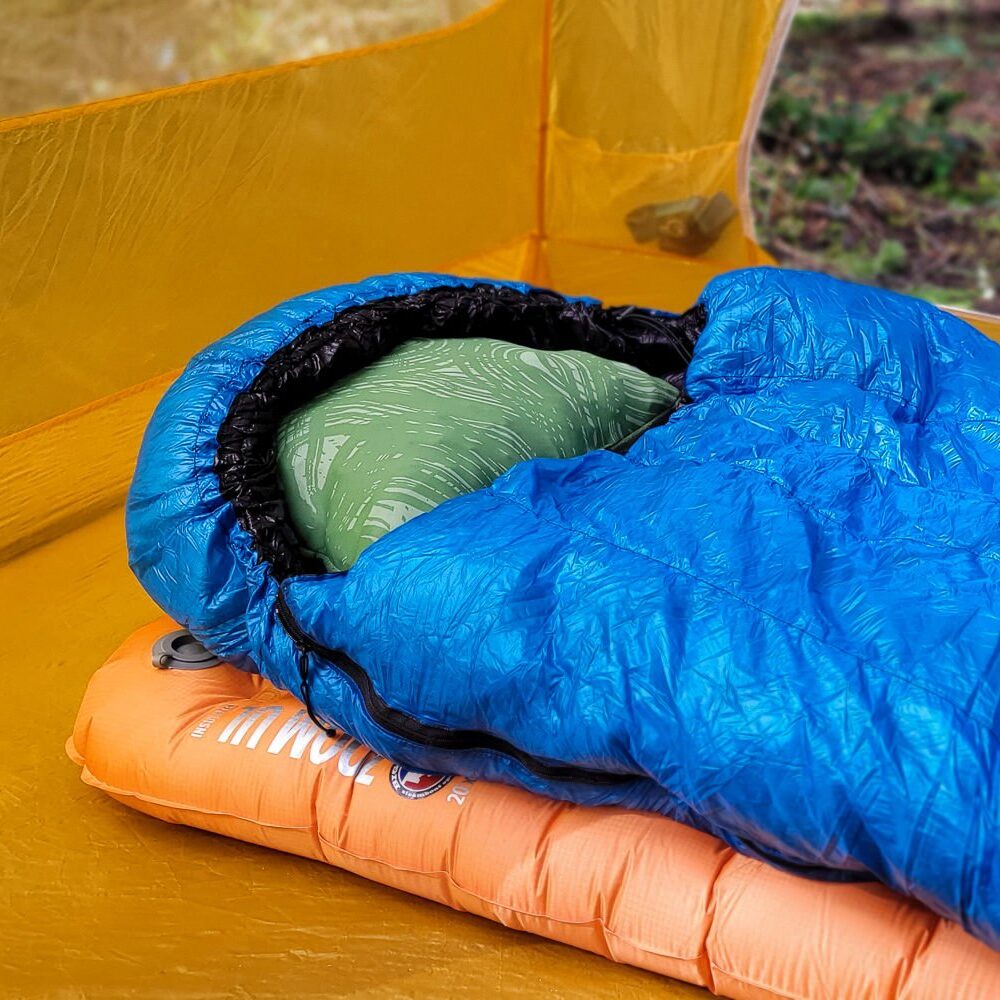
WASHABILITY
Dirt and grime are part of the backpacking/camping lifestyle and many just learn to live with it. But for more fastidious hikers, there are pillows with removable cases that can easily be machine-washed with your clothing after each trip. Down pillows require a bit more care as dirt, sweat, hair oils, and drool can eventually cause them to lose their loft, but it isn’t difficult to rejuvenate them with a little know-how. Check out our tutorial on How to Wash a Down Coat for some pro tips.
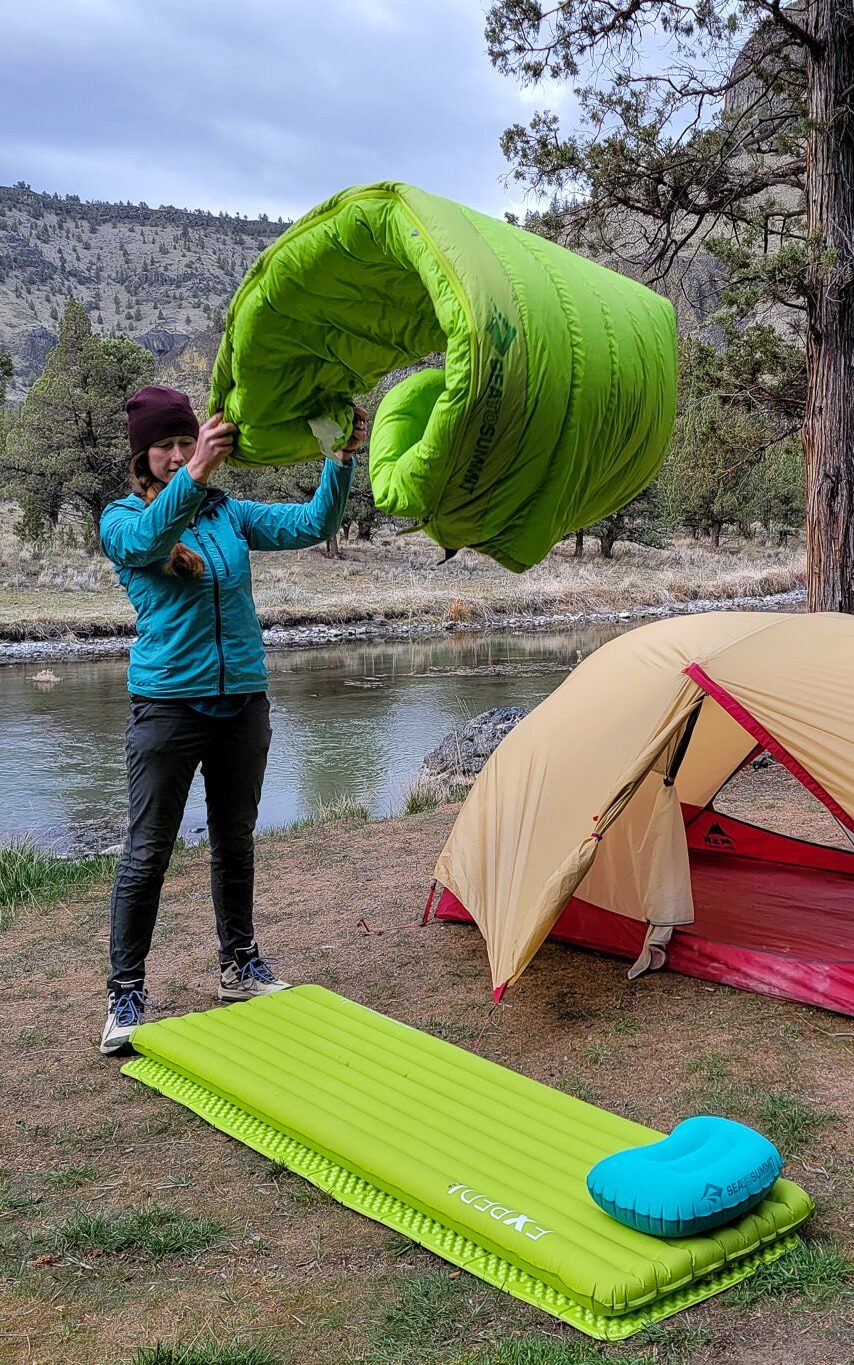
Why trust us?
We understand how tough it is to find trustworthy gear advice, and that’s one of the main reasons we built CleverHiker. We live for outdoor adventure, and we take these guides very seriously.
- Our recommendations are completely independent and based on hands-on experience.
- We test outdoor gear for a living – we’ve logged over 20,000 trail miles and 1,000 nights in the wilderness.
- Our team has thru-hiked some of the most iconic long trails, including the Continental Divide Trail, Pacific Crest Trail, Appalachian Trail, Colorado Trail, Long Trail, Oregon Coast Trail, Arizona Trail, Pinhoti Trail, Superior Hiking Trail, as well as extensive peak bagging, and international treks.
- We field test every product we recommend, which is sadly not the norm.
- We travel to industry trade shows to stay up-to-date on product innovations.
- We continuously update our guides throughout the year and when new products launch.
- We treat recommendations to our readers as if they were for our family and friends.
- We’re lifelong learners and we’re always open to feedback. If you think we’ve missed a worthy product or got something wrong, we’d love to know about it.
Need more Backpacking Equipment advice?
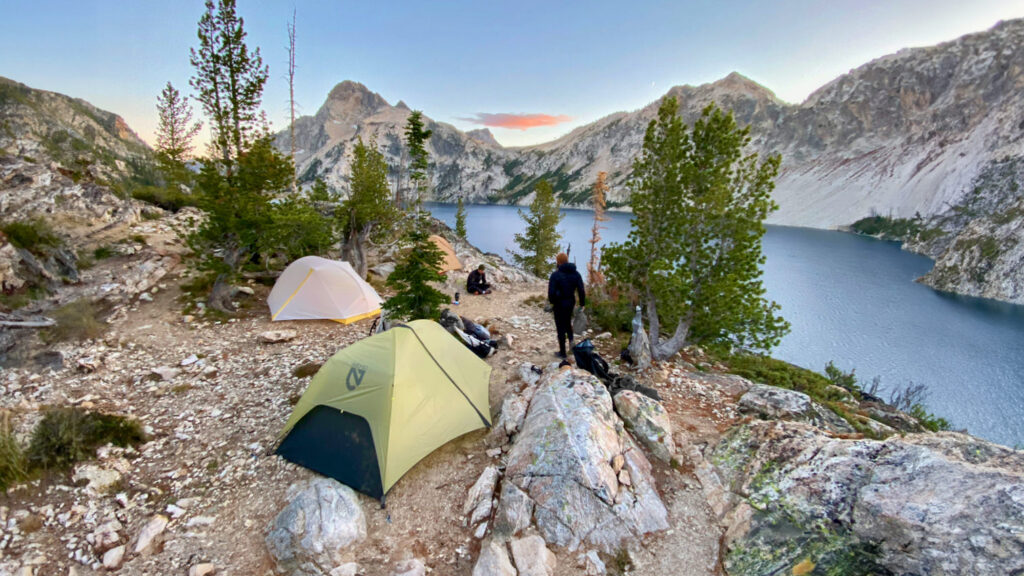
10 Best Backpacking Tents of 2024
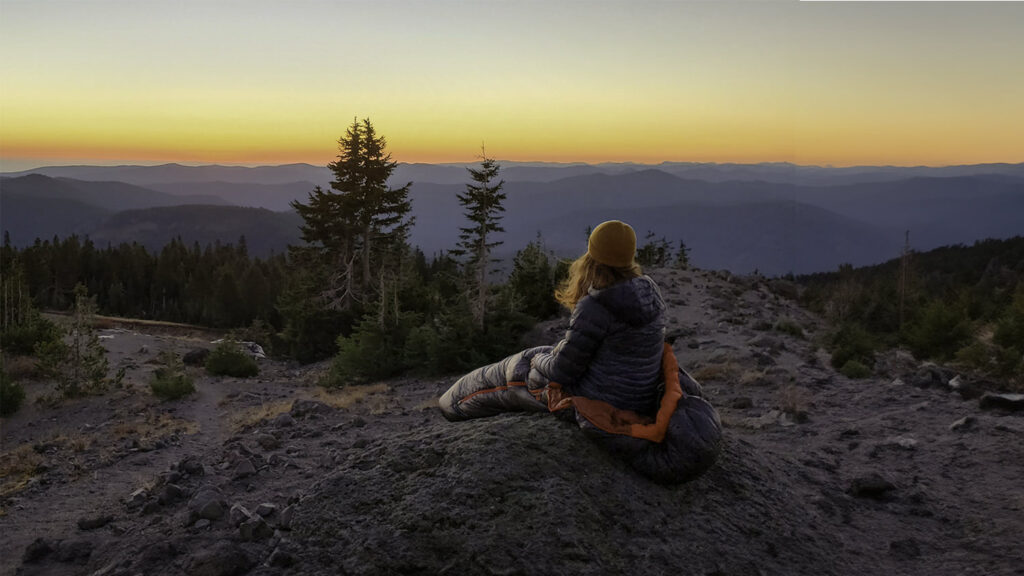
10 Best Backpacking Sleeping Bags of 2024
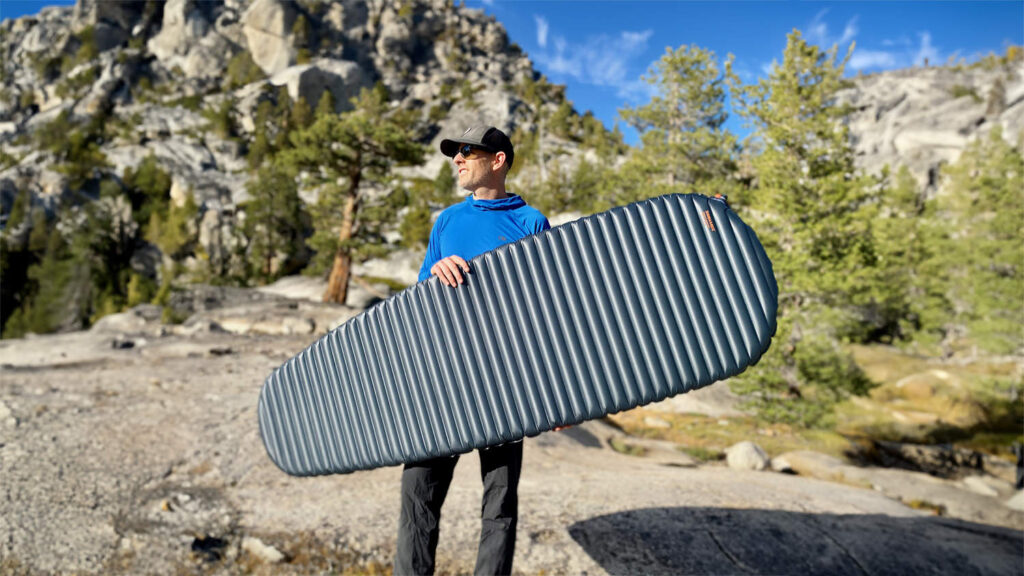
10 Best Backpacking Sleeping Pads of 2024
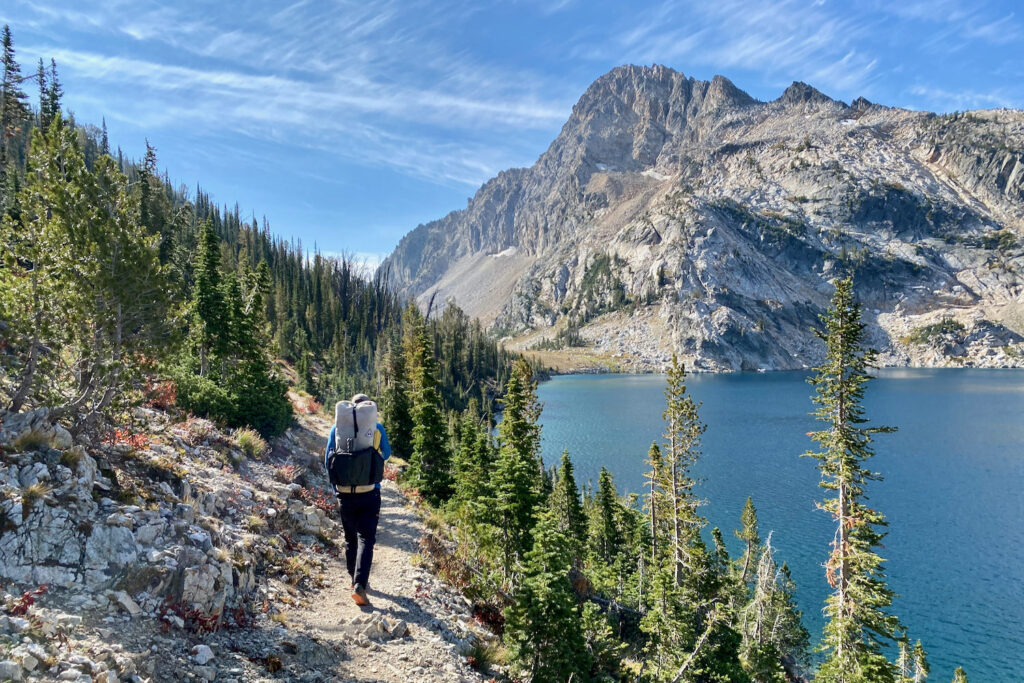
Best Backpacking Backpacks of 2024
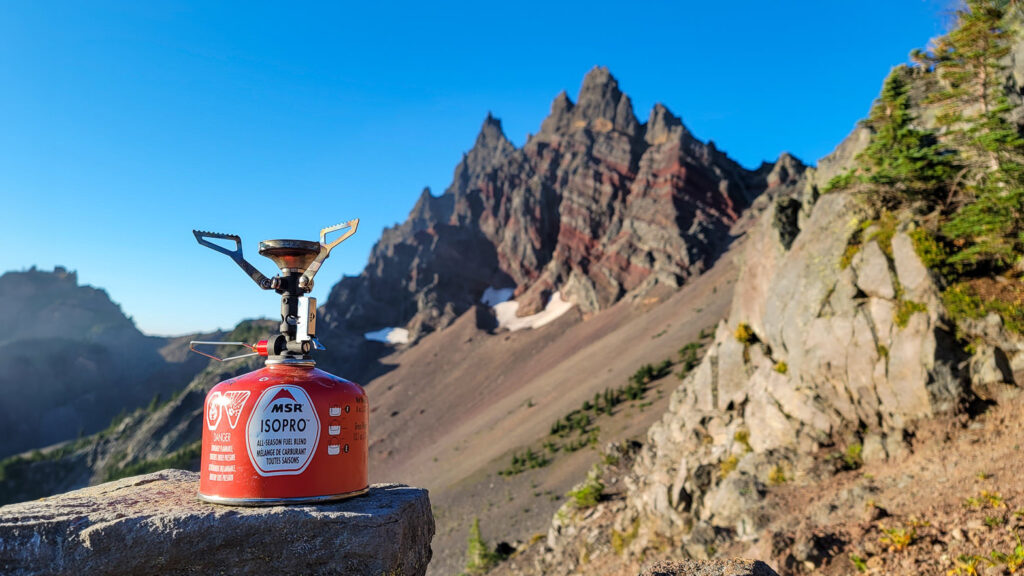
10 Best Backpacking Stoves of 2024
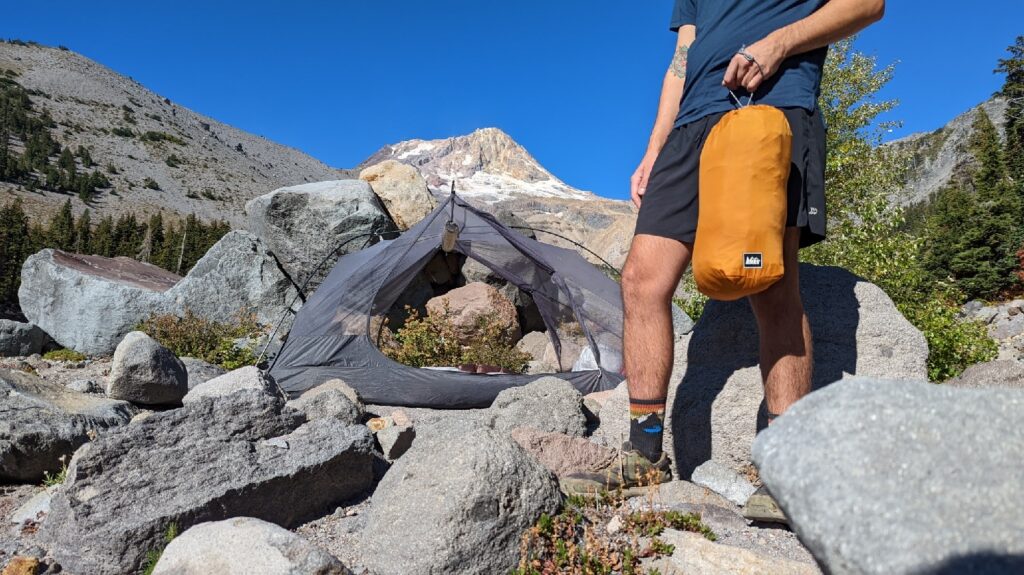
10 Best Stuff Sacks of 2024
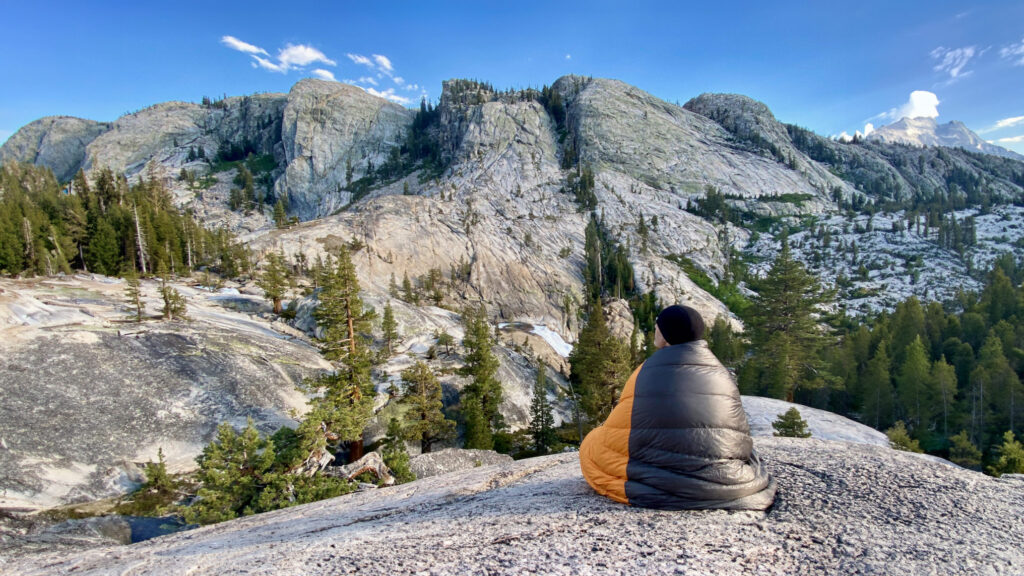
10 Best Backpacking Quilts of 2024
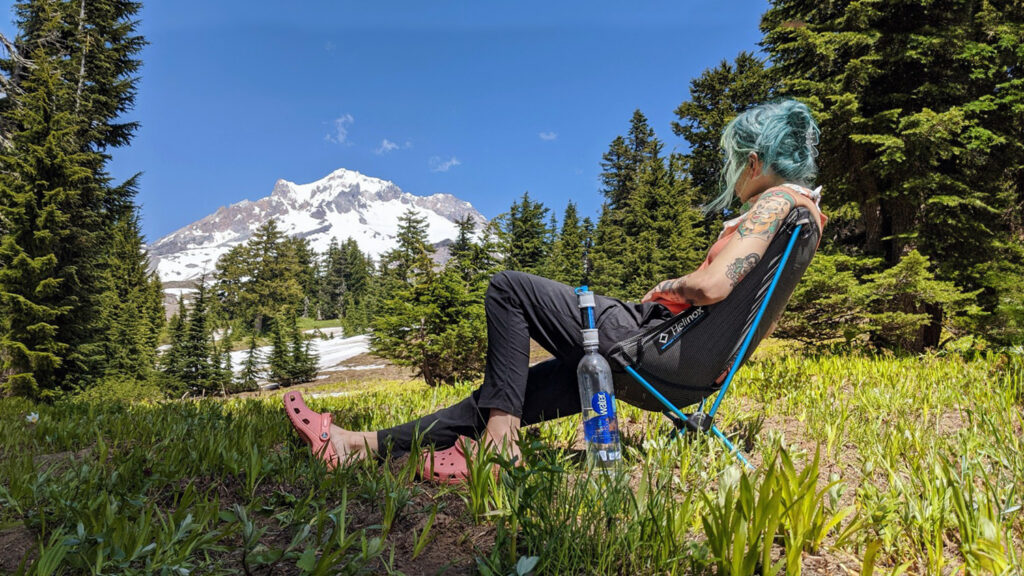
10 Best Backpacking Chairs of 2024
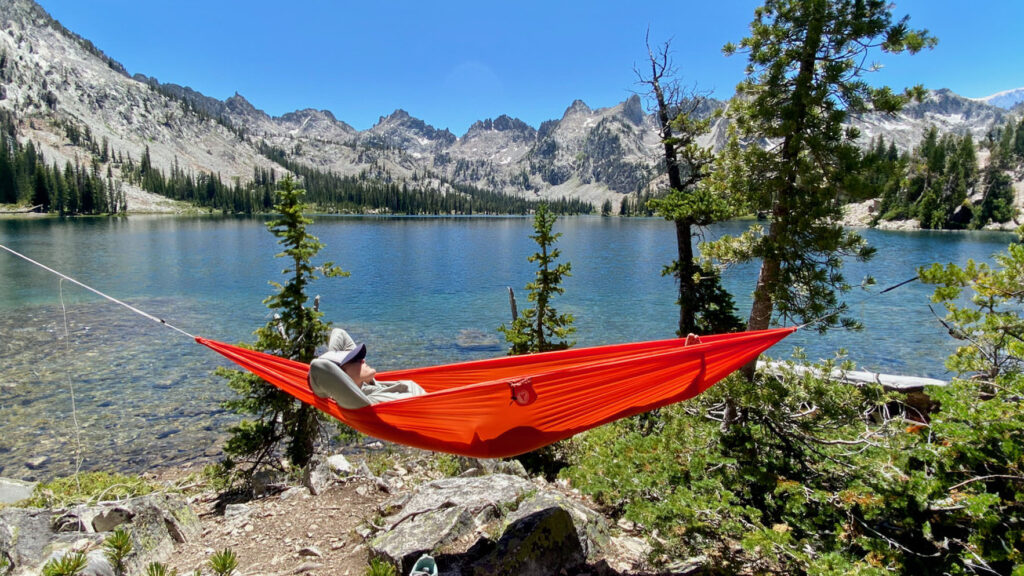
10 Best Hammocks for Backpacking & Camping in 2024
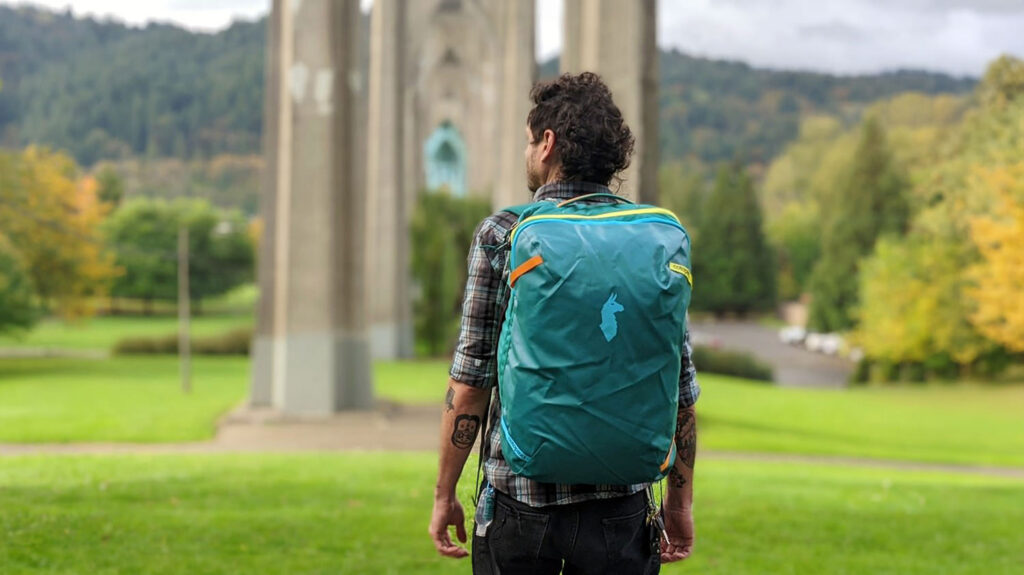
10 Best Travel Backpacks of 2024
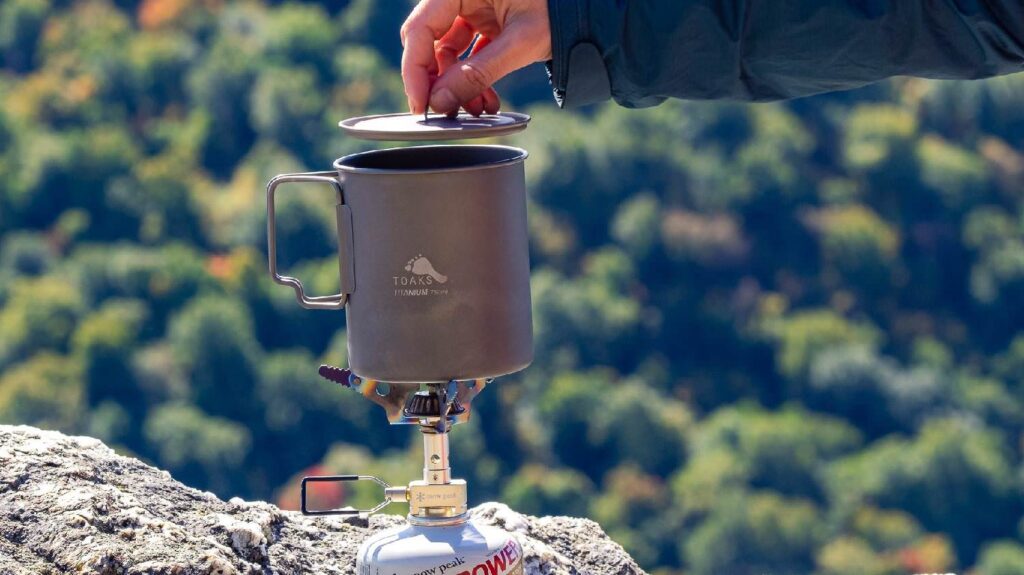
Best Backpacking Cookware of 2024
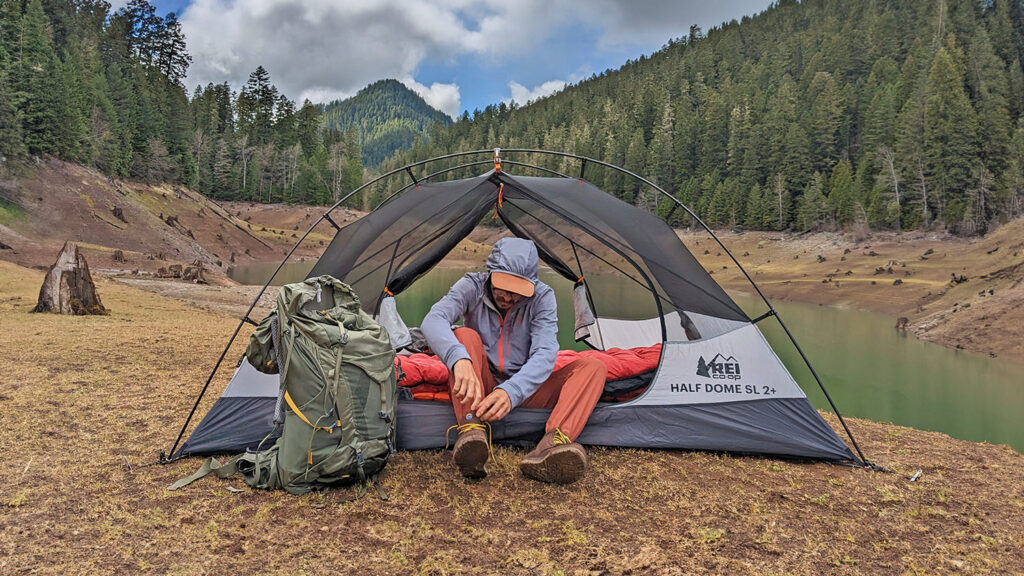
7 Best Budget Backpacking Tents of 2024
Get the best content from cleverhiker & around the backpacking world.
Social media is great, but our bi-weekly newsletter is a much better way to stay in the know.
Sign up to get our curated emails with the best content from CleverHiker and around the backpacking world. You’ll be turned on to new videos, trip reports, gear reviews, inspiring outdoor stories and much more. So get in the mix!
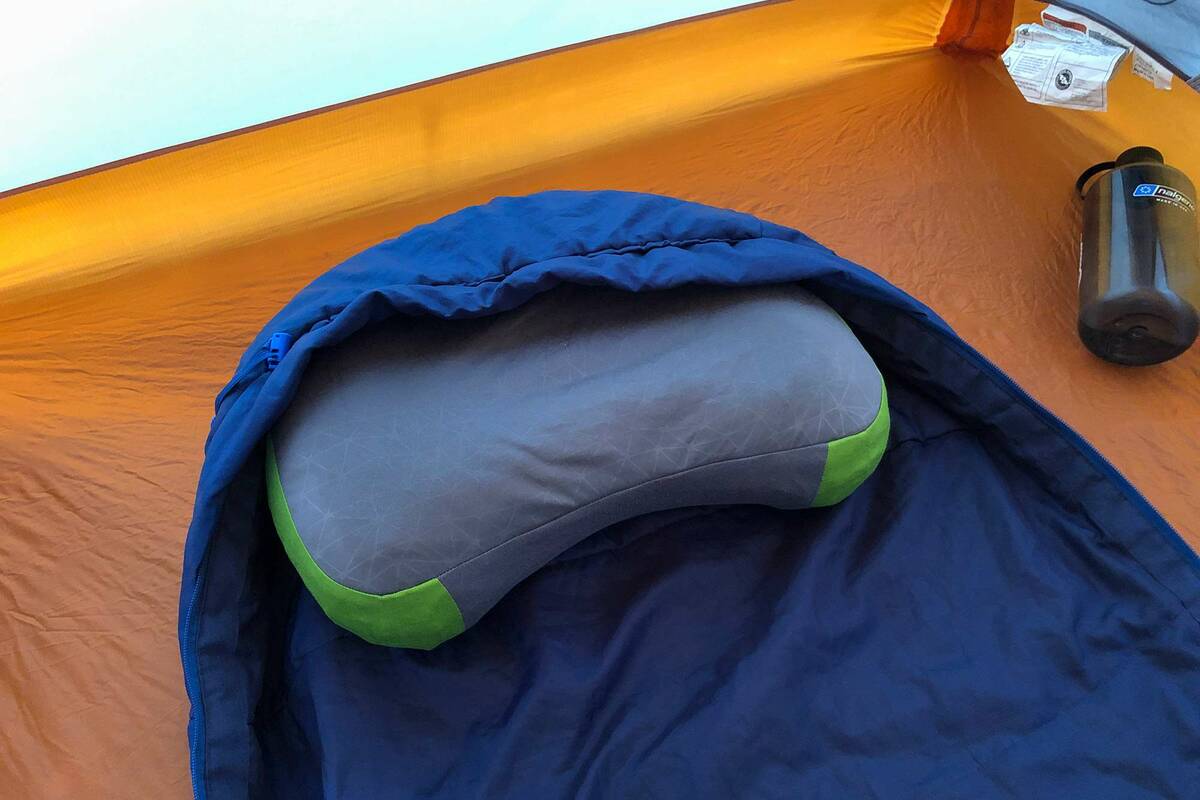
The Best Backpacking Pillows of 2023
- Comparison Table
- Best Backpacking Pillows
Even the most spectacular outdoor getaways can be ruined by an uncomfortable night in a tent. Being unprepared has its consequences, and a night without a proper backpacking pillow may result in a painfully kinked spine. No one wants to see you emerge from your tent with a bent neck like some kind of horror movie monster.
So, how do you avoid crawling out of your backcountry shelter looking like the girl from The Ring? Use a backpacking pillow, of course! We’re giving you the skinny on the best backpacking pillows around. The information below will show you which pillows are best for your sleeping position, the type of cushy insulation they’re filled with, and how easily they will pack away. Backpacking pillows can be ultralight, they can be deluxe, and they can give your neck the much needed support it deserves.
We’ve spent many, many nights in the great outdoors and are happy to use our experiences to put together this Best Backpacking Pillows guide for you. I don’t want to see anymore creepy early morning wendigos walking the trail. Get a proper pillow below!
Backpacking Pillow Comparison Table
The best luxury backpacking pillow.
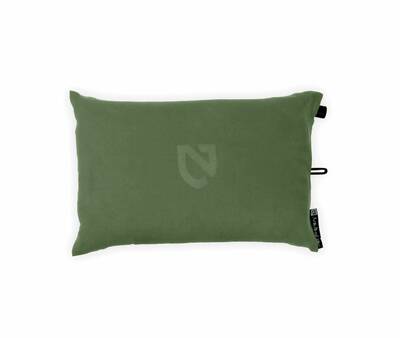
- Weight: 9 oz
- Cost: $39.95
- Best For: Car Camper , Wilderness Backpacker
The NEMO Fillo is a powerhouse of comfort when it comes to your typical backpacking pillow. NEMO utilizes a combination of air and high-grade foam to turn an otherwise airy sleep experience into something that’s more akin to the memory foam pillow you have at home.
The pillow has NEMO’s Twist and Pull Valve, which works well and has a satisfying lock sound to signal the air is in. The model we prefer also has a removable micro-suede exterior, which is comfortable against the face. The air chamber can be blown up to be quite puffy, or much less for a more relaxed (flat) pillow. When combined with the foam this makes the Fillo great for those who don’t want a fully inflated pillow. That said, it’s pretty heavy for a backpacking pillow at nine ounces, and still doesn’t come close to your actual pillow at home. It also doesn’t pack nearly as small as other pillows, if space is your concern.
The Best Ultralight Backpacking Pillow
Sea to summit aeros pillow.
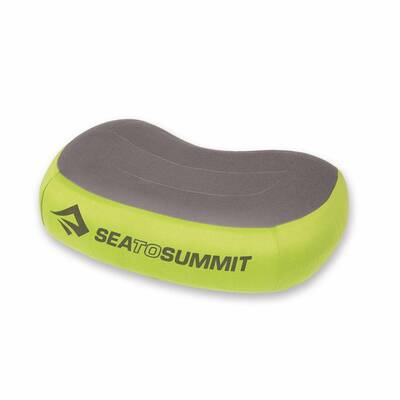
- Weight: 2.8 oz
- Cost: $42.95
- Best For: Ultralight Backpacker
The Sea to Summit Aeros Pillow has become the tiny, ultralight standard of backpacking pillows. It packs to what is often described as “nothing”, which in reality is just a couple inches that can be stuffed anywhere in your pack. It weighs under three ounces as well, and yet uses high-quality 50D polyester fabric and a solid flat valve for easy inflation and deflation. The shape is what we call kidney bean, in that it’s not a full rectangular pillow, and it has a small indent near your neck for solid positioning.
The Aeros Pillow has roughly four inches of height when fully inflated, and isn’t too bouncy. That said, it’s a full air pillow, and won’t be as comfortable when partially inflated because it will be bouncy or feel like it lacks air. If you want one of the lightest backpacking pillows out there, and prefer air over a rolled up jacket, this may be your best bet. Sea to Summit also offers different versions of the Aeros, like the Ultralight and Deluxe, which are lighter and more supportive, respectively.
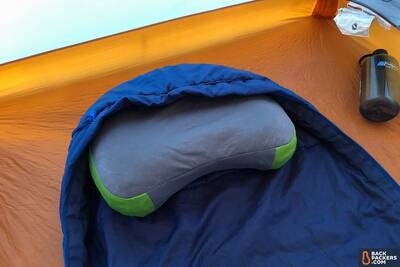
Sea to Summit Aeros Pillow Star Rating
- Adjustability
- Packability
The Sea to Summit Aeros Premium Pillow takes the traditional travel pillow to the next level with plush fabric and an easy-adjust valve for customizable comfort on the trail or anywhere you’ll find a weary traveler.
The Best Backpacking Pillow on a Budget
Therm-a-rest compressible pillow.
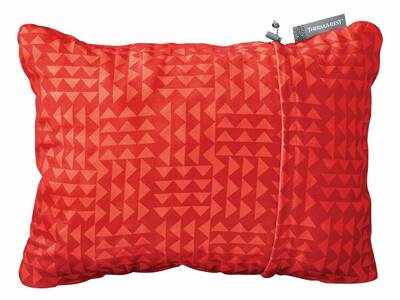
- Weight: 7 oz
- Cost: $24.95
The Therm-a-Rest Compressible Pillow may be the most comfortable on this list if foam support is what you’re into. Unlike the other pillows here the Compressible Pillow uses a lot of foam, and no valve inflation, to create a sleeping surface you can dream upon. The specs listed are for the “small” pillow, which is still decently sized, and competes in terms of height and head-resting space with other pillows on this list. But, because it uses upcycled foam from its pad manufacturing process, the Compressible Pillow is much more comfortable and has almost none of the inflated-feeling that you get from air pillows. The Compressible Pillow is so-named because it can roll and stuff into itself — just crunch it down into the attached flap, then drawstring cinch it tight, and you’ve got a relatively small, fully foam pillow to carry. You can use this packed-up pillow as a lumbar pad or thick headrest, making this the only pillow with a “packed” purpose on this list. All this for a 7-ounce pillow, which contends well with the competition. That said, the big downside is packability — the Compressible Pillow is much larger when packed than any pillow on this list. If foam-based support is what you need, and space isn’t an issue, you can’t go wrong here. Especially for the price. Make sure to get the size you want, as Therm-a-Rest has pillows that range from Small to Extra Large (almost the size of your pillow at home!) (https://www.thermarest.com/compressible-pillow).
The Best Backpacking Pillow for Back Sleepers
Klymit pillow x.

- Weight: 1.95 oz
The Klymit Pillow X’s price, size, and simple design has taken the backpacking market by storm, and many people are popping this in their packs without a second thought. It’s a very basic air pillow with a twist and pull valve, four inches of height, and a sturdy 75D bottom to keep you from popping. The unique design feature (typical of Klymit) is the large X in the middle, which helps to cradle your head. This is best for back sleepers who want their head in one position for the night. The Pillow X has similar design features as the Luxe, but is much smaller and uses only air. It’s also not the most comfortable fabric, especially against your skin, so covering it with a shirt or something is recommended.
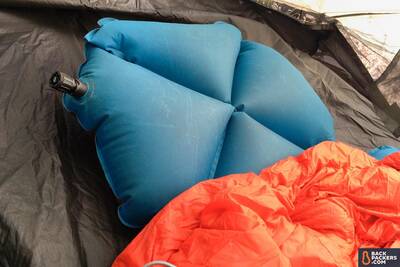
Klymit Pillow X Star Rating
The Klymit X Pillow is an ultralight, highly packable backpacking pillow with one key design feature: an X where your head goes. This keeps your head in place while sleeping, allowing for surprising comfort on your back. It weighs under two ounces, inflates in a couple breaths, and is a no-brainer when backpacking.
The Best Down Backpacking Pillow
Sierra designs dridown pillow.
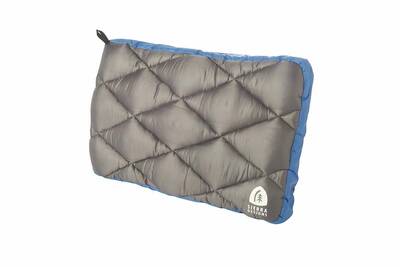
- Weight: 5 oz
- Cost: $29.95
The Sierra Designs DriDown Pillow is unique in a couple of ways and differentiates itself from others on this list. First, the DriDown Pillow actually has two separate pillow components — a quilted down sleeve that has comfort, warmth, and some height to it all by itself, and then a synthetic-fill pillow insert that goes in the topper. You can combine these for a full pillow experience, or leave the insert at home and stuff the quilted topper with a jacket on the trail, thereby saving space and making a piece of gear multipurpose. The second major differentiated factor is the down. There are lots of pillows that use down, but we think the Sierra Designs DriDown Pillow is the best of these. The down is used only in the quilted topper and provides a fine layer of comfort and warmth right where you put your face. The pillow has a nice and even shape, does not use air for height, and packs up quite small. Its main downsides are thicknesses — because of the synthetic fill and down feathers it compresses quite a bit, so is best for those who like a very flat pillow (stomach sleepers!). The insert, overall, could be better, or made of down, or foam, which would make it a must-have. Currently, the DriDown pillow actually makes more sense when only taking the quilted topper and stuffing with a jacket, but you then shouldn’t be paying roughly $30 for a quilted stuff sack. All that said, this is a unique pillow with multiple options, an included stuff sack, and that sweet down sleep experience. (https://sierradesigns.com/dridown-pillow-650-dridown/).
The Best of the Rest
Exped mega pillow.
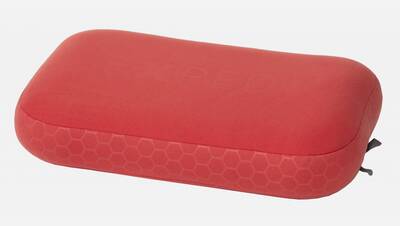
- Weight: 6 oz
- Cost: $49.00
The Exped Mega Pillow takes after its name — it’s huge, provides lots of cushion, and is more about comfort than anything. The Mega Pillow also takes after the semi-legendary MegaMat, Exped’s outstanding 3D-walled camping mattress (LINK), and its goal is maximum comfort and size. It also pairs well with the MegaMat pad, but that’s really for car camping, not backpacking. That said, for a backpacking pillow the Mega Pillow does work — it comes in at 6 ounces, which is not light, but not exorbitantly heavy for true comfort seekers. It has the second-largest footprint and height after the Klymit Luxe, but has an added dose of comfort due to the fleece synthetic fill in the pillow itself. This creates a soft, warm surface for your head — who hasn’t curled your fleece jacket into a ball to sleep on? The Mega Pillow has a two-way flat valve that allows fine-tuning of air pressure, and the top is a comfortable material to rest your head on. The main downside is packed size, which, like the Therm-a-Rest Compressible Pillow, is quite large. Fleece just doesn’t compress well. If comfort is your main component and you want a large pillow that works on backpacking and camping trips, Exped’s Mega Pillow is certainly worth a look. (http://www.exped.com/usa/en/mega-pillow-1).
Exped Air Pillow

- Weight: 2.5 oz
- Best For: Ultralight Backpacker , Wilderness Backpacker
The Exped Air Pillow utilizes a thoroughly engineered design from the Swiss experts on outdoor equipment to create a fairly large, very light air pillow perfect for backpacking. Exped’s Air Pillow weighs just 2.5 ounces and packs up tiny, yet has an impressive 15 x 10-inch footprint when fully inflated, with just over 4 inches of height. This creates a large surface to rest your head on — larger than comparable air pads, so if you want a lot of pillow but little weight, this is a good bet. The Air Pillow has a small indent for side sleepers and is higher on one side than the other, allowing you to find the perfect adjustment level for your needs. Finally, Exped put two baffle depressions in the middle, which lock in your head to keep from sliding at night. This couples with separate inflate and deflate flat valves — the best in the industry. The inflate flat valve can be depressed to let out a little air, too. Overall the Exped Air Pillow is comfortable, light, and quite large. You can get it in the Large version, or you can go the Ultralight or Lite route, which utilize thinner materials and slightly smaller design to save a bit of weight, but we feel this thing is already quite light. (http://www.exped.com/usa/en/air-pillow-m).
Klymit Luxe Pillow
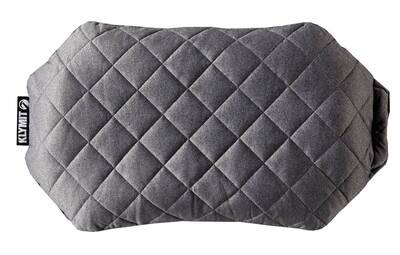
- Weight: 6.4 oz
The Klymit Luxe Pillow will surprise you with its size. The weight makes it a backpacking pillow (just over 6 ounces), but the impressive 22-inch width gives it a true-pillow ability, allowing you to roll your head side to side like you’re on a real bed. The Luxe also uses a removable and washable quilted soft fabric sleeve, which provides a soft surface to sleep on. The twist and pull valve is tucked under the sleeve, a nice touch that keeps it out of the way, and you can adjust the inflation level to up to 5 and a half inches of height, quite a bit more than other pillows on this list. Finally, it uses Klymit’s iconic X design in the center, which cradles and rolls your heads towards the center of the X, giving back-sleepers an upper hand. The Klymit Luxe Pillow is an excellent choice for comfort-oriented sleepers, and won’t totally kill your pack weight. (https://www.klymit.com/luxe-pillow.html).
Cocoon Air Core Ultralight Travel Pillow
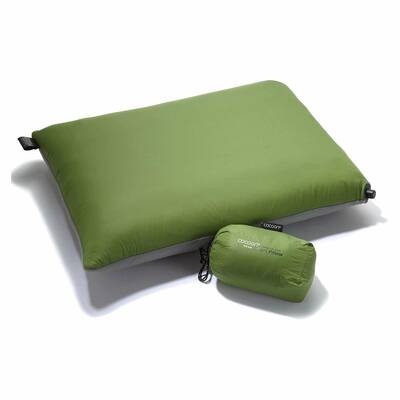
- Weight: 6.7 oz
- Cost: $32.95
- Best For: Car Camper , Urban Hiker , Wilderness Backpacker
Cocoon is well-known as a travel accessories brand, and they have a large line of camping and travel pillows. The Air Core Ultralight pillow is the most appropriate for backpacking, and is a good mix of air and insulation to create a warm, comfy sleeping experience. It’s in the mid-range of weight, coming in at under 7 ounces, but has a little more size than the lighter pillows. The main difference is the synthetic insulation inside the Air Core Ultralight pillow, which acts like foam to create a combination of air and material, allowing you a more substantial surface to rest your head on. The Air Core Ultra also has a warm microfiber side to sleep on during cold nights, and a cooling micro-ripstop nylon side for warm nights. You can remove the cover for washing and repairs, and the twist valve doesn’t pull, which makes it easier to operate, and allows you to adjust while laying on it. Overall Cocoon is actually quite good at making comfort accessories for traveling, and the Air Core Ultralight travel pillow is a good mix of everything, retaining decent comfort in a small package. (https://www.cocoon.at/products/index.php/p/kissen_en).
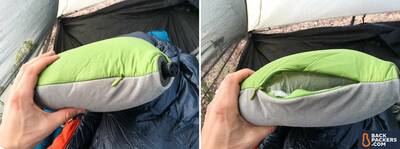
Cocoon Pillow Air Core Ultralight Star Rating
The Cocoon Air-Core Pillow in the ultralight variety strikes an excellent balance between packability, weight, and sleep comfort. It has a synthetic layer that’s removable and washable, and, depending on the size you pick, weighs well under 5 ounces.
Trekology Pillow Ultralight Inflating
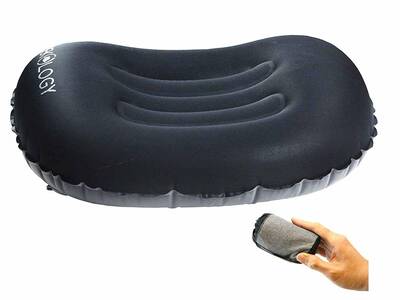
- Cost: $15.47
The Trekology Pillow is one of those Amazon only products that has taken a top performing pillow (the Sea to Summit Aeros) and copied it as closely as possible, with a few design tweaks, and offers it for much less money. We put it on this list, despite having less specs than we prefer, because the price savings is pretty enormous, especially for a small item like a pillow. The Trekology pillow, like the Aeros, weighs 2.8 ounces, packs up incredibly small, has a rough Kidney shape, and utilizes a flat valve, though the valve isn’t as robust. The Trekology Pillow has a different ridge and dip system on top to keep you from slipping, and is a little larger overall. It has a one year warranty, and there are reports of individual units not holding air, but that’s to be expected with a product like this. If you aren’t concerned about name brand or a lifetime of backpacking pillow functionality, the Trekology may be the cheap and easy choice for your adventures. (https://www.amazon.com/Trekology-Ultralight-Inflating-Camping-Pillows/dp/B07BWFJVPH).
Your Pillow
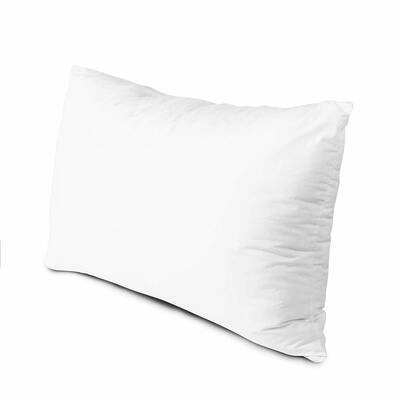
- Weight: 16+ oz
We like to be practical, and it would be impractical to leave out a common and easy choice for backpacking pillows. While taking your own pillow is not the lightest or most packable option, it certainly works. Most backpacks allow you to strap a last-minute item between the brain and the body of the pack, ostensibly the perfect place for a pillow. If you value sleep and don’t mind the extra weight, we don’t really see a legitimate reason why bringing a pillow is a terrible idea, so consider it. It’s cheaper than buying the above, and it might be more comfortable, too. That said, if you want to skimp entirely, you can just ball up some jackets/clothes and use that as a pillow.
Backpacking Pillows vs Camping Pillows
The primary differences between backpacking and camping pillows are weight and packability.
A good camping pillow can offer the same luxurious comfort as your pillows at home. Heck, your favorite camping pillow may just be your nightly bedroom pillow. When car camping, you need not worry so much about how bulky your pillow is — you can cram that baby into any nook or cranny in your trunk, even if it’s full of camping chairs, propane canisters, and overloaded coolers.
Backpacking pillows, on the other hand, need to fit snugly into your backpack — along with everything else you need for a night (or many) in the wilderness. The best backpacking pillows weigh about as much as a full bag of chips and pack down nearly as well as an empty bag of chips, however, backpacking pillows are significantly more comfortable to rest your head on for extended periods of time than said bag of chips.
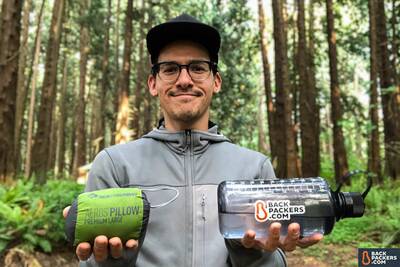
The Sea to Summit Aeros Pillow, even in a size Large, packs down quite small.
The less weight on your back, the more you can snack! No wait, that’s not the saying — I must have chips on the brain. What’s the backpacker’s mantra again? Oh, yes. Less weight equals more fun. That’s right!
But seriously, your backpacking pillow should be lightweight and packable enough so as to be nearly unnoticeable inside of your backpack while you’re hiking. A good backpacking pillow is also versatile. If you pack it away in an easily accessible location it can be a comfortable seat or snack table on short rest breaks. Who says pillows are only for sleeping?

Backpacking pillows: a versatile side-rest, seat, or makeshift table.
Sleeping Positions and Your Pillow
It’s important to consider the way you sleep before purchasing a backpacking pillow. These aren’t your standard one-size-fits-all fluffy rectangles from Target. Backpacking pillows have highly-refined designs which cut down on size and weight, and, as a result, many are engineered for a specific sleep position — two at most.
Those who religiously sleep on their sides should look at sleeping solutions like the Exped Air Pillow. This backpacking pillow has an indent for your shoulder, and it sleeps higher on one side than the other to help side sleepers find the perfect sleeping position. The NEMO Fillo and Therm-a-Rest Compressible Pillows are also good options for side sleepers, as they use foam, which compresses nicely to fit in between the space between your neck, jawline, and the ground.
Back sleepers will find the Klymit Pillow X to be a comfortable ultralight option. The intentional “X” creases of the pillow keep your head centered while the surrounding cushion raises to support your head. Side sleepers would end up with a crooked nose come morning time as a result of this pillow’s shape. The Sea to Summit Aeros works well for back sleepers, too.

X marks the spot in the Klymit X Pillow, providing specific position-locking support for back sleepers.
Pro Tip : Personally, I’ve found that I’m a side sleeper at home, but I sleep on my back when lying on a backpacking pad, and so the Klymit Inertia O Zone sleeping pad with attached X Pillow is my go-to backpacking set up. Do you sleep differently on the trail than you do at home? Best find out!
Backpacking Pillows Types
There are a number of backpacking pillow insulation and interior constructions to choose from. Here’s a breakdown of the various materials inside a backpacking pillow and what you can expect from them.
Air filled backpacking pillows are inflated via your own breath through flat or twist-and-pull valves. Air pillows, like the Sea to Summit Aeros Pillow, are the most lightweight and most packable backpacking pillows on our list as they’re full of nothing but your very own hot air. Excessive inflation can make for a bouncy pillow, though you can adjust the pillow inflation to the exact amount you prefer. Once you’re done catching Zs you can roll the pillow into a little taquito that will pack away into literally any crevice.
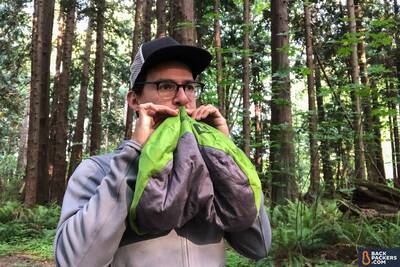
Air is the key ingredient for many backpacking pillows. Add the right amount and you’ll sleep well!
Foam pillows provide firm support and cradle your face with specifically engineered material, much like a memory foam mattress, rather than air pressure. No huffing and puffing is required, and the comfort is typically more like a real pillow at home. Then again, foam pillows like the Therm-a-Rest Compressible Pillow don’t pack down nearly as small as air pillows and weigh quite a bit more. Many people prefer the supportive cushion of foam pillows and consider their ample comfort to outweigh their bulk.
The best of both worlds (or worst, depending on your needs), can be found in a combined Air + Foam pillow , such as in the NEMO Fillo. This is the same tech used in most self-inflating sleeping pads. The interior foam fluffs up once it has the chance to decompress, pulling in outside air through a valve as it does, and then you can add in a few breaths to dial in the perfect amount of firmness. We think this makes for an ideal combo (as do many people), but your preferences may differ.
Down and synthetic fill pillows combine comforting physical material like foam pillows, along with some insulation properties, but also have the lighter weight of air pillows. The downside (ha) is that these materials compress while you sleep. This won’t be an issue if you prefer flat pillows, but if thick, cushiony support is your game you’ll have to look elsewhere. That compression does have its benefits, however, such as when you need to stuff the pillow into your pack. The main down pillow we recommend is the Sierra Designs DriDown pillow, though it does suffer from the “flatness” mentioned above.
How to Buy Backpacking Pillows
Understanding the different types of backpacking pillows, along with their costs and benefits, goes a long way to finding your perfect pillow. We’ve gone over much of what the different backpacking pillows have to offer, and now let’s discuss a few key considerations to think over before choosing your next pillow.
Consider Your Other Sleep Gear
Your outdoor sleeping setup will greatly affect your backpacking pillow needs. If you’re like the majority of backpackers out there who sleep in a tent on top of an inflated sleeping pad, most pillows will work for you.
Depending on how plush your sleeping pad is, you may need to consider how thick your backpacking pillow will be, or get an air pillow that can be adjusted on the fly. If your body sinks into your luxuriously-soft sleeping pad, you can rest assured that a thick pillow will not, and so you may find your head held too high for comfort.
Consider the fabric that your face will be rest on as well. A silky fleece will feel great against your rosy cheeks while direct contact with rubbery plastic will make your face sweat. Gross. Though, if you use a sleeping bag with a hood, you’ll find that stickier pillow fabrics will help to keep your head from slipping off in the middle of the night. Tossing and turning with nylon on fleece will cause you to shoot your pillow into your tent wall like a slippery bar of wet soap.
Lastly, if you tarp or cowboy camp, thin, ultralight materials may not be your best bet. Look for a backpacking pillow with thicker walls, like the Klymit Luxe, that can withstand brushing up against a renegade twig.
Buying Backpacking Pillows Online vs in Store
Unless you’re completely new to the outdoor gear world, there’s nothing surprising to be found in a backpacking pillow. The exterior fabrics and interior insulation materials are all familiar to anyone who has browsed the racks at REI before.
That said, if you really want to check out backpacking pillows in person, go for it. You’ll likely see a few on display at your local gear store and you may be able to unpackage some, with permission from an employee, to experience first hand.
Most shoppers, though, will be able to choose a great backpacking pillow while browsing online. The specs and materials are all laid out in orderly fashion on every gear site and online store. Using the information we’ve provided in this article, and scrutinizing the fantastic backpacking pillows showcased on our list, will give you a head start on the hunt.
Used vs New Backpacking Pillows
Normally, I have no problem with buying used outdoor gear. I’ve perused my fair share of Craigslist ads and REI Garage Sales, but for a backpacking pillow I’d prefer to buy brand new.
As far as gear goes, new backpacking pillows aren’t all that expensive. I’d rather save face (ha, again) and get a new pillow that hasn’t been inundated with someone else’s sweat, oils, and moisturizing lotion.
That’s just my opinion and you might not care about old face grime so much. If that’s the case, go ahead and keep your eye out for someone else’s “like new” backpacking pillow.
Then there’s the fact that most backpacking pillows can be “popped”, just like a sleeping pad, which is something you’d have to test at length before buying used.
Keep in mind, though, that if you’re looking to save a few bucks, why not carry your home pillow or ball up a bunch of your hiking clothes into an on-the-go pillow? I’ll throw my down jacket into a bug head net as a last-minute alternative — works great for a night or two on the trail! And you can always take your pillow from home — just sandwich it between your backpack’s top lid and main chute. Yes, the extra weight will suck, but a good night’s rest is worth it.
Backpacking Pillows are like Electric Cars
They keep improving year after year.
Like their brother-from-another-mother sleeping pad companions, backpacking pillows are consistently getting more refined as outdoor tech improves. Lighter, more comfortable materials are paired with the latest innovative insulations in each new rendition. New valves, baffle designs, and synthetic materials are just a few of the advancements to look forward to.
And yet they’re still a fairly inexpensive product that holds tremendous value to anyone who covets a good night’s sleep. Grab one now, but keep your eyes peeled for more advanced backpacking pillows in the years ahead.
Backpackers.com Affiliate Policy : This guide contains affiliate links, which help fund our website. When you click on the links to purchase the gear we get a commission, and this goes a long way to creating guides, gear reviews, and other excellent content.
Arthur McMahon
Arthur loves to walk. It's as simple as that. He believes walking is the best way to experience the world. Thru-hiking the Pacific Crest Trail was his first backpacking foray, and he hasn't stopped since. Follow his adventures and stories on Instagram .
Leave a Reply Cancel reply
Your email address will not be published. Required fields are marked *
Welcome to Backpackers.com. We are a small, independent team writing gear reviews and useful outdoor guides.
Our mission is to empower all walks of life to be ambassadors of the outdoors. Read our About page for more information, and check out our gear reviews , trip reports , and outdoor guides .

Best Camping and Backpacking Pillows of 2024
From ultralight inflatables for backpacking to plush memory foam designs for ultimate car camping luxury, we break down the year’s top outdoor pillows.
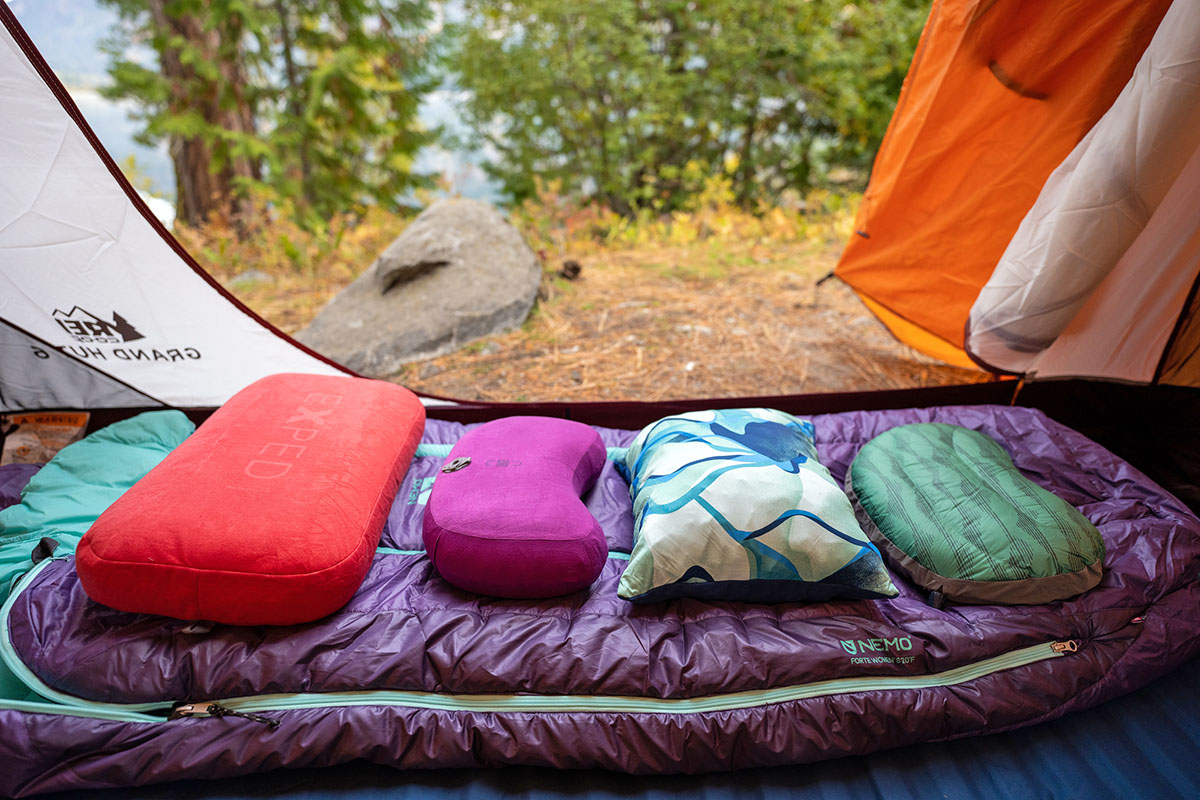
Jason Hummel Photography
We use affiliate links and may receive a small commission on purchases. Read more about us .
While small and relatively unassuming, a quality outdoor pillow can go a long way toward improving your sleep, whether you’re spending the night at your local state park or trekking miles into the backcountry. Designs range from ultralight and compressible inflatable models for multi-day backpacking missions to plush memory foam designs for ultimate car camping luxury, with many of our picks offering a good balance of comfort and weight to pull double duty. Below we break down our favorite camping and backpacking pillows of 2024. For more background information, check out our detailed comparison table and buying advice below the picks.
Our Team's Camping and Backpacking Pillow Picks
- Best Overall Camping Pillow: Therm-a-Rest Compressible Pillow
- A Close Second (That's More Packable): Nemo Fillo Pillow
- Best Lightweight Pillow for Backpacking: Sea to Summit Aeros Ultralight
- Best Budget Camping Pillow: REI Co-op Trailmade Mummy Bag Pillow
- Best Premium Camping Pillow for Comfort Seekers: Hest Camp Pillow
- Best Stuff Sack Pillow for Ultralight Adventures: Zpacks Medium-Plus Pillow
Best Overall Camping Pillow
1. therm-a-rest compressible pillow ($37).
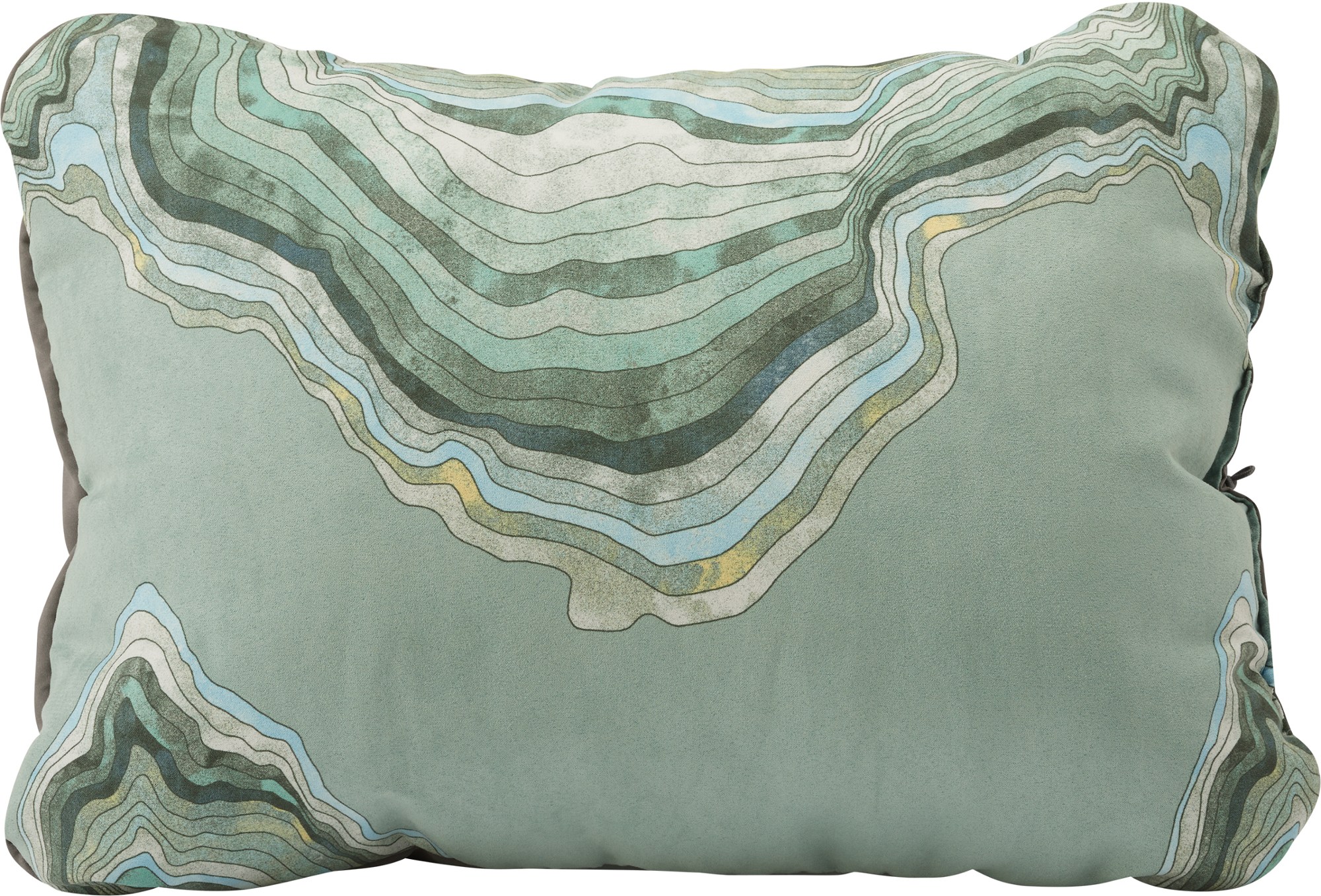
Therm-a-Rest makes some of our favorite sleeping pads on the market, and that expertise transfers over nicely to their pillow collection. During testing, their Compressible Pillow was quick to win us over: The exterior uses a soft and supple polyester cover, while the inside is filled with compressible but supportive foam that’s been upcycled using excess material from their sleeping pads. We’re also big fans of the cinch cord at the side, which allows you to tailor firmness depending on your sleeping preferences. Therm-a-Rest also added an additional layer of light insulation at the top, which is intended to minimize lumps. And a final bonus: The pillow is machine-washable—simply throw it in with your other clothing when it needs a cleaning.
What’s not to like with the Therm-a-Rest Compressible Pillow? First is the lack of backcountry appeal: Despite its “compressible” designation, the pillow’s foam insulation adds weight and bulk and doesn’t allow it to stuff down small for backpacking missions. For comparison, inflatable designs like Sea to Summit’s Aeros Ultralight below are far lighter (by nearly 8 oz.) and more compressible, although they come with drawbacks in terms of comfort and durability. The Therm-a-Rest’s foam also takes some time to expand—we recommend undoing the cinch cord as soon as you get to camp and fluffing it up to speed up the process. Compression requires similar planning, including rolling it twice to smooth things out before packing away. Despite these drawbacks, the Compressible Pillow offers great comfort and support for the weight, earning it our endorsement as the best overall camping pillow this season (it makes a decent travel companion, too). See the Therm-a-Rest Compressible Pillow
A Close Second (That's More Packable)
2. nemo fillo pillow ($45).
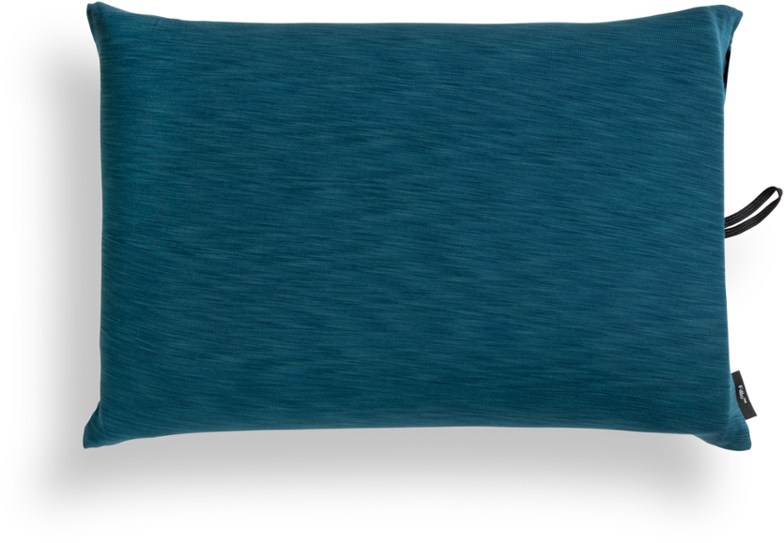
The Therm-a-Rest Compressible Pillow above is filled exclusively with foam, which offers great cushioning and support but adds some weight and bulk. Enter Nemo's Fillo Pillow, which has a hybrid foam/air construction that allows it to be a bit lighter and far more compressible without a major impact on all-night comfort. All in all, it’s a simple but well-executed design: Once removed from its attached stuff sack, the foam inside will begin to inflate, and you can top it off by blowing into the air valve at the side, which is easy to open and close with a quick twist. This gives the Fillo a super plush and premium feel without the balloon-like shape of standard inflatable designs like Sea to Summit’s Aeros offerings below. And at a manageable 6 x 4 inches when compressed, the Fillo is noticeably smaller than Therm-a-Rest’s Compressible Pillow above (12 x 7 x 4 in.), making it the better pick for bringing along on the occasional backpacking trip.
No pillow is perfect, however, and the Nemo Fillo does come with a few downsides. First, at 17 inches long and 11 inches wide, it’s noticeably smaller than Therm-a-Rest’s Compressible Pillow above, which measures 18 x 13 inches for the “regular” size. It’s also thinner at 4 inches compared to the Therm-a-Rest’s 6-inch-thick build, which is a downside for side sleepers and those prone to tossing and turning throughout the night. It’s worth noting that Nemo does make the Fillo in a larger “King” version , which is 17 inches long, 14 inches wide, and 6 inches thick but costs $30 more than the standard version here (and double the price of the Therm-a-Rest). Finally, the Fillo takes some patience and finesse to get back into its stuff sack—we’ve found it works best to fold it in half lengthwise before rolling it up. But there’s a reason this pillow is so popular: If the dimensions work for you, the Fillo packs in excellent comfort and support for its weight and size. See the Nemo Fillo Pillow
Best Lightweight Pillow for Backpacking
3. sea to summit aeros ultralight ($45).
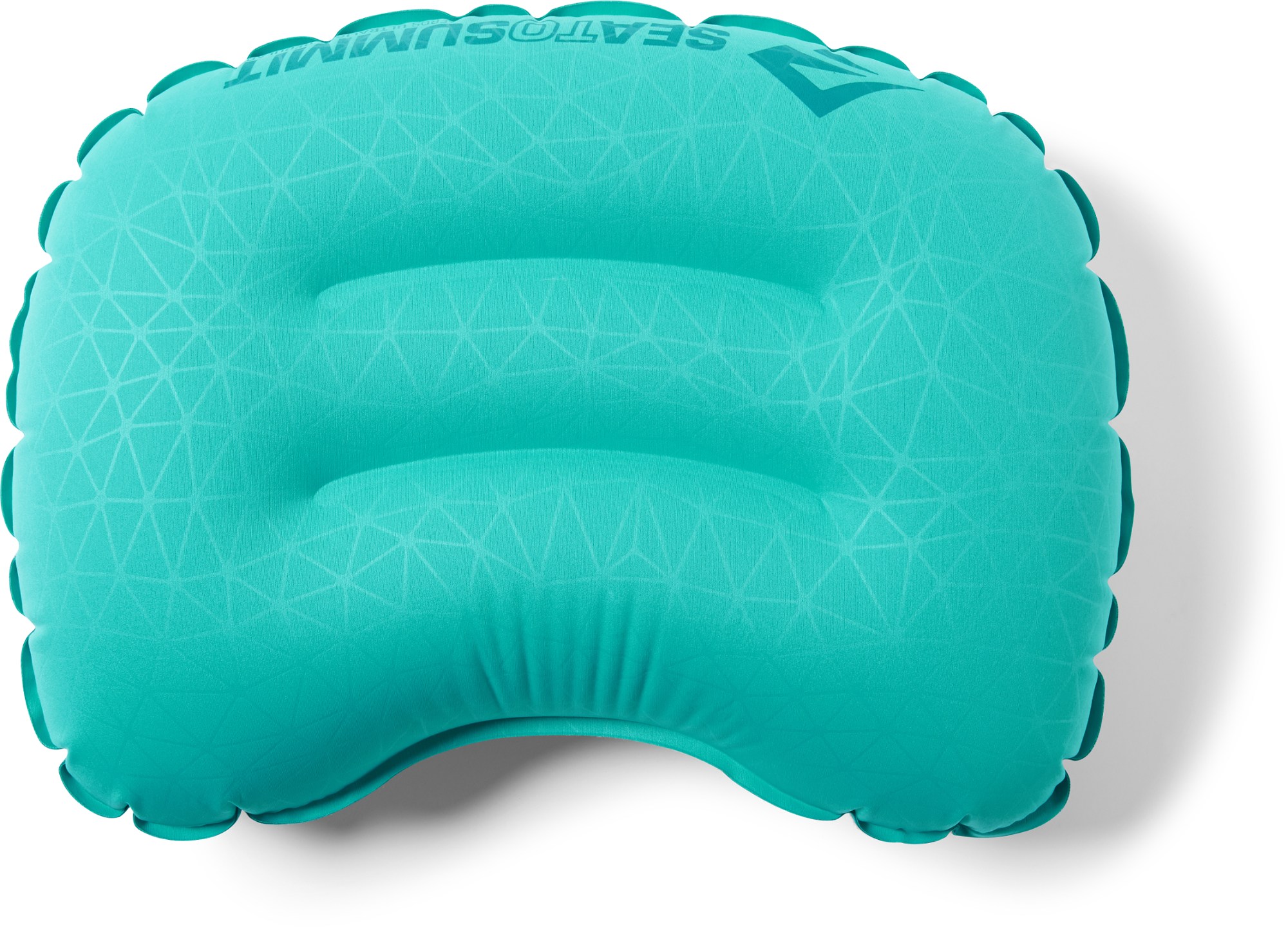
The pillows above offer great comfort and support for car camping, but for minimalist backpacking adventures that take us deep into the backcountry, we turn to ultralight inflatable designs like Sea to Summit’s Aeros collection. Clocking in at a scant 2.1 ounces, the Aeros Ultralight Pillow here is the lightest model in the lineup and well suited for multi-day trips when you’ll want to keep weight to a minimum. Packed size is equally impressive: The pillow compresses down to about the size of a baseball, making it a no-brainer to bring along even on gear-intensive missions when space is at a premium. Finally, despite its ultralight build, the Aeros includes thoughtful touches like quick and easy inflation via the low-profile valve (it just takes a couple breaths), a soft stretch-knit fabric that’s comfortable against the skin, and curved internal baffles to keep your head centered on the pillow.
We’ve been using Sea to Summit’s Aeros Ultralight for multiple seasons, and it quickly became a must-have item in our pack. That said, on car camping adventures, we typically leave the Aeros behind and instead opt for a plusher foam option like the Compressible Pillow or Nemo Fillo above. While heavier, these pillows offer a sizable boost in all-night comfort with softer materials and larger dimensions. We’ve also found the Aeros prone to sliding around when fully inflated unless secured inside the hood of a mummy bag (many campers opt for roomier rectangular bags that typically forgo hoods). Alternatively, all of Sea to Summit’s sleeping pads come with adhesive hook-and-loop patches to secure their pillows in place. A final gripe is the Aeros’ thin 20-denier shell, which has a delicate feel and gives us pause around sharp gear (although we haven’t had any issues to date). But for backpackers who want to keep things light without forgoing some creature comforts, the Aeros Ultralight has its place. See the Sea to Summit Aeros Ultralight
Best Budget Camping Pillow
4. rei co-op trailmade mummy bag pillow ($20).
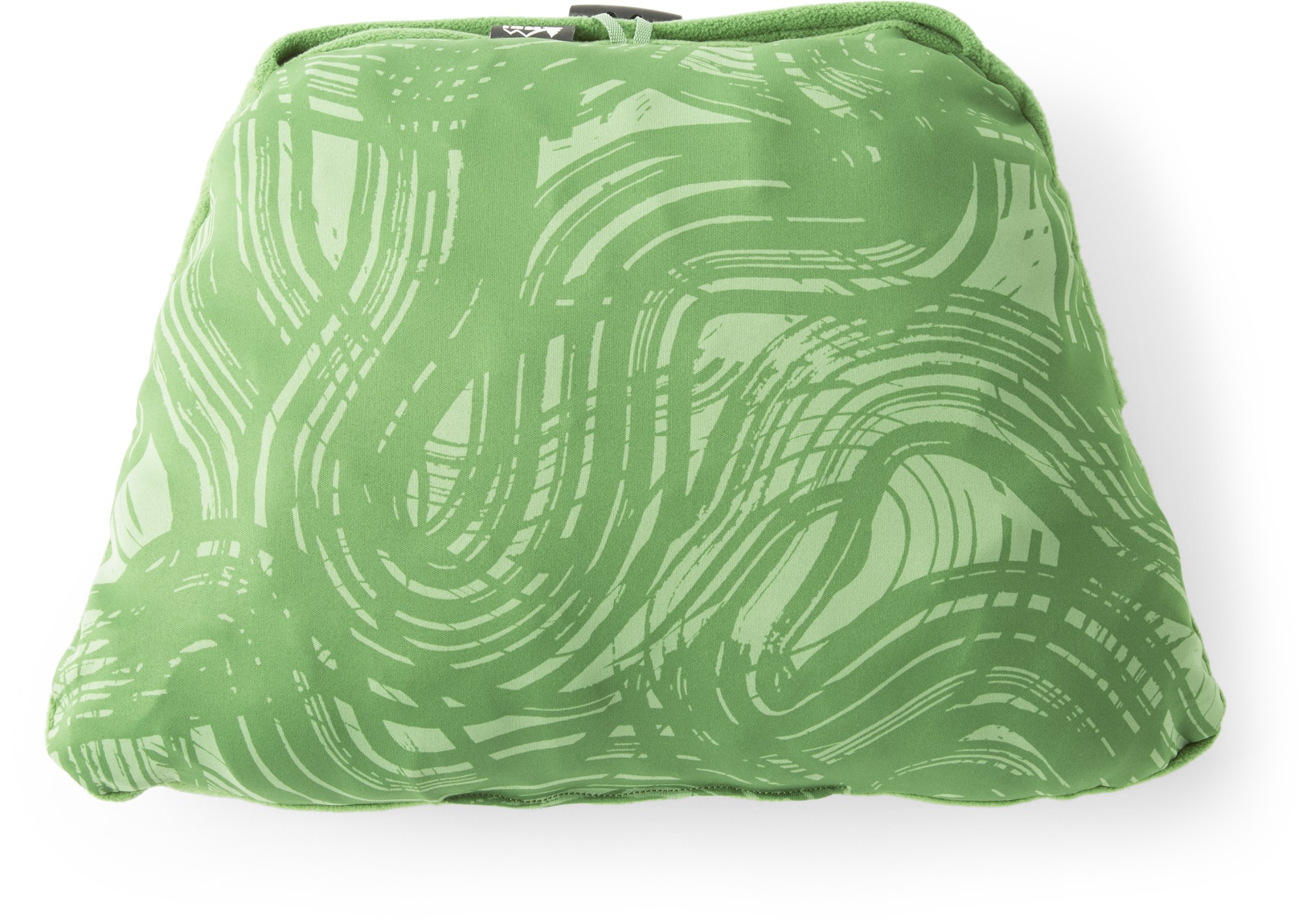
Camping pillows are inherently a pretty affordable bunch, but that doesn’t mean there aren’t great deals to be found. REI Co-op’s Trailmade Mummy Bag Pillow is a shining example: At just $20, it’s around half the price of the options above but doesn’t skimp on all-night comfort with plush fleece on one side and a soft polyester fabric on the other. As its name suggests, the Trailmade is also shaped to tuck neatly inside the hood of most mummy bags—including roomier models like the Nemo Forte—while offering a little more pillow space than curved designs like Sea to Summit's Aeros models. Finally, we love that the Trailmade is made with recycled materials and excess foam from REI’s self-inflating sleeping pads—a nice reflection of the brand’s ongoing sustainability efforts.
However, the REI Trailmade isn’t without shortcomings. First, while the foam insulation compresses surprisingly well—when stuffed down, it’s noticeably smaller than the Therm-a-Rest Compressible Pillow above—it still adds bulk compared to inflatable alternatives. The REI also has a tendency to form lumps, although that’s fairly common among non-inflatable designs, and massaging the foam should help achieve an even sleeping surface. Finally, the Trailmade is on the smaller side for camping at 15.1 inches long by 9.6 inches wide, which can result in sliding around inside the hood of a rectangular sleeping bag (it works best in a mummy-style bag). But we keep coming back to value: The REI is competitively well rounded for the price and light enough to double as a “luxury” item on backpacking trips. For $10 more, we also like Sea to Summit’s Foam Core Pillow , which adds synthetic fill between the pillowcase and foam core but is even smaller than the Trailmade (it does come in "Large" and "Deluxe" sizes for more). See the REI Co-op Trailmade Mummy Bag Pillow
Best Premium Camping Pillow for Comfort Seekers
5. hest camp pillow ($89).
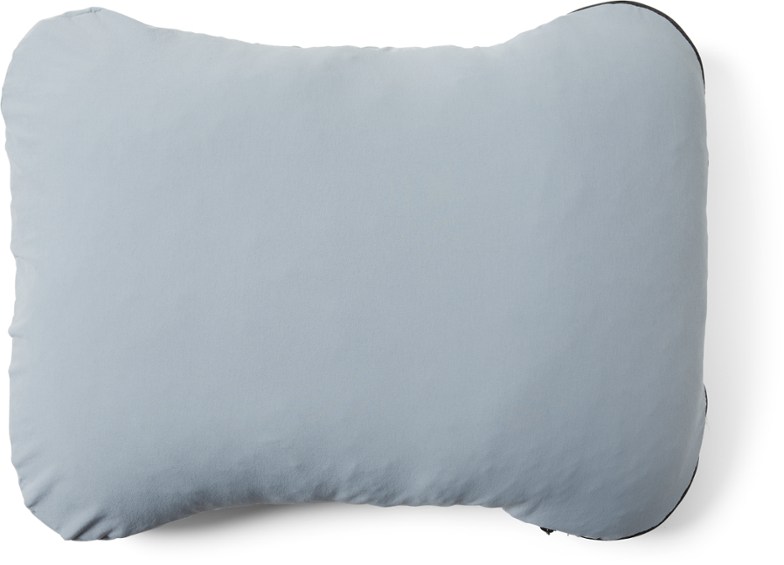
Hest has broken into the car camping scene with a Yeti cooler-like focus on quality. The brand’s Camp Pillow is case in point, utilizing a premium blend of memory foam and polyester in a generous, 8-inch-thick design for excellent support and structure, especially for side sleepers. The stretch-woven nylon exterior is also very soft against the skin, while the curved shape helps cradle your head and neck. All of the smaller details are equally well sorted, including zippered access to fine-tune height and firmness, a PU coating along the shell for added assurance against moisture and stains, and a removable and washable cover for easy cleaning. And when it's time to pack up camp, simply turn the pillow inside out and zip the cover shut—there’s also a built-in carry loop for clipping to a duffel or pack. All told, it’s a luxurious-feeling pillow that will likely make you forget you’re sleeping in the woods and can easily pull double duty at home for guests.
All that said, there are some major downsides to the Hest Camp Pillow’s decidedly luxe design. First is weight: At 2 pounds 3.2 ounces, the Hest is the heaviest option here by a wide margin. It’s also the bulkiest, which means it’s best suited for car campers who aren’t limited on space. Finally, at $89, you’re paying a pretty steep premium for the high-end materials and construction. You can certainly bring along your pillow from home as a substitute, but the Hest's dirt- and water-resistant cover and integrated stuff sack add sizable benefits for long-term outdoor use. In the end, the Hest will be overkill for some, but it leaves little to be desired for serious comfort seekers. Hest also offers a larger version called the Standard Pillow , which measures 26 inches long by 20 inches wide, weighs a pound more, and costs $119. See the Hest Camp Pillow
Best Stuff Sack Pillow for Ultralight Adventures
6. zpacks medium-plus pillow ($55).
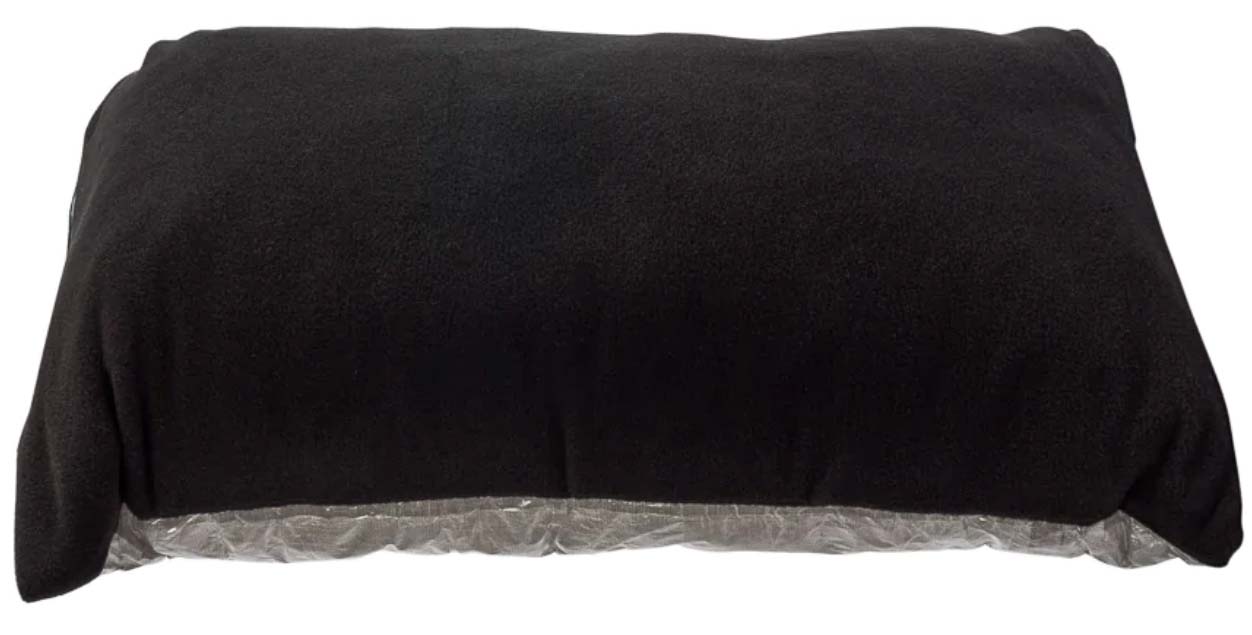
For minimalists and ultralight adventurers who scoff at adding unnecessary ounces to their base weight, a stuff sack pillow could be a good compromise. Essentially specialized pillowcases, these designs are uninsulated and provide a space to stuff extra clothing (which you’re already carrying) to create a makeshift pillow at night. Zpacks’ Medium-Plus Pillow is our favorite option in this category and stands out for its versatility: Made with highly water-resistant Dyneema fabrics and protective details like fully taped seams and a waterproof main zipper, the pillow can function as a dry bag to protect your gear on the trail. At night, simply turn the Medium-Plus inside out to reveal the soft micro fleece surface and stuff any spare clothes inside for use as a pillow. At just 1.7 ounces, the Medium-Plus adds a negligible amount of weight to your pack, and the dual-purpose build makes it even easier to justify.
In terms of downsides, stuff sack pillows like the Zpacks Medium-Plus aren’t as intuitive or user-friendly as traditional designs. In short, it can be difficult and time-consuming to achieve an even and consistent packing job—rather than just inflating the pillow, you’ll need to take some time to intentionally stuff clothing inside until you reach your desired firmness. The bottom of the pillow (without the micro fleece) also tends to slide around throughout the night, and we recommend purchasing Zpacks’ Pillow Attachment Cord (a $6 add-on) to keep it in place. Finally, at $55, the Medium-Plus is pricey for what you get, and most recreational backpackers will be better off saving with an option like the Sea to Summit Aeros Ultralight above (which is just 0.4 oz. heavier). But for weight- and space-conscious missions, the Zpacks’ two-in-one design certainly has its appeal. For a similarly built option from another leading UL brand, check out Hyperlite Mountain Gear’s Stuff Sack Pillow (also 1.7 oz.). See the Zpacks Medium-Plus Pillow
Best of the Rest
7. sea to summit aeros premium ($50).
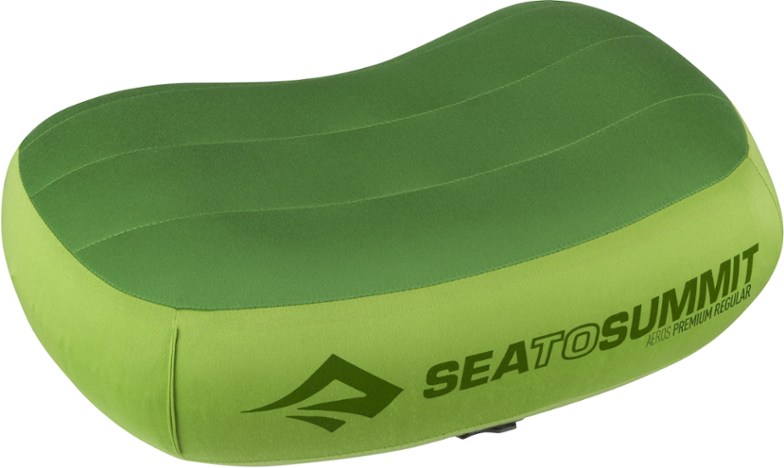
The second Sea to Summit model to make our list this season is their Aeros Premium Pillow, which offers a step up in comfort and durability compared to the Aeros Ultralight above. For just 0.7 ounces more, the Aeros Premium adds a light layer of synthetic insulation between the top surface and TPU air bladder, which gives the pillow a slightly plusher and cozier feel. The Aeros Premium also has a noticeably thicker 50-denier shell, which feels much more confidence-inspiring around sharp gear than the 20-denier Aeros Ultralight. The rest of the design is largely similar to the UL model, including an intuitive multi-function valve for easy inflation and deflation, curved internal baffles to keep your head in place, and a scalloped bottom edge to help the pillow stay centered around your shoulders when you’re sleeping or relaxing in your camp chair before bed.
Why do we have the Sea to Summit Aeros Premium ranked below the Aeros Ultralight? Despite the clear advantages in all-around comfort and durability, the Premium is a little smaller at 13.4 inches wide and 9.4 inches long (versus 14.2 x 10.2 in. for the Ultralight). It’s also a little thinner at 4.3 inches compared to the Ultralight’s 4.7-inch-thick build, which is a potential downside for side sleepers and those prone to tossing and turning. Finally, like the Ultralight, the Aeros Premium tends to slide around when fully inflated—it works best in a mummy bag when you can stuff it inside the hood to secure it in place (alternatively, it will also work with one of Sea to Summit’s PillowLock-equipped sleeping mats). That said, you’d be hard-pressed to find better comfort and durability for the weight, making the Aeros Premium a nice alternative to the Ultralight above for backpackers who are hard on their gear. See the Sea to Summit Aeros Premium
8. Exped MegaPillow ($60)
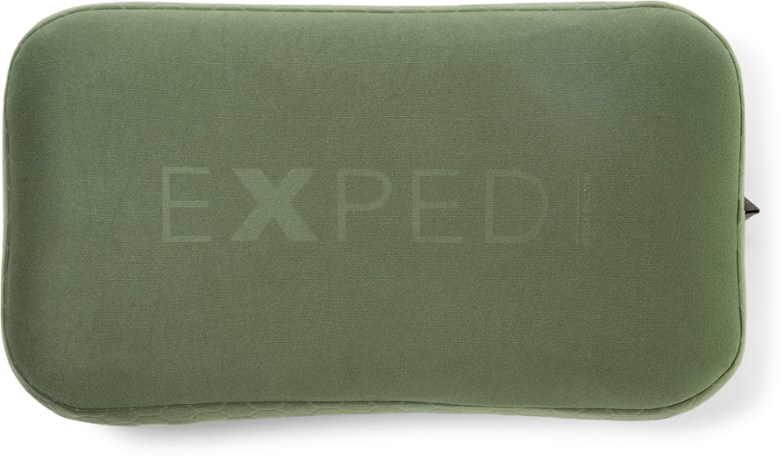
Exped’s MegaMat is legendary in the camping world, offering excellent cushioning and support that rival the comfort of your at-home mattress. Their MegaPillow sticks to a similar formula, combining high-end materials and Exped’s proven tech in a premium-feeling package. Like the MegaMat, the MegaPillow boasts near-vertical sidewalls designed to maximize the amount of surface area for your head. The tricot nylon exterior also has a velvety feel that’s noticeably soft against the skin and is backed with a layer of synthetic insulation for added coziness and comfort. Exped didn’t skimp on the smaller details, either, including fabric eyelets at the sides for attaching to a sleeping mat, a removable air cushion for easy cleaning, and a low-profile valve that doesn’t protrude and makes fine-tuning firmness quick and easy. Finally, at 20.9 inches wide and 12.6 inches long, the aptly named MegaPillow is one of the largest options here while checking in at a very manageable 6 ounces.
What pushed the Exped MegaPillow to a mid-pack finish? While comfort seekers will love the generous dimension, the rectangular shape doesn’t nestle easily into the hood of a mummy bag, which most backpackers (and some campers) prefer. If you anticipate using your pillow for both camping and backpacking adventures, Exped’s DeepSleep Pillow (6.3 oz.) and Down Pillow (5.3 oz.) are slightly smaller but have curved shapes that are more sleeping bag-friendly. At $55, the MegaPillow is also $10 pricier than similarly built competitors like the Therm-a-Rest Air Head below and Sea to Summit Aeros Premium above, and it’s heavier than both of those pillows, too. But there’s little to be desired from a comfort perspective, which lands the MegaPillow midway up our list. See the Exped MegaPillow
9. Cocoon Air-Core Hood/Camp Pillow ($30)
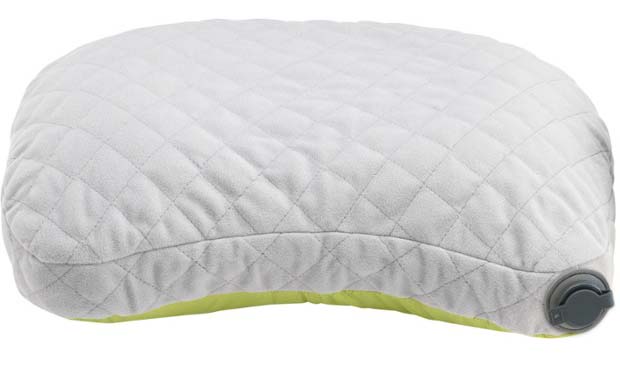
Cocoon may lack the name recognition of brands like Therm-a-Rest and Sea to Summit, but we’ve had positive experiences with their pillow collection thus far. Our favorite in their lineup is the Air-Core Hood/Camp Pillow, which is similar to designs like the Sea to Summit Aeros Premium and Nemo Fillo Elite Luxury above with an inflatable air bladder surrounded by synthetic fill for added support and comfort. Where the Cocoon sets itself apart is versatility: The pillow is double-sided with cozy polyester microfiber on one side for cold nights; in balmy weather, flip it over to reveal smooth nylon that feels cool and soft against the skin. We also found it easy to adjust the amount of air inside with a simple push of the valve at the bottom corner. Finally, the pillow’s curved shape pairs well inside a mummy bag, and the hidden zipper allows you to quickly remove the cover for cleaning (Cocoon recommends washing by hand).
In comparing the Cocoon Air-Core to other leading designs, the polyester microfiber side felt quite a bit softer and plusher than other UL designs we’ve tested, including Therm-a-Rest’s Air Head Lite (a lighter version of the standard Air Head below). That said, despite the competitive 3.8-ounce weight, the Cocoon’s 4.7 x 3.1-inch packed size is on the larger end in the UL category, and we found it a little tough to compress the pillow into its stuff sack. At 14.6 inches wide and 11 inches long, it’s also smaller than competitors like the Air Head Lite (15.5 x 11 in.) and Nemo's Fillo Elite Luxury (21 x 11 in.) above. But the Cocoon is the most versatile of the bunch with its double-sided design, and it’s also the cheapest at just $30. The rest of the brand’s lineup is equally well executed, including the roomier, rectangular Air-Core Ultralight and feathery, 2.7-ounce Air-Core Hyperlite . See the Cocoon Air-Core Hood/Camp Pillow
10. Teton Sports Camp Pillow ($20)
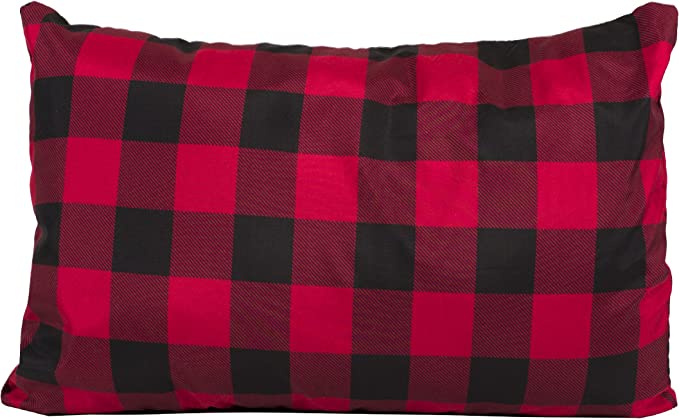
REI’s Trailmade Mummy Bag Pillow above is our favorite budget design this year, but Teton Sports’ Camp Pillow isn’t far behind. For around the same price as the Trailmade (colorways vary on Amazon), the Camp Pillow boasts a brushed flannel exterior that’s reminiscent of the brand’s plush sleeping bags. This is entirely subjective, but we also love the checkerboard-like patterning that gives off cozy cabin vibes and looks the part outdoors. Teton also included a handy drawstring-equipped storage bag for travel, and the pillow can be thrown directly in the wash with other clothing at the end of your trip. All told, it’s a no-frills but entirely practical option for most campers.
What do you sacrifice by saving with the Teton Sports Camp Pillow? As with most budget designs, the materials are on the cheaper end, which translates to added heft and bulk compared to more premium competitors like the Therm-a-Rest Compressible and Nemo Fillo above. Further, the synthetic fill doesn’t loft evenly when uncompressed, which can lead to air pockets and lumpiness. It also has a softer feel in general and lacks the firmness and support of many other picks here, plus there’s no cinch cord or valve to add air for additional structure. But if you prefer a soft pillow and want to keep costs low, the Teton Sports Camp Pillow is a solid value for what you get and comes in far more colorway options than the similarly priced Trailmade. See the Teton Sports Camping Pillow
11. Nemo Fillo Elite Luxury ($70)
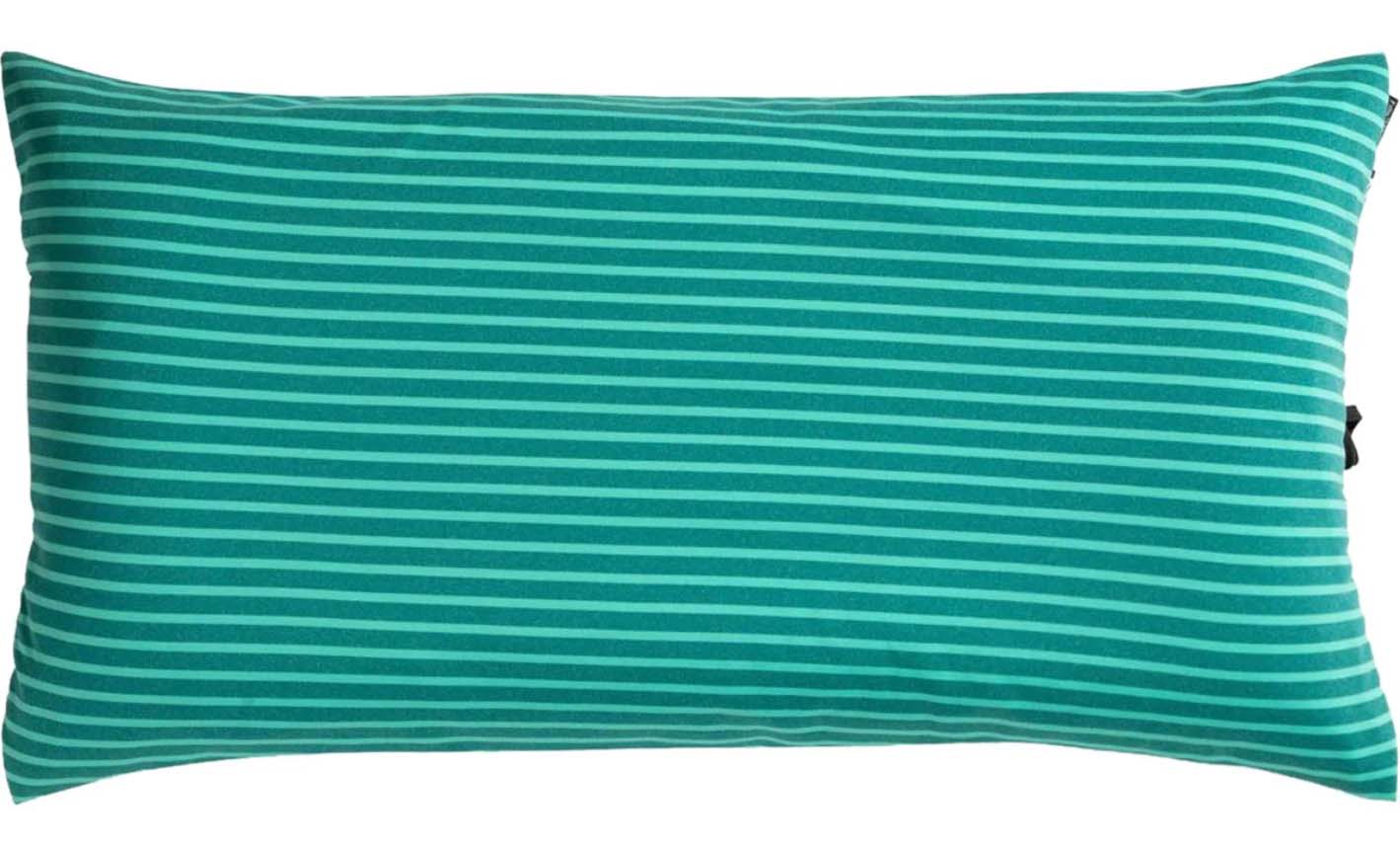
Nemo's Fillo above was quick to win us over on car camping trips, but some backpackers may find it too heavy and bulky to warrant packing on long backpacking missions. For this type of use, we turn to the Fillo Elite Luxury, which trades the standard model’s foam insulation for lighter and more compressible PrimaLoft synthetic fill. The result is a sizable drop in both weight and packed size, with the Fillo Elite Luxury checking in around 5 ounces lighter and compressing down to just 5 x 3 inches in its integrated stuff sack (compared to 6 x 4 in. for the standard Fillo). The rest of the build lines up similarly, including a soft and cozy cover that’s machine-washable, easy inflation and deflation via the ergonomic valve, and Nemo's baffled air cell tech that helps distribute the air evenly across the entire surface of the pillow. Taken together, the Fillo Elite Luxury is a nice upgrade over the standard Fillo for backpackers who want to keep things light without skimping on all-night comfort.
In addition to being lighter and more compressible than the Fillo above, the Nemo Fillo Elite Luxury is also wider by 4 inches, which has its pros and cons. On the plus side, the roomy rectangular shape will feel more like your pillow at home. However, similar to our complaint with the Exped MegaPillow above, it’s too large to fit inside the hood of most mummy bags. If this is a dealbreaker for you, Nemo also offers the standard Fillo Elite (no “Luxury”) and Fillo Elite Ultralight , both of which are narrower, lighter, and cheaper than the Luxury version. However, they’re also on the thinner end at 3 inches thick, and side sleepers will likely prefer additional padding (like what you get with Sea to Summit’s 4.3-in.-thick Aeros Premium above). But if the shape works for you, the Fillo Elite Luxury is impressively light and comfortable for its size. See the Nemo Fillo Elite Luxury
12. Therm-a-Rest Air Head ($53)
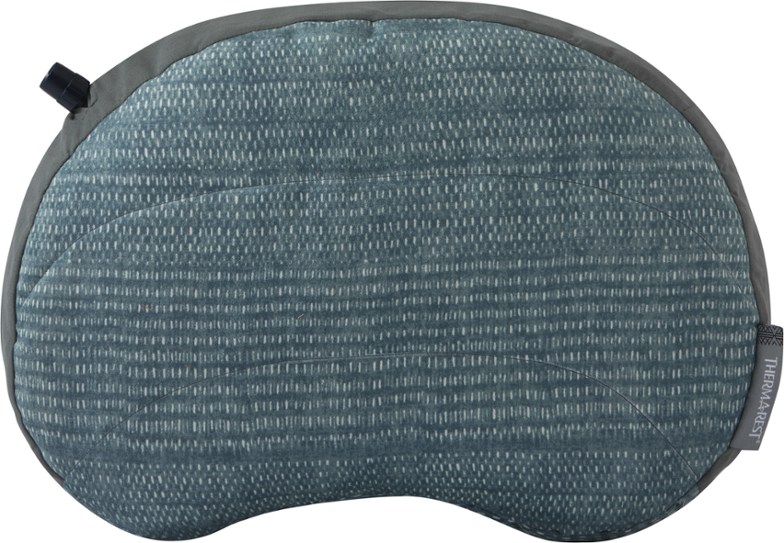
Therm-a-Rest’s Compressible Pillow above is our favorite overall camping design this year, but the all-foam build makes it a little too heavy to cross over for backpacking. Enter Therm-a-Rest’s own Air Head, which uses a mix of air and lightweight synthetic insulation under the top surface to shave weight and minimize bulk. For reference, at 5.6 ounces, the Air Head clocks in around half the weight of the Compressible and packs down noticeably smaller inside its stuff sack, which gives it the clear edge for backcountry adventures. We also like the nonslip fabric along the bottom, which does a great job keeping the pillow in place (unlike Sea to Summit’s Aeros models above, which are noticeably slippery underneath). Tack on a removable cover for easy cleaning and curved shape to nestle into the hood of your sleeping bag, and the result is a versatile design that works well for everything from multi-day backpacking missions to overnight camping trips and air travel.
Despite its well-rounded build, the Air Head does come with a few drawbacks. Our biggest complaints relate to the internal air bladder, which is on the thinner end and has been plagued by reports of punctures and premature leaks. The bladder’s plastic construction is also relatively crinkly and noisy, meaning finicky sleepers and those prone to moving around throughout the night should steer clear. Finally, the inflate/deflate valve is an old-fashioned design that sticks out the side of the pillow, which makes it less user-friendly when rolling up for storage. Of note: Therm-a-Rest does offer the 2-ounce Air Head Lite , which shares the same dimensions but forgoes the synthetic insulation to shave weight and bulk. And for a boost in comfort and support, you can upgrade to the 4.9-ounce Air Head Down , which is insulated with 650-fill duck down. See the Therm-a-Rest Air Head
13. Sea to Summit Aeros Down ($60)
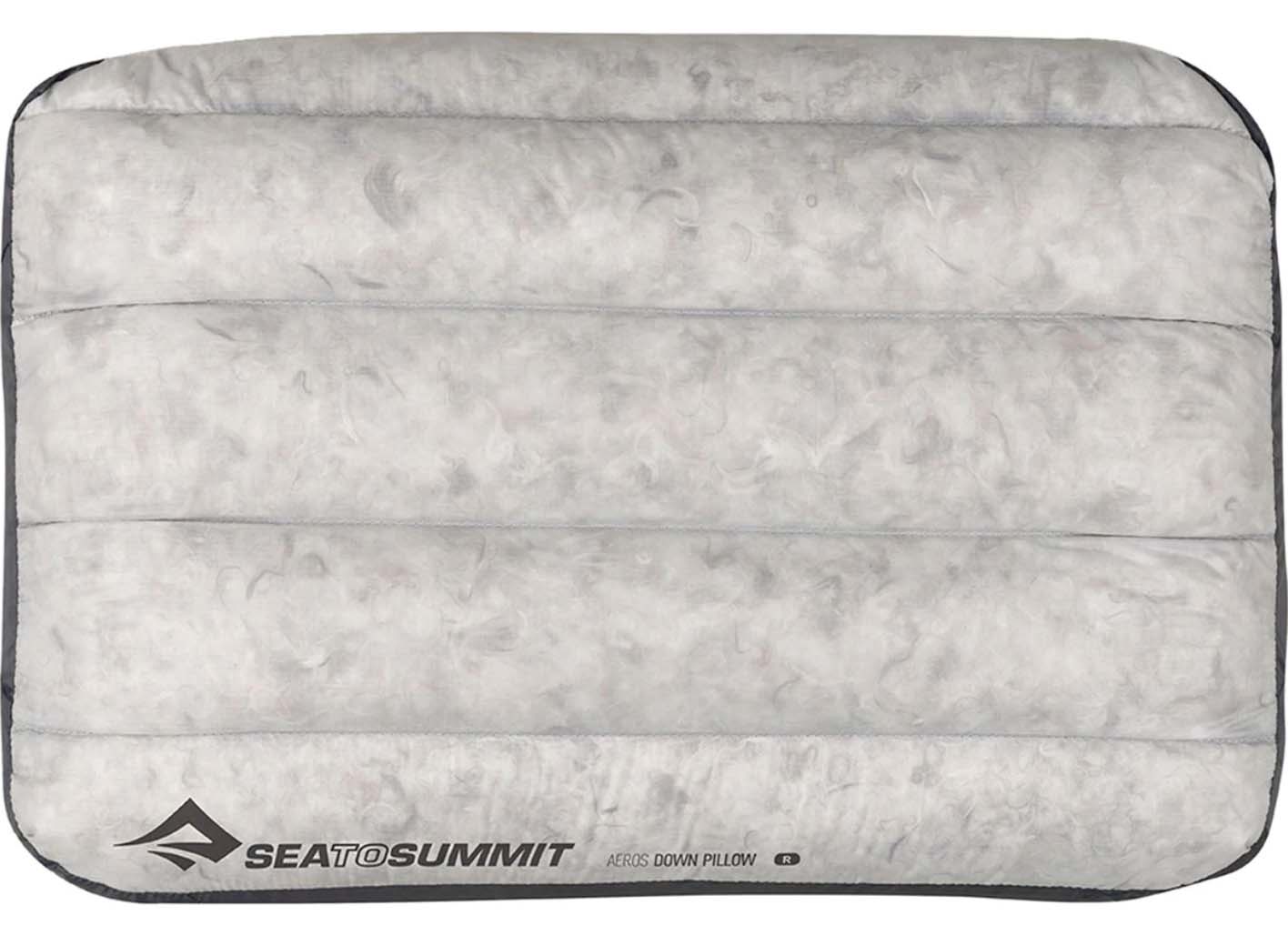
Joining the other two Sea to Summit models above is the Aeros Down, which splits the difference between the Aeros Ultralight (2.1 oz.) and Premium (2.8 oz.) above at 2.5 ounces. It’s also the only model in the collection—and on our list—to include down cushioning along the top, which adds a nice boost in overall comfort and warmth while keeping things light and packable (down is known for being very warm for the weight and highly compressible). Adding to its ultralight focus, Sea to Summit utilized fabrics from their Spark and Flame sleeping bag collections, which are noticeably thin but reasonably tear-resistant (provided you exercise caution). Rounding out the design is a supportive TPU air bladder, low-profile inflation/deflation valve, and compatibility with Sea to Summit’s PillowLock system to secure the pillow to any of their sleeping mats.
However, like most specialized UL designs, the Sea to Summit Aeros Down isn’t a great all-rounder. While decently durable for how thin it is, the 10-denier shell has a delicate feel and will need to be treated with care to avoid punctures. The fabrics are also relatively noisy, slippery, and lack the soft hand feel that you get with the other Aeros models, which use plusher stretch-knit polyester along the top (you could always throw on a lightweight pillowcase to boost coziness). Finally, the Aeros Down forgoes the curved internal baffles and scalloped bottom edge of the Aeros Ultralight and Premium, which we appreciate for keeping our head in place throughout the night. But the down cushioning certainly has its benefits, including a modest boost in overall comfort and warmth with minimal impact on weight and bulk. See the Sea to Summit Aeros Down
14. Rumpl Stuffable Pillowcase ($40)
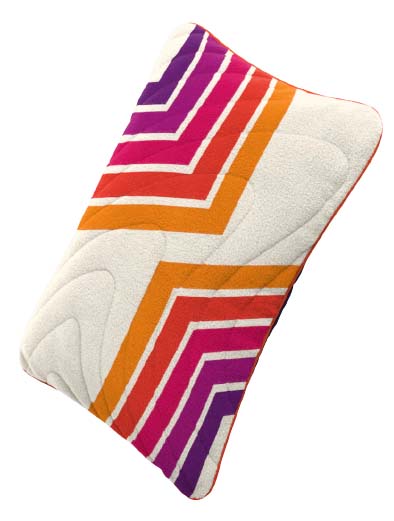
Rumpl is best known for their modern and vibrant outdoor blankets, but they’ve recently started to expand into the rest of the camping market. Their Stuffable Pillowcase is a logical addition to the lineup and competes with Zpacks’ Medium-Plus above as a lightweight stuff sack pillow for minimalist campers and backpackers. The Rumpl’s biggest advantage over the Zpacks is comfort: The double-sided design is considerably plusher and softer with thick polar fleece on one side and smooth ripstop polyester on the other. Like most of Rumpl’s offerings, the Stuffable Pillowcase is also sold in a nice selection of fun colors and patterns (compared to the Zpacks’ single bland colorway) and sustainably built with recycled fleece and a shell made from recycled plastic bottles. And at $40, the Rumpl is a considerable $15 cheaper than the Zpacks, giving it the clear edge in value, too.
That said, apart from the benefits in comfort, price, and sustainability, the Rumpl Stuffable Pillowcase falls short of the Zpacks Medium-Plus in most other areas: It’s heavier by 1.5 ounces, doesn’t pack down as well for storing in a pack, and is smaller at 11 x 16 inches compared to the 11.25 x 20-inch Zpacks. The Medium-Plus’ Dyneema build also allows it to double as a dry bag to protect your clothing on the trail, while the Rumpl’s standard DWR finish will wet out quickly in sustained moisture. In other words, the Zpacks Medium-Plus is the more specialized but versatile pick for ultralight backpacking, while the Rumpl Stuffable Pillowcase offers better comfort for car camping, road trips, and travel. See the Rumpl Stuffable Pillowcase
15. Wise Owl Outfitters Camp & Travel Memory Foam Pillow ($25)
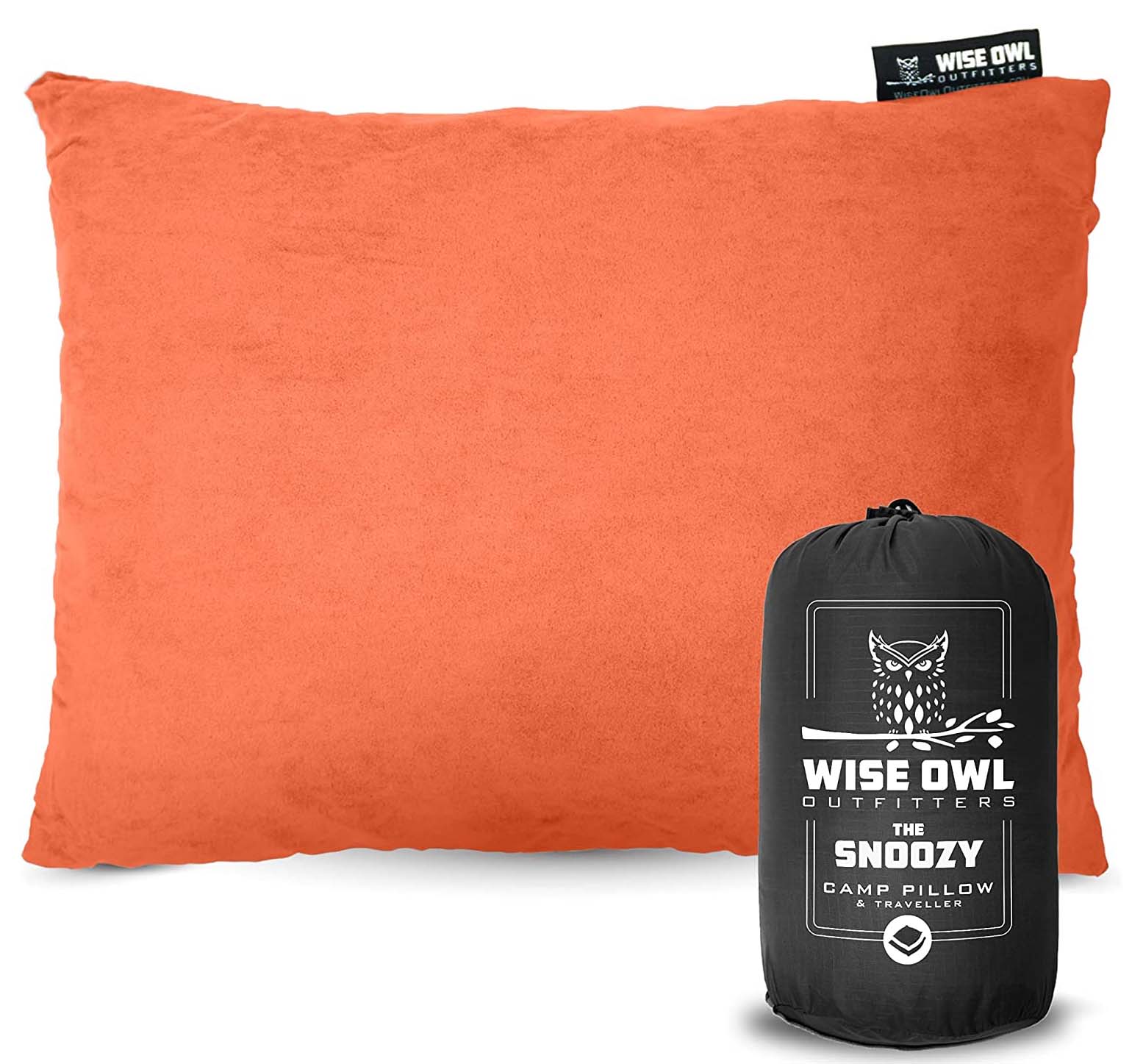
Hest's Camp Pillow above is our favorite memory foam design for campers who prioritize comfort above all else, but it’s no small investment at $89. Enter Wise Owl Outfitters’ Camp & Travel Memory Foam Pillow, which retails for less than 1/3 the price of the Hest (it’s often less on Amazon) but stacks up well in terms of all-night comfort and support. The memory foam is wrapped in a soft micro-suede cover, which feels very smooth and cozy against the skin, and it’s sold in a nice selection of bright colorways that give it the edge in styling, too. Finally, at just 11 ounces for the medium size (9 oz. for the small), the Wise Owl pillow is well over a pound lighter than the Hest and packs down noticeably smaller for stuffing in a pack or duffel during travel.
What pushes the Wise Owl Camp & Travel Pillow toward the bottom of our list? At 14 x 18 inches, it’s significantly smaller than the 22 x 15-inch Hest Camp Pillow. Side sleepers may also find it too thin at just 4 inches thick compared to the Hest's generous 8-inch-thick build. Again, the Wise Owl gets the clear edge for travel due to its better packability, but it’s still too heavy and bulky to bring along on backpacking trips. This tweener status puts the Wise Owl pillow in a bit of an awkward spot in our eyes. But we keep coming back to value: The Wise Owl gets you memory foam comfort at a true cut-rate price. See the Wise Owl Camp & Travel Memory Foam Pillow
16. Klymit Pillow X ($27)
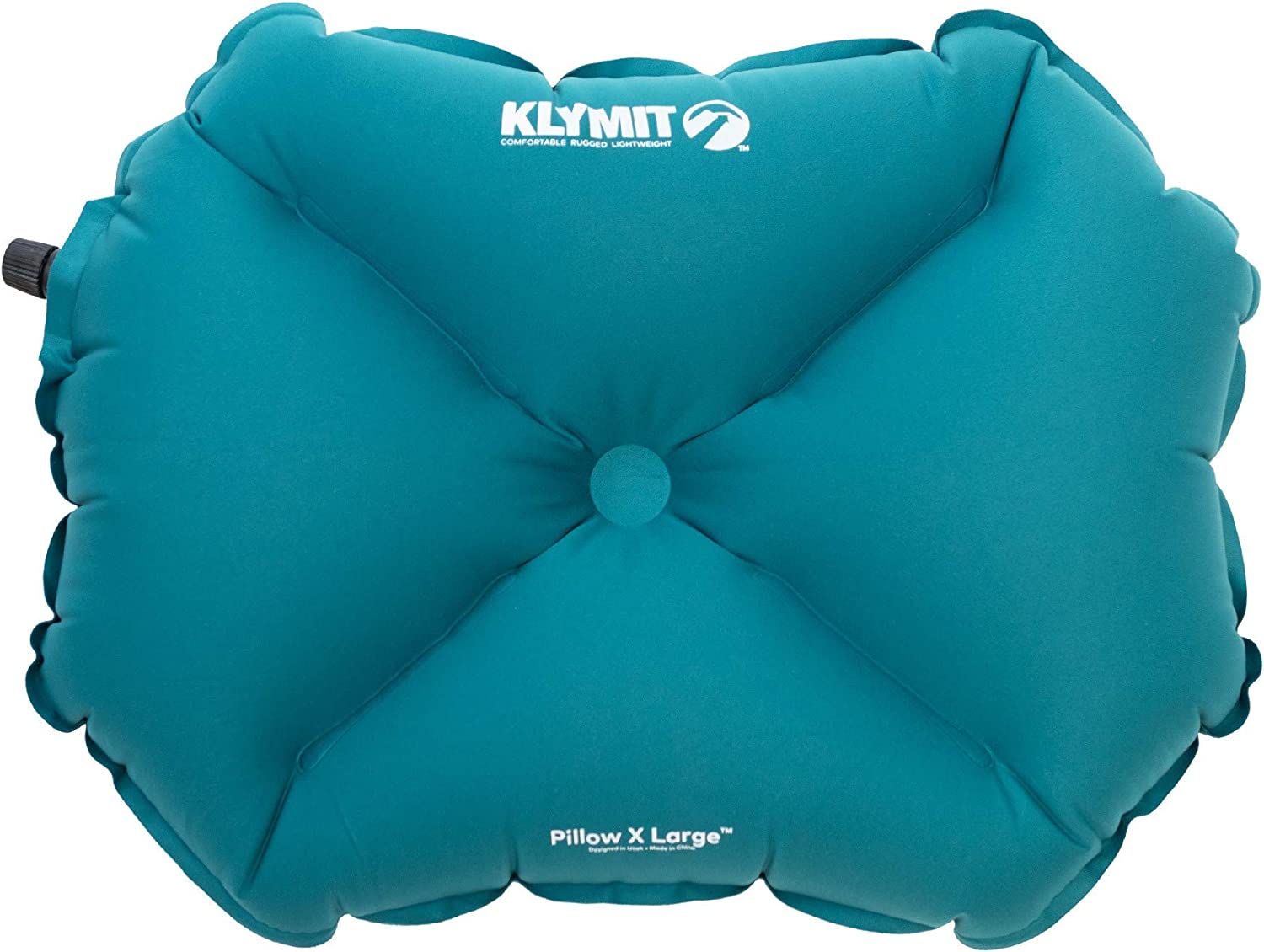
A final camping pillow to have on your radar is Klymit’s aptly named Pillow X. Right away, it’s clear that Klymit went a little off-script with the design: In place of a smooth top, Klymit opted for a unique X shape that’s intended to keep your head centered throughout the night. The rest of the build is highly competitive with other leading backpacking designs, including a feathery 2.5-ounce weight, excellent packability (the pillow measures just 4.5 x 2.5 x 1 in. when compressed in its stuff sack), and a 30D polyester shell that's moderately tough (most UL competitors are 20D or thinner). Finally, at around $25-$28 on Amazon at the time of publishing (depending on the colorway), the Klymit Pillow X will save you a little cash over most of the options above.
All that said, the Klymit Pillow X's distinct shape is a love-it or hate-it feature. Additionally, the standard polyester shell lacks the plush padding and softness of most other designs here, and it’s pretty noisy and slippery, too. You can remedy these issues by bringing along a pillowcase or stuffing the pillow inside a jacket at night, but that will negate some of the pillow’s self-centering tech. In the end, the Pillow X has its place, but the lack of comfort is hard to overlook. For around $10-$20 more, most folks will be better off with a more traditional and softer design like the Sea to Summit Aeros Ultralight or Cocoon's Air-Core above. Alternatively, Klymit’s own Luxe Pillow features a plush, quilted cover and more traditional rectangular shape for $50 (it’s less on Amazon currently). See the Klymit Pillow X
Camping and Backpacking Pillow Comparison Table
Camping and backpacking pillow buying advice.
- Best Uses: Camping And/or Backpacking
- Stuff Sack Pillows
Pillow Comfort and Thickness
Pillow dimensions: length and width, weight and packability, pillow shape and sleeping bag compatibility, durability (denier), weather resistance, inflation and deflation valves.
- Other Features
Washing and Care
Using your camping pillow for travel, do you need a camping/backpacking pillow, best uses: camping and/or backpacking.
The first question to answer when choosing the right pillow for you is how and where you plan to use it most. For car camping, we prioritize comfort above all else and look for soft-touch fabrics, thick and supportive padding, and generous dimensions to maximize the amount of surface area for our head. On gear-intensive backpacking missions, we’re willing to compromise a little on all-out comfort to keep weight and bulk to a minimum and instead turn to light and compressible inflatable designs that stash easily into the crevices of our pack. There are many factors at play here, including shell thickness (which we cover in the “ Durability ” section below), construction type (e.g., inflatable vs. memory foam designs), and overall size and dimensions. The good news is that many of the options above cross over decently well for both disciplines, including well-rounded options like the Nemo Fillo Pillow and Therm-a-Rest Air Head.
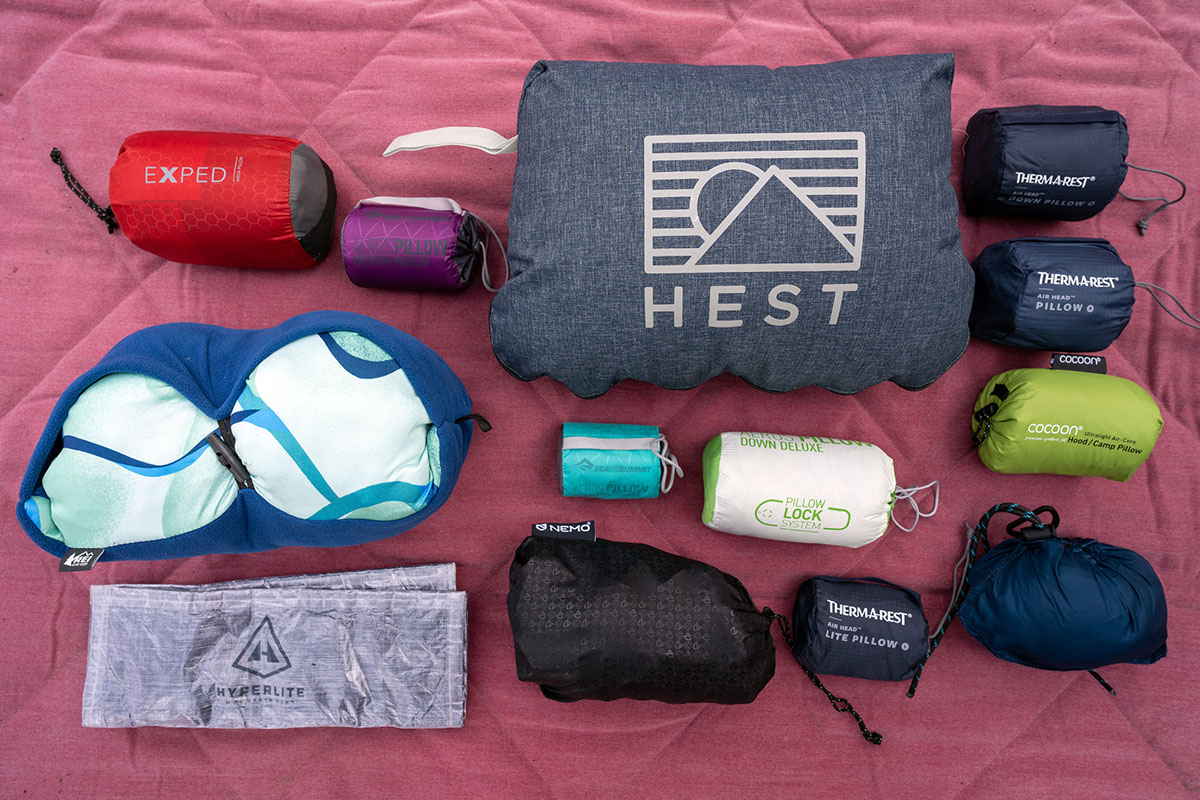
Pillow Types: Construction and Insulation
Pillow construction varies widely, from ultralight and packable inflatable designs like the Sea to Summit Aeros Ultralight to premium memory foam options with plush cushioning for ultimate camping comfort. As we cover in “ Weight and Packability ” below, inflatable options are typically the lightest and most compressible due to the fact that the interior is exclusively filled with air. Some inflatables, like the Sea to Summit Aeros Premium and Aeros Down, also add a light layer of synthetic or down insulation under the cover for a small boost in comfort and warmth (along with a slight weight penalty).
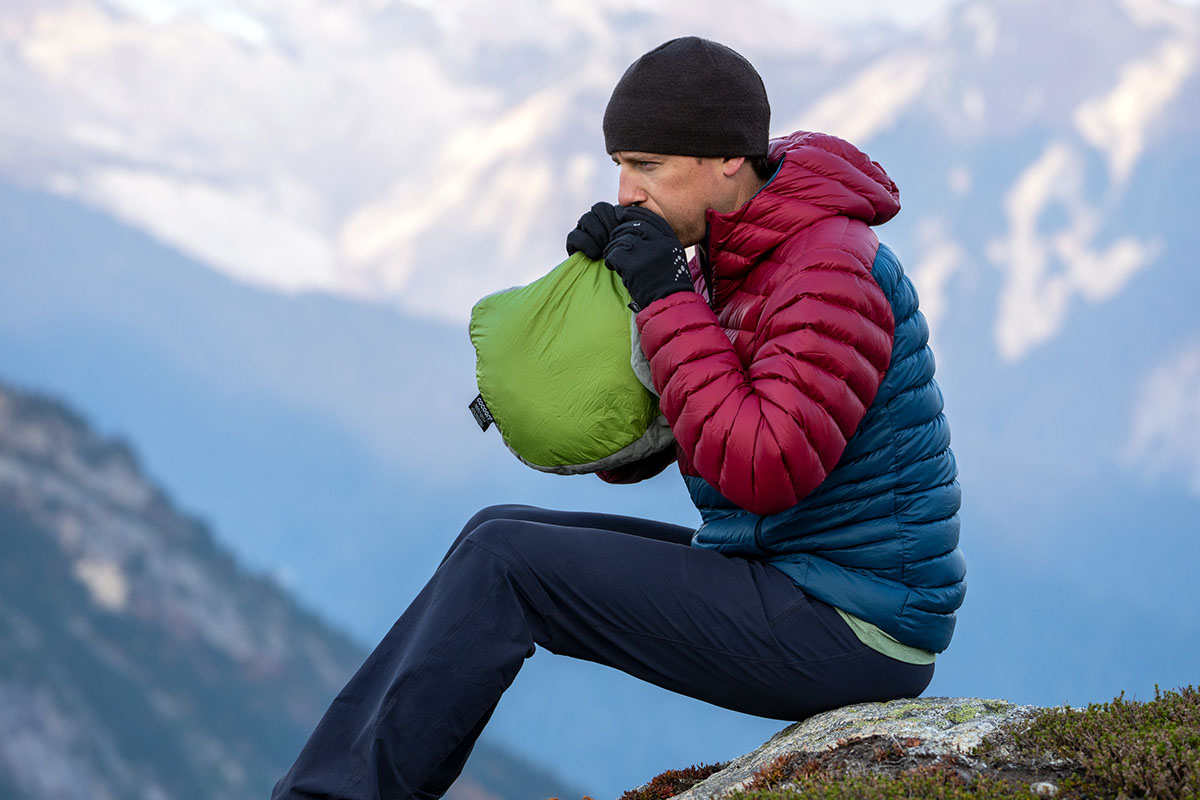
At the other end of the spectrum are non-inflatable models like the Therm-a-Rest Compressible Pillow , Hest Camp Pillow, REI Trailmade Mummy Bag Pillow, and Wise Owl Outfitters Camp & Travel Memory Foam Pillow. These designs utilize foam or memory foam constructions with no air, which adds weight and bulk but comes with sizable benefits in all-around comfort and cushioning. They’re also more resistant to punctures, and you’ll still have some semblance of padding if your pillow deflates in the middle of the night. In the end, we love the premium comfort of non-inflatable foam pillows for car camping but turn to inflatable designs when we’re headed into the backcountry and want to minimize weight and bulk. Again, a final decision will come down to your sleeping preferences and intended use(s).
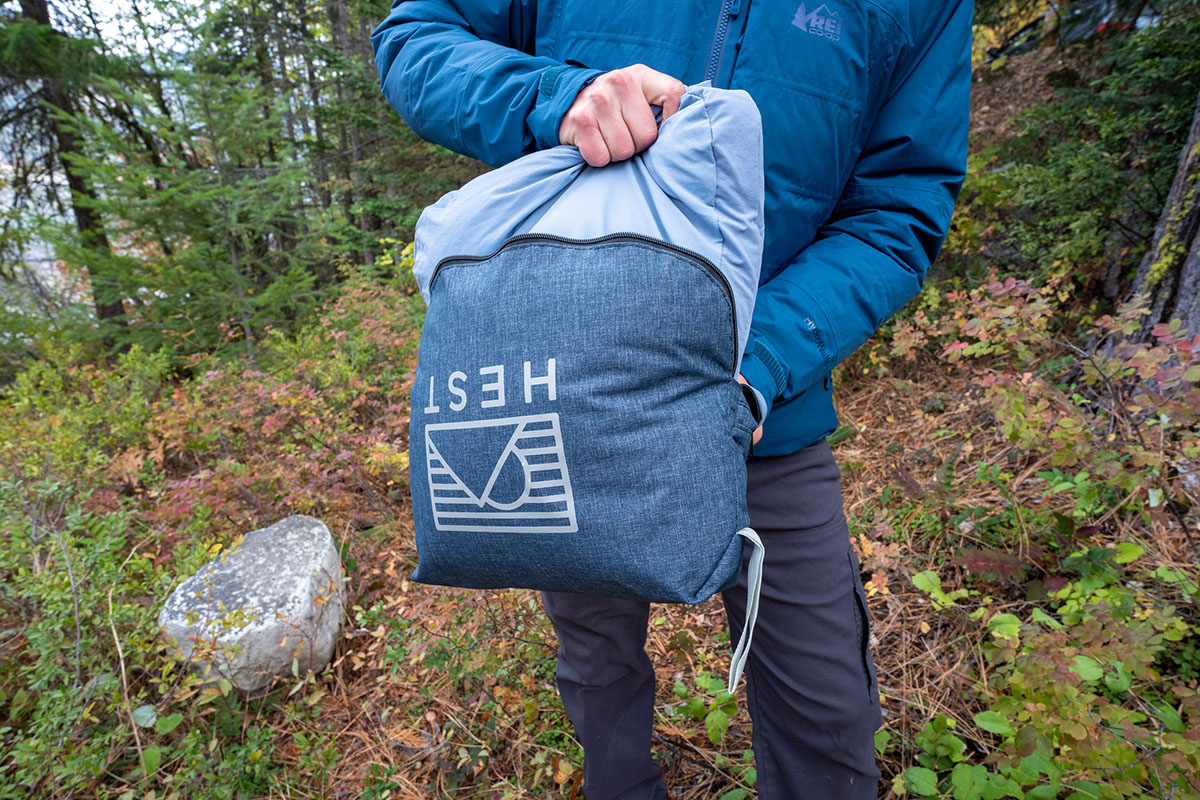
Stuff Sack Pillows Stuff sack pillows are a bit of a misnomer: Essentially specialized and outdoor-ready pillowcases, these designs require stuffing clothing inside for use as a pillow. In addition to being very light and packable, stuff sack pillows like the Zpacks Medium-Plus and Rumpl Stuffable Pillowcase are also highly versatile, providing a space to stash clothing or other gear during the day. The Zpacks can also double as a dry bag to protect your clothes from moisture thanks to its highly water-resistant Dyneema build.
Convenience is the biggest drawback: It takes some effort and patience to achieve an even and consistent (read: lump-free) packing job—rather than just inflating your pillow, you’ll need to take time to intentionally stuff clothing inside until you reach your desired firmness. Comfort is also largely dependent on what you stuff inside (lofty down or synthetic jackets work well). In the end, stuff sack pillows aren’t for everyone, but they’re a great UL pick for minimalists and those who don’t mind putting in some extra work before hitting the hay.
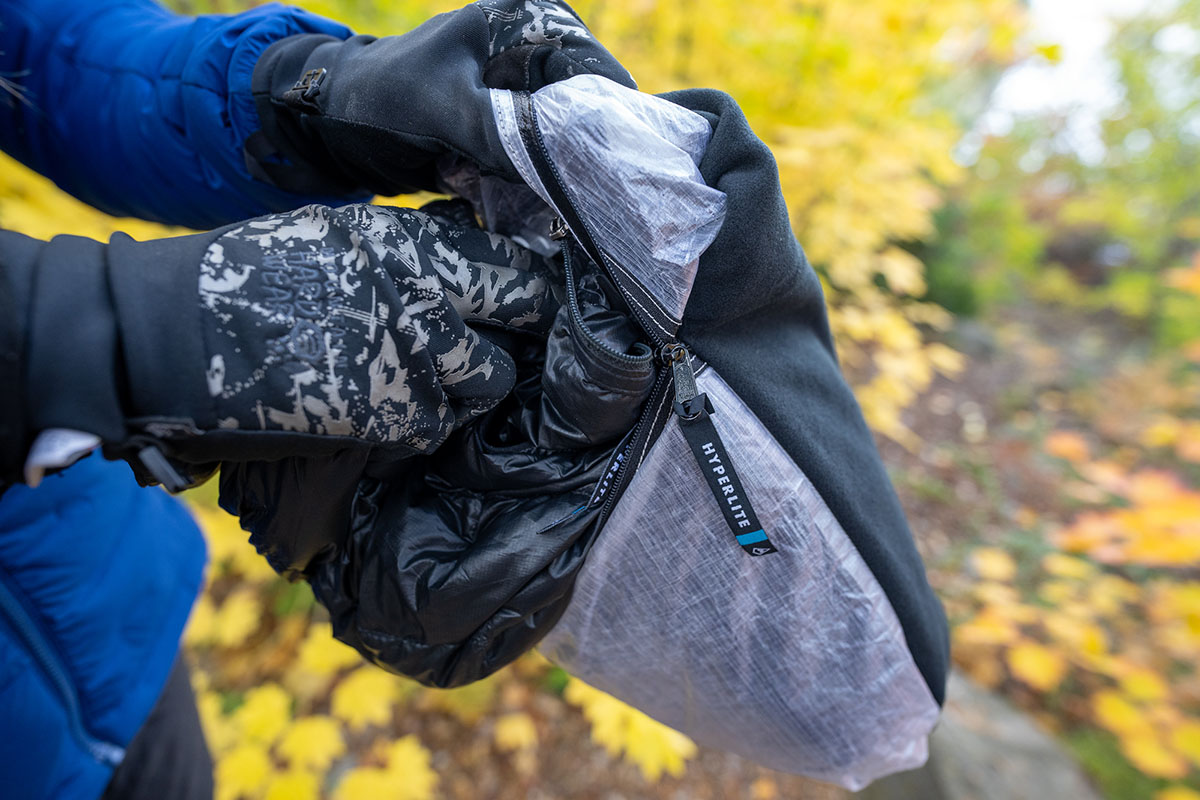
Comfort is relative when sleeping on the ground, and most people who can’t handle a night under the stars don’t camp or backpack at all. That said, there’s still a wide gap between ultralight, backpacking-ready designs and car camping pillows, with the latter typically offering thicker, softer cushioning for better all-night comfort (for more weight and bulk). For instance, Therm-a-Rest’s Compressible Pillow (which is designed for camping) is 6 inches thick, and the all-foam construction offers far better support than most inflatable designs. At the other end of the spectrum is Nemo's Fillo Elite Luxury (best for backpacking), which is around 6 ounces lighter than the Therm-a-Rest but just half the thickness (3 in.). Most designs fall somewhere in the middle at around 4-5 inches thick and hit a nice sweet spot between weight and comfort.
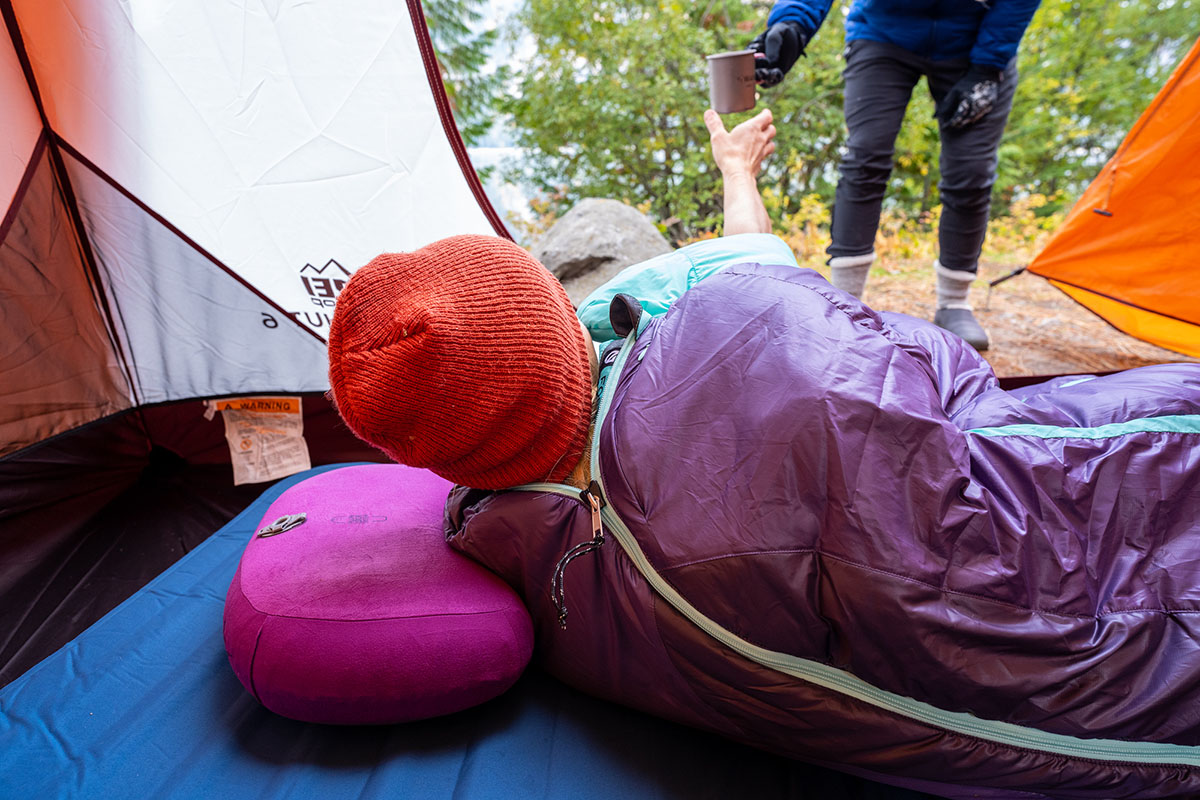
You may notice some chatter in product comments about being a back sleeper or a side sleeper. While this typically has more of an impact when selecting a sleeping pad, it can still be helpful to factor in when choosing a pillow. Height is the most important consideration: You’ll want to make sure your head is in line with your neck and spine, meaning side sleepers will likely want to upgrade to a thicker and firmer design (like the 8-in.-thick Hest Camp Pillow or 6-in.-thick Therm-a-Rest Compressible Pillow) to achieve proper alignment. Back sleepers can typically get away with less padding, but this is largely a matter of personal preference. Shape can also play a role: UL models like the Sea to Summit Aeros Ultralight are molded around the head and neck in a way that works best for us when lying on our backs (again, this can vary from person to person).
Along with thickness, a pillow’s length and width can also have a considerable impact on all-around comfort. At the larger end are camping-focused rectangular designs like the Therm-a-Rest Compressible Pillow (18 x 13 in.), Hest Camp Pillow (22 x 15 in.) and Exped MegaPillow (20.9 x 12.6 in.), which have generous dimensions and plenty of surface area to move around throughout the night without your head falling off the pillow. On the flip side are dedicated backpacking-ready models like the Sea to Summit Aeros Premium (13.4 x 9.4 in.) and Cocoon Air-Head Hood/Camp Pillow (14.6 x 11 in.) that shave off excess material to keep weight and bulk to a minimum. As we cover below, many backpacking pillows also have curved shapes that fit nicely into the hood of a sleeping bag, which is another factor to consider if you plan to spend a lot of time in the backcountry.
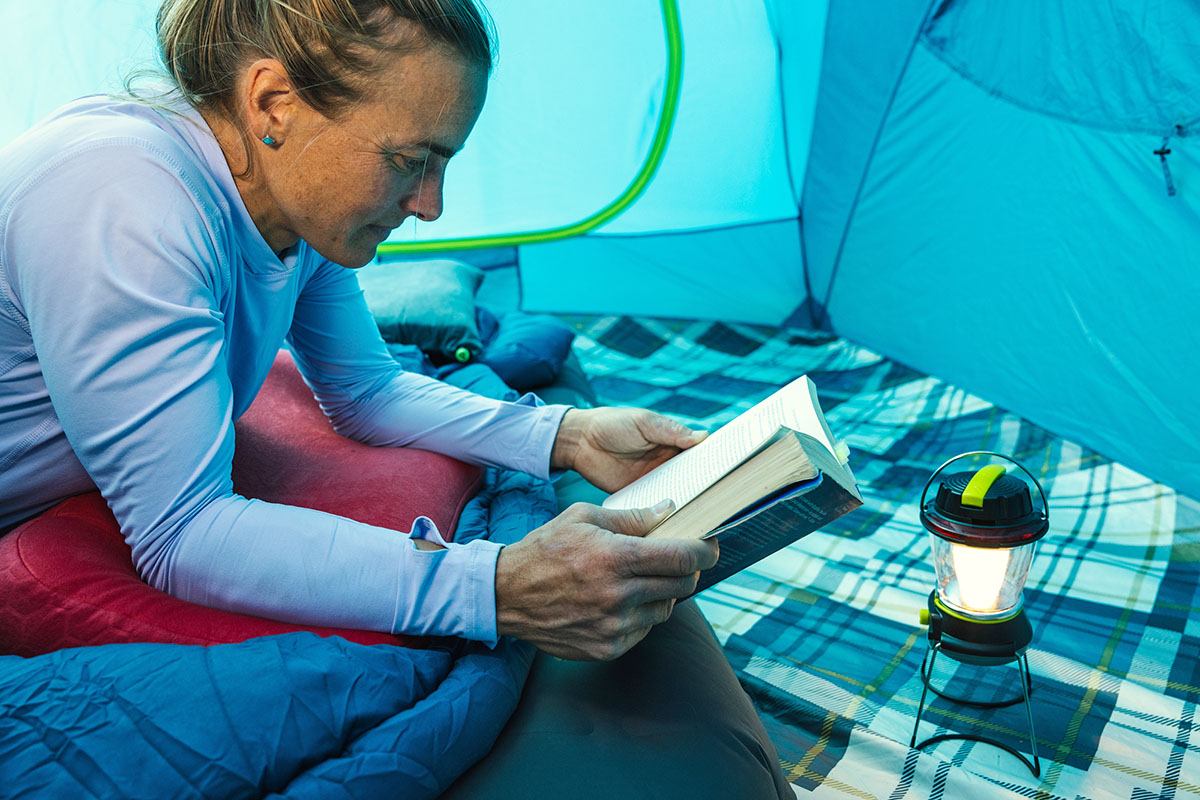
Given their small size, pillows are inherently a pretty lightweight bunch. That said, there’s a decent spread between car camping and backpacking designs, which makes sense considering that backpackers generally want to keep weight as low as possible when hauling gear on their back for miles. For comparison, the lightest option on our list is Zpacks’ Medium-Plus stuff sack pillow at a scant 1.7 ounces, followed by inflatable designs like the Sea to Summit Aeros Ultralight (2.1 oz.) and Aeros Down (2.5 oz.). At the other end of the spectrum are plush memory foam models like Hest's Camp Pillow (2 lb. 3.2 oz.) and Wise Owl Outfitters’ Camp & Travel Pillow (11 oz.). Most options fall somewhere in the middle, with the majority of the pack hovering in the 3- to 10-ounce range. Backpackers will likely want to stick toward the lighter end to minimize the amount of weight on their backs, while car campers can get away with more heft and bulk since they won’t be traveling too far from the trailhead.
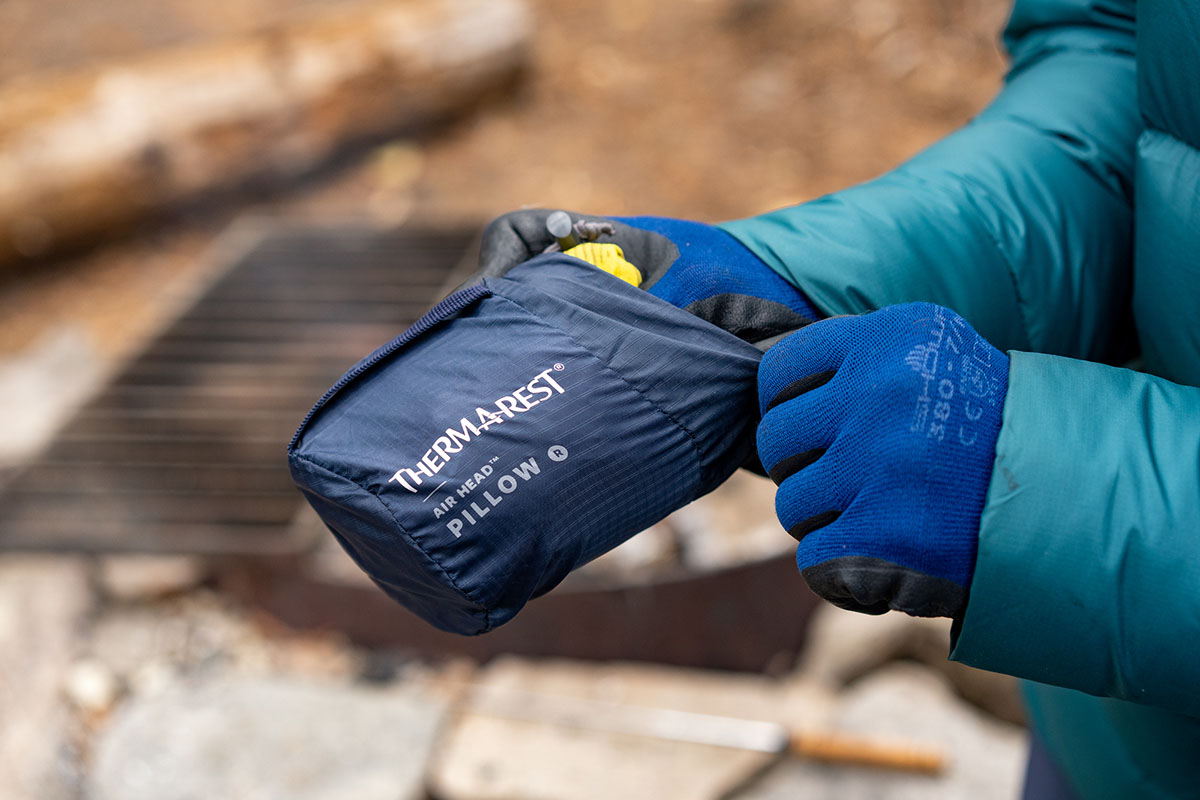
Packed size generally correlates closely with weight and is a function of the pillow type, amount of insulation, and fabric thickness. Uninsulated or lightly insulated inflatable pillows are far and away the most compact, while memory foam pillows like the Hest Camp Pillow add considerable weight and bulk —for comparison, the Hest measures 14 x 9 inches when compressed versus the Sea to Summit Aeros Ultralight at just 2 x 2.8 inches. As we mentioned above, backpackers covering long distances typically prefer lighter and more packable options that disappear into a pack, while car campers who aren’t limited on space are often willing to trade some weight and bulk for added comfort and support. And a final note: Most pillows come with separate stuff sacks that can be misplaced, while integrated designs like the Nemo Fillo and Hest Camp Pillow are less common but nice for absent-minded campers.
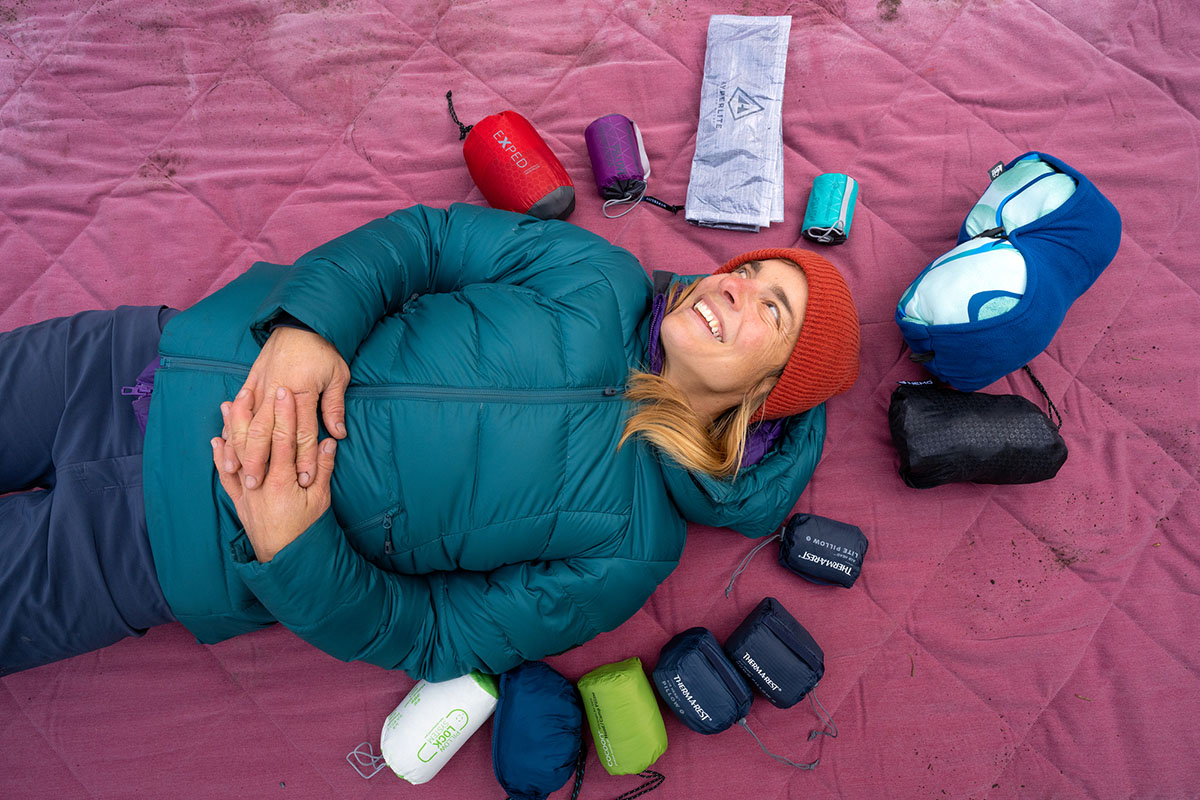
There aren’t too many variations in pillow shape, and a decision will largely come down to how and where you plan to use your pillow most. Rectangular designs like the Therm-a-Rest Compressible , Exped MegaPillow, Hest Camp Pillow, and Nemo Fillo Elite Luxury will feel most similar to your pillow at home, with generous dimensions that maximize the amount of surface area for your head. The biggest drawback is sleeping bag compatibility: Rectangular pillows don’t fit easily into the hood of most sleeping bags, which can lead to sliding around throughout the night.
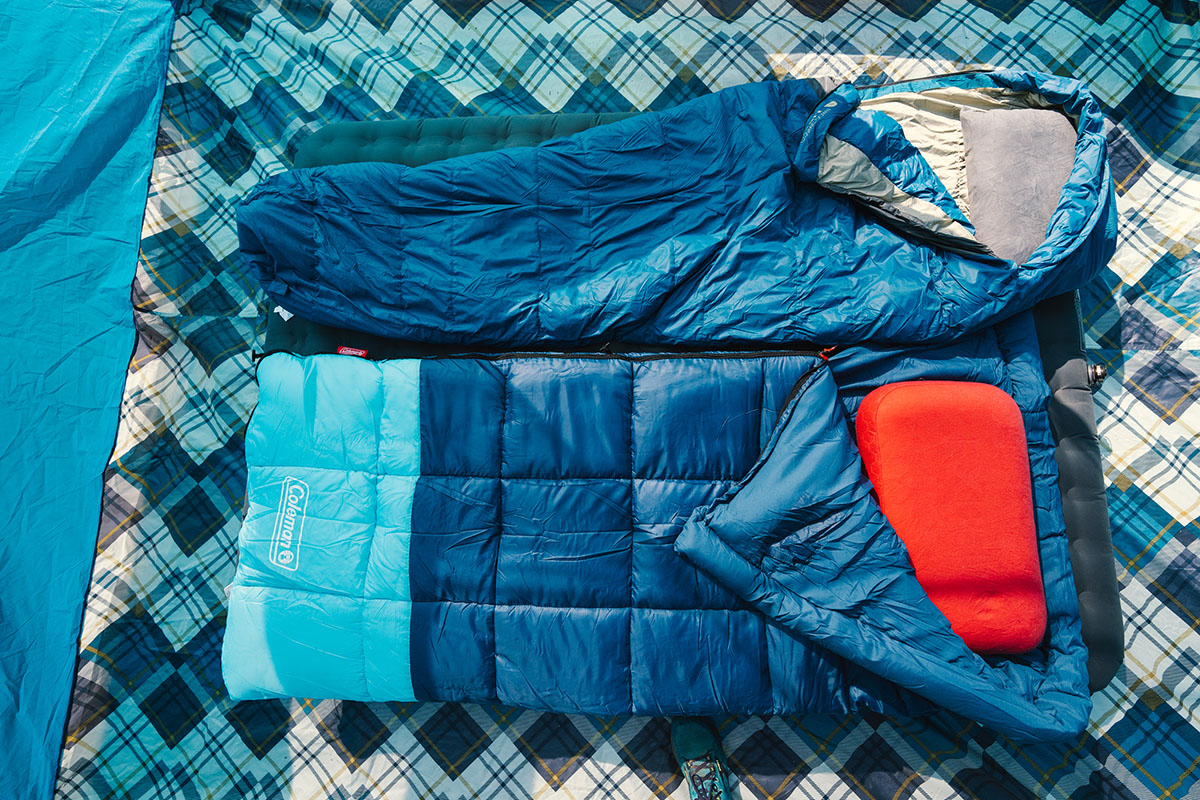
If you plan to pair your pillow inside a sleeping bag , we recommend opting for one with a curved shape (like what you get with the Sea to Summit Aeros Ultralight and Premium, Therm-a-Rest Air Head, Cocoon Air-Core Hood/Camp Pillow , and others above). While typically smaller, curved pillows are our preferred option for backpacking due to their sleeping bag-friendly shape, and the lack of material along the bottom helps keep weight and bulk to a minimum. One exception is REI's Trailmade Mummy Bag Pillow, which has a trapezoidal shape but is small enough that it fits nicely inside a mummy bag hood (hence its name). Many campers use rectangular sleeping bags that forgo a hood, in which case a larger rectangular model could be the better bet.
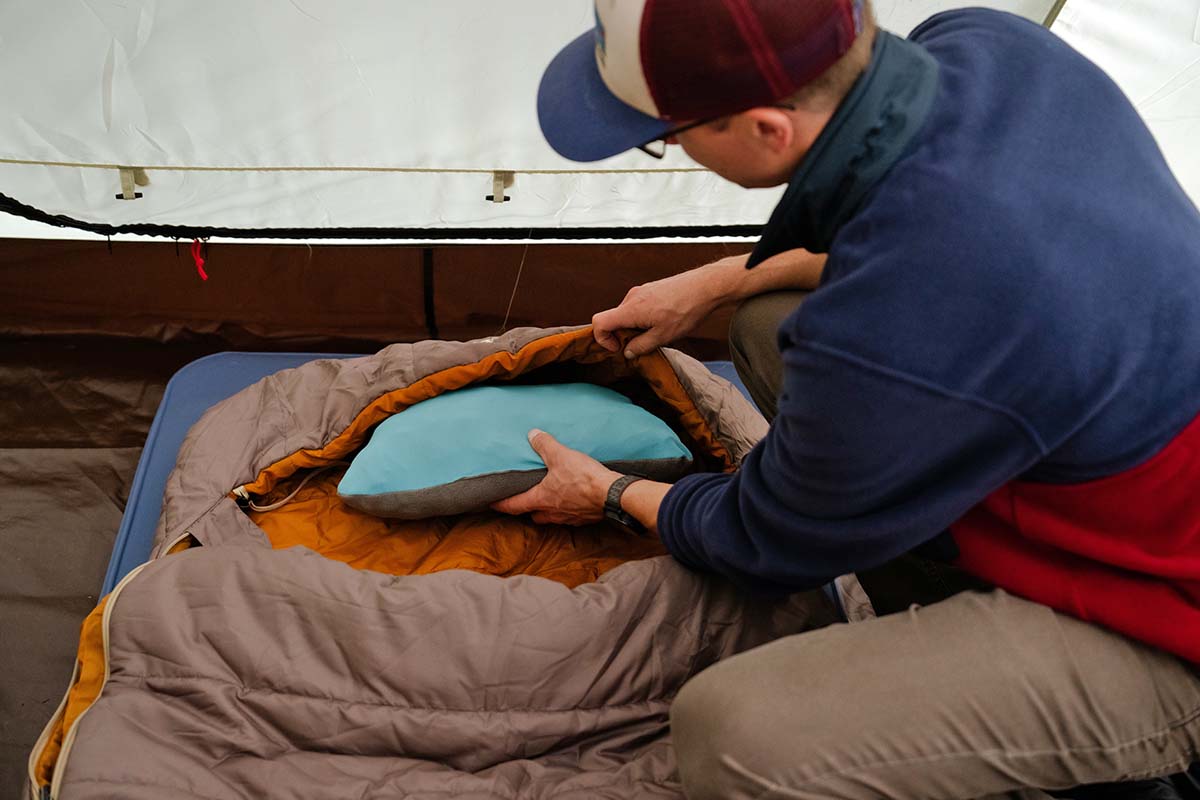
The most common measure of durability in the outdoor gear world is denier (D), which measures the thickness of a fabric. In general, lower-denier fabrics have a much shorter lifespan, a higher propensity for durability issues in the backcountry, and are typically reserved for ounce-counting backpackers who know how to take care of their gear. For example, Sea to Summit’s Aeros Down has a delicate 10D shell that’s practically see-through, while their Aeros Premium’s 50D shell is noticeably thicker and more confidence-inspiring. Most designs fall somewhere in the middle, with 20D being fairly standard in the pillow market.
It's important to note that ultralight inflatable pillows will need to be treated with the most care, as a puncture can quickly render the pillow useless (we recommend bringing along the patch kit that comes with most inflatable pillows for repairs in the field). Alternatively, all-foam pillows are the safest bet, and those that use a mix of foam and air will still offer some padding if your pillow deflates in the middle of the night.
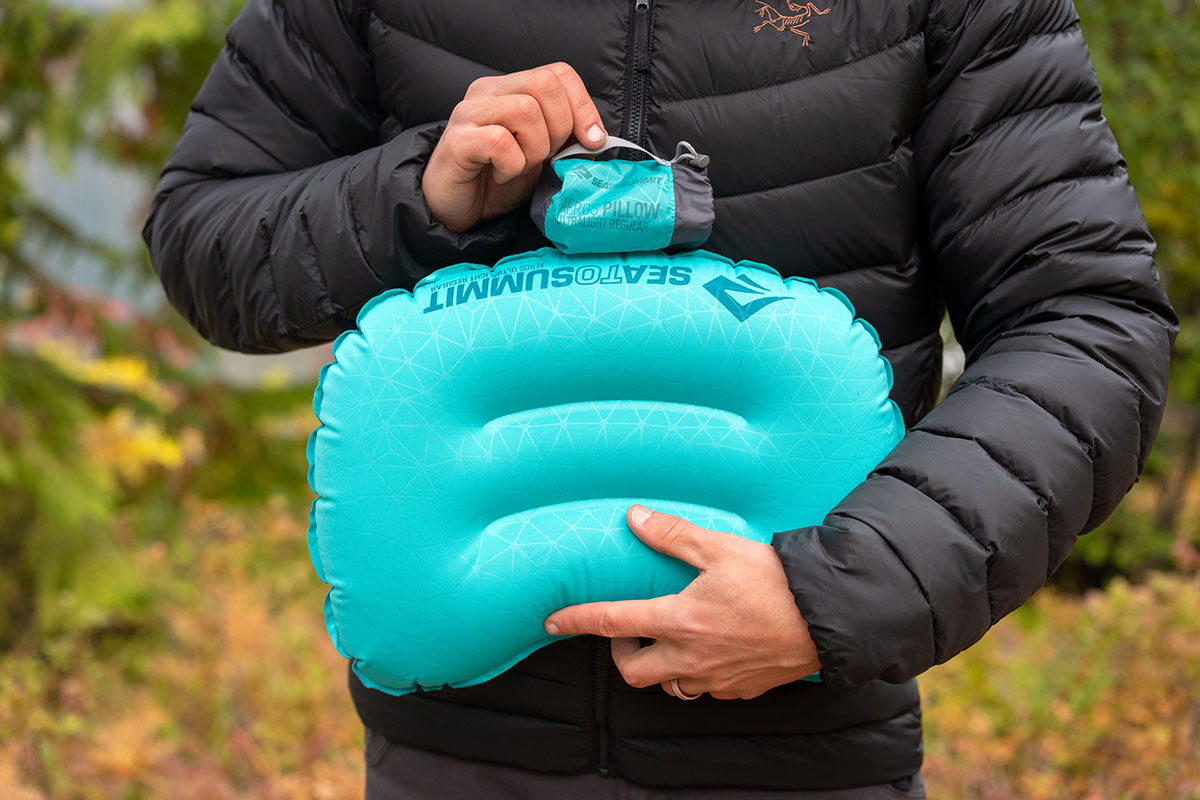
Most campers and backpackers won’t be using their pillow outside of their tent, but a little added moisture resistance can be beneficial when sitting outside by the fire or cowboy camping under the stars. Most of the designs above have a standard durable water repellent (DWR) coating that will allow light moisture to bead up and roll off the surface rather than soaking through the outer shell. Hest's Camp Pillow takes things a step further with a polyurethane (PU) coating along the nylon cover, which sheds both water and dirt. Finally, Zpacks’ Medium-Plus stuff sack pillow is the most weather-ready option here with a highly water-resistant Dyneema build, taped seams, and a waterproof zipper that allow it to double as a dry bag to protect your clothing and gear on the trail. In the end, weather resistance won’t be a critical consideration for most, but it certainly has its benefits.
All of the inflatable pillows above boast valves to add or remove excess air, which makes inflation and deflation easy and allows you to quickly tailor firmness depending on your sleeping preferences. That said, not all valves are created equal, and the difference in ease of use can be quite significant. The most basic is the traditional twist valve (as seen in Therm-a-Rest’s Air Head and Nemo's Fillo and Fillo Elite Luxury), which opens and closes by pushing or pulling a round plastic valve connected to the side of the pillow. These work pretty well in general, but there are downsides to be aware of. For one, the valve works inefficiently because it’s completely open while inflating, which allows some air to escape in between breaths. Further, their upright profile takes up space when rolled up (and pokes out while you’re sleeping), and they are slow to deflate.
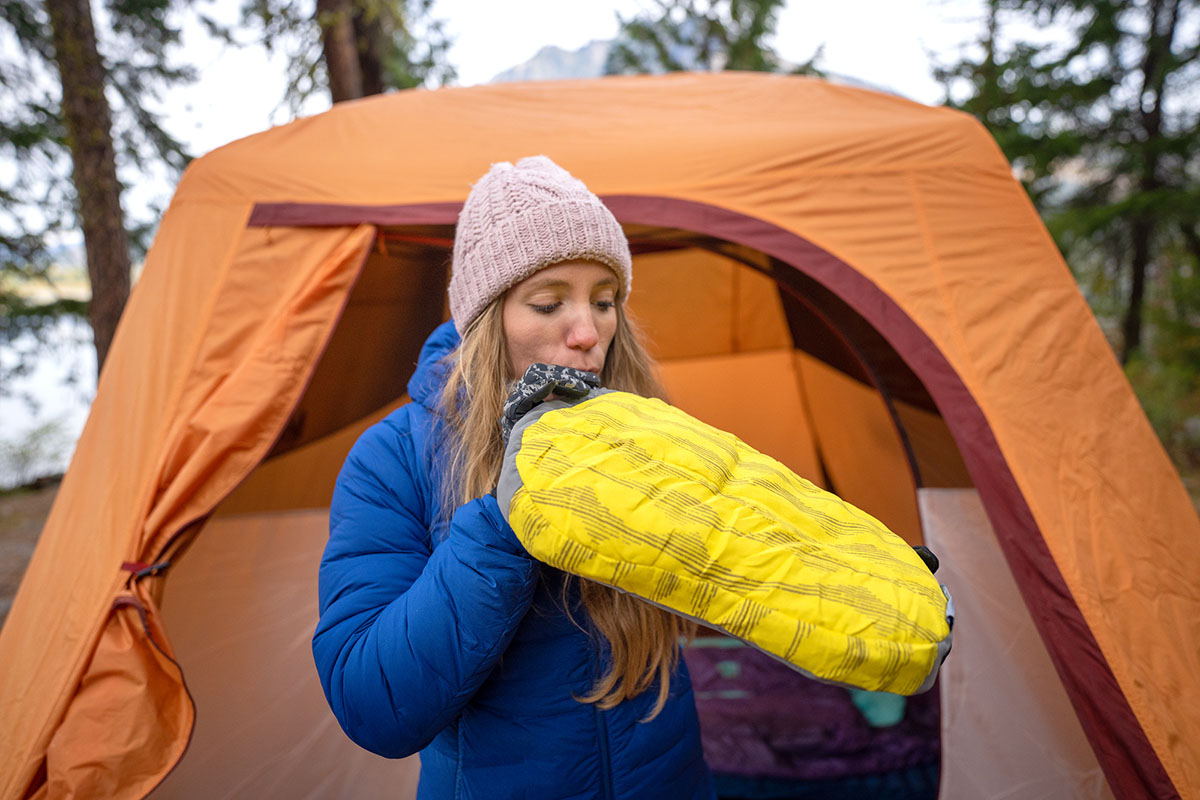
To address these issues, a number of manufacturers have turned to flat valves. Beyond the slim profile, they often have dedicated openings for inflating and deflating and, importantly, a flap that keeps air from escaping while blowing into the opening. Some of our favorite designs with intuitive and quality low-profile valves include the Exped MegaPillow , Cocoon Air-Head Hood/Camp Pillow, and Sea to Summit’s Aeros collection, including the Aeros Ultralight, Premium, and Down models. Overall, we’ve found these designs are reliable, efficient (it takes just a few breaths to inflate, and deflation is almost instantaneous), and add essentially no weight—all excellent characteristics.
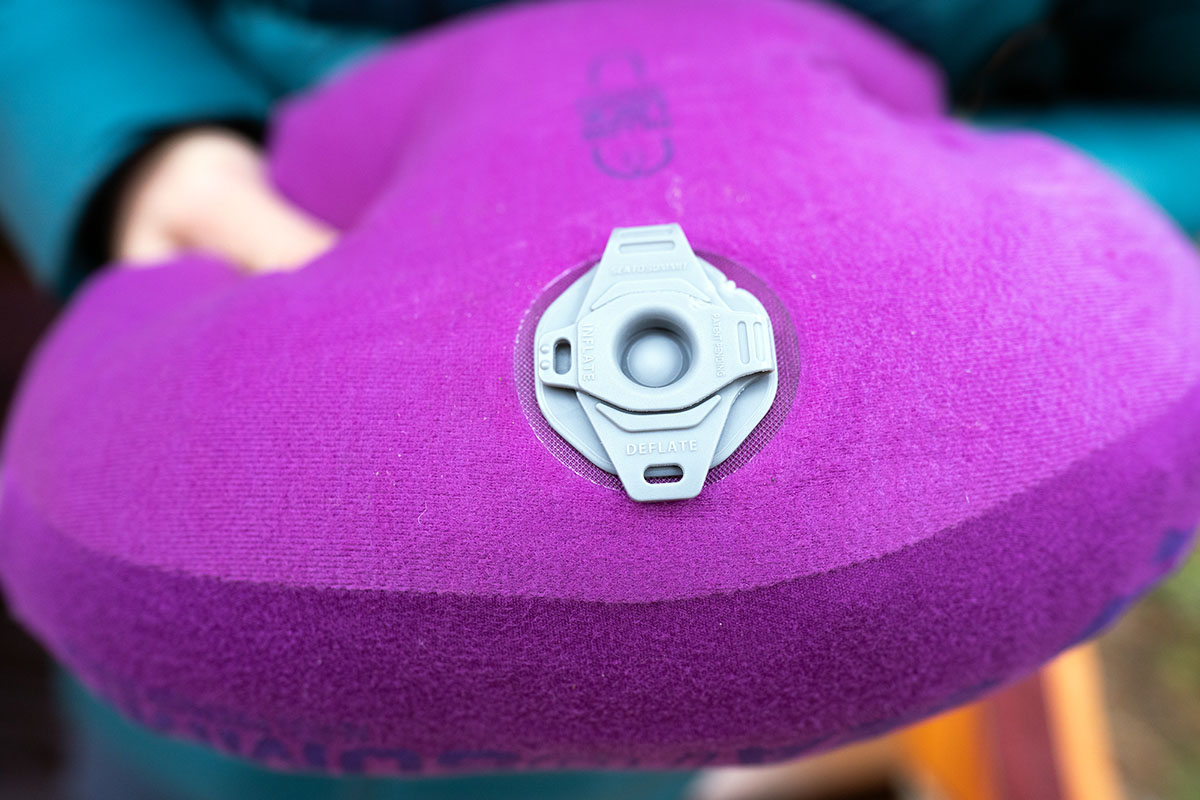
Other Features
Camping and backpacking pillows are inherently basic, but there are a few helpful features worth calling out. First, we appreciate when pillows offer quick and easy cleaning solutions (more on this below). Given their tendency to slide around during the night, it’s also helpful when pillows come with attachment points to secure to your sleeping pad. Exped’s MegaPillow is one example with thin fabric eyelets along the sides, and Zpacks also sells a Pillow Attachment Cord (a $6 add-on) to secure their Medium-Plus stuff sack pillow to your pad. Alternatively, all of Sea to Summit’s Aeros pillows boast their PillowLock tech, which attaches to any of their sleeping mats via hook-and-loop adhesive patches. A final feature worth calling out is the Cocoon Air-Core Hood/Camp Pillow’s two-sided design, which features plush polyester microfiber on one side for cold nights and smooth nylon on the other for added breathability in warm weather.
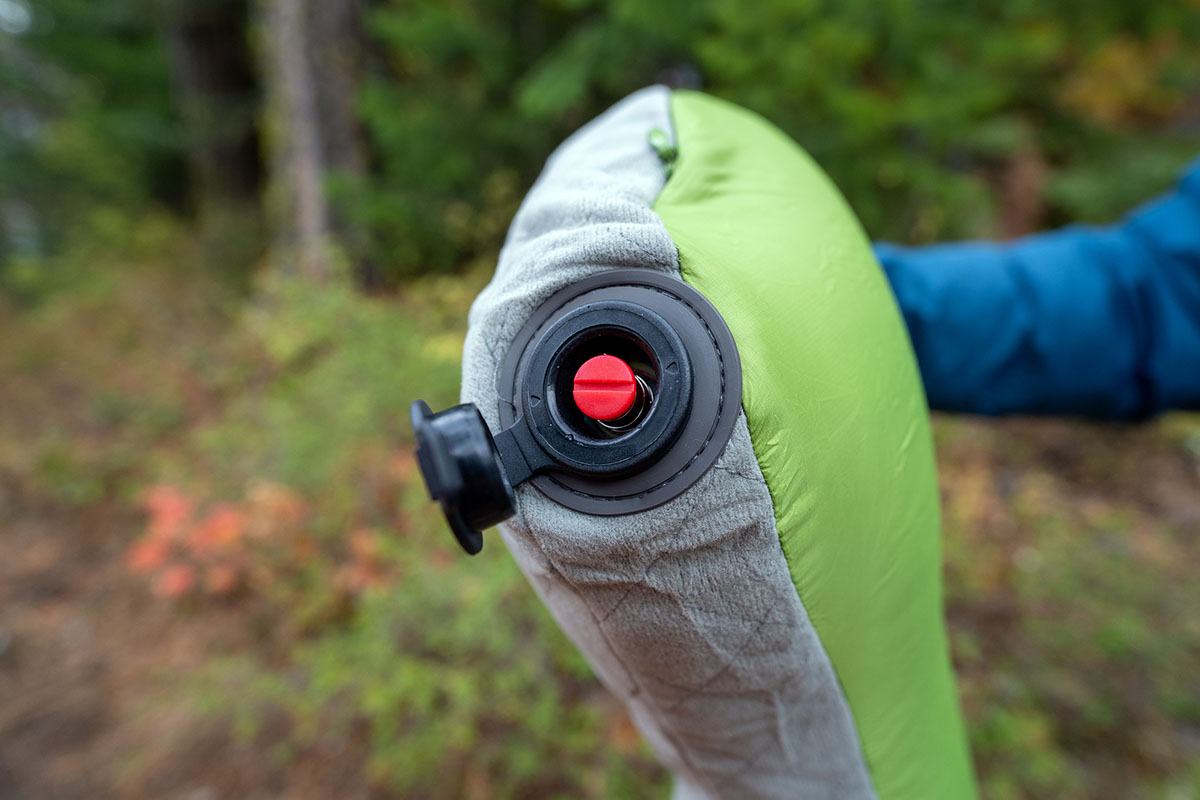
Pillows can get dirty quickly, especially if you’re a frequent camper or backpacker who gets out multiple times each season. The good news is that many outdoor-ready pillows have removable covers that can be thrown in the wash with other clothing, including designs like the Hest Camp Pillow, Therm-a-Rest Air Head, Exped MegaPillow, and others above. Cocoon’s Air-Core Hood/Camp Pillow also has a removable pillowcase, although Cocoon recommends hand-washing in lukewarm water and tumble drying to maximize its lifespan. Some non-inflatable designs like Therm-a-Rest's Compressible Pillow and Teton Sports’ Camp Pillow forgo removable covers but can simply be thrown directly into the washing machine. Finally, for inflatables without removable covers, it’s best to remove all the air from the pillow and keep it rolled in its stuff sack to protect it from punctures.
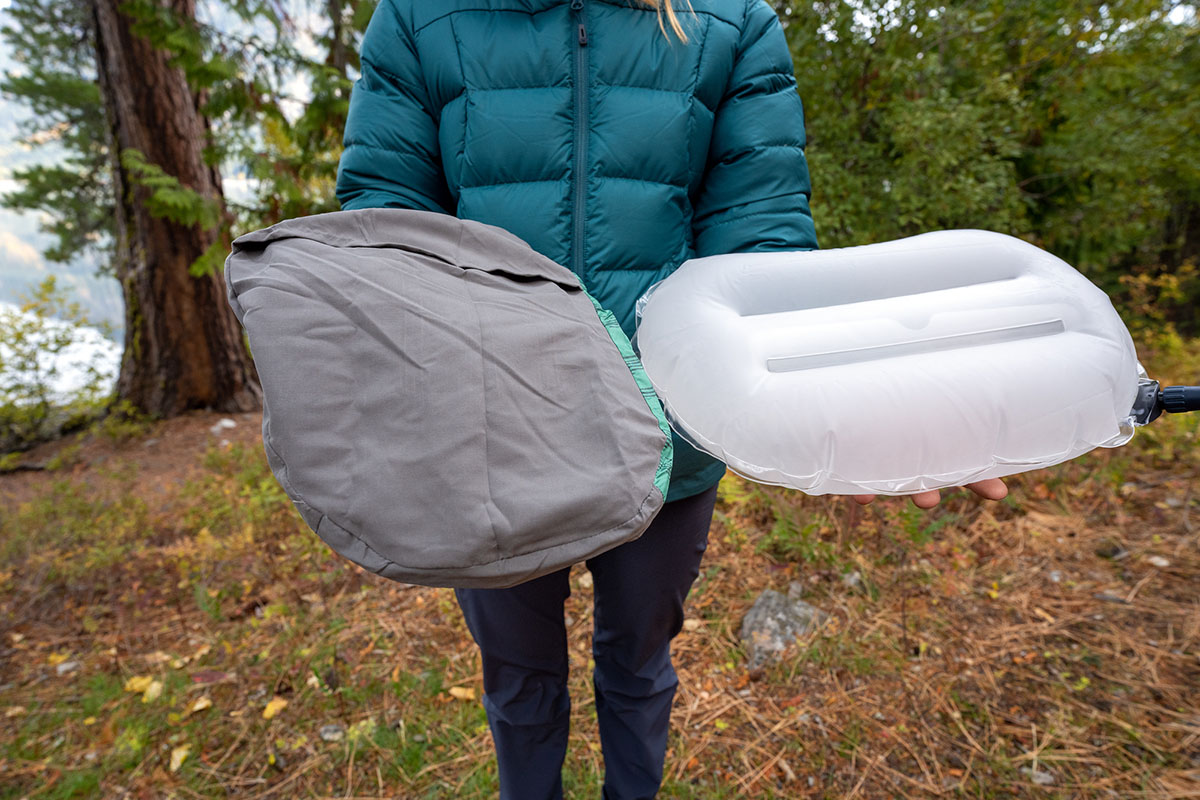
All of the pillows above are built primarily for outdoor use, but many cross over decently well for travel, too. Rumpl’s Stuffable Pillowcase is one of our favorites for this type of use, allowing you to tailor firmness and thickness by varying the types of clothing you stuff inside (e.g., baselayers for less cushioning and puffy down jackets for better loft and support). Therm-a-Rest’s Compressible Pillow is another viable option with soft and comfortable materials that compress down reasonably well for stashing in a duffel or pack when you reach your destination.
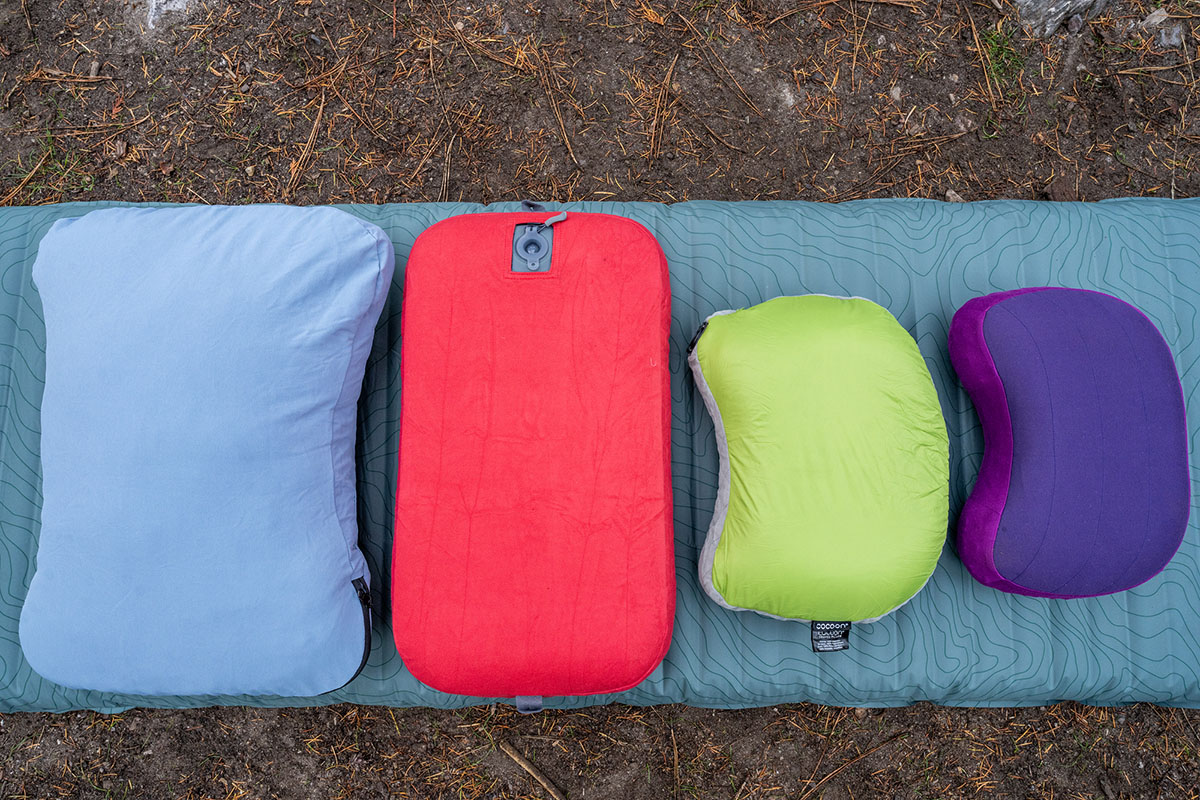
That said, frequent travelers and those who don’t plan to use their pillow outside often will likely want to opt for a dedicated travel design. Unlike the options above, these pillows typically boast U-shaped designs that curve around the neck to keep your head in place while sitting upright on a plane or bus. While typically heavier and less packable, the boost in neck support is sizable, and you often get a cinch cord at the front for securing the pillow in place while you sleep. There are plenty of affordable options available on Amazon, but many of the brands we cover above also offer dedicated designs in travel-friendly shapes. A few of our favorites are Cocoon’s U-Shaped Neck Pillow and Sea to Summit’s Aeros Premium Traveller and Ultralight Traveller pillows.
From personal experience, we went years without owning a dedicated camping/backpacking pillow and were able to make do by using a jacket or two for head support at night. Alternatively, you can always bring along a pillow from home or stuff clothing inside a cheap pillowcase while car camping (similar to stuff sack designs like the Zpacks Medium-Plus Pillow and Rumpl Stuffable Pillowcase above). That said, outdoor pillows are a pretty affordable bunch at around $20-$40, come with specialized fabrics and features that will stand up well to long-term outdoor use, and take up minimal space when stored. The boost in all-night comfort is also noticeable enough that we no longer camp or backpack without one. In the end, only you can decide whether or not the cost is justifiable (it may come down to how frequently you sleep outside), but we feel it’s a small price to pay for a sizable bump in outright comfort and support. Back to Our Top Pillow Picks Back to Our Pillow Comparison Table
Read More From Switchback Travel
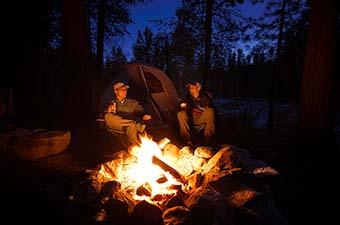
Camping Gear Reviews
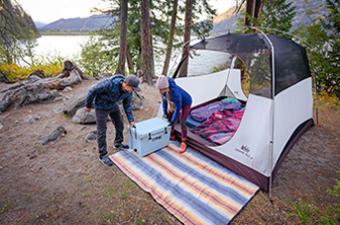
Best Camping Gear of 2024
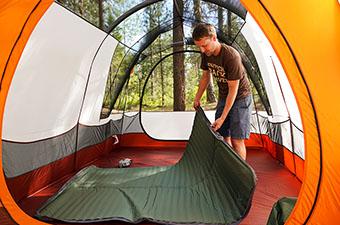
Exped MegaMat Duo 10 Review
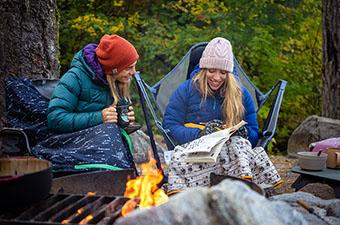
Best Camping Blankets of 2024
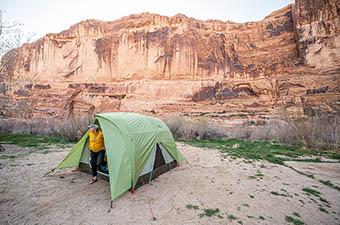
REI Co-op Wonderland Tent Review
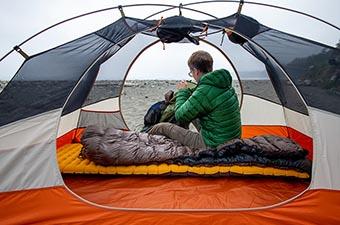
Best Backpacking Sleeping Pads of 2024
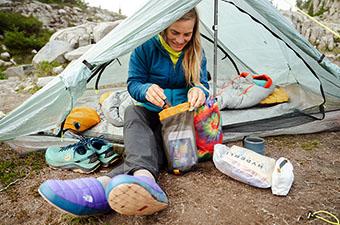
Best Stuff Sacks of 2024
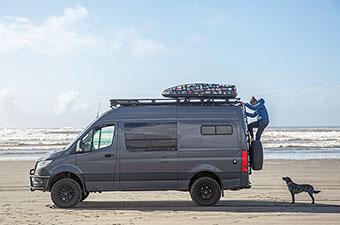
Rhino the Adventure Van: Our 2019 Sprinter 2500 4X4
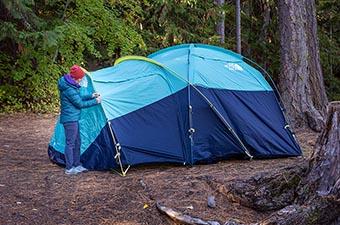
Best Camping Tents of 2024

Mobile Menu
Megamenu - desktop hamburger menu.
- Hiking Gear
- Backpacking Gear
- Biking Gear
- Camping Gear
- Footwear Reviews
- Climbing Gear
- Skiing Gear
- Winter Gear Reviews
- In-Depth Gear Reviews
- Hiking Shoes
- Hiking Boots
- Trail Running Shoes
- Mountain Bike Shoes
- Approach Shoes
- Climbing Shoes
- Beginner Climbing Shoes
- Mountaineering Boots
- Winter Boots
- Rain Jackets
- Down Jackets
- Synthetic Jackets
- Fleece Jackets
- Hardshell Jackets
- Softshell Jackets
- Windbreaker Jackets
- Ski Jackets
- Winter Jackets
- Hiking Pants
- Hiking Socks
- Trekking Poles
- Baby Carriers
- Running Vests
- Backpacking Tents
- Backpacking Packs
- Backpacking Sleeping Bags
- Backpacking Sleeping Pads
- Backpacking Stoves
- Backpacking Food
- Water Filters
- Altimeter Watches
- Handheld GPS
- Mountain Bike Helmets
- Mountain Bikes
- Mountain Bikes Under $1,000
- Mountain Bikes Under $2,000
- Gravel Bikes
- Bike Brands
- Kids' Bikes
- Hitch Bike Racks
- Camping Tents
- Rooftop Tents
- Camping Sleeping Bags
- Camping Mattresses
- Camping Chairs
- Camping Stoves
- Duffel Bags
- Rock Climbing Shoes
- Climbing Helmets
- Climbing Harnesses
- Climbing Quickdraws
- Belay Devices
- Climbing Ropes
- Climbing Backpacks
- Winter Gloves
- 4-Season Tents
- Ski Helmets
- Ski Goggles
- Ski Backpacks
- All-Mountain Skis
- Ski Bindings
- Backcountry Skis
- Backcountry Ski Boots
- Skis for Beginners
- Hardpack Skis
- Mirrorless Cameras
- Full-Frame Cameras
- DSLR Cameras
- Point-and-Shoot Cameras
- Travel Cameras
- DSLR Lenses
- Mirrorless Lenses
- Lofoten Islands
- Lofoten Hiking
- Hardangervidda
- Jotunheimen
- 10 Great Norway Hikes
- Public Huts
- Torres del Paine
- Chalten and Glaciares
- Lake District
- Patagonia National Park
- Milford Sound
- Abel Tasman
- Marlborough
- Great Walks
- Adventure Towns
Add adventure to your inbox
- Privacy Policy
- Terms of Service
© 2024 Switchback Travel. All Rights Reserved. No part of this site may be reproduced without our written permission.

Item added to your cart
Gear guides.
- Ultralight Backpacking Gear
- Best Ultralight Backpacks
- Best Ultralight Sleeping Bags
- Best Ultralight Tents
- Best Camp Shoes
- Best Down Jackets
- Best Rain Jackets
- Best Minimalist Sandals
Tips and How-To's
- Ultralight Backpacking Tips
- Animal Tracks ID Guide
- Contour Lines and Topo Maps
- How to Read Trail Signs
Food and Water
- Backpacking Food Ideas
- Backpacking Meal Recipes
- Best Meal Replacement Powders
- How Many Calories Do I Burn Backpacking?
- The Triple Crown of Hiking
- Appalachian Trail Map
- Gifts for Hikers
- What is Naked Hiking?
9 Best Backpacking Pillows
We tested the best backpacking pillows on the market for 2024 and this is how they performed..

© Jamie Lambert
We tested the best backpacking pillows on the market today according to price, weight, comfort, and packability. Read on to see how they performed, which is best for you, and get some valuable buying advice.
Table of Contents
- Best Backpacking Pillows
- Key Factors to Consider When Choosing
Other Things to Consider
Best backpacking pillows.
The best backpacking pillows are:
- Best Overall Backpacking Pillow for Comfort and Packability: SEA TO SUMMIT Aeros Premium
- Best Budget Backpacking Pillow: TREKOLOGY Aluft 2.0
- Best Ultralight Backpacking Pillow: BIG AGNES AXL Air Pillow
- Best Stuff Sack Pillow: ZPACKS Medium Pillow
- Most Comfortable Backpacking Pillow: THERM-A-REST Air Head Pillow
- Best Budget Stuff Sack Pillow: THERM-A-REST Pillow Case
The product comparison table below is sortable. Click the arrow in the heading cell to sort the models by preferred spec.
Best Overall Backpacking Pillow
- SEA TO SUMMIT Aeros Premium
Price: $54.95
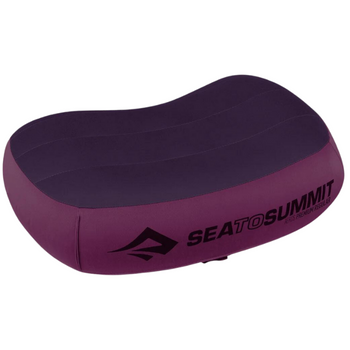
✅ Super comfy
✅ Packs down small
✅ Great for side sleepers
❌ Slightly pricey
❌ Touch heavier than other options
- Weight: 2.8 oz
- Shape: Rounded Rectangular
- Fabric Denier: 50D Polyester
- Inflated Size: 13.4 x 9.4 x 4.3 in
A pillow to cradle your neck lovingly, the Aeros Premium has a scalloped bottom edge that will center the pillow over your shoulders, no matter how you sleep. This design is not only one of the most comfortable we reviewed but also helped prevent the pillow from moving around while you sleep.
We love the brushed polyester stretch knit on the top and bottom that feels soft against the skin. The 50-denier polyester material makes this one of the most durable pillows on our list. Compared to other models we tested, the Aeros Premium stands out for its loft, which offers ample support for side sleepers.
We like that it inflates and deflates fast. And you can use the valve to fine-tune the inflation for optimal comfort. This allows side sleepers to pump the pillow to the max while letting back and stomach sleepers lower the height as desired. It is a touch heavier than other inflatable pillows we reviewed, but the lack of cons makes the Sea to Summit Aeros Premium our best overall backpacking pillow.
Best Budget Backpacking Pillow
- TREKOLOGY Aluft 2.0
Price: $24.99

✅ Best budget inflatable pillow
❌ Heavier option
- Weight: 3.3 oz
- Shape: U-Shaped
- Fabric Denier: Polyester, TPU
- Inflated Size: 16 x 12 x 4 in
A discount pillow with a sub $20 price tag, the Trekology Aluft 1.0 has been a staple of frugal backpackers and is our pick if you want a comfy but inexpensive inflatable pillow. For its cost, the Trekology Aluft 1.0 delivers an outstanding value. It inflates quickly and is super comfy, thanks to its scoop design.
It'll last at least a season and can go even longer if you take care of it on the trail. It is the second heaviest pillow we reviewed, but for under $20, you can buy it and try it. If you don't like it, you then give it away without too much financial loss.
Best Ultralight Backpacking Pillow
- BIG AGNES AXL Air Pillow
Price: $39.99

✅ Lightest inflatable pillow
❌ Not as packable as other options
- Weight: 1.6 oz
- Shape: Curved Rectangular
- Fabric Denier: Nylon, TPU
- Inflated Size: 16 x 10 x 4 in
One of Big Agnes's most popular pillows is the AXL, a lightweight backpacking pillow with features typically found in larger and heavier camp pillows. In fact, this is the lightest inflatable pillow we reviewed and our pick for the best ultralight pillow. It features a two-way, quick-release valve that allows for fast inflation and deflation.
We found the addition of a micro-release button for fine-tuning to be a handy extra. We like the kidney bean shape that helps keep the pillow under your head and shoulders. Unlike other models we tested, it’s also relatively noise-free.
Best Budget Stuff Sack Pillow
- THERM-A-REST Pillow Case
Price: $15.95

✅ Inexpensive
✅ Lightweight
❌ Not as comfortable as a dedicated pillow
- Weight: 2.3 oz
- Shape: Rectangular
- Fabric Denier: Polyester
- Inflated Size: 17 x 14 in
The Therm-a-Rest Pillow Case lets you convert your daytime stuff sack into a comfortable pillow. Unlike the other two stuff sack pillows we reviewed, the Therm-a-rest is made from polyester. The major bonus to using this material is that this is the least expensive backpacking pillow we reviewed at just $16.
The inside of the polyester stuff sack has a brushed polyester lining which we liked to add a bit of comfort. But like other stuff sack pillows we tested, it still falls short of a dedicated pillow comfort-wise. We also found the fabric to be crinkly, which is not very conducive to a good night's sleep.
Best Stuff Sack Pillow
- ZPACKS Medium Pillow

✅ Best stuff sack pillow
✅ Ultralight
❌ Less comfortable
- Weight: 1.4 oz
- Fabric Denier: DCF
- Inflated Size: 6 x 12 in
The Zpacks Medium Pillow takes the company's ultralight stuff sack and turns it into a comfortable backpacking pillow. We love the Dyneema construction, which makes this a super strong and waterproof stuff sack pillow. On the interior, the stuff sack is lined with a soft microfleece layer on one side. Just turn the sack inside out to expose the fleece layer and fill it with spare clothes.
Like other stuff sack pillows, this wasn’t as comfortable as other models we tested. However, if you want lightweight, at just 1.4 ounces, this is the lightest pillow we tested. It’s a good size for sleeping, but it is on the smaller end of the models we looked at. It’s also slightly more expensive than average, but if you’re looking for a stuff sack pillow, it’s our top pick.
Most Comfortable Backpacking Pillow
- THERM-A-REST Air Head Pillow
Price: $52.95

✅ Superior comfort
✅ Insulated
❌ Expensive
- Weight: 5.6 oz
- Fabric Denier: Polyester Cover, Urethane Insert
- Inflated Size: 11 x 15.5 x 4 in
The Therm-a-Rest Air Head Pillow is the easy winner for the most comfortable backpacking pillow we tested. It’s super lofty, firm and has a curved-shaped air chamber that delivers ample support for side sleepers. It’s also insulated, which makes this one of our favorite options for cold-weather camping.
Our biggest gripe is the weight; at 5.6 ounces, it’s the heaviest pillow we reviewed. At $53, it’s also one of the most expensive options we tested. The pillow itself can be a little crinkly, so if you toss and turn, beware. As a bonus, we like that the Therm-a-Rest Air Head Pillow ships with a soft, brushed fabric covering that can be removed for washing.
The Other Noteworthy Models
Klymit pillow x.
Price: $26.99

❌ Middle too low for side sleepers
- Weight: 2.5 oz
- Shape: Octagonal with X at the center
- Fabric Denier: 30D Polyester
- Inflated Size: 15 x 11 x 3.5 in
We like that the Klymit Pillow X offers a good balance of weight, price, and comfort. The hybrid construction of durable 30D polyester makes it more tear, puncture, and abrasion-resistant than other models we tested. The signature X shape cradles your head while sleeping.
We found that we didn’t slide off this in the night. However, this shape also means a low middle to this pillow, and side sleepers find this pillow less comfortable than other inflatable pillows we reviewed. We recommend the Klymit Pillow X for back and stomach sleepers only. Like with most inflatable pillows, we like that you can adjust the height and the air pressure to dial in the firmness and the loft to your liking.
HYPERLITE MOUNTAIN GEAR STUFF SACK

✅ Doubles as a stuff sack
✅ Comfy fleece lining
- Weight: 1.7 oz
- Fabric Denier: DCF + Porlatec®
- Inflated Size: 12 x 17 in
We love the Hyperlite Mountain Gear Stuff Sack pillow is a jack of all trades. By day it's a place to stash your gear to keep it dry. At night, it's your gateway to a good night's sleep; just fill it with soft clothes as needed. We like the simple design and that it’s made from light and strong Dyneema fabric.
The Dyneema fabric is waterproof, and it comes complete with a waterproof zipper. While we don’t find stuff sack pillows to be the most comfortable style of pillows overall, the fleece lining on the Hyperlight adds a surprising amount of comfort and warmth. Like all of Hyperlight’s products cost is a premium. This pillow is the second most expensive pillow we reviewed.
NEMO FILLO ELITE
Price: $59.95

✅ Washable cover included
❌ Small size
- Inflated Size: 15 x 11 x 3 in
You can make a fashion statement with the hybrid Nemo Fillo Elite rectangular pillow. It has a washable jersey blend cover available in a blue, dark gray, or sapphire striped pattern. We found this jersey cover to be soft and comfy on our faces as well. We like that it packs down small into the included stuff sack.
The best feature for us is the Primaloft insulation. This makes it a great option for colder three to four-season use. On the inside is an inflatable bladder with baffles that’ll cradle your head. Unfortunately, this is a small pillow and doesn't have as much loft as other pillows we tested. And at $60, the Nemo Fillo Elite is the most expensive pillow we reviewed.
Key Factors To Consider When Choosing
Backpacking pillow range widely in price. Simple pillow stuff sacks or inflatable pillows are the least expensive. Premium backpacking pillows are engineered to be ultralight or use high-end fabrics, Dyneema, which pushes up the price.
The best value backpacking pillows:
The most affordable backpacking pillows:
- KLYMIT Pillow X
The best premium backpacking pillows:
- NEMO Fillo Elite
- HYPERLITE MOUNTAIN GEAR Stuff Sack Pillow
Backpacking pillows should be lightweight. Since they are luxury items, we recommend nothing over 3 ounces.
The lightest backpacking pillows:
There is no point carrying a pillow if it doesn’t add comfort. We recommend testing the pillow in a store before you purchase it, if possible. For the best comfort, look for a thicker pillow that includes its own pillowcase or has a soft lining. If your pillow doesn’t have this, you can always wrap an item of soft clothing to wrap around your pillow to add comfort.
Size is the other important factor; bigger generally means more comfortable. And pillows with insulation will be comfier in colder climates.
The most comfortable backpacking pillows:
Packability
The smaller, the better when it comes to your backpacking pillow. Look for a pillow that compresses down and stuffs into your pack. The addition of valves for inflation and insulation adds to the size of a pillow. Stuff sack-style pillows can be used as stuff sacks during the day, making them the smallest option to pack.
The most packable backpacking pillows:
Types of Backpacking Pillows
Size and shape.
COMPRESSIBLE. These pillows are filled with various foams and synthetic fibers or some sort of combination. They may be super comfy and instantly ready for your heavy head, but they are very bulky and can be much heavier than their inflatable counterpart.
If comfort is what you want and you are willing to pay for it, then go for a compressible pillow with down feathers. They are the softest, most compressible, and lightest to carry.
INFLATABLE. Take your pick - self-inflation (blow up with your breath) or—for the lazy souls—you can get one that auto-inflates (open a valve and let the pillow expand). You can adjust the amount of air for more comfort, but they can be noisy when you move your head.
The big advantage of inflatable pillows is that they are super minimalist and lightweight. The downside is that they often provide little cushioning and can be quite stiff.

HYBRID. These are the best of both worlds, as they are a morphing of inflatable and compressible designs. A hybrid pillow has fluff on the top to make it comfy for your head and an inflatable bottom to increase support. It will give you a dream-catching night's sleep, but you will have to be prepared to sacrifice a moderate amount of space and weight.
STUFF SACKS. Stuff sacks use your own clothing to inflate the pillow. You simply stuff your clothing inside the sack and lay down your head. When you wake up, you don’t even have to deflate the pillow.
You can keep the sack filled with your clothing until you need them. Just make sure you use soft clothing, like socks and shirts, that don’t have buckles or similar hard items.

How do you sleep… on your back, on your stomach, or on your side? This will determine how much support you need to keep your spine aligned. Backpacking pillows can tend to be on the small side, so a contoured pillow rather than a square shape can help to keep your head actually "on" the pillow all night.
Side sleepers should consider pillows that are firm and have more loft. They need that extra height to support their head, neck, and shoulder while they sleep. Back and stomach sleepers typically rest with their head closer to the ground. As a result, they can choose softer, low-profile pillows that cradle their head and not prop them up.
Consider the height of the pillow for how you normally sleep. Backpacking pillows with inflatable bladders give the option to customize the level of support. A pillow of this variety will cost you more, but it may be worth it if you are prone to a sore neck or back. Also, consider the thickness of the outer material and whether you can add padding to it.

Similar to sleeping pads, some pillows have insulation for cold weather backpacking. This insulation traps the heat inside the pillow, so you won’t feel like you are sleeping on an ice cube. We recommend looking for a pillow with insulation if you’re sleeping in cold conditions. In a pinch, you can use your buff or puffer jackets as a pillowcase for a little extra insulation.
One overlooked aspect of a pillow is the noise that it makes. Some pillows are nearly silent while you sleep, while others make an annoying crinkly noise. We recommend getting the least noisy pillow possible. Visit a local retailer and test out the pillow if you can. If you cannot, scour online reviews or ask existing owners about the noise level of the pillow you would like to purchase.
Since you’re mostly using your pillow in the tent and at night, durability isn’t the most important consideration. However, if you’re using an inflatable pillow, you don’t want it to get a hole. Look for pillows with thicker material to offer the best durability.

About Justin Sprecher
About greenbelly.
After thru-hiking the Appalachian Trail, Chris Cage created Greenbelly to provide fast, filling and balanced meals to backpackers. Chris also wrote How to Hike the Appalachian Trail .

Related Posts

- Choosing a selection results in a full page refresh.
Best Backpacking Pillow for a Great Night’s Rest [2024 Edition]
Want to sleep comfortably in your tent but unwilling to schlep added weight along the trails? Find a lightweight solution for a more restful night's sleep in this guide for the best backpacking pillow.
After a long day of hiking and setting up camp, there’s nothing worse than not getting a restful night of shuteye under the canvas. Besides a quality sleeping bag and pad, another essential item that can elevate your backcountry bedtime experience from restless to home-like is the humble yet invaluable backpacking or camping pillow.
We found the Sea to Summit Aeros Down to be our most favored option but depending on your circumstances we’d also recommend the Therm-a-Rest Compressible, HEST Camping Pillow, Nemo Fillo Elite, Nemo Fillo, Sea to Summit Aeros Premium, REI Co-op Trailbreak, Therm-a-Rest Trekker, and the Exped Air Pillow UL.
Alongside reviews of these 9 awesome pillows, we also offer comprehensive advice to help you find the best option within your budget. One consideration to be made is in selecting between inflatable, compressible, hybrid, or stuff sack models. Additionally, you’ll need to decide what to prioritize in your backpacking pillow from comfort & support, weight & packed size, ease of use, and durability.

Table of Contents
Sea to Summit Aeros Down
Therm-a-rest compressible, hest camping pillow, nemo fillo elite, sea to summit aeros premium pillow, rei co-op trailbreak, therm-a-rest trekker, exped air pillow ul, compressible, comfort & support, weight & packed size, ease of use, at a glance: best camping pillow.
- Editor’s Choice: Sea to Summit Aeros Down “An ultralight, superbly comfortable hybrid pillow that provides plenty of support and the added luxury of a cozy down topper.”
- Best Value: Therm-a-Rest Compressible “A slightly heavy but affordable, well-made, and comfortable compressible pillow made with recycled materials.”
- Best Budget: REI Co-op Trailbreak “A basic but surprisingly comfortable and well-made option at an affordable price.”
- Best for Car Camping: HEST Pillow “This luxury pillow is too heavy and bulky for backpacking, but ideal for roadside campers unwilling to compromise on comfort.”
- Best Hybrid Pillow: Nemo Fillo Elite “A slightly skinny but otherwise awesome hybrid pillow that combines an ergonomic air chamber with a plush Primaloft topper for a supportive and more homely feel.”
- Best Support: Nemo Fillo “This hybrid model combines I-beam air cells with a luxury foam fill to deliver a little extra resilience and firmness.”
- Best Inflatable Pillow: Sea to Summit Aeros Premium “The Aeros’ ultralight weight and super-soft face fabric make it a good backpacking pillow for anyone who wants the packability of an inflatable without compromising too much on comfort.”
- Best Stuff Sack Pillow: Therm-a-Rest Trekker “A wonderfully soft, uber-practical liner that lets you save precious pack space for other things.”
- Best Ultralight: Exped Air Pillow UL “The Air UL’s ultralight weight, tiny packed size, and durable fabric make it the perfect pick for long-term backcountry travel.”
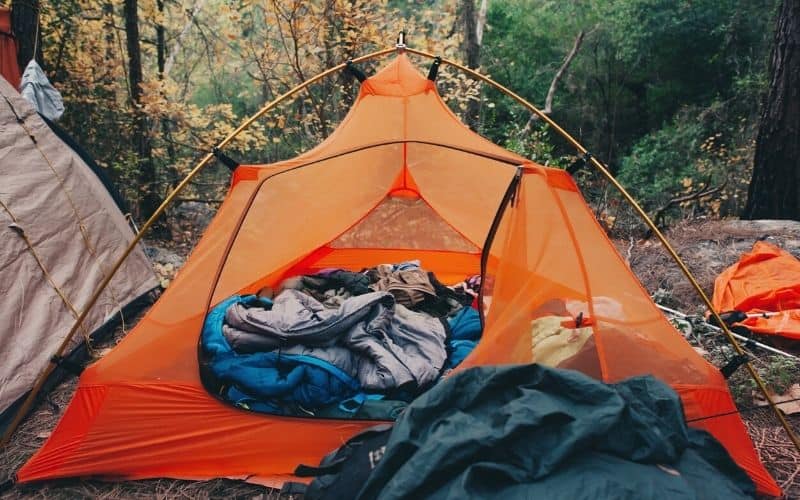
What Are The Best Camping Pillows?
Out of our best backpacking pillows shortlisted below the the Sea to Summit Aeros Down came out on top.
- Sea to Summit Aeros Premium

Regardless of your sleeping preferences or trip type, the Sea to Summit Aeros Down emerges as our editor’s choice, offering exceptional comfort, support, and weight savings.
Combining a thermoplastic urethane inflatable bladder with a luxurious down topper, the Aeros marries the best bits of inflatable and compressible styles of pillows. The bladder provides ample support even for side sleepers and the warm, lofty down topper offers comfort levels on a par with compressible models that weigh 5 times more.
That, in a nutshell, is the Aeros’ genius and the USP that makes it well worth its slightly inflated price tag.
And it gets better. Most inflatable and hybrids get a bad rep for sliding around while you sleep or being prone to punctures, but not the Aeros. It’s made with robust 20d underside fabric for added durability and employs S2S’s nifty PillowLock system to ensure it stays where you want it throughout the night.
You’re probably wondering if the above couldn’t be said of all hybrid-style backpacking pillows. And yes, it’s true that most hybrids tick the support and comfort boxes whilst also keeping weight to a minimum. However, the Aeros’ down fill and use of horizontal baffles that maximize loft make it a true standout even compared to the top competitors in the ultralight hybrid category.
In a head-to-head with our list’s other hybrid, the Nemo Fillo Elite, the Aeros came up trumps on account of its added height and lighter weight at 2.5 oz. If you’re a back sleeper, however, and are happy to carry those 5 extra ounces to save a few $, then the Fillo Elite’s a solid alternative.
- Lightweight
- Tough underside
- Responsibly sourced down fill
- Great support
- Very comfortable
Bottom-Line: This soft, lightweight pillow offers awesome support and just-like-home comfort making it well worth the added expense.
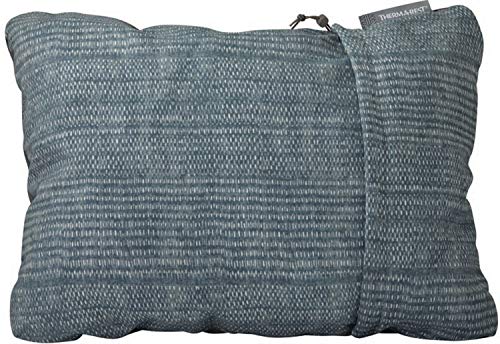
If you’re looking for an affordable pillow that falls between an ultralight backpacking pillow and a more substantial car-camping pillow, the Therm-a-Rest Compressible could be the ideal solution for you.
Weighing in at 9 oz., this is the lightest compressible pillow on our list. Sure, it isn’t going to win any prizes for featheriness, but it isn’t going to break your back on a multi-day backpacking trip either.
The important thing here, of course, is that the latter is something that can rarely be said of compressible-style pillows – cast your eye toward the specs of the HEST Pillow (below) and you’ll see what we mean!
Compared to ultralight air pillows like the Exped Air or Nemo Fillo, the Therm-a-Rest delivers what you’d expect from a compressible. It’s more durable, softer, and offers better next-to-skin comfort. It also, however, takes up a lot more room in your pack and is 3-4 times heavier.
Weight and packed size aside, this pillow does a lot to endear. It has a soft foam filling that feels amazingly home-like, a brushed polyester shell, and measures a generous 18 x 14 x 4 inches. It’s also made entirely with recycled materials and comes with a reassuring 2-year warranty.
- Comfortable
- Lightweight for a compressible
- Durable fabric
- A little heavy for multi-day backpacking
Bottom-Line: A great pillow for anyone who wants the comfort of a compressible without such a prohibitive weight penalty
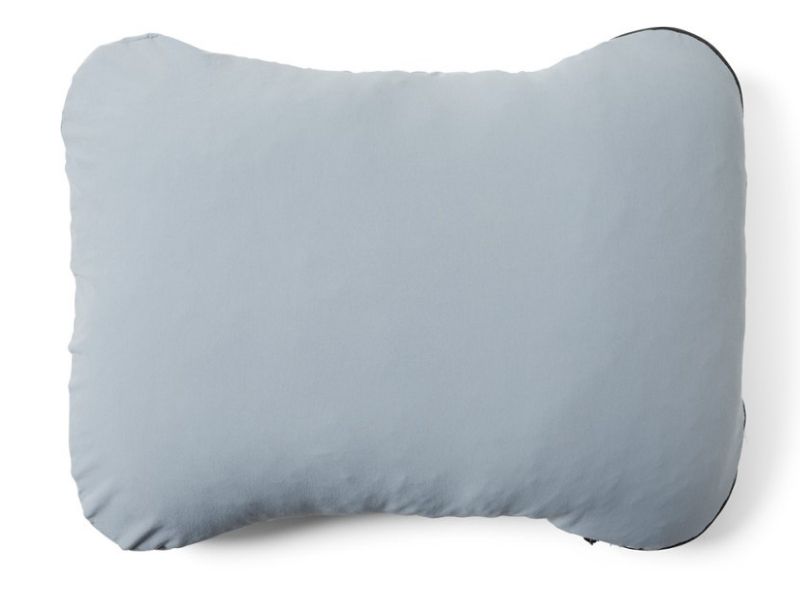
For car camping, the HEST is certainly a contender to consider, offering the comfort and coziness akin to the pillow you use at home.
This beast of a pillow is the heaviest and bulkiest on our list – by a large margin. Unless you happen to have a packhorse or personal Sherpa to haul your gear for you, then, it’s far from ideal for backpacking.
But not all of us plan on venturing far and wide before setting up camp.
If you do most of your camping at roadside sites or from the back of your SUV, the HEST’s heft and oversized dimensions are, in fact, a bit of a boon. They make it more supportive than the vast majority of its peers, as comfy as they come, extra-durable, and far less likely to slip out from under your head.
But the HEST has a lot more going for it than size alone.
Its shredded memory foam and polyester fill mean it won’t flatten or lose its shape during the night, while zippered access to the fill allows you to customize the level of loft to your preference or sleep style. Unlike most pillows of this size, it also has a curved, ergonomic shape that sits snugly under your head and neck.
To top it all off, the HEST uses a stretch-woven face fabric cover that’s soft against the skin, provides plenty of airflow, and is both water- and dirt-resistant.
- Ergonomic shape
- Integrated stuff sack
- Expensive
Bottom-Line: Too heavy for backpacking, but an ideal pick for roadside camping if you want home-like comfort and are happy to pay for the privilege.

The Nemo Fillo Elite is our top choice for a hybrid backpacking pillow, being ultralight, highly packable, and incredibly comfortable, and all at a more affordable price compared to most others.
It’s made with a winning combo of I-beam baffled air cells and a thin layer of Primaloft insulation, which together provide ample support and oodles of comfort. The fill is also topped off with a soft jersey cover that’s machine washable, cools the skin, and feels frickin’ marvelous against the skin.
Wondering why this didn’t win the award of best overall backpacking pillow overall?
Well, it might seem like we’re splitting hairs, but there are a few (potential) downsides.
The most obvious of these is the Fillo’s slender proportions – at 3” thick, this is the slimmest pillow on our list and therefore not ideal for side sleepers. And compared to the Aeros Down, the Fillo’s less substantial base fabric did leave us wondering how long it would last if subjected to the odd spiky root or sharp rock around camp.
- Type: Hybrid
- Weight: 3 oz.
- Cozy Primaloft synthetic-fill insulation
- Soft face fabric
- Tiny packed size
- Made with recycled materials
- Fits inside sleeping bag hood
- Only 3” thick (great if you prefer flat pillows!)
- Kinda pricey (but not bad for a hybrid!)
Bottom-Line: One of the most comfortable backpacking pillows out there for stomach and back sleepers.

If you’re tired of flat camping pillows or hard inflatables that leave you with a stiff neck come sunrise, the Nemo Fillo provides the best support among the pillows we tested.
The above is a bold claim but the Fillo is, without doubt, the most supportive of all the inflatable, hybrid, or foam pillows we’ve ever tried.
Here’s why.
The Fillo combines a tough air bladder base with a generously thick foam topper, providing you with 4 inches of firm but comfortable loft. There are thicker pillows out there, sure, but the foam used in this one offered just a little more “resilience” without feeling more like a basketball than something designed to let us sleep comfortably.
It also has a nice ergonomically shaped I-beam baffled air cell, an incredibly soft microsuede cover, and packs down to a bundle the size of a tennis ball,
The Nemo Fillo’s 9-oz. weight makes it less suitable for long backpacking trips than other pillows on our list. But for roadside camping, travel, or shorter backpacking adventures, it’s a great choice.
- Weight: 9 oz.
- Luxury foam fill
- Machine-washable microsuede cover
- 17” wide
- Baffled air chamber reduces “balloon” feeling
- Quite heavy
Bottom-Line: A luxury pillow that provides a little extra width and the added support that side sleepers require.

If you prefer to pack fast and light, we recommend the Sea to Summit Aeros Premium as the top choice for an inflatable backpacking pillow.
Weighing just 2.7 oz., the Aeros Premium is only 0.7 oz heavier than the lightest pillow on our list, the Exped Air UL. As with all inflatables, both of these pillows are a little squeaky, prone to slipping, and a little hard under the head. But if you prefer a firm pillow and a little more loft, both are solid options.
If forced to choose between the two, we’d park ourselves firmly on the fence. For ounce-counters, the Exped’s naturally a better choice given that it’s a whole 4.7” wider. If durability is more of a concern, then the Aeros is your best bet – its 50D fabric is much more likely to survive rough treatment around camp than the Exped’s 20D stretch polyester.
You might be wondering what differentiates the Aeros from the countless other worthy inflatables on the market.
For starters, we love the Aeros’ ergonomic design. The top is contoured in a way that cradles the head, which makes it a little more stable than other inflatables.
Secondly, the mini-valve via which inflating’s done through allows you to adjust the level of loft with ease, without a headlamp or even having to raise your head.
Finally, the Aeros’ unique PillowLock system keeps your pillow exactly where it belongs when used in combination with an S2S sleeping pad, eliminating the most commonly cited drawback of nearly all inflatable-style backpacking pillows. The pad isn’t included, of course, but if you need an excuse to buy one…
- Type: Inflatable
- Weight: 2.7 oz.
- Tough fabric
- Ergonomic design
- Lock system attaches to S2S sleeping pads
- A little bit wobbly
- Not as comfortable as a compressible or hybrid pillow
Bottom-Line: A tough, lightweight backpacking pillow that’s ideal for buyers who want the added support and packability of an inflatable without sacrificing too much in the way of comfort or durability.
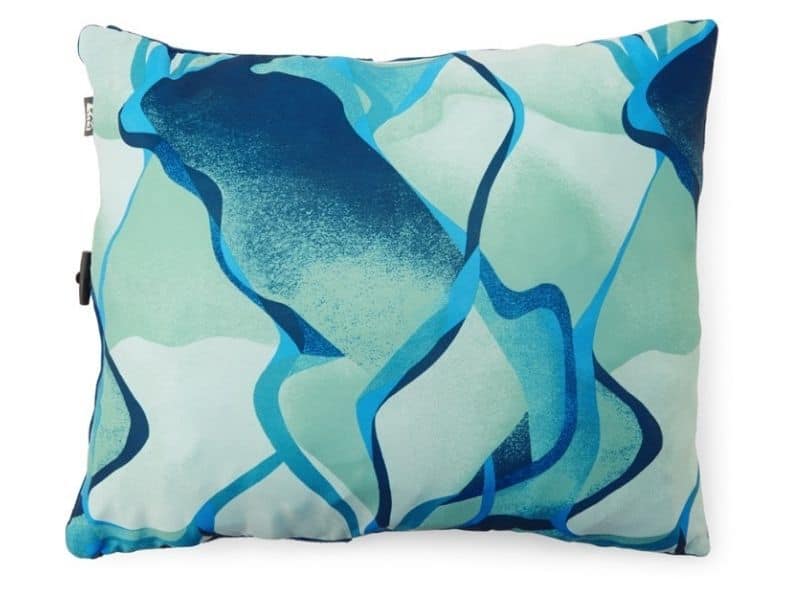
For a high-quality, foam pillow that ticks all the boxes on a budget, we love the REI Co-Op Trailbreak.
The Trailbreak is one of the most popular backpacking and camping pillows on the market. And with good reason.
The Trailbreak is made with upcycled scraps of foam that REI Co-Op use to make their self-inflating sleeping pads, which, handily, makes it one of very few self-inflating pillows on the market. When it’s time for bed, all you have to do is pull it out of the storage pocket and watch as it transforms from a tennis-ball-sized bundle into a plush cushion five times its packed size.
Pretty neat, right?
Compared to its closest compressible competitor, the Therm-a-Rest Compressible, the Trailbreak’s an ounce heavier at 10 oz., but also a little more affordable and packs down to a smaller size.
- Made with upcycled foam
- Small packed size
- “Self-inflating”
- Measures 18” x 14”
Bottom-Line: A nicely priced, highly packable, and generously sized self-inflatable pillow that’s ideal for buyers who want the comfort of a compressible without paying through the nose.

The Therm-a-Rest Trekker is our go-to backpacking stuff sack pillow for multi-day trips when pack space is limited.
This pillow packs down to the size of a large handkerchief and can easily fit inside a shirt pocket. When opened, however, it measures a healthy 17” x 14”, making it one of the largest camping pillows on our list.
But how does it work? Well, as with all stuff sack pillows, the Trekker relies on your extra clothing for its loft, so we wouldn’t recommend it if you’re on a backpacking trip with your nudist colony or if you like to sleep in all the clothing you carry. (We tried filling ours with leaves once, but wouldn’t recommend it!)
What we love most about this sack is that it weighs next to nothing but, thanks to its plush, brushed polyester exterior, allows us to enjoy a perfectly pillow-like experience without having to carry a separate pillow along for the trip. And when we’re done with it in the a.m., we can also put it to work as a standard stuff sack for other bits of gear.
Gotta love gear that’s multifunctional, right?
- Type: Stuff sack
- Weight: 2.3 oz.
- Doubles as a stuff sack for other gear in daytime
- Brushed polyester face fabric
- 2-year warranty
- Comfort depends on what you fill it with
Bottom-Line: A great choice for backpackers happy to sleep on a makeshift pillow if it means saving precious cubic inches in their pack.
The Exped Air UL is ideal for backpackers and thru-hikers seeking a durable, thick pillow that provides ample support at an ultralight weight.
Tipping the scales at just 2 oz., this is the lightest blow-up pillow on our list. But there are several other reasons why the Air UL has made a habit of picking up “Top Backpacking Pillow” awards over the years.
For starters: it may be a featherweight, but it’s far from flimsy. While the Air UL’s 20D fabric makes it less robust than the Aeros Premium, it’s more than tough enough to deal with regular use and abuse.
Secondly, this is a large pillow – measuring 18.1” x 11.8” x 4.7”, it’s one of the widest and thickest pillows on our list, which makes it ideal for side sleepers.
Finally, if you’re a stomach or back sleeper, the Air UL’s low-profile FlatValve makes adjusting loft a cinch, while the anatomical shape means your head will be comfortably cradled and held in place no matter how much (or how little) you inflate it.
- Weight: 2 oz.
- 5-year warranty
- Less comfortable than compressible and hybrid pillows
- Pricey for an inflatable
- A bit noisy
Bottom-Line: Light, large, comfortable, reasonably durable, and our favorite camping pillow for multi-day adventures.
What Is The Best Camp Pillow Type For You?
Backpacking pillows are more complex than they appear, with various styles differing significantly in terms of comfort, support, and suitability for the trail. We’ve listed the main types below.
Since air weighs almost nothing, inflatable pillows are popular with backpackers aiming to shave ounces off their pack load. They can offer the loft of the densest, heaviest fabrics without compromising on support.
Inflatable pillows are also highly packable and in many cases far cheaper than compressible or hybrid models.
There are however several drawbacks. What goes up, must/might come down, and inflatable pillows are the only type that will come down (i.e. deflate) when punctured. They’re also a little wobbly and unstable as compared to a compressible pillow or stuff sack, and not nearly as soft.
That said, some inflatables, like the Sea to Summit Aeros, use nifty locking systems or anti-slip surfaces to help keep them in place. And all of them, of course, can be deflated to the level of firmness you desire.
Our list includes 2 inflatables, the S2S Aeros Premium and Exped Air UL.
To resemble your home pillows, a compressible pillow is filled with materials that compress and expand, such as shredded foam or compressible fiber. While this makes them bulky and heavy, it also makes them the most comfortable and supportive option.
As you might imagine, compressibles’ weight and size make them less than ideal for backpacking. If you’re car camping, however, or are willing to lug a few extra ounces in return for a little luxury and superior comfort, then this is the type of pillow you need.
Our list has 3 compressible pillows: the Therm-a-Rest Compressible, HEST, and REI Co-op Trailbreak.
These pillows use a combo of compressible materials and air to provide a happy medium between an inflatable and compressible pillow. In most cases, this takes the form of a lower inflatable bladder topped with a soft, upper layer of down or foam insulation that enhances comfort.
This design makes hybrids more comfortable than inflatables, but also heavier and equally prone to punctures. They’re also lighter than compressibles but can be pricier.
There are 3 hybrids on our list: the Nemo Fillo, Nemo Fillo Elite, and S2S Aeros Down.
Stuff sack pillows are designed based on roll-top-closure bags used for gear storage, only they have a soft, brushed surface fabric for next-to-skin comfort. Come bedtime, you simply stuff them with a jacket, sweater, or other extra clothes, seal them up, and you’re all set to snooze.
The ultralight weight of a stuff sack pillow makes them a shoo-in for ultralight adventures, whether you’re thru-hiking or simply prefer to lug less burdensome loads. Moreover, unlike inflatables, they can’t be punctured, and also serve as a handy stuff sack for other gear during the daytime.
The downside: these pillows, of course, will only be as comfortable as the materials you stuff them with.
Our list has only one stuff-sack pillow, the Therm-a-Rest Trekker. While there are plenty of good competitor models out there, this one’s fair pricing, comfort, and intelligent design made it a standout.
What Features To Look For In A Good Backpack Pillow?
To help you decide what style suits your needs best the following list shows what features to look out for in backpacking pillows.
All the pillows in our review delivered on the two core competencies for pillows, comfort and support. However, certain models cater to specific types of sleepers better than others, with some offering superior support and comfort.
Here’s how to determine which will be best for you:
Side sleeper? If so, you’ll need a little more height to support your neck and shoulders, which makes inflatables and hybrids the best option. A stuff-sack pillow will work well too, but only, of course, if you have something substantial to fill it with.
Back sleeper? In this case, a lower-profile pillow is usually preferable, which means any style of pillow might be a good match (even inflatables can be deflated to the desired height). That said, most back sleepers – and stomach sleepers – prefer the malleability of a compressible.
Generally speaking, we find compressibles and hybrids are the most comfortable of the bunch because they most closely mimic the coziness and loft of our pillows at home, especially when filled with down feathers.
Whichever style you choose, the next most important factor is the “face fabric” – i.e. the portion of the pillow that will be in contact with your phizog. The comfiest face fabric? Brushed polyester is the fabric of choice in many backpacking pillows on account of its soft feel and ability to absorb moisture. Because nylon can be slippery or sticky, it’s best avoided.
We also prefer an ergonomically shaped or contoured pillow, like the Aeros and Exped Air. These provide better support for the neck and back and are also less likely to slip around while you sleep.
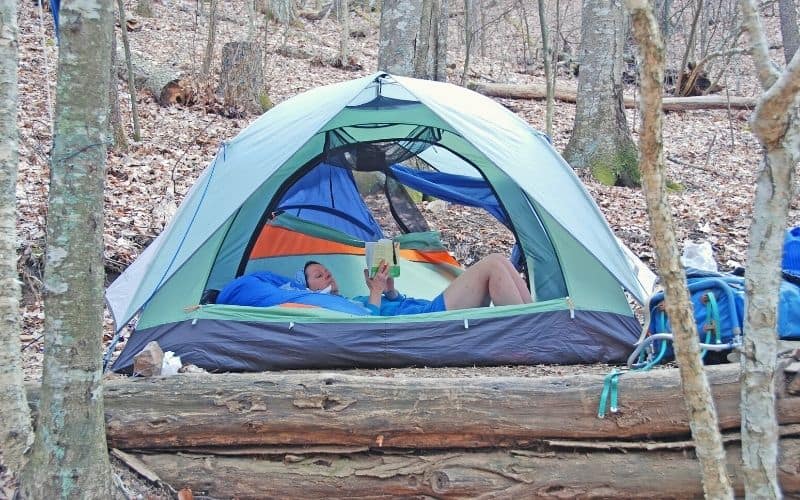
For car camping , the weight and packed size of your pillow are not significant considerations, but for backpackers, they are a critical concern.
If your vehicle – rather than your legs – is responsible for carting your kit to your campsite, then you can afford to plump for a more comfortable pillow, weight and packed size be damned.
If you’re backcountry camping, however, you want a hiking pillow that strikes the optimal balance between comfort, support, poundage, and packability.
What kinda pillow does that best? Inflatable and stuff sack pillows are good choices because they weigh almost zip and pack down super-small. But bear in mind these styles often entail sacrificing the comfort and support of a hybrid or compressible.
The lightest and most packable options on our list are the Therm-a-Rest Trekker (2.3 oz.) and Exped Air (2 oz.).
The weight of the compressibles above varies widely, from the relatively lightweight Therm-a-Rest Compressible (9 oz.) to the kinda cumbersome HEST (35.2 oz).
How to choose the best pillow for you? It’s all about deciding how much comfort you’re willing to trade for weight savings.
When it comes to backpacking pillows ease of use refers to three factors: 1) ease of deploying the pillow; 2) ease of cleaning it; 3) ease of sleeping on it.
- Deployment: Short on patience? If so, then you probably don’t want an inflatable backpacking pillow that requires you to sacrifice around two minutes of your time to transform it from pouch to pillow, so the ready-to-roll configuration of a compressible pillow will be more suitable for you.
- Cleaning: Machine-washable models like the Therm-A-Rest Compressible and Nemo Fillo are ideal if you’re the type of camper who concerns themselves with things like hygiene. Most inflatables, on the other hand, can only be wiped clean.
- Staying Power: Many pillows, especially inflatable ones, tend to slide out from under your head while you sleep. This, of course, sucks. Some manufacturers get around this by adding locking systems (see: S2S Aeros & Aeros Down), non-slip fabric, or contoured undersides that help keep them in place.
If you’re a card-carrying tosser and turner, however, compressibles and stuff sacks are the type least likely to go AWOL throughout the night.
The most important factor for durability is the fabric density of the pillow. Fabric density, or thickness, is measured in “ Denier ,” often seen in product specifications as a singular “D,” such as “20D,” “50D,” and so on. A higher denier count indicates a more durable product, so consider models with 20-50D fabric for increased longevity.
Make no mistake about it, the great outdoors is no place for flimsy, feeble fabrics. Rocks, trees, roots, foliage, twigs, crampons, tent poles, tent pegs, and clumsy campmates are just a few of the things that could send your pillow prematurely to pillow heaven if it ain’t made with materials that cut the mustard.
Last update on 2024-05-22 / Affiliate links / Images from Amazon Product Advertising API
Kieran James Cunningham
Kieran James Cunningham is a climber, mountaineer, and author who divides his time between the Italian Alps, the US, and his native Scotland.
He has climbed a handful of 6000ers in the Himalayas, 4000ers in the Alps, 14ers in the US, and loves nothing more than a good long-distance wander in the wilderness. He climbs when he should be writing, writes when he should be sleeping, has fun always.
Kieran has taught mountaineering, ice climbing, and single-pitch and multi-pitch rock climbing in a variety of contexts over the years and has led trekking and mountaineering expeditions in the Alps, Rockies, and UK. He is currently working towards qualifying as a Mountaineering and Climbing Instructor and International Mountain Leader.
Kieran’s book Climbing the Walls —an exploration of the mental health benefits of climbing, mountaineering, and the great outdoors—is scheduled for release by Simon & Schuster in April 2021.
Articles - Email - Linkedin - Facebook - Instagram
Leave a Comment Cancel reply
Save my name, email, and website in this browser for the next time I comment.
- svg]:stroke-accent-900"> 735K
- svg]:stroke-accent-900"> 133K
- svg]:stroke-accent-900"> 54.1K
The Best Backpacking Pillows
By Laura Lancaster
Posted on Oct 31, 2022 3:04 PM EDT
9 minute read
Best Overall
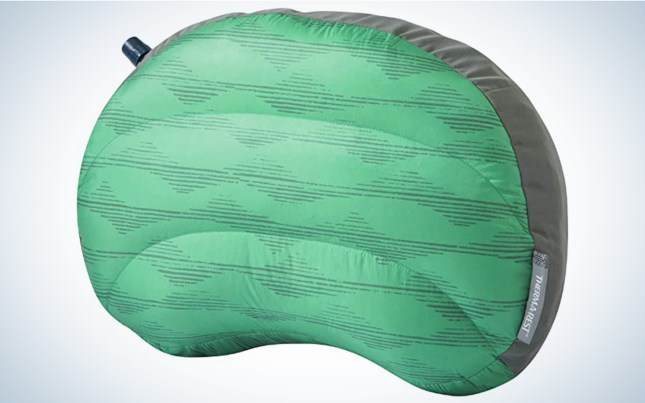
Therm-a-Rest Air Head Down Pillow
Best memory foam.
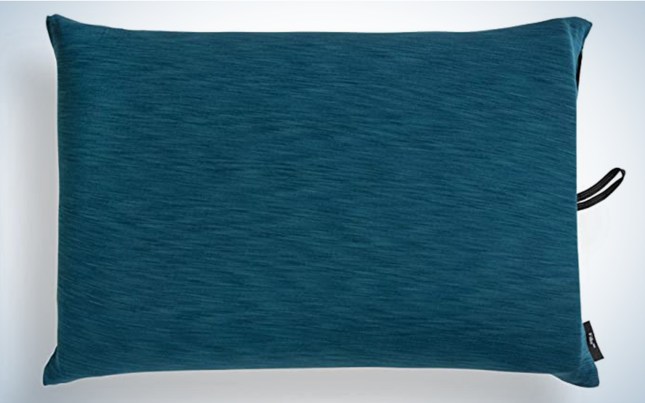
NEMO Fillo Backpacking u0026 Camping Pillow
Best lightweight.
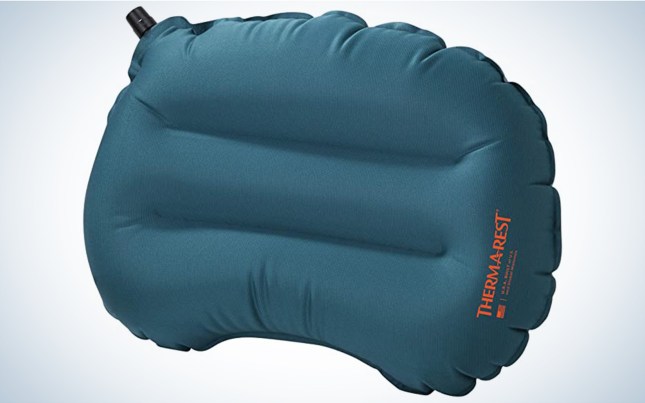
Therm-a-Rest Air Head Lite Pillow
We may earn revenue from the products available on this page and participate in affiliate programs. Learn More ›
If you peek into the pack of a seasoned long-distance hiker, there is one item that might surprise you: a backpacking pillow. Why, if you’re aiming for a sub-10-pound base weight, would they carry a luxury item like a pillow? I spent hundreds of nights sleeping outdoors with my puffer jacket balled up underneath my head before I started consistently sleeping through the night with a backpacking pillow. After testing out a number of the top options available, here are my picks for the best backpacking pillows:
Best Overall: Therm-a-Rest Air Head Down Pillow
Best memory foam: nemo fillo backpacking & camping pillow, best oversize: sea to summit aeros down pillow, best lightweight: therm-a-rest air head lite pillow, best budget: outdoor vitals ultralight stretch pillow, best pillowcase: rumpl stuffable pillowcase.
Why It Made the Cut The Air Head Down Pillow has the best balance of comfort, warmth, and weight out of everything I tried.
Key Features
- Weight: 4.9 ounces
- Size: 15.5 inches x 11 inches
- Packed size: 5 inches x 4 inches
- Height: 4 inches
- Lightweight
- Retains some warmth overnight
- Mid-height will work with most people
- Less comfortable fabric than other deluxe pillows
Product Description One of the biggest complaints people have about the air-only backpacking pillows is that they can be very cold. After a midnight bathroom break, it can be disconcerting to climb into one of the best sleeping bags and feel the cold polyester shell of an ultralightweight backpacking pillow.
The Thermarest Air Head Down Pillow uses a smidge of 650-fill power duck down, concentrated on one side of the pillow, to fix this problem. Down, the feathers found closest to the skin of ducks and geese retain warm air in small pockets created by the many barbules along the short shaft of the feather. In addition to adding warmth, they also add a bit of cushion. Despite the down, the size and shape of this pillow is similar to other ultralight designs, saving on weight. My only complaint is that the fabric on the side with the down wasn’t as smooth or comfortable as that used on other high-end backpacking pillows.
Why It Made the Cut If you prefer a stiffer, taller pillow that still cushions and conforms to the shape of your head, then the NEMO Fillo is the right choice for you.
- Weight: 9.2 ounces
- Size: 17 inches x 11 inches
- Packed size: 6 inches x 4 inches
- Height: 4 inches
- Integrated stuff sack is easier to find in the morning
- Comfortable fabric on the pillow side
- Stiffer than classic memory foam pillows
- Valve is slightly more complicated to use
Product Description Of all the pillows I tested, this is the one I have the most mixed feelings on. Its comparatively bulky packed size and significant weight addition raised my eyebrows, but when I put my head down, it was far and away the closest to the memory foam pillow I used at home. The knit fabric against my face was also comfortable for my skin, unlike some of the clammy polyesters and nylons used by the ultralight set. Not bad for just over half a pound.
The problem was when I woke up in the middle of the night with a stiff neck—I deflated the pillow some to try to create some “give,” to minimal effect. When I gave the NEMO Fillo to fellow campers to try, reviews were mixed—some found it incredibly comfortable throughout the night; others had the same experience that I did. I recommend having another individual check your neck alignment when lying down to ensure it isn’t at an angle before committing to a purchase.

Best Oversize
Sea to summit aeros down pillow.
Why It Made the Cut The Aeros Down is nearly as big as a standard bed pillow for only a couple of ounces more than my best overall pick.
- Weight: 6.7 ounces
- Size: 23 inches x 15 inches
- Packed size: 6 inches x 3.5 inches
- Height: 4.7 inches
- Closest to a standard bed pillow of anything in my test
- Down adds both cushion and warmth
- May be too tall for some individuals
Product Description Like my best overall pick, the Sea to Summit Aeros Down Pillow uses a layer of down to add both warmth and a bit of cushion. Unlike my best overall pick, the Sea to Summit Aeros Down Pillow is huge—easily one of the widest in my test. If you are the kind of person who tosses and turns at night, waking up to find your pillow anywhere other than under your head, this could be the solution you have been looking for. That goes double if you tend to stack two pillows on top of each other at home, as the 4.7-inch height of this pillow is fairly significant.
Why It Made the Cut This 2-ounce pillow packs up small and uses a knit polyester that is comfortable to the touch.
- Weight: 2 ounces
- Packed size: 4 inches x 3 inches
- Less expensive than more high-end options
- Low profile
- Not as comfortable as pillows that use down or memory foam
Product Description This is the classic backpacking pillow—lightweight, low profile, and filled with nothing but air. It’s far from the most comfortable pillow I tested, but it would be my first choice for a longer backpacking trip, where I expect to spend most of the day on my feet, and I’m so exhausted that I’m asleep by 9. On those days, I’m a lot less likely to appreciate the creature comforts of a down or memory foam pillow anyway.
Something I liked about the Air Head Lite is that it is one of the slimmer models (4 inches) I looked at, and it had a flat profile. Other pillows I tried, such as the EXPED Ultra Pillow, are thicker at the base of the pillow—to support your neck—but this can be distracting, and I find my head tends to slide off or rest at an uncomfortable angle (more often than not I just swap the side I’m sleeping on and use only half the pillow). The streamlined profile of the Therm-a-Rest Air Head Lite Pillow means that it will be comfortable for the widest range of people.
Best Budget
Outdoor vitals ultralight stretch pillow.
Why It Made the Cut This budget backpacking pillow is only a hair heavier than other top lightweight pillows, while coming in at a significantly reduced price.
- Weight: 3.1 ounces (as measured)
- Size: 16 inches x 10 inches
- Packed size: 4.5 inches x 3.5 inches
- Inexpensive
- Packs down small
- Neck support may be uncomfortable for some individuals
- Not quite as lightweight as similar models I looked at
Product Description This pillow, while not as comfortable as the other picks on this list, gets the job at a significantly reduced price. If you’re curious to see how a backpacking pillow can improve your sleep but wary about the price point of the higher-end models, then the Outdoor Vitals Ultralight Stretch Pillow is a good place to start.
Unlike the other backpacking pillows I looked at, this one was slightly higher at the bottom of the pillow than it was at the top, with a slight depression in the middle. Some people enjoy the neck support this type of design provides, but it can be uncomfortable for others.
Best Pillowcase
Rumpl stuffable pillowcase.
Why It Made the Cut The soft fleece side of this pillowcase felt great to the skin on cold nights. The adjustable height is best suited for stomach sleepers.
- Weight: 3.2 ounces
- Size: 16 inches x 11 inches
- Packed size: 6.5 inches x 3.5 inches
- Height: Not applicable
- Height of the pillow can be adjusted
- Small packed size
- On cold nights, you’ll have to decide between your puffer jacket and having a pillow
Product Description I’ll admit that I didn’t get to test the Rumpl Stuffable Pillowcase as much as I wanted because the second my three-year-old tried it, she claimed full ownership. But I see her point: the fleece-lined side was significantly nicer to the touch than the cold nylon or polyester of the other models I tested (even if these did warm up quick enough), and she could choose the exact height that the pillow would be when she laid down on one of the best backpacking sleeping pads . In her case, the puffer coat was much too tall, but a single long sleeve shirt gave her just the height she needed.
Things to Consider Before Buying Backpacking Pillows
Weight Backpacking pillows can vary in weight considerably, from two ounces to over half a pound. Your goal when choosing a backpacking pillow is to pick the option that optimizes your sleep without overly weighing down your backpack.
Packed Size While there are a number of high-quality foam pillows built for the outdoors, few pack down as small as the NEMO Fillo, making them a no-go for backpackers.
Insulation The smallest backpacking pillows are simple inflatables. While this helps to keep the cost, packed size, and weight down, these pillows do not retain much (if any) heat. While this can be offset by a sleeping pad with a higher R rating, light sleepers may find that shifting to a cold part of the pillow causes them to wake up more often than they would like.
Height The reason that a pillow can help to improve your sleep is that it helps to keep your neck at an even angle, something known as neutral alignment. The right height varies by person, but you can get a sense of your natural preference by looking at the height and number of pillows you currently use at home.
Methodology
I tested backpacking pillows on a series of summer overnights and shared them with the people I was camping and backpacking with in addition to using them myself. I looked at how comfortable the pillow was, whether it was clammy or soft to the touch when I first laid my head on it, and if I woke up in the middle of the night for any reason (neck pain, pillow shifted, etc.) While everyone agreed that a pillow—any pillow—was better than balling up one of the best puffer coats , not everyone agreed on which pillow was the most comfortable—or even comfortable at all. If you have the option to test out a number of pillows before making a purchase (such as at an outdoor retailer), that will help you make the right choice for yourself.
In addition to field testing the backpacking pillows, I also considered their price, packed size, and weight—all important considerations for backpackers.
Yes, they are worth it.
If you’re balling up your puffer coat to serve as a “pillow” in the backcountry, that’s the first sign that you need to get a real backpacking pillow. The next time you’re out, count the number of times you wake up in the middle of the night and adjust the jacket so that it’s still comfortable under your head. If the answer is more than “I never woke up” then you should strongly consider getting a backpacking pillow.
If you consistently sleep on your stomach, it’s possible that you won’t benefit from a backpacking pillow. One way to determine if this is the case for you is to swap out your regular pillow at home for something low profile or ditch it all together—if you sleep soundly through the night without it, then you can probably skip the pillow in the future.
Final Thoughts
After looking at a number of backpacking pillows, the Therm-a-Rest Air Head Down Pillow is the best balance of comfort and weight, while the two-ounce Air Head Lite is ideal for gram counters. Those looking for even more comfort appreciate the wide profile of the Sea to Summit Aeros Down Pillow or the memory-foam NEMO Fillo.
The Best Camping Pillows of 2023

It’s a common misconception that camping is equivalent to roughing it. Gone are the days of wadding up your down jacket and turning it into a makeshift pillow while you try to get a few winks. The truth is, sleeping in the great outdoors is just as comfortable as you make it. Nowadays, there are camping pillows for campers of every stripe.
Developers have been putting in some serious zzz ’s when it comes to putting together the best camping pillow, and it shows. You’ve got everything from heavy, ultra-plush pillows for car campers to ultralight inflatable ones for backpackers. There are even pillow options for side sleepers. We took a good, hard look at some good, soft pillows, and we found the best pillows for camping and backpacking on the market.
We highly recommend scrolling through our list and checking out all the pillows. Also, take a look at our camping pillow buyer’s guide , comparison chart , and camping pillow FAQ at the end of this article if you need some more help deciding. However, if you’re looking for something specific, you can jump to it right here:
- Best Overall: Therm-a-Rest Compressible Pillow
- Best Budget Pillow: Wise Owl Outfitters Camping Pillow
- Best Inflatable Camping Pillow: Sea to Summit Aeros Ultralight Pillow
- Best Budget Inflatable Pillow: Trekology ALUFT 2.0
- Best Camping Pillow for Side Sleepers: NEMO Fillo King
- Best Backpacking Pillow: Cocoon Sleeping Bag Hood Pillow
- Best Backpacking Ultralight Pillow: Zpacks Medium Pillow
- Best Down Insulated: Therm-a-Rest Air Head Down Pillow
Therm-a-Rest Compressible Pillow
- Materials Polyester, urethane foam scraps
- Weight 7-15 oz.
- Packed volume 2.6 L

- Incredibly soft
- Mimics the feel of a full-size pillow
- Takes time for the foam to fully expand
- Some users find it lumpy
A lightweight and compressible offering from Therm-a-Rest, the Compressible Pillow ($32-47) is the closest approximation to the pillow we sleep on at home. Filled with leftover pieces of the high-quality foam Therm-a-Rest uses in its sleeping pads, this pillow expands to a whopping 27 x 16.5 inches for the XL size.
The foam gives it a luxurious, fluffy feel, and provides a nice bit of insulation from any cold that comes up from the tent floor. The soft, recycled polyester fabric cover feels snuggly and warm against your face. When you’re not using it, the pillow packs into itself and compresses down to the size of a Nalgene bottle.
While not as light as some other pillows on this list (the XL weighs in at just under a pound), the comfort-to-weight ratio on this Compressible Pillow is on point. It’s light enough for backpacking, and it’s plush enough to leave your bed pillows at home during car camping. This perfect blend of versatility and comfort make this the best camping pillow on our list.
One thing to note: The foam takes a while to puff up, so be sure to unpack it and let it expand as soon as you set up camp.
Wise Owl Outfitters Camping Pillow
- Materials Micro-suede, memory foam
- Weight 9-13 oz.
- Packed volume 4.1-4.8 L

- Memory foam is soft, yet supportive
- Packed size is big
If you’re looking for wallet-friendly comfort, the Camping Pillow from Wise Owl Outfitters ($30-45) is the smart choice. This memory foam camping pillow sports a microsuede cover for a soft feel, and it expands out to 5 inches thick to keep your head cushioned all night.
The foam packs down into the included waterproof stuff sack, compressing down to 12 x 7 inches for the large pillow. We love the fact that it’s machine washable and can go in the dryer. This is a huge plus for excessive droolers (you know who you are) and for getting out that campfire smoke odor.
The only real issue we’ve had with the pillow is that it doesn’t pack down very small. A big part of this is the stuff sack, which doesn’t compress the pillow down as much as it could. If you go with this pack, consider buying a small compression bag to really pack the Wise Owl Camping Pillow down to size.
Sea to Summit Aeros Ultralight Pillow
- Type Inflatable
- Materials Polyester
- Weight 2.1-2.5 oz.
- Packed volume 0.4 L

- Compresses well
- Sticks to Sea to Summit sleep pads like glue
Made of a 20-denier stretch-knit polyester laminated on a TPU air bladder, the Aeros Ultralight pillow ($45-65) is contoured to provide secure comfort while you sleep.
The scalloped bottom secures the pillow to your shoulders to keep it in place whether you’re sleeping on your back, stomach, or side. It even works well when sleeping upright in a chair. This makes it a great choice for road trips or long flights.
One of our favorite details of this premium inflatable pillow is the three-way mini valve, which allows for rapid inflation and deflation. It also features a press-button release valve to let you fine-tune the pillow’s softness to your preference.
We also love Sea to Summit’s proprietary PillowLock system. This system works with Sea to Summit sleeping pads to stick to the pad and keep it in place while you sleep. When you pack it up, the pillow compresses into its stuff sack to about a third of the size of a water bottle, so you have no excuse to leave it at home.
The only thing we weren’t crazy about on the Aeros Ultralight was the price, which is on the high end. But for when ounces count, it’s easily a trade-off we’d be willing to make again.
Trekology ALUFT 2.0
- Materials Polyester, TPU
- Weight 3.4 oz.
- Packed volume 0.5 L

- Straps to keep the pillow in place
- Stuff sack is too small — it’s a pain to cram it in
The best inflatable pillow that we’ve seen for under $20, the ALUFT 2.0 from Trekology ($18) is perfect for ultralighters on a budget. The pillow is made of durable, water-resistant TPU fabric that’s just stretchy enough to provide some give when you lay your head on it.
Founded by a group of Ph.D. engineers in Portland, Ore., it’s clear that the designers put their degrees to good use. Details like tacky dots on the backside and elastic latches to hold it in place while you sleep are indicative of the thought that was put into its design. The contoured shape holds the head in place while you sleep, and the pillow only takes three to five breaths to completely inflate.
When it’s time to hit the trail, the pillow packs down to about the size of a soda can (though getting it into the stuff sack is another story — one of our gripes). In addition, the curved design and loft are ideal for side and stomach sleepers.
NEMO Fillo King
- Type Foam and inflatable
- Materials Polyester, open-cell foam
- Weight 14.1 oz.
- Packed volume 3.2 L

- Tons of loft
- Huge expanded size
- Integrated stuff sack
- Larger packed size than regular-size pillows
The king-size version of NEMO’s excellent Fillo camping pillow, the Fillo King ($75) offers 6 inches of loft, which provides great support for side sleepers. The first camp pillow that we’ve seen that incorporated recycled foam filling with an inflatable interior, the Fillo Series combines softness and support better than any other pillow we’ve used.
This mix is perfect for side sleepers, letting you inflate the pillow to just the right amount of loft to let you sleep on your side without cranking your head toward the ground. In addition, the polyester jersey outer feels great against your face and soaks up drool (not a listed benefit, but we’ve verified this during repeated tests).
The stuff sack is integrated into the pillow, sliding into a pocket on the bottom of the pillow. This is huge for those of us who’ve tossed the contents of our tents looking for our pillow’s tiny stuff sack, only to find it stuck to the bottom of our sleeping bag . The soft face fabric mimics your favorite pillowcase at home.
The Fillo King is great for camping, but its packing size and functionality make it ideal for road trips, long flights, and even for lumbar support on the road.
Cocoon Sleeping Bag Hood Pillow
- Type Inflatable and synthetic
- Materials Polyester/nylon shell, synthetic fill
- Weight 3.8 oz.
- Packed volume 0.6 L

- Tiny packed size
- Shape is ideal for mummy bags
- Nylon side sticks to face on sweaty nights
Going light on weight doesn’t mean sacrificing comfort. Cocoon’s Air-Core Hood Pillow ($30) weighs less than 4 ounces, packs down to 4 x 3 inches, and sports a soft microfiber face. Built specifically for use in the hood of a sleeping bag, the Hood Pillow’s contoured half-moon shape prevents any bunching up or movement when used inside a mummy bag.
The inflatable air core is bolstered underneath a thin layer of synthetic filling for added softness and warmth. The twist valve lets you dial in the firmness and make more room if you need to cinch the sleeping bag hood tighter on cold nights.
We love the reversible cover with microfiber on one side and nylon on the other. The microfiber provides added warmth on cold nights, and the cooling nylon side is built for summer camping, making it one of the more versatile ultralight inflatables on the market.
Zpacks Medium Pillow
- Type Stuff sack
- Materials Dyneema Composite Fabric, micro fleece
- Weight 1 oz.
- Packed volume Unavailable

- Lightest pillow available
- Doubles as a stuff sack
- Only as comfortable as what you pack inside it
If saving weight is your goal, the Medium Pillow from Zpacks ($50) is the only way to go. Instead of designing a traditional pillow, Zpacks took its dry sack and sewed soft microfleece to one side of the interior. Rather than bringing a separate pillow with you, this brilliant design saves weight by using the stuff you’ve already brought with you as cushioning.
You can use it as a regular stuff sack while you hike, as the taped seams will keep everything dry even if you take a dunk in the creek. When it’s time to bed down, turn the sack inside out, fill it with your clothes, and then seal it up and get some shut-eye. Remember that this pillow will only be as cozy as whatever you fill it with!
Packed size isn’t an issue, as you’ll be using it as a stuff sack, and at around an ounce, you won’t even notice this ultralight pillow in your pack. The only issue is if you run out of clean clothes — the idea of sleeping on a pile of week-old socks is less than appealing.
Therm-a-Rest Air Head Down Pillow
- Type Inflatable and insulated
- Materials Partially recycled polyester, urethane insert, down fill
- Weight 4.9 oz. (regular size)

- Very comfortable against skin
- Different sizes available
- Sleeping-bag-hood compatible
- More expensive
Therm-a-Rest’s Air Head Down Pillow ($63-73) is lightweight enough for extended backcountry missions, but soft and insulated enough to feel like a luxury. How? This iteration of the Therm-a-Rest Air Head pillow has a topper of down added underneath the polyester baffles on the outside of this inflatable pillow.
Aside from the insulation and comfort the down provides, the Air Head Down Pillow is also specifically designed to fit in the hood of a sleeping bag. We found the inflatable body to inflate and hold air well, in a whole variety of temps. And if you spend time camping or backpacking in any season outside of summer, you’ll be thankful to have a pillow like this when the temps drop.
Lastly, we love this pillow because it comes in two sizes — so you can pick the best one to fit your sleeping bag or general backpacking needs.
Comparison Chart
Why you should trust us.
The GearJunkie staff knows their way around a campsite, and we’ve brought together our collective experience here to find the best of the best camping pillows available today. In our search, we aimed to find and test pillows that every outdoors person across the spectrum could enjoy — from luxury-minded car campers to ounce-counting ultralight backpackers.
When we bedded down for testing, we paid close attention to a number of different factors, including overall comfort, durability, and packed size and weight (someone’s got to carry these pillows, after all). We’ve been testing camping pillows for a number of years, and while outdoor equipment won’t last forever, we’ve had good results in getting many seasons of use out of the options we’ve tried out so far.
Finally, the testing doesn’t stop here, and as new camping pillows hit the market we’ll be chucking them in our packs and continue testing, ensuring that our lineup is as fresh as can be.
Buyer’s Guide: How to Choose a Camping Pillow
Camping style, car camping.
Choosing the right pillow depends largely on how you usually camp. Specifically, do you sleep in your car, or do you hike out into the woods before you tuck in for the night?
Car campers can go the more luxurious route. Because you don’t have to carry the pillow around with you or fit it into a backpack, packed size and weight don’t matter.
Often, people will just bring along their everyday pillow to sleep on. But campfire smoke and the dirt and dust that come with living outdoors for a few weeks can leave your pillow smelly and dirty, rendering it unfit for use back home.
Car camping pillows are made up of materials that are durable and easily cleaned, so you can beat them up at a campsite without worrying about whether they’ll be usable when you get back home.
When choosing a car camping pillow, comfort is king. Go for a bigger pillow and one that uses foam filling.
Foam pillows like the Therm-a-Rest compressible pillow use foam cutaways from the brand’s sleeping pad construction. When unpacked, the foam puffs up and feels like a traditional feather pillow for a great night’s sleep.

Backpacking
Backpackers have a lot more to consider than car campers, as they’ll be carrying their pillows with them in the wild. Pack space and weight are an issue here, as you’ll be working with limited space in your pack and feeling every ounce with every step.
Inflatable pillows are a good option for backpackers because they pack down small and don’t weigh as much. The downside to inflatable pillows is that they provide little insulation from the ground, and they can make a crunching sound when you move on them (to go along with your inflatable sleeping pad). They also tend to be firmer than foam pillows.
We’ve found that a pillow that combines foam cushioning and an air core like NEMO’s Fillo is a great compromise between the two. Upcycled foam from the brand’s production process is used on the head side, and the core is inflatable for extra loft.
Side sleepers love the Fillo King’s extra loft. The lightest one we’ve found is a converted stuff sack from Zpacks. Backpackers have often used stuff sacks filled with clothes as makeshift pillows, and Zpacks took this a step further by lining the inside with a soft fleece material for added comfort.
It doesn’t matter how light a camping pillow is if it isn’t comfortable. Often, there is going to be a trade-off between comfort and lightness, but pillow companies are going to great lengths to minimize that compromise.
Some companies like Sea to Summit and Trekology have added contouring to their pillows, basically creating an inflatable hammock for the head. This lowers the chance of the pillow sliding around from underneath you.
It also helps to keep your head on the pillow if you tend to move around in your sleep. Other pillows feature straps or sticky material to prevent them from sliding around on your sleeping pad.
The style of the pillow is also worth considering. Foam-filled pillows are softer and replicate feather pillows better than inflatable ones, but the additional weight and space requirements can be an issue. We’re fans of pillows that combine the two, whether the cushioning is actual foam or a lightweight synthetic fill.
Cocoon’s Sleeping Bag Hood Pillow has a thin layer of synthetic fill over the air bladder for a soft feel at the head. One thing to note is that, when fully inflated, air pillows can feel too firm for some campers. Make sure to use the valve to fine-tune the softness of your pillow.
Face feel is another consideration, particularly for side and stomach sleepers. Most pillows feature a brushed polyester side for a softer touch.

Packed Size
If you’re car camping, packed size isn’t an issue, as you can stuff your pillow anywhere. For backpackers, how small your pillow packs down is a huge consideration.
Your backpack has limited space. Trying to fit everything you need into it can take a huge amount of creativity (and some serious Tetris skills). A tiny inflatable pillow can leave you more room for extra food, more layers, battery packs, or anything else you can think of bringing.
While often less comfortable than foam pillows, inflatable pillows tend to pack down to the smallest size. We’ve seen some that pack down to the size of an orange, which will leave plenty of room in your pack.
If you’ve got the room for it and you want a more comfortable option, a foam pillow usually packs down to the size of a Nalgene bottle . Smaller pillows can also fit into an exterior pocket or an extra water bottle pocket. This saves space in the pack’s main compartment.
If you’re really hurting for space, you can usually strap a pillow and any extra gear to the outside of your pack. The main issue with this is that it leaves the pillow at risk of snagging on a branch or rock. This can puncture a pillow’s air bladder and render it useless, so keeping it in the pack or a pocket is the preferred option.
Again, car campers don’t need to worry about weight. But backpackers need to count every ounce; every bit of weight added to the pack wears on their shoulders, backs, and knees.
When it comes to pillows, there has always been a trade-off between weight and comfort. Softer, fluffier foam pillows feel great when you go to bed, but the added weight can drag you down.
Inflatable pillows tend to feel firmer and are generally noisier than foam but can weigh half as much as foam pillows. When you’re looking for a lightweight backpacking pillow, look for one that weighs well under a pound.
Some of the best pillows we’ve seen have weighed 10 ounces or less without sacrificing much comfort. If you really want to save weight, the Medium Pillow from Zpacks is a great choice. It’s essentially a stuff sack with a soft interior.
If you turn it inside out and stuff it with clothes, it makes a great pillow. And at just an ounce, you’re not going to find a lighter option. Also, you’re using gear that you’d be bringing with you anyway, so you don’t have to save space for a pillow.
Generally, camping pillows are used inside the tent, so a decent pillow should last a while. With foam pillows, durability isn’t a huge issue, as they’ll work well even with a few small holes in the fabric. But it’s a huge issue with inflatable pillows; even a tiny pinprick could flatten it by the end of the night.
Even if you only use your pillow inside the tent, debris like pine needles and twigs can get into the tent. These little bits can eventually find their way to your pillow and find a way to puncture it in the middle of the night.
Look for inflatable pillows that are made up of durable material, like thermoplastic polyurethane (TPU), or one that comes with a more rugged cover. Valves can also be a weak point on an inflatable pillow. Make sure the one you buy has a tough, well-built valve that isn’t prone to leaking. And ask around — fellow campers and online reviews are your best resources for gauging a pillow’s durability over time.
With a little care, you can prolong the life of your camping pillow. Always store it in your stuff sack to add a protective layer, and don’t carry it on the outside of your pack. Passing branches can poke or tear holes in your pillow while you hike, so be sure to store it somewhere inside the pack, whether it’s the main compartment or in an exterior pocket.
We like to flatten our pillows out and roll them up in our sleeping bags. This serves not only to add an extra layer of protection but also to keep our sleeping gear together so we don’t have to search for the pillow when setting up camp.

In general, the more features a pillow has, the higher the price will be. Lighter, more compressible pillows tend to cost more than their heavier, bulkier counterparts. On the plus side, well-established companies like NEMO and Sea to Summit have spent more time developing their products, dialing down more durable and comfortable designs.
When you shop for a pillow, determine your must-have features, weigh them against your budget, and find a camping pillow that’s best for you. If you’re new to camping and still trying to figure out what kind of pillow you want, go for a good budget pillow. It’s a great way to test a pillow without making too big of an investment.
If that pillow doesn’t work, you can keep it as a spare and kick down a little extra cash for a pricier pillow. If the budget option works out well, enjoy the pillow and use the extra money to snag a nice mid-layer or a killer pair of socks.
Camping Tips & Tricks: Get a Good Night’s Sleep
Tent location.
We’ve spent enough evenings slowly sliding off our sleeping pads or waking up crammed into a corner of our tents to know the value of finding level ground, so pick your tent spot wisely. When you find your campsite, drop your pack and wander around the area a bit.
First, look for a spot on level ground. Not only is camping on angled ground uncomfortable, but it will also have you fighting to stay on your pad all night.
Once you’ve found the levelest spot, clear it of debris with your boot and pick up any rocks that can jab you in the back through your sleeping pad. Be diligent here — even a small rock can irritate your back.
The best-case scenario is a level patch of ground that’s covered in loam or pine needles that’ll act as a good, soft area. If you’re camping on bare ground, no worries. Just make sure that it’s level and clear of debris. A good sleeping pad will take care of the rest (pun intended).
Choose the Right Sleeping Pad
As your first defense against the cold, hard ground, a good sleeping pad is essential for a good night’s sleep.
Generally, the softest and cushiest sleeping pads are fully inflatable. Basically a huge rectangular balloon, inflatable sleeping pads will keep you completely off the ground and have the most mattress-like feel you can get when you camp. They’re also lighter and take up less pack space than foam pads.
There are a few trade-offs here. First off, inflatable sleeping pads are less durable than foam pads or combos. Any small prick in the pad can lead to a slow leak that will have you sleeping on the cold, hard ground all night.
Also, they’re notoriously noisy. Many campers report that it’s like sleeping on a bag of chips. If you’re a light sleeper and don’t want to sleep with earplugs, inflatable bags may be too loud for you.
They can also take a lot of time to set up, with several minutes of blowing into the valve.
That said, these still work great car camping and especially backpacking.
Closed-Cell Foam
On the other end of the spectrum is the closed-cell foam pad. This is a thin foam sleeping pad that folds up like an accordion or rolls up to save space. Due to their unique shape, they are also known as “egg crates.” If you ever see one, you’ll understand why.
Closed-cell foam pads are thin and light, but extremely durable and they provide consistent insulation. Because there’s no inflation involved, they are impervious to tears and punctures.
Some ultralighters will even cut down their foam pads to save weight. Also, they set up instantly — just lay them down, and you’re good to go. On the other hand, they don’t provide the cushioning of an inflatable, and they take up a lot of space.
You’ll often see them attached to the outside of a hiker’s pack. These are best for minimalist backpacking, and many campers will combine these with the other two to add a layer of insulation and pad protection.
Self-Inflating
Self-inflating sleeping pads are a compromise between the two. These are basically a closed-cell foam pad within an inflatable sleeping pad. They are quick to set up. And they provide a combination of the insulation you’ll find in closed-cell foam pads and the cushioning you’ll find in an inflatable pad.
They’re heavier and usually more expensive than foam pads and not as compact as inflatables. They are also susceptible to tears. Lightweight and durable, these are popular for thru-hiking. They’re also popular for winter camping trips thanks to their insulative properties.
Few things feel better than getting warm and cozy in a sleeping bag on a cool night. So, be sure to get a sleeping bag that’s designed for the environment you’ll be camping in.
Sleeping bags come with a designated temperature rating. You can easily pick the right one for whatever location and season you decide to camp in.
If you tend to camp in cold weather, find a sleeping bag with a rating geared for colder temps. This also applies if you tend to sleep cold. Often, these will have venting options that let warm air out if you get too hot in your sleep.
Another option is to go to sleep with your socks and mid-layers on, and then slowly de-layer while you sleep. One tester who does this says a pile of warm clothes stuffed in the toebox “keeps my feet warm.”
Keep the Essentials at Hand
It’s a lot easier to get a good night’s sleep when you know where everything is. When you head to bed, make sure everything you need is close by and easy to find.
Store your headlamp by your head, preferably in your tent’s storage netting. That way, you can grab it when nature calls or if you hear something outside your tent that requires investigation.
Many tents have elastic mesh nets stitched into the inside. This helps organize smaller items in your tent like the aforementioned headlamp, multitool, spare socks, and anything else that will fit.
Also, store your boots just inside your tent’s entryway, or just outside it. That way, you can slip them on when you wander outside to make coffee. Ideally, your tent will have a vestibule so you can keep them outside without exposure to any potential rainfall.
Be Prepared
Getting wet in the middle of the night is a great way to ruin a restful evening. One common way to soak your sleeping bag is to get caught in a rainstorm without a rainfly. Another is to let condensation accumulate on the tent’s inner walls.
Rain is an easy fix. If there’s any chance of rain while you’re camping, set up your tent’s rainfly. Make sure that it’s cinched down to prevent the wind from blowing it away.
Condensation can be more difficult to deal with. However, a little care can go a long way in preventing moisture from building up inside your tent.
First, make sure that any wet clothes are outside the tent. Hang them to dry on lines or lay them out to dry during the night. Also, roll back your rainfly or leave your vestibule door open. The openings allow humid air and your exhalations to vent outside the tent.
Absolutely. Camping pillows add a bit of comfort and help you get a better night’s sleep than a pile of clothes or a wadded-up jacket. The minimal investment of money, pack space, and weight is nothing compared to the comfort a pillow provides. It only takes one night of trying to sleep without one to realize the value that a good camp pillow provides.
Few things are more annoying to a camper than trying to keep your pillow on your sleeping pad. Waking up with your head on the ground and blindly groping around in the dark for a missing pillow is a great way to ruin your sleep at 1 a.m.
Thankfully, many camping pillows have features to prevent this. Some pillows are made with a contoured shape to mold to your head. Others have scalloped “wings” that help conform the pillow to your head and shoulders. This prevents it from squeezing out from under you while you sleep.
Some have texture on one side to increase friction and prevent sliding. This texturing often comes in the form of small rubber dots that add a bit of stickiness to help keep it on the pad. While it can help a bit, sleepers who tend to move around can still easily knock the pillow off the pad.
Some pillows include a more secure feature made up of elastic straps on the bottom of the pillow. The straps wrap around the sleeping pad to hold it in place.
Others still are made to pair specifically with sleeping pads in the same brand. Often, these pads and pillows are designed to nest within a sleeve on the sleeping pad. In some cases, the pillows have hook-and-loop fasteners that are paired with similar fasteners on the pads.
Odors like campfire smoke and head funk can build up over time, eventually ruining a good night’s sleep. Be cautious when washing your camp pillow. Different pillows have different requirements when it comes to cleaning. Be sure to check your pillow’s packaging.
You may luck out and have a pillow you can toss in the washer and dryer when you get home. Others can be machine-washed but require hang-drying, so read carefully.
Most pillows require a bit more delicacy, particularly inflatable pillows. If you’re handwashing an inflatable pillow, make sure the valve is closed so water doesn’t get inside, and then immerse the pillow in soapy water.
You don’t need any special soap for this. Camp soap or laundry soap will work fine. Knead the pillow gently with your hands until it’s clean. Then rinse it with clean water to get the soap out and hang it to dry. Be careful not to tumble-dry inflatable pillows, as it can damage the air bladder.
The best camping pillow depends quite a bit on your personal sleeping preferences. If you’re a side sleeper, a thicker foam pillow is the better option. However, it will likely be heavier and take up more pack space.
If you’re trying to save weight and pack space, an inflatable pillow is a good idea. If you’re not sure what you want, look for a versatile pillow like NEMO’s Fillo line . It combines an inflatable bladder with slight padding on the face side, providing a mix of softness and packability. They also feature bungee cords on the back. This lets you roll up some clothes and stow them in the bungees if you want more loft.
If you’re new to camping and don’t know exactly what you want, think about what’s important to you and how much you’re willing to spend.

Camping for Beginners: Essential Guide for First-Timers
Whether you’re taking the kids out for a weekend in nature or looking for a solo escape from the city, we’ve got the complete guide to camping for beginners right here.

The Best Thermoses of 2024
If you want your favorite liquids to stay hot all day, check out our roundup of the best thermoses of 2024. Get ready to warm up with a hot drink.
Follow Us On
Subscribe Now
Get adventure news and gear reviews in your inbox!
Join Our GearJunkie Newsletter
Gear Top Stories Deals

10 Best Backpacking Pillows For The Rugged Outdoors

- Very comfortable
- Mimics the feel of at-home pillows
- Compresses down to the size of a Nalgene
- Good price point
- Takes a while for the compressible foam to expand
- Not as light as others
The Therm-A-Rest Compressible Pillow hits all the right notes for a backpacking pillow. The pillow is my overall top pick because of its packability, ultimate comfort, value, and insulation.
Due to the Therm-A-Rest Compressible Pillow’s foam design, it’s best to let the pillow expand. This process can take a few minutes. The inflation time for the upcycled foam (scraps of reused mattress foam) is annoying but otherwise not a big deal.
If you’re backpacking and want to splurge on one item, let it be this pillow.

Backpacking and mountaineering are tough outdoor activities that require a rested body and a sharp mind. Not only can poor sleep lead to physical pain, but it can also increase brain fog. Being tired can lead to questionable decisions in the backcountry that dramatically increase your risk for injury.
With the right backpacking pillow, you can wake up feeling refreshed and ready for all the challenges ahead. A good pillow will also help you avoid neck and back pain. In this guide, I’ll review the 10 best backpacking pillows so you can sleep well under the stars.
My Review Process
I’ve spent the last two decades mountaineering and backpacking in a variety of places. I’ve found that some items are worth carrying just to make the outdoors more comfortable.
Having a backpacking pillow can save you from losing sleep or waking up with aches and pains. I’ve tried out dozens of backcountry pillows and I’m here to help you find one that will leave you rested and recharged on your next adventure. The features I look for are ones that are packable, light yet comfortable, and easy to clean. You can learn more about this in the buying guide section below.

Therm-a-Rest Compressible Pillow
Best overall pillow, wise owl pillow, best budget pick.
- Inexpensive
- Comfortable
- Washer/dryer safe
- Included stuff sack doesn’t compress well
The Wise Owl Pillow is a great choice for backpackers and is my go-to budget pillow. This comfortable camping pillow is not only inexpensive but also large and machine washable. The amount of support and comfort you get from the memory foam is surprising, considering its low price.
The trade-off is an underwhelming carrying case and the general bulkiness of the pillow. A stuff sack is included, but it doesn't really compress the pillow that much. It may be worth buying a compression sack to fold down the pillow more. Still, at such a low price point, this comfortable camping pillow is a great choice for backpackers.
Nemo Fillo Elite
Best pillow for backpacking.
- Lightweight
- Removable cover
- Not as soft as other options
- Minimal insulation
The small Nemo Fillo Elite is one of the lightest pillows out there and perfect for extended trips through the outdoors. This firm pillow is surprisingly supportive, packs down well, and has a removable pillowcase that you can machine wash.
Due to the Nemo Fillo Elite's supportive and firm feel, it isn’t the softest pillow out there. It also doesn’t provide much insulation from the ground.
Still, this pillow works well in most conditions. If you’re worried about space and weight, the lightweight Nemo Fillo Elite is a great camping pillow candidate.
Sea to Summit Aeros Pillow
Best pillow for mountaineering.

- Rapid inflation/deflation valve
- Packs down small
- Enough height for side sleepers
- Not as comfortable as others
The Sea to Summit Aeros Pillow is a great mountaineering pillow that I’ve used many times. The ergonomic shape cradles your head whether you're a side sleeper, back sleeper, or stomach sleeper. The pillow packs down to a third the size of a Nalgene water bottle and has an air pressure inflation valve, which rapidly fills up the air bladder.
While the Sea to Summit Aeros is a great supportive pillow, it isn’t as soft as other options. The firmness of the pillow may be an issue for lighter sleepers. There isn’t much insulation, so if you're mountaineering in snowy climates, you may want to wear a beanie while sleeping. However, this pillow’s utility, support, and ease of use make it perfect for mountaineering.
Best Pillow for Hiking

- Great support
- Machine washable exterior
- Good travel pillow
If you’re looking for a hybrid pillow to accompany you on day hikes or casual camping trips, the NEMO Fillo is my top pick. The NEMO Fillo is a comfortable hybrid pillow option that provides excellent support. It also comes with a removable pillowcase that's machine washable.
Unfortunately, the NEMO Fillo is a heavier camping pillow and won’t be the best choice for extended backpacking trips. I recommend using this one on day hikes where weight isn’t a huge concern. You can lounge around on the summit or near a stunning lake in comfort.
Therm-a-rest Air Head Down
Best pillow for side sleepers.

- Soft surface
- Ergonomic shape for side-sleepers
- A little heavier
Side sleepers need a pillow with extra loft and enough shape to keep their spine in alignment. As a side-sleeper myself, I love the Therm-A-Rest Air Head Down. The pillow is comfortable, has lots of loft, a soft surface, a non-slip bottom, and an ergonomic shape.
This pillow is a bit pricey, in part because it’s made with down feathers. It’s also a little heavier than some ultralight options. However, if you can manage a little extra weight and heft, this is a stellar backpacking and mountaineering pillow. You can also pack it down well due to its inflatable design.
ZPacks Medium Dry Bag Pillow
Best ultralight pillow.

- Utilitarian
- Microfleece face fabric
- Weighs 1 ounce
- Comfort is dependent on the clothes you bring
If pillow weight is your biggest concern, take a look at ultralight backpacking pillows like the ZPacks Medium Dry Bag Pillow. This pillow only weighs one ounce and is my favorite ultralight pillow. It's a fantastic, utilitarian purchase.
The Dry Bag Pillow doesn’t inflate. Instead, you stuff the bag with your clothes and lay on the microfleece outer cover for maximum comfort.
The level of comfort this pillow provides depends on what clothes you bring with you. Lumpy or balled-up clothes will create a lumpy surface on the pillow. A puffy jacket is a great stuff sack item for comfort. This isn't the fanciest backpacking pillow, but it weighs next to nothing. For many weight-conscious backpackers, that’s reason enough to try it.
Hyperlite Mountain Gear Stuff Sack
Best stuff sack pillow.

- Water-resistant
- Multi-purpose
- Comfort is dependent on the clothing you bring
- Less supportive
The Hyperlight Mountain Gear Stuff Sack pillow is my favorite stuff sack pillow. This ultralight backpacking pillow is water resistant, compact, comfortable, and great for ultralight backpackers. When you’re not using the Hyperlite Mountain Gear Stuff Sack as a pillow, the water resistance makes it a great bag for a bear hang .
This is a less supportive makeshift pillow than others I’ve tried, and how comfortable it is, depends on what clothing you bring with you. Still, the pillow’s ultralight weight and practical design make the Hyperlight Mountain Gear Stuff Sack a winning choice.
Sea to Summit Aeros Premium Pillow
Best inflatable pillow.

- Packs down well
- Not as soft as other pillows
In my opinion, the Sea to Summit Aeros Premium Pillow is a fantastic lightweight backpacking pillow and the best inflatable pillow available today. It's a great firm pillow for ultralight backpackers, and deflating the air bladder allows it to pack down well. The Sea to Summit Aeros Premium is also highly supportive.
Like the regular Aeros, this lightweight backpacking pillow isn't as soft as some might prefer. The lack of insulation can also be a big factor for cold weather camping. Still, if you’re looking for a packable, supportive, and reasonably priced inflatable pillow for backpacking, the Aeros Premium is a solid option.
HEST Pillow
Most comfortable pillow.

- Exceptional comfort
- Machine washable
The HEST Pillow is one of the most comfortable backpacking pillows out there. The HEST Pillow's construction uses quality materials, and the pillow is thick enough to support side sleepers. The soft surface feels great on your face, and the warmth of the HEST Pillow also sets it apart from more spartan options.
The HEST Pillow is a luxury pillow, so it doesn't pack down much and can be quite bulky. It’s also one of the most expensive backpacking pillow options. If you’re willing to pay a premium for exceptional comfort, the HEST Pillow is an excellent choice.
Backpacking Pillow Buying Guide
There are a few important things to keep in mind when deciding which pillow will give you the best night’s sleep in the backcountry.
You can find great backpacking pillows for cheap, but budget options usually sacrifice something to keep prices down. A budget option may not be as supportive, packable, or comfortable as more expensive pillows.
If you have camped before and don’t have trouble sleeping, a budget option should suffice. If you’re new to sleeping outdoors, a comfortable camping pillow that cradles you into sleep is an excellent choice that's worth the extra money.
Pillow Type
Not all outdoor pillows are built the same. Inflatable pillows like the Sea to Summit Aeros rely on air or an inflation valve to puff up an inflatable bladder.
Stuff sack pillows are makeshift pillow covers that you stuff extra clothes into to create the pillow. These are the most efficient solutions in terms of weight, but they rely on whatever clothing you bring to make them comfortable.
A compressible pillow is made of compressible materials like upcycled foam. The foam expands when the pillow is unfurled from its stuff sack. The compressible materials offer support, but the foam may need extra time to reach its maximum inflated size.
Lastly, there are hybrid pillows that use a combination of components. This combination is usually an inflatable bladder topped with foam or down insulation. The NEMO Fillo is a good example of a hybrid pillow.
Weight is one of the top considerations for any mountaineering or backpacking trip. Unlike a car camping pillow, backpacking pillows need to be relatively lightweight. Any extra weight can slow you down on the trail or leave your back aching at the end of a big day.
For extended trips or larger mountaineering objectives, things can get heavy quickly. The good news is that there are quite a few ultralight pillows to choose from on trips where weight is a concern.
Packed Size
Space is another prime consideration. Packed size refers to how much space the pillow takes up when it's not in use. The packed size for a stuff sack will always be the smallest since it's just a cover.
Luxury pillows pack down to about the size of a Nalgene bottle. While small, when you have a tightly packed backpack, it may not be small enough. More ultralight options may be about the size of your fist, so they hardly take up any pack space at all.
Washing Care
Pillows naturally attract oil and dirt from your skin. Some pillows can be washed, but only by hand. The machine washable varieties are much easier to manage. If you’re having trouble finding a pillow that’s machine washable, a nice compromise is a removable cover that is machine washable.
Sleeping Style
Different sleeping styles demand different types of pillows. If you sleep on your back, you need a softer, lower-profile pillow that cradles your head and keeps your spine aligned throughout the night.
If you’re a side-sleeper, you’ll probably want a firm pillow with lots of support and loft. With a supportive pillow, your spine is more aligned with your head and neck. Stomach sleepers need a thinner, softer pillow that allows them to turn their heads and still be able to breathe.
Ultralight camping pillows may weigh next to nothing but will often make a lot of noise because of the crinkly materials inside them.
If you’re a heavy sleeper, this may not be an issue, but light sleepers won't enjoy sleeping on crinkly materials. If you’re a light sleeper, opt for backpacking pillow options that are softer and quieter, or make sure to bring some earplugs.
Some pillows for backpacking are insulated, and some aren’t. Insulated pillows use synthetic insulation or down feathers to keep your head warm overnight.
Non-insulated pillows are great for warm summer nights. Insulation can matter a lot in the alpine or in an environment with wild temperature swings.
Soft Fabrics
Some pillows save weight by reducing the materials they're made of. This usually comes at the expense of comfort. If you like sleeping on soft and warm surfaces, make sure the pillow you're eyeing has soft face fabrics. Soft fabrics can help you fall asleep faster and prevent skin irritation.
If you want an outdoor pillow that ranks highly across the board, the Therm-A-Rest Compressible Pillow and the NEMO Fillo Elite are both excellent choices. People who prefer inflatable pillows should check out the Sea to Summit Aeros and Sea to Summit Aeros Premium . For budget shoppers, check out the Wise Owl Pillow .
Ultralight adventurers should check out the ZPack Medium Dry Bag Pillow or the Hyperlite Mountain Gear Stuff Sack . If comfort is the biggest concern, opt for the luxurious HEST Pillow . For day hikers and people interested in a casual camping pillow, the NEMO Fillo is a superb choice.
Common questions

I’m happiest on long backpacking trips into little-known pockets of wilderness, skiing down backcountry mountains, and on all-fours, scrambling the rocky spines of alpine ridges. When I'm not adventuring in the outdoors, I'm most likely writing about them.
*The information on this site is based on research and first-hand experience but should not be treated as medical advice. Before beginning any new activity, we recommend consulting with a physician, nutritionist or other relevant professional healthcare provider.

10 Best Hiking Pants For Every Hiker

8 Best Ski Knee Braces For Extra Support On The Slopes

9 Best Ski Helmet Headphones For 2024

Crampons vs Microspikes - Which Do You Need for Mountaineering?

Best Travel Pillows
We evaluated travel pillows from Cabeau, Trtl, NapFun, and more to see which would provide the best support during a long trip
Heavy is the head that needs to go through a 10-hour flight.
By Pang-Chieh Ho
I inherited many things from my mom. A stiff neck, unfortunately, is one of them. Traveling can be a challenge for both of us, as well as others who are prone to neck stiffness and pain . Like me, you might spend several hours cramped in an airplane or train seat and wake up feeling the strain in your neck after sleeping for a long time in an odd position.
When we are in an unsupported position, we tend to protrude our heads forward, so a travel pillow can help alleviate potential neck pain or stiffness if it provides support in the right places and keeps the spine in a neutral position, says Jim Edwards, the rehabilitation manager at Cleveland Clinic Rehabilitation and Sports Therapy.
For the past 20 years, my mom has carried an inflatable pillow whenever she travels to help her sleep. As someone who loves to have that extra neck support but loathes adding any more bulk to my carry-on, I’m endlessly intrigued by the product. I see them everywhere on planes and at airports, and I always think: Is that one as comfortable as it looks? And is the support the pillow offers worth the sacrifice I have to make in carry-on space?
Summer will be upon us soon, and people might ask the same questions as me before purchasing a neck pillow for their travels. To find out which are worth the investment, two evaluators and I, who travel frequently, tried out seven different pillows from popular brands.
We judged them on criteria including how supportive they were, how comfortable they were to wear, how easy they were to use, and how portable they were. We tried them at home in settings where we could simulate a middle-seat or window-seat position, and when we could, we took them with us and used them in our travels.
One quick note: Preferences for travel pillows can be subjective. A neck pillow that works well for one person might be less comfortable for another. With that in mind, here are some of our favorites.
Never judge a pillow by its appearance. I was skeptical about this one at first because of its unusual shape, but I’m so glad I was proved wrong.
The first thing I want to address is the hurdle I have faced with other inflatable pillows in the past. I’ve never been able to inflate anything in my life before—not a pillow, not a balloon. They always come out sad and deflated. So, before I tried this pillow, I expected inflating it to be another ordeal, with a lot of sound and fury signifying nothing.
The Manta Travel Pillow from Manta Sleep claims that it’s fast to inflate, and I can attest that it’s true. I was taken aback (in a good way) by how quickly the pillow inflated. No need for huffing and puffing. It was three breaths for me, and the job was done.
Most of us enjoyed the support that the pillow provided. As suggested by the manufacturer, there are many ways to use the pillow. For example, you can have the pillow cradle your head when you lean back or lock the pillow around your neck by attaching the clasps in the front. You can also fit the pillow in front of you so that your chin rests on it if your head bobs forward when you sleep. Or hug the pillow in front of you to give your neck support. ( Read more about the positions suggested by the manufacturer.)
“I thought the head and neck support was great when leaning in all directions in the ‘lock,’ ‘nod,’ and ‘cradle’ positions. The support was so stellar that it felt like my head didn’t weigh anything,” says Wendy Greenfield, CR’s copy chief, who flies abroad about twice a year.
The Manta Sleep Manta Travel Pillow was especially supportive when I tried it with my shoulders leaning against a wall, simulating a window-seat position. Maybe because of the height of the pillow, I felt it gave more support on the side than the other pillows we evaluated.
It gets a few points deducted because it might lose air over time, as was the experience of Anna Kocharian, one of our evaluators and a CR shopping editor. She used the pillow on a red-eye flight that was around 5 hours, and by the end of her flight, the pillow had deflated a fair amount. So, if you plan to use it for more extended travel, just know that you might have to re-inflate it.
The pillow’s microfleece cover feels comfortable, but it’s not very breathable. Because it’s inflated with air, it has less give than a memory foam or microbead pillow, which is softer.
On the pillow, there is a side pocket that the manufacturer suggests you use to store your earplugs, phone, or headphones. It’s handy, but the size of the pocket is better suited for earplugs or earbuds. When Greenfield tried to squeeze her iPhone 14 Pro Max into the pocket, only a third of the phone fit inside.
But if you don’t mind that rigidity and you’re looking for a supportive pillow that will enable you to travel light, the $29 Manta Sleep Manta Travel Pillow is the pillow to purchase. It’s lightweight and portable and provides a great deal of support. When it’s not inflated, you can fold the pillow into the travel pouch it comes with and fit it into your carry-on.
“This is the one I’m planning to buy for an upcoming long flight. One leg of my trip is 14½ hours, and I think this pillow will make a long time in that economy seat a little more tolerable,” Greenfield says.
If you prefer a travel pillow that offers soft, cushy support, the Cabeau Evolution S3 Neck Pillow could be the one for you.
The $40 memory foam pillow has raised sides near the jawline to prevent your head from bobbing left and right. There’s also an adjustable clasp in the front for you to modify how tightly you want the pillow to encircle your neck.
As someone whose head tends to flop to the side when I’m sleeping, I loved how snugly the pillow fit me when I adjusted the clasp to be the tightest it could be. That said, the pillow can feel hot after wearing it for a while.
Its fit also might not be for everyone. For Kocharian, the pillow felt too snug for her head. She had trouble keeping the pillow in place because it would either slide backward or rise up to her ears when she moved her shoulders.
Though this pillow is bulky and heavier than many of the other pillows we tried, you can roll it into the travel case that it comes with, which significantly reduces its size. However, the label in the case warns that you shouldn’t store the pillow inside for more than one month because the pillow might not return to its original shape afterward.
It’s a pillow that comes with a lot of convenient features. It’s the only pillow we evaluated that comes with seat straps you can attach to the headrest of your plane seat to help keep your head from bobbing forward. (The brand warns, however, that you shouldn’t use it on a car’s head restraint because it could interfere with the vehicle’s safety features.) There’s also a small storage compartment on the side of the pillow where you can store your earbuds or earplugs if you’d like.
On my recent trip to Europe, I took this pillow along with me in my carry-on bag. After trying it on flights that lasted for more than 7 hours, I’m happy to report that it helped me sleep more comfortably, and when I woke up, I experienced very little pain and stiffness.
The Cloudz Microbead Travel Pillow is a good budget pick that’s light, soft, and most supportive of the back of your head.
The surface of the pillow is comfortable to the touch. On one side, it’s a warm, cozy plush, and on the other side, it’s a cooler spandex for people who’re afraid of their necks getting too hot from travel pillows.
This pillow offers the strongest support for the back of your head, but it doesn’t provide as much support if your head is leaning to the side or drooping to the front.
While it might take up more space than an inflatable pillow, this microbead travel pillow is pretty lightweight, weighing only 5.5 ounces, according to my measurements. We purchased it for $16, and it was one of the least expensive pillows we evaluated.
Our evaluators were split on the support this pillow offered. Two of us felt that it didn’t offer much support, particularly when one’s head was leaning on the side, while one of us thought it did a decent job. “I appreciate the way it hugs my face and, in a way, conforms to the contours of my head and neck,” Kocharian says.
The memory foam pillow is comfortable, but its fabric doesn’t feel super-breathable. Like the Cabeau Evolution S3 Neck Pillow, it has a buckle in the front that allows you to adjust how tightly you want the pillow to fit your neck.
One drawback of the pillow is that it is bulkier and heavier than most pillows we evaluated. It’s close to the Cabeau Evolution S3 in size and slightly heavier at 3 pounds, 3.9 ounces. You can, however, roll it up and place it in a travel case that takes up less space, though from our experience it might not always be easy to stuff it perfectly into the case.
As a pillow, this one feels like the middle of the road for me. It’s nice, but it doesn’t leave a super big impression. It’s not the most snug and supportive compared with the Cabeau Evolution S3, which it’s close to in form, and it’s not lightweight enough to compete with other pillows that offer a similar level of support.
The Open Story Travel Neck Pillow is soft and comfortable to wear, though it offers limited support. It’s decent when your head is leaning back, but it’s not supportive enough on the sides or when your head is leaning forward, Greenfield says.
If you’re in a window seat, however, where your head is less likely to bob side to side or forward, you might want to consider it. When I tried it at home in a seat placement simulating a window seat, I felt that it provided a certain level of support to my neck that most of the other pillows didn’t.
As a microbead pillow, it’s bulkier than inflatable pillows, which can be adjusted in size. And unlike the two memory foam pillows we evaluated, the Cabeau Evolution S3 Neck Pillow and the Napfun Travel Pillow, it doesn’t come with a travel case that you can squeeze the pillow into. So if you’d like to travel with it, you’ll have to fit it into your carry-on or snap it around the carry-on’s handle.
One of its biggest draws is its price. At $13 at the time of purchase, it’s the least expensive pillow we tried. “For this price (and if I was in a pinch), it’s not a bad option! It’s not the most supportive neck pillow I’ve had, but it gets the job done,” Kocharian says. “However, for those who require more support for their head and neck, a more ergonomic alternative would be better.”
The Trtl Travel Pillow certainly stands out with its unique design. Unlike the U-shaped microbead or memory foam pillows, this one looks like a scarf. The supportive plastic frame inside the fabric has the contour of a neck. To use it, you extend the pillow, wrap it around your neck, and hold it in place with the fastening tape inside.
So is it supportive? Yes, but it has its flaws. While it’s easy to use and it does support your head and neck, it needs to be repositioned if you want to change the direction your head is leaning. It’s better for people who don’t move a lot when they’re sleeping because it can definitely get annoying having to reposition the pillow every time your head is leaning in a different direction.
It can also feel constricting at times. “The Velcro is very strong (for good reason), but a downside is that attempting to take the Trtl off wasn’t as seamless as with the others. I didn’t like the fact that I couldn’t easily move it around and felt claustrophobic at times,” Kocharian says.
The pillow, when placed at certain angles, can also feel uncomfortable. “The plastic support pushed too hard on my ear,” Greenfield says. “The discomfort to my ears was pretty close to actual pain.”
But size-wise, it’s less bulky than the microbead and memory pillows. It looks more like an article of clothing and not a full-blown pillow, Kocharian points out. “This means that when traveling, I can seamlessly slip it into my weekender without a second thought. Portability is a major plus for me, and the fact that this one is lightweight to boot is hard to beat,” she says.
And with a cost of $65 at the time of purchase—the most expensive of the pillows we evaluated—is it worth the price? The answer is eh, maybe . It depends on your sleeping habits. I wouldn’t mind bringing this along on a long flight because it’s portable, and I do like the support it gives. The one catch is that you have to accept the fact that its support is applicable only one position at a time.
Let’s start with the good things first. It’s portable and lightweight. In fact, it’s the lightest of all the pillows, weighing only 2.3 ounces, according to my measurements. It’s also fairly easy to inflate, though the process isn’t as smooth as with the Manta Sleep Manta Travel Pillow, the only other inflatable pillow in our evaluation.
The fabric, which is a fleece cover with a polyester underside, felt cooler than the material of the other pillows, which is a big plus if you’re afraid you’ll end up too hot while you’re sleeping.
When it comes to support, some of us enjoyed it. For Greenfield, it gave her support when her head leaned to the side and the front. The support was less apparent when she was leaning her head back.
But some of us felt that it was inadequate. For me, the support the pillow provided came dead last out of all the pillows we tried. The support it offered my head and neck when I tried leaning to one side felt slight to the point of being nonexistent.
“It can be useful in a pinch but not as a primary neck pillow for someone who requires serious or comfortable support. I would use it if I had it lying around, but despite its small size and portability, I wouldn’t go out of my way to purchase this product,” Kocharian says.
If your goal for a travel pillow is one that’s small and offers a little extra comfort, you might still like this pillow. But don’t expect this to offer much comfort and support on a long red-eye flight, Kocharian says.
How We Evaluated Travel Pillows
We evaluated all these travel pillows in settings at home that simulated a middle-seat and window-seat position. In the cases of a few, we also tried them out during our travels.
The pillows were judged on the following criteria:
Support: We tried leaning our heads forward, backward, and to the sides to mimic common sleeping positions on a plane, and gauged how well the pillow supported our neck and head.
Comfort: We looked at how comfortable the pillows were and whether the material was breathable.
Ease of usage: This covered how easy they were to use and adjust. For the inflatable pillows, we considered how easy they were to inflate. And for memory foam pillows, we judged how easy the pillows were to store in the travel cases.
Portability: The bulk and size of the pillows were taken into account, as was their weight.
Consumer Reports is an independent, nonprofit organization that works side by side with consumers to create a fairer, safer, and healthier world. CR does not endorse products or services, and does not accept advertising. Copyright © 2024, Consumer Reports, Inc.


- Destinations
- Travel Checklist
- Travel By Sea (Ferries)
Backpacking Russia (Ultimate Budget Travel Guide for 2024)
In this article, we are going to go through everything you need to know about backpacking Russia.
Russia is the largest country in the world, with a land area equivalent to 11% of the earth’s total landmass. Pretty impressive, right?
With stunning tundra landscapes, huge cities, stunning beaches and an array of wildlife, it’s truly an amazing place to visit.
Some of the most popular sights include the capital city of Moscow, St. Petersburg, Lake Baikal, Sochi, Kazan and the Ural Mountains.
Although often not depicted as a travel destination, Russia has so much to offer. It’s also a great place for backpackers as accommodation, food and transport is generally very cheap.
Russia is also the first country I ever backpacked, all the way back in 2007! I also returned three years later and backpacked my way from London to Lake Baikal in Siberia.
So let’s dive right into the article, and find out all the things you need to know before backpacking Russia.
Boring stuff: I have visited each of the places I recommend and give you my honest opinion, warts and all. All photos are my own unless otherwise stated and may not be reproduced without permission. Affiliate links may earn a commission at no extra cost to you.

Table of Contents
What regions make up Russia?
The Russian Federation is made up of eight districts. These are:
- Central – District Capital: Moscow
- North-Western – District Capital: St. Petersburg
- Volga – District Capital: Nizhny Novgorod
- North Caucasus – District Capital: Pyatigorsk
- Southern – District Capital: Rostov-on-Don
- Ural – District Capital: Yekaterinburg
- Siberian – District Capital: Novosibirsk
- Far-Eastern – District Capital: Vladivostok

Russia Highlights
Kaliningrad – a tiny Russian enclave on the Baltic Sea
Moscow – Red Square, St Basil’s Cathedral, the Kremlin, Lenin Mausoleum, Bolshoi Theatre…
St. Petersburg – the Hermitage , Church on the Spilt Blood, the Winter Palace…
Yekaterinburg – final resting place of the Romanovs and gateway to the Ural Mountains
Mount Elbrus – Europe’s highest mountain!
Lake Baikal – the world’s largest and deepest body of fresh water.
Vladivostok – the end of the line, Russia’s port city on the Pacific Ocean.
Kamchatka – the land of fire and ice, volcanoes and more bears than people.
The Trans-Siberian Railway – everyone should take this journey at least once in their life!
Suggested Russia Itineraries
1 week – Moscow and St. Petersburg
2 weeks – St. Petersburg – Moscow – Yekaterinburg
3 weeks – St. Petersburg – Moscow – Yekaterinburg – Rostov-on-Don
4 weeks – St. Petersburg – Moscow – Novosibirsk – Irkutsk – Lake Baikal (Trans-Siberian routes)
5 weeks – Moscow – Yekaterinburg – Novosibirsk – Baikal – Vladivostok (return by Trans-Siberian)
6 weeks – Moscow – Novosibirsk – Baikal – Yakutsk – Kamchatka
Daily budget for backpacking Russia

Depending on where you visit in Russia, the cost of accommodation, food and transport will vary. For example, the touristy areas of Moscow may be more expensive than the more rural areas of Russia.
On average you are looking at a daily budget of around ₽4,800 ($63). This will cover basic accommodation costs, food, and transport whilst backpacking Russia.
To help you stick to your budget, we have plenty of money-saving tips later on in the article!
Russia Visas
Citizens of 55 countries including Azerbaijan, Bolivia, Costa Rica, Israel, Laos, and the U.A.E can enter Russia visa-free for between 30-90 days depending on the agreement with that country.
If you are a citizen of Japan, the USA, the EU, the UK or a country in Asia or Africa you will have to apply for a visa. For some countries you can apply for a visa online, otherwise, you will have to go to your nearest Russian embassy or consulate.

Language in Russia
The Russian language uses the Cyrillic alphabet and it would pay to try and familiarise yourself with this a little before you go. All signage is in Cyrillic and English isn’t widely spoken, even in Moscow.
Getting to Russia
If you are travelling to Russia by flight, it’s likely you will arrive in Moscow as it has 3 large international airports; Sheremyetevo, Domodedovo and Vnukovo.
You may also choose to fly into Pulkovo airport, which is near St. Petersburg.
Trip.com has some of the best deals on flights to Russia.
Travelling into Russia by train is easy as the country has multiple high-speed rail connections with Europe.
Train routes run to Russia from Finland, Poland, France and Estonia. It’s also possible to go on other routes but it’s important to do your research as some require a transit visa.
Weekly routes to Moscow from the following countries. Check RealRussia for timetables and ticket prices.
Belarus: Minsk to Moscow – 8 hours
Estonia: Tallinn to St. Petersburg – 8 hours
Estonia: Tallinn to Moscow – 17 hours
Ukraine: Kiev to Moscow – 12 hours
Kazakhstan: Nur-Sultan (Astana) to Moscow – 40 hours
Mongolia: Ulaanbaatar to Moscow – 98 hours
China: Beijing to Moscow – 140 hours
You can travel to Russia by bus from Belarus, Estonia, Latvia, Finland, Poland, Germany and London. Although often not the most popular choice, it’s very cheap.
Ferries run to Russia from Japan, Korea, Turkey, Georgia and Ukraine.
It is possible to visit St. Petersburg visa-free by taking a cruise from Helsinki, Tallinn or Stockholm with St Peter Line. See their website for full details.

Getting around Russia
Russia is a HUGE country, but luckily there are a variety of transport options to help you get around.
Plane – There are over 200 airports within Russia, so when it comes to domestic flights there are plenty of choices.
Train – Travelling by train through Russia is one of the best options, as it’s a lot cheaper than catching a flight and is often more convenient.
Be aware that some stations have retained their Soviet names on timetables which can be a little confusing ( Yekaterinburg is shown as Sverdlovsk for example).
Metro – The metro system is located in 7 of Russia’s cities; these are Moscow, St. Petersburg, Kazan, Nizhny Novgorod, Novosibirsk, Samara and Yekaterinburg. It’s the best way to explore these cities.
City bus systems – The public transport systems in Russian cities are usually made up of buses, trolleybuses and trams. Travelling this way is cheap, and very convenient.
Long-distance bus services – There are plenty of long-distance bus services around and they are a great option whilst backpacking Russia.
The Trans Siberian Railway
There are three main routes:
- Trans-Siberian – Moscow to Vladivostok
- Trans-Mongolian – Moscow to Ulaanbaatar
- Trans-Manchurian – Moscow to Beijing
Unfortunately, at present there is no “hop-on, hop-off” service, so if you wish to visit places along the route, you must buy individual tickets for each leg of the journey.
Where to stay – Cheap accommodation in Russia’s most popular tourist spots

It’s inevitable that accommodation prices will vary depending on where you travel throughout Russia.
To give you an idea, I’ve come up with a list of the most popular spots in Russia and a cheap accommodation option for each one:
Moscow – Napoleon Hostel
St. Petersburg – The Roomers
Lake Baikal – Mini Gostinica near Lake Baikal
Belokurikha – Hotel Berkut
Sochi – Sochi Hotel
Kazan – Mironov’s House
Money in Russia
The currency in Russia is the Russian rubles (or rouble – RUB).
The exchange rate fluctuates but at the start of 2022, the average exchange rate is $1 = 75 RUB.
The important thing to remember about money in Russia is that It’s always best to exchange it in advance.
Cards are generally accepted in the country, but you’ll never know what the exchange rate is or if Russian banks will accept the card.
Also, a lot of things are paid for in cash in Russia including public transport and tipping so it’s always best to have cash on you.
Sample costs of items across the country*
The best places to visit in russia.

Here are the top places to visit whilst backpacking Russia. They have been split by district to make things easier for you!
The North-Western district
- St. Petersburg
- Veliky Ustug
- The Republic of Karelia
- The Pskov Region
Visitors to Russia should allow at least a couple of days to discover charming Saint Petersburg . Highlights include the Hermitage, Winter Palace, Church on the Spilt Blood and the canals.
St Petersburg really is a highlight of Russia, so if you’re planning a trip be sure to include it in your itinerary. Check out this excellent guide to the beautiful Russian Palaces in the city (the Winter Palace was a highlight of my trip back in 2007).
The Central district
- Sergiev Posad
No trip to Russia is complete without exploring the country’s impressive capital, Moscow . Allow at least three days to see the major sights including Red Square, the Kremlin, St. Basil’s Cathedral, the Lenin Mausoleum and more.
The Volga district
- Nizhny Novgorod
- The Republic of Tatarstan
- The Raifsky Bogoroditsky Monastery
The Volga region is one of the true heartlands of Russia and encompasses the Volga River basin and stretches down to the Caspian Sea.
The Southern district
- Rostov-on-Don
- Novocherkassk
From Black Sea beaches to Europe’s tallest mountain, Elbrus, the Southern District is packed full of exciting places to visit. Pyatigorsk is famous for its mineral springs and spas and Sochi was home to the 2014 Winter Olympics.
The Ural district
- Yekaterinburg
- The Ural Mountains
- Taganay National Park
- Kungur Ice Cave
- Romanov Death Site
The Ural Mountains divide European Russia from Asia. The city of Yekaterinburg is a pleasant city with a dark past, as it was here that the Romanov family met their terrible fate in 1918. It’s not all gloom and doom though, and the city is filled with parks, lakes and impressive architecture.
The Siberian district
- Novosibirsk
- Stolby Reserve
- The Omsk Region
- Lake Baikal
- Belokurikha
Siberia is a vast expanse of forest (taiga) that covers an area the size of the United States. The region’s crown jule is Lake Baikal, the deepest and largest body of fresh water in the world. In summer, the area is perfect for hiking, camping, picking berries and enjoying the great outdoors. In winter, the frozen lake becomes a winter playground!
The Far-Eastern district
- The Kheketsir Mountains
- Petropavlovsk-Kamchatsky
- Land of the Leopard National Park
Russia is a wild country, but the Russian far east takes this to new extremes. From the “pole of cold” at Oymyakon in Yakutia can reach temperatures of -70 degrees Celcius! Conversely, the Kamchatka peninsula is the land of fire and ice. The volcanic peninsula is so otherworldly that the Soviets used it as a testing ground for their spacecraft!
Food and drink in Russia

When it comes to food in Russia, there is a variety of cuisine available. In the larger cities of Moscow and St. Petersburg, there is more choice of cafes and restaurants. Japanese is a popular cuisine in these big cities, and western food is readily available.
However, as you head to the more rural areas of Russia, you will find there are fewer options and it’s harder to find menus in English.
There are plenty of tasty national dishes in Russia including pelmeni, borshch , pirogi and tvorog .
Vodka is the national drink of Russia and is usually knocked back in one gulp and then chased with a salted cucumber or a bite of black bread . However, vodka in Russia is not for the faint-hearted with such a high alcohol concentration, so be wary if you aren’t a big drinker!
Best time to visit Russia

The best time to visit Russia largely depends on what district you visit, and the purpose of your trip.
However, generally, the most popular time to visit the country is between June-August which is Russia’s summertime.
Although the weather is warm, the popular cities of Moscow and St. Petersburg get incredibly crowded during this time of year.
If you don’t mind the weather being a bit cooler, you can choose to visit Russia in May or September. The crowds will be a lot thinner, and accommodation prices will often be cheaper.
Many people like to visit in the wintertime to see a snowy Russia. It’s important to note that October and November are the wettest months of the year, so December would be a better choice if you don’t mind sub-zero temperatures!
16 money-saving travel tips for backpacking Russia
- Stay in a hostel dorm or a cheap economy room (There are plenty out there).
- Exchange currency beforehand rather than pay by card.
- You can often volunteer in exchange for food and accommodation by using sites like the Help Exchange.
- Getting a tourist pass in Moscow and St. Petersburg will save you money when it comes to entering attractions.
- Some popular attractions have ‘free admission days’.
- Use overnight trains to save a night’s accommodation. Book the tickets about a month in advance for an even cheaper deal.
- Always use the metro in big cities if possible!
- A troika travel card in Moscow costs around ₽50 ($0.66) and can be topped up at any time. With this card, any public transport journey in Moscow will cost ₽42 ($0.56).
- Gastro food courts are perfect if you want cheap restaurant-quality food.
- Stick to delicious Russian dishes as western food is a lot more expensive.
- Research transport options before heading to another destination, as long-distance buses are often even cheaper than the train.
- The government sometimes organise free entertainment such as concerts or screenings of matches.
- Eat at a street vendor or small local cafe to cut your costs.
- Stock up on supplies at the local supermarkets.
- Buy a cheap travel Sim Card to save on network charges.
- Don’t use taxis as they are expensive.
Is Russia Safe to Visit?

Although Russia has a very sketchy reputation, today generally speaking it’s as safe as many other countries in Europe.
Police and security cameras are located throughout popular cities, and the city of Moscow even has its own tourist police force.
However, no country is ever 100% safe and there are things to be cautious of whilst backpacking Russia.
Pickpocketing is incredibly common, especially in popular tourist spots like St. Petersburg and Moscow.
It’s also important to note that if you’re a member of the LGBT community, you should refrain from public displays of affection.
In Russia discussion of homosexuality issues or gay rights in the presence of minors is punishable by law, so there is a need to be careful.
Tourists are also strongly advised against travelling to the North Caucasus, as it’s considered to be the most dangerous region in Russia. With terrorist activities, higher crime rates and corruption, this is an area of Russia to avoid.
With the above in mind, it pays to have good cover while backpacking through Russia. Our partners at World Nomads are experts at providing cover for backpackers. You can get a free, no-obligation quote here .
On my second visit to Russia, I experienced police corruption first-hand. I was with friends drinking a beer in a public park and the police came and said that it was illegal and we must go with them (we had seen many other people doing the same, so it seemed suspicious from the outset).
It soon became clear that the police were after a bribe, and we each paid 2,000 ($25) to avoid being taken to jail. We were made to get in the police car and pass the money under the seat so no one could see what was going on.
I will add that this was over 10 years ago so perhaps things have improved, but be wary of the police and avoid interactions with them where possible.
Recommended vaccines for Backpacking in Russia
If you will just be visiting the cities and urban areas in Russia vaccines aren’t too important. If you will be spending time in the Russian wilderness, then it is advisable to have the following vaccines (all of which I had before camping in Siberia):
- Hepatitis (A, B and C combined)
- Tick-borne encephalitis
Russian wildlife

Russia is home to a wide variety of wildlife, and what you could encounter will differ depending on the area you visit.
Generally, a lot of the time animals are more afraid of us, than we are of them but it’s still important to know what dangerous species are around.
Bears – Bears will only attack people in self-defence or if they feel threatened (e.g wounded bears, mothers with cubs or bears who have just come out of hibernation).
Boars – Boars use their tusks as weapons, and will often attack anything that they deem a threat due to poor eyesight.
Dogs – Stray dogs are found all across Russia and can attack if they are defending their territory.
Elk – Elks are incredibly fearful animals, and will attack if they think someone poses a threat. Due to its size, an Elks kick can be fatal.
Snakes – There are a variety of venomous snakes located within Russia and these include the Common European adder, the blunt-nosed viper, the European cat snake and the Japanese striped snake. However, it’s the Northern viper that’s the most deadly.
Spiders – The Karakurt spider is one of the most dangerous spiders in the world, and if bitten you should seek medical attention immediately.
Ticks – Ticks in Russia can carry encephalitis and Lyme disease, which, unfortunately, can lead to swelling of the brain, seizures and the inability to move. If you will be spending any time in the taiga, it is recommended to get the tick-borne encephalitis vaccine.
Wolves – Wolf attacks on people are rare, but it’s often down to two reasons. Either their habitat has disappeared meaning they are moving into neighbourhoods, or their food source is running low during early spring.
Books about Travel in Russia

I have also written my own book about backpacking across Russia from Moscow to Irkutsk. You can buy it on Kindle here .
Russia is an incredible country, with a wide variety of landscapes and architecture. Although it’s often overlooked as a travel destination, it should be on the bucket list of every traveller.
With a range of transport options, cheap accommodation and a variety of different cuisine it’s the perfect destination if you’re a budget traveller.
Backpacking Russia is the best way to see the country, and trust me you won’t be disappointed!
If you have any questions about travelling on a budget in Russia, feel free to leave a comment below or get in touch via the contact form!
Check out my other backpacking guides
Backpacking China
Backpacking Hong Kong
Backpacking Kazakhstan
Backpacking the Silk Road
Backpacking the Baltics
Backpacking the Balkans

About the author: Steve Rohan is a writer from Essex, England. He has traveled to over 60 countries, lived in Armenia, China and Hong Kong, and is now living the digital nomad life on the road.
Steve prefers “slow travel” and has covered much of the world by train, bus and boat. He has been interviewed multiple times by the BBC and recently featured in the documentary Scariest Places in the World . See the About page for more info.
Where I am now: Yerevan, Armenia 🇦🇲
2 thoughts on “ Backpacking Russia (Ultimate Budget Travel Guide for 2024) ”
And now? how would it be to travel in Russia? The place is vast. Should be much the same as before Putin’s ridiculous invasion. Always wanted to take the trans-sib. Don’t want to wait ten more years (been waiting 30 as it is!). Another idea i had was to do one of the silk routes then tag on the trans mongolian train to at least get that part of the journey to Asia if I cannot travel on the Trans-sib part.
Aside from more stringent checks at customs (especially if you have evidence of visits to Ukraine), travelling across the vast expance of Russia will indeed be much the save as it ever was (an adventure, and not always easy). I would highly recommend doing the trans-sib if you have the chance. I’d also recommend taking one of the slower, local trains rather than the tourist services like the Rossiya if you want an authenitc experience (and a cheaper ticket). The Silk Road is also an incredible experience, but there isn’t just one train and a lot of changes (plus parts will need to be done by bus). Best wishes, Steve
Leave a Reply Cancel reply
Your email address will not be published. Required fields are marked *
Travelfornoobs
The Complete Packing List for Moscow
Moscow packing list – what you need to bring, how to pack for moscow.
You’ve booked your plane ticket and the time of departure is fast approaching? After the joys of such a decision, comes the question of knowing what to put in your suitcase to go to Moscow. No need to panic, we have prepared a very complete list of the essential things to bring to make sure you don’t miss anything once you are there.
In order to leave no room for unforeseen events, it’s of course preferable to go through this list a few days before leaving rather than the day before departure, as you might miss some items.
Take the time to read and download it in order to identify the things that you absolutely must pack and that you might miss and that could make you lose time and money if you forget them.
You will also need to think about packing according to the type of accommodation you will be staying in, the different modes of transportation you will use during your trip, the climate and the season, as well as the activities you plan to do.
In order to help you prepare your suitcase, this checklist of the essential things to bring in Moscow gathers several categories: clothes, accessories, various objects… It will allow you to have a concrete vision of a typical suitcase for Moscow.
An advice, think of keeping some space in your luggage if you wish to bring back souvenirs or to make some clothing shopping on the spot.
Thanks to this travel list, preparing your bag for Moscow will be a real child’s play and you will just have to enjoy your adventure!
Note : This article contains affiliate links to Amazon.
- Important hings to do before you go
- Essential documents
- Transport essentials
- Backpack & luggage
- Clothing and shoes
- Hygiene & Toiletries
- Photo, Video & High Tech
- Useful accessories
- Medication and first aid kit
- Activities and Useful Links (+ Printable checklist PDF)
1/ Important things to do before you go
Prepare your travel itinerary Apply for a visa (if necessary) Make your vaccinations (if necessary) Check-up at the doctor / dentist Take out a travel insurance Photocopy or scan important documents (passport) Write down e-mail and useful phone numbers in your address book Warn your bank about your trip abroad (if necessary) Book accomodation for your first night ( Do it now before everything is fully booked! Check the best hotels on Booking ) Download offline applications and maps for Maps.me Download movies offline Prepare your favorite music playlist Turn off or turn down the heat of your house Empty garbage cans Water the plants Give a copy of your house/car keys to a family member or friend Close doors and windows
2/ Essential documents
Even before you buy your plane ticket, remember to check the validity of your passport : it must be valid for at least six months after your return date (for some countries) and have a blank page. Another tip: send your important documents to a secondary email in case you lose them.
Passport ID card Plane or train ticket (have a paper copy just in case) Reservation documents (e-ticket, train ticket, hotel reservation) Visa (if necessary) International driver’s license, if you wish to rent a car Health insurance card Travel insurance Credit card Cash Useful numbers in case of emergency Itinerary and address of your accommodation (hotel / AirBnB / camping) Vaccination certificate Diving license, sailing license, etc. Some business cards with your contact information, email, blog, website
3/ Transport essentials
The little things to have with you at all times during the flight or the trip by train or bus:
Phone and charger Book / Magazine / Kindle / Travel Guide MP3 player Chewing gum Pen + notepad Travel pillow ( my favorite ) Sleep mask ( my favorite ) Earplugs Snacks / sandwich Small water bottle Nasal ointment for dry nose Sunglasses Glasses case Watch Hand sanitizer Disposable face mask Tissues Motion sickness medication
4/ Backpack & luggage
Waterproof dry bag ( my favorite ) Handbag Travel laundry bag ( my favorite ) Carry-on suitcase ( my favorite ) Travel bag ( my favorite ) Luggage tag ( my favorite ) Travel Packing Organizers ( my favorite ) Rain cover for backpack ( my favorite ) Zippered carry-on bag Shoe bag ( my favorite ) Fanny pack Lightweight foldable backpack ( my favorite )
5/ Clothing and shoes
Socks Underwear (panties, thongs, bras, briefs, boxers…) Tank tops Skirt ♀ Dress ♀ Pajamas T-shirts Long sleeve shirt ( for her , for him ) Short sleeve shirt ( for her , for him ) Polo shirt ( for her , for him ) Sweatshirt / pullover ( for her , for him ) Jeans Lightweight pants ( for her , for him ) Money belt ( my favorite ) Shorts Jogging suit Jacket / coat K-way ( for her , for him ) Windbreaker ( for her , for him ) Hat / cap / beanie Scarf / bandana Swimsuit Buff scarf ( my favorite )
For shoes, you will have to choose according to the activities you plan to do:
Comfortable walking shoes Shoes for going out (restaurants, bars, clubs…) Flip-flops (for the beach, showers…) ( for her , for him ) Hiking shoes ( for her , for him ) Sandals ( for her , for him ) Water shoes for walking in water (beaches, waterfalls, rivers…) ( for her , for him ) Light trekking shoes ( for her , for him ) Crocs
6/ Hygiene & Toiletries
Microfiber towel ( my favorite ) Toilet bag Portable Travel Bottles ( my favorite ) Toothbrush & toothpaste Dental floss Soap Shampoo Facial cleanser Nail clippers Cotton buds (biodegradable) Tweezers Make-up Deodorant Comb / Hairbrush Razor & shaving foam ♂ Biodegradable wipes ( my favorite ) Toilet paper roll Perfume Makeup ♀ Contact Lenses Contact lens product Pocket mirror
7/ Photo, Video & High Tech
For photographers and videographers:
Camera Lens Memory card Polarizing filters ND filter Extra battery Charger + cable + plug adapter Cleaning kit External hard drive USB key Stabilizer Drone ( my favorite ) Waterproof phone case Flash Solar charger ( my favorite ) Gopro ( my favorite ) Waterproof case Selfie Pole External battery / Powerbank ( my favorite )
Don’t forget:
Portable speaker Ipad / Tablet Laptop PC External battery Headphones or noise cancelling headphones ( my favorite )
Useful apps to download before you go to Moscow:
AirBnB Booking Couchsurfing Flush – Public Toilet Finder (Useful for finding toilets!) Google Maps Google Translator Google Trips Lonely Planet Guide LoungeBuddy Maps.me Meetup Tripadvisor Uber Whatsapp XE Currency
8/ Useful accessories
The accessories you will take in your bag for Moscow will depend on your travel style:
TSA lock ( my favorite ) Headlamp ( my favorite ) Sleeping bag ( my favorite ) Sheets ( my favorite ) Swiss Army knife (not in the hand luggage!) ( my favorite ) Travel clothesline ( my favorite ) Powdered or liquid detergent Clothes pegs Spork ( my favorite ) Ziploc bags Lighter Folding umbrella ( my favorite ) Toilet paper Mosquito repellent ( my favorite ) Mosquito net ( my favorite ) Sunscreen cream Aloe vera gel Waterproof pouch for smartphone For hikers : GPS, map, compass, water bottle Walking stick ( my favorite ) Anti-sweat talcum powder ( my favorite ) Beach towel ( my favorite ) Sawyer water filter ( must-have !) Pills to purify non-drinking water Mask, snorkel, fins Diving accessories (gloves, dive computer, lamp, knife…)
9/ Medication and first aid kit
I suggest that you consult your doctor and dentist before leaving. Beware of unauthorized medication and remember to keep your vaccinations up to date!
If you have a treatment don’t forget to take your personal medication and your prescription if necessary (or medical certificate).
You can buy a first aid kit already prepared ( my favorite ).
Cotton buds Tweezers Round-tipped scissors Pairs of single-use latex gloves Bandages Paracetamol or ibuprofen for pain Sterile compresses Disinfectant spray for wounds Physiological saline solution in pods (wound cleaning) Condoms and other contraceptives
For longer trips and higher risk locations, we can also add:
Sterile adhesive skin sutures (steristrips) Rehydration solutions (in case of dehydration) Water purification tablets Water decontamination tablets (Aquatabs or Micropur) Medication for altitude Medication for sore throat Anti-malarial medication Survival blanket Tick tweezers Ointment against itching (antihistamine) Probiotics for the stomach Corticosteroid pills and cream Analgesics (painkillers) Survival blanket Cold medicine (decongestant) Biafine (in case of burns or sunburns) Broad-spectrum antibiotics without a prescription Anti-diarrhea tablets (immodium, smecta)
10/ Activities and Useful Links + Printable checklist
You can download the complete travel list in PDF format and print it by clicking here.
Book your hotel in Moscow now on Booking.com
AirBnb : Get a discount for your first booking!
Book now your activities in Moscow on Getyourguide:
backpack Moscow business travel list Moscow check list Moscow checklist Moscow checklist travel Moscow Moscow travel checklist Moscow what to pack Moscow what to take essential for Moscow essentials for travelling to Moscow how to dress in Moscow how to pack for a trip to Moscow how to pack for Moscow list for travel to Moscow list of luggage for trip to Moscow list of things to bring on a trip to Moscow luggage list Moscow necessary for Moscow trip packing light for Moscow prepare your backpack for Moscow printable packing list for Moscow the essentials for going to Moscow travel list Moscow vacation packing checklist for Moscow what should I pack for Moscow trip what should I put in my travel bag for Moscow what to bring for a trip to Moscow what to pack for Moscow what to put in my suitcase to go to Moscow what to put in your suitcase for Moscow what to take to go to Moscow what to wear in Moscow
Leave a Comment Cancel reply

- Sports & Outdoors
- Outdoor Recreation
- Camping & Hiking
- Sleeping Bags & Camp Bedding
- Camping Pillows

Enjoy fast, free delivery, exclusive deals, and award-winning movies & TV shows with Prime Try Prime and start saving today with fast, free delivery
Amazon Prime includes:
Fast, FREE Delivery is available to Prime members. To join, select "Try Amazon Prime and start saving today with Fast, FREE Delivery" below the Add to Cart button.
- Cardmembers earn 5% Back at Amazon.com with a Prime Credit Card.
- Unlimited Free Two-Day Delivery
- Streaming of thousands of movies and TV shows with limited ads on Prime Video.
- A Kindle book to borrow for free each month - with no due dates
- Listen to over 2 million songs and hundreds of playlists
- Unlimited photo storage with anywhere access
Important: Your credit card will NOT be charged when you start your free trial or if you cancel during the trial period. If you're happy with Amazon Prime, do nothing. At the end of the free trial, your membership will automatically upgrade to a monthly membership.
Return this item for free
Free returns are available for the shipping address you chose. You can return the item for any reason in new and unused condition: no shipping charges
- Go to your orders and start the return
- Select your preferred free shipping option
- Drop off and leave!
Image Unavailable

- To view this video download Flash Player

Gehannah Travel Pillow - Large 2 pack Compressible Camping Pillow for Sleeping - Shredded Memory Foam Pillow with 2 Storage Bag Compact Supportive, Pillow for Adult Kid Outdoor Backpacking Hiking Gear
Sustainability features.
This product has sustainability features recognized by trusted certifications.
Made with chemicals safer for human health and the environment.
STANDARD 100 by OEKO-TEX requires every component of a textiles product—including all thread, buttons, and trims—to be tested against a list of more than 1,000 harmful regulated and unregulated chemicals which may be harmful to human health. The assessment process is globally standardized, independently conducted, and updated at least once a year based on new scientific information or regulatory requirements. Certification focus: #ProductSafety and #ChemicalsUsed.
Learn more about this certification
Certification Number
Large(1 pack)
Large(2 pack)

Purchase options and add-ons
About this item.
- Cooling-Warm Pillow Cover:Gehannah travle pillows are encased in a luxury fabrics cover to further enhance their luxurious look and feel. You can sleep on cool-feeling fabrics or temperature regulating materials that can help you feel cooler. The pillows cover is made with cool technology fibers on one side to absorb body heat and enhance air circulation, and super soft fabric on the other side. Backpacking pillow is your camping gear must haves, you can enjoy every quiet outdoor night!
- Provide Perfect Support: Certified with CertiPUR-US, this means all our camping essentials pillows are free from harmful substance. Premium quality memory foam filling with good resilience allows air to circulate smoothly within the sleeping pillow. our backpacking pillow gives you a truly supportive rest, compared to cotton or inflatable pillow, memory foam pillow fits the body's curve better, reduces the pressure on the body. Get a better sleep experience on the go!
- Versatility: Our premium travel camping pillows are perfectly suited for a variety of trips such as camping, fishing, backpacking, hiking, beaches, festivals or other outdoor activities. Our travel pillows will give you a great night's sleep no matter where you lie. Great for taking on planes, trains and automobiles, or for outdoor activities with other camping gear, hiking and travel accessories.You can also purchase for your relatives, friends, colleagues and parents. It is a perfect gift.
- Machine Washable Cover: Our compact travel pillows are easy to care for and the pillow covers are machine washable in cold water, do not bleach or use fabric softener - dry on low temperature and make sure the entire pillow and filling are dry before use.
- Buy With Confidence: Finding a great cool travel pillow that helps reduce sleep problems is an effective way to improve your sleep every time you travel outdoors. We are so confident in the quality of our camping accessories that if you have any questions, please feel free to contact our service support team, we care about each and every customer's shopping experience and we will do everything we can to provide you with a satisfying experience.
Buy it with

Similar items that may deliver to you quickly

PRODUCT CERTIFICATION (1)
OEKO-TEX STANDARD 100 requires textiles-based products to be tested against a list of 1,000+ chemicals, to limit those which may be harmful to human health. Certification focus: #ProductSafety and #ChemicalsUsed.

Product Description

Sweet dreams!
Are you tossing and turning on a pillow that's too flat or too thick? Your unique sleep position should determine your ideal pillow loft. That's why we design the pillow that adjusts to you.
Gehannah strives to not only provide comfort but also safer usability – both the filling and the pillow case are skin-friendly and breathable. Pillow perfect balance between softness and firmness attributes to the specially treated plush fiber. The pillow is neither hard like a brick nor too soft that your head keeps sinking in with no support so that you can wake up every morning fully rested without neck strain.

Why choose us ?
Gehannah is a professional pillow company that specializes in pillow comfort, support and longevity. The best pillow for you is one that rests comfortably on your head, supports your head, neck and shoulders and gives you the best quality sleep.
This high-strength memory foam travel pillow softens and contours the lines of your head, neck and shoulders. It also distributes weight evenly over the entire surface.

Balance between support and comfort
Package includes:
COOL-WARM COVER: The travel camping pillow has an extra pillowcase with a cool and warm production design that is skin-friendly, soft, lightweight, breathable, cooling and heat regulating.
PREMIUM SHREDDED MEMORY FOAM FILLING: The memory foam pillow is height adjustable to perfectly fit the contours of your head and neck, giving you a truly supportive rest, compared to inflatable pillows, memory foam pillows fit the body's curves better for a better sleeping experience on the go!
PORTABLE STORAGE BAG: This travel pillow can be compressed to nearly half its size and easily fits into a compact and lightweight travel bag.

What about us?
We’re dedicated to providing you with the best sleep of your life! Our Luxury Cooling Bed Pillow is made using a time tested and carefully measured process to ensure our product is made to last.
- Product Details
- size: 19.68" x 14.96"/ 50 x 38cm
Sleep Tight Like a Baby
Made of cool - warm two-sided fabric.
Sweat absorbing & breathable the pillow supports you a noiseless and peaceful sleep with no annoying crinkling noise at all. Enjoy a quiet and sound sleep ALL NIGHT.
- Tips to Get Pillows Fluffy:
- Unpack the vacuum sealed bags, squeeze, pat or fold your pillows.
- Let it air out for 24 h to inflate completely, pillows would rebound to original full size.
- Fluff the pillow regularly to retain its shape after long-term use.
- If you are dissatisfied within your purchase, please do not hesitate to message us. We will spare no effort to assist you solve any problem!

Travel pillows sleep like you do at home anywhere

The unique design of the square, flat shape is versatile, which ensures maximum comfort and rest no matter what position you're in. The Deluxe Memory Foam Pillow conforms perfectly to the contours of your head and neck, giving you all the soft comfort and support of a pillow at home while you travel, or even when you check into a hotel.
Enjoy your daily routine or your trip/travel and journey no matter where you are. Whether you're flying, driving or taking the bus, this pillow works indoors and outdoors, it gives you the best neck support and comfort so you can focus on your travels and not your neck pain.
From the brand

welcome to Gehannah, let you spend a sweet sleep with peace of mind

Gehannah pillow & sleeping pad

Gehannah is a premium home textile brand that aims to provide customers with better quality products.
- High Quality: Gehannah has always believed that "sleep better, happiness comes sooner" and we focus on developing quality bedding.
- Comfort: We adhere to strict material standards for comfort and design our products with the customer in mind.
- OEKO-Tex Certification: Our products are tested and strictly adhere to comfortable materials standards.
How did we get started?
Have you ever thought about the need for a comfortable sleep after a tiring day? When you drag your tired body into the room, turn off the lights, lie on a comfortable pillow, close your eyes, you slowly enter a nice sweet dream.
What makes our products unique?
Elegance, comfort, good quality, good service
Why do we love what we do?
Gehannah wants to be able to help as many people as possible with quality sleep. People can unwind from a long day the moment they lie in bed, so they can be fully prepared for a better tomorrow.
Product information
Warranty & support, videos for this product.

Click to play video

Gehannah Travel Pillow - Memory Foam Pillow with Storage Bag
Looking for specific info.

Customer reviews
Customer Reviews, including Product Star Ratings help customers to learn more about the product and decide whether it is the right product for them.
To calculate the overall star rating and percentage breakdown by star, we don’t use a simple average. Instead, our system considers things like how recent a review is and if the reviewer bought the item on Amazon. It also analyzed reviews to verify trustworthiness.
Customers say
Customers like the size, temperature, comfort, versatility, and rolling up of the pillow. For example, they mention it's small enough to keep in the trunk without taking up much space, keeps them cool all night, and is very soft. They also appreciate the versatility and quality.
AI-generated from the text of customer reviews
Customers like the size of the pillow. They mention it's small enough to keep in the trunk without taking up much space at all, and it'll fit beautifully in their carry-on. The pillow is large enough to be comfortable to lie on but not too large. It's perfect for trips, camping, and easy to put it in a suitcase.
"...Perfect for traveling. Second it is the perfect size to use in the car to go under your arm while driving or to use as a passenger while riding...." Read more
"I’ve been using this pillow for travel and it is perfect! It’s the perfect size and thickness for sleeping and compresses to fit in my suitcase...." Read more
"...Oh also, it is so easy to roll up and end up about half its size …. perfect to take camping or for traveling...." Read more
"Great for traveling. Actually feels cool on one side. Smashes small . Very pack able" Read more
Customers like the comfort of the pillow. They mention it's very soft, cool to touch, and has a good feel to it. Some say it'd be too thick, but it'll still be comfortable after a long hot day.
"...The pillow is thick, but cushiony , very good quality and you can feel the coolness of the pillow. I slept on it the first night. Slept well...." Read more
"As delivered, the size was perfect for me, the cover was soft , and the shredded memory foam was too thick, but had a good feel to it..." Read more
"...It’s the perfect size and thickness for sleeping and compresses to fit in my suitcase. A very good purchase!" Read more
"Nice pillow and very comfortable . However, the side seam came open after the very first night of sleeping on it...." Read more
Customers generally like the quality of the pillow. They say it's a great product, with good quality and a comfortable feel. Some customers also mention that the shredded memory foam is too thick, but has a good feel to it.
"...The pillow is thick , but cushiony, very good quality and you can feel the coolness of the pillow. I slept on it the first night. Slept well...." Read more
"...the size was perfect for me, the cover was soft, and the shredded memory foam was too thick , but had a good feel to it..." Read more
"I’ve been using this pillow for travel and it is perfect ! It’s the perfect size and thickness for sleeping and compresses to fit in my suitcase...." Read more
" Nice pillow and very comfortable. However, the side seam came open after the very first night of sleeping on it...." Read more
Customers like the versatility of the pillow. They say it's perfect for a recent backpacking trip, camping, or for traveling. Some mention that the soft cover is adjustable.
"...First it was the actual size I was looking for. Perfect for traveling ...." Read more
"... perfect to take camping or for traveling.Love that it fluffs right back up to the same comfy pillow it was before...." Read more
" Great for traveling . Actually feels cool on one side. Smashes small . Very pack able" Read more
"Perfect for trips, camping , easy to put it in a suitcase." Read more
Customers like the pillow's ability to roll up easily. They say it stays cool and rolls up nicely into storage. Some customers also mention that the pillow is very soft and easy to fold.
"...Oh also, it is so easy to roll up and end up about half its size…. perfect to take camping or for traveling...." Read more
"...Perfect size, comfortable. They roll up easily to get back in the bag for storage in the cabinet in the camper. Very pleased with this purchase." Read more
"...It rolls up nicely to fit in the provided carrying bag...." Read more
"Very soft, easy to fold & put in bag, perfect size for travel. The strings on the bag are not comfy at all but I just hang it on my suitcase handle." Read more
Customers like the temperature of the pillow. They say it stays cool, and is great for traveling. Some mention that it feels cool to touch.
"...is thick, but cushiony, very good quality and you can feel the coolness of the pillow . I slept on it the first night. Slept well...." Read more
"Great for traveling. Actually feels cool on one side . Smashes small . Very pack able" Read more
"Comfortable and cool to touch . Nice feel after a long hot day" Read more
"... Keeps you cool all night if desired" Read more
Customers appreciate the value of the pillow. They say it's a good buy for the price.
"...Overall, good quality, fair pricing , and comfortable. I highly recommend this pillow. Shipping was fast too." Read more
"A lot firmer than I anticipated, but a good buy for the price ." Read more
" Great price " Read more
" Great Buy !..." Read more
Reviews with images

- Sort reviews by Top reviews Most recent Top reviews
Top reviews from the United States
There was a problem filtering reviews right now. please try again later..
Top reviews from other countries
- Amazon Newsletter
- About Amazon
- Accessibility
- Sustainability
- Press Center
- Investor Relations
- Amazon Devices
- Amazon Science
- Sell on Amazon
- Sell apps on Amazon
- Supply to Amazon
- Protect & Build Your Brand
- Become an Affiliate
- Become a Delivery Driver
- Start a Package Delivery Business
- Advertise Your Products
- Self-Publish with Us
- Become an Amazon Hub Partner
- › See More Ways to Make Money
- Amazon Visa
- Amazon Store Card
- Amazon Secured Card
- Amazon Business Card
- Shop with Points
- Credit Card Marketplace
- Reload Your Balance
- Amazon Currency Converter
- Your Account
- Your Orders
- Shipping Rates & Policies
- Amazon Prime
- Returns & Replacements
- Manage Your Content and Devices
- Recalls and Product Safety Alerts
- Conditions of Use
- Privacy Notice
- Consumer Health Data Privacy Disclosure
- Your Ads Privacy Choices

IMAGES
VIDEO
COMMENTS
Best camping & backpacking pillow overall: Therm-a-Rest Compressible ($32) Jump to Review. Best budget backpacking pillow: Trekology Aluft Pro ($22) Jump to Review. Best stuff sack pillow for ultralight backpacking: Hyperlite Mountain Gear Stuff Sack Pillow ($59) Jump to Review. Best budget camping pillow: Wise Owl Outfitters Camping Pillow ...
Backpackers say goodbye to noisy, uncomfortable blowup pillows thanks to the REI Co-op Trailmade Mummy Bag Pillow — the first compressible pillow we've found that is lightweight enough to seriously consider for backpacking. At an impressive 4.9 ounces, this is the lightest foam-filled pillow we've tested, offering backpackers a more ...
Read Full Review See Pillow Trekology Pillow Ultralight Inflating. Weight: 2.8 oz; Cost: $15.47; Best For: Ultralight Backpacker, Wilderness Backpacker The Trekology Pillow is one of those Amazon only products that has taken a top performing pillow (the Sea to Summit Aeros) and copied it as closely as possible, with a few design tweaks, and offers it for much less money.
A Close Second (That's More Packable) 2. Nemo Fillo Pillow ($45) Best for: Camping and backpacking. Type: Inflatable w/ foam. Weight: 9.2 oz. Dimensions: 17 x 11 x 4 in. What we like: Combination of air and foam offers great cushioning and support with minimal bulk.
Best Overall Backpacking Pillow for Comfort and Packability: SEA TO SUMMIT Aeros Premium. Best Budget Backpacking Pillow: TREKOLOGY Aluft 2.0. Best Ultralight Backpacking Pillow: BIG AGNES AXL Air Pillow. Best Stuff Sack Pillow: ZPACKS Medium Pillow. Most Comfortable Backpacking Pillow: THERM-A-REST Air Head Pillow.
The Short Version. Best Backpacking Pillow: Sea to Summit Aeros Premium Pillow. Runner-Up Backpacking Pillow: Cocoon Hyperlight Air-Core Pillow. Best Stuff Sack Pillow: Zpacks Pillow Dry Bag. Runner-Up Stuff Sack Pillow: Hyperlite Mountain Gear Stuff Sack Pillow. Best Compressible Pillow: Therm-a-Rest Compressible Pillow.
Best Stuff Sack Pillow: Therm-a-Rest Trekker. "A wonderfully soft, uber-practical liner that lets you save precious pack space for other things.". Best Ultralight: Exped Air Pillow UL. "The Air UL's ultralight weight, tiny packed size, and durable fabric make it the perfect pick for long-term backcountry travel.".
Best Overall: Therm-a-Rest Air Head Down Pillow. Best Memory Foam: NEMO Fillo Backpacking & Camping Pillow. Best Oversize: Sea to Summit Aeros Down Pillow. Best Lightweight: Therm-a-Rest Air Head Lite Pillow. Best Budget: Outdoor Vitals Ultralight Stretch Pillow. Best Pillowcase: Rumpl Stuffable Pillowcase. Pillow.
Comfortable and inflatable: Nemo Fillo Elite Ultralight Backpacking Pillow. For ultra-light backpackers: Outdoor Vitals Ultra-Light Nonslip Stretch Pillow. For car campers: Hest Camp Pillow ...
Best Backpacking Pillow: Cocoon Sleeping Bag Hood Pillow Best Backpacking Ultralight Pillow: Zpacks Medium Pillow Best Down Insulated ... Backpacking Camping Outdoor Travel Buyers Guides Reviews.
10 Best Backpacking Pillows For The Rugged Outdoors. The Therm-A-Rest Compressible Pillow hits all the right notes for a backpacking pillow. The pillow is my overall top pick because of its packability, ultimate comfort, value, and insulation. Due to the Therm-A-Rest Compressible Pillow's foam design, it's best to let the pillow expand.
The Therm-a-Rest Compressible Travel Pillow is a true travel essential. Ideal for anyone seeking sleep and comfort on-the-go, it offers all the support of home bedding in a small, convenient, and lightweight package for camping, plane travel, car trips, backpacking, trekking, and festivals.
Hikenture Camping Pillow with Removable Cover - Ultralight Inflatable Pillow for Neck Lumbar Support - Upgrade Backpacking Pillow - Washable Travel Air Pillows for Camping, Hiking, Backpacking . Visit the Hikenture Store. 4.5 4.5 out of 5 stars 8,298 ratings | Search this page
Camping Pillow - Soft & Breathable Backpacking Pillow for Camping w/Gel Memory Foam, Cotton - Water-Resistant, Blue Camp Pillows for Sleeping - 17" x 14" x 4.5" Travel Size Camp Pillow. 22. $3399. FREE delivery Mon, May 20 on $35 of items shipped by Amazon. Girls Inflatable Camping Pillow Lite Kids w.
TREKOLOGY Ultralight Inflatable Camping Travel Pillow - ALUFT 2.0 Compressible, Compact, Comfortable, Ergonomic Inflating Pillows for Neck & Lumbar Support While Camp, Hiking, Backpacking 4.5 out of 5 stars 22,872
The Thermarest Compressible Pillow is a wonderful solution for those uncomfortable evenings spent on the hard ground. ... packing for a backpacking trip can be as much about mental preparation as ...
We evaluated travel pillows from Cabeau, Trtl, NapFun, and more to see which would provide the best support during a long tripHeavy is the head that needs to go through a 10-hour flight.By Pang-C...
Daily budget for backpacking Russia. Money in Russia. Depending on where you visit in Russia, the cost of accommodation, food and transport will vary. For example, the touristy areas of Moscow may be more expensive than the more rural areas of Russia. On average you are looking at a daily budget of around ₽4,800 ($63).
TREKOLOGY Ultralight Inflatable Camping Pillow Set - ALUFT 2.0 (Black) & ALUFT Plus Series - Perfect for Camping, Hike, Backpack Tirp - Includes 2 Travel Pillows, Strap, and Carry Bag. $27.98 $ 27. 98 $30.98 $30.98. This bundle contains 2 items. Next page. Frequently bought together.
Travel pillow (my favorite) Sleep mask (my favorite) Earplugs Snacks / sandwich Small water bottle Nasal ointment for dry nose Sunglasses Glasses case Watch Hand sanitizer Disposable face mask Tissues Motion sickness medication. 4/ Backpack & luggage Waterproof dry bag (my favorite) Handbag Travel laundry bag (my favorite)
A Backpacking Travel Guide. By Pete R. on January 16, 2018. Videos. 04:24. Join Our BucketListly Blog Newsletter Today. GET A FREE LIGHTROOM PRESET. Join our community of over 4,500 readers and receive a free Lightroom preset from us. In addition, you'll get travel news, updates, and captivating travel stories from around the world.
Hikenture Camping Pillow with Removable Cover - Ultralight Inflatable Pillow for Neck Lumbar Support - Upgrade Backpacking Pillow - Washable Travel Air Pillows for Camping, Hiking, Backpacking 4.5 out of 5 stars 8,219
LSFFM Camping Pillow Lightweight,Easy to Carry,Memory Foam Travel Pillow,Backpacking Pillow,Portable Pillow with Travel Storage Bag,Removable Pillow Cover (White) 4.5 out of 5 stars 139 1 offer from $26.99